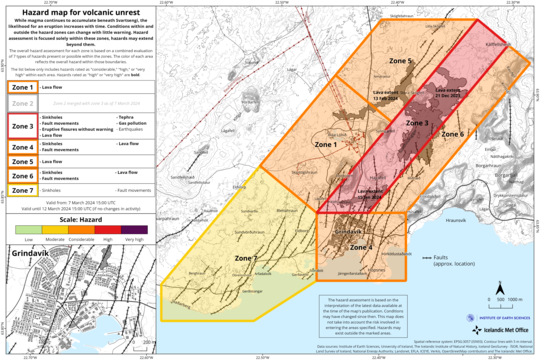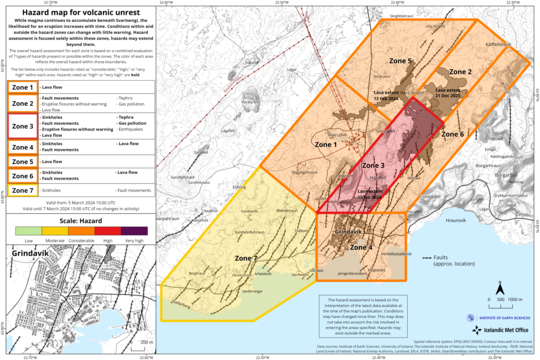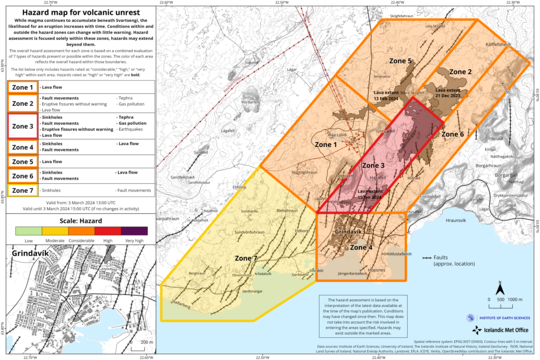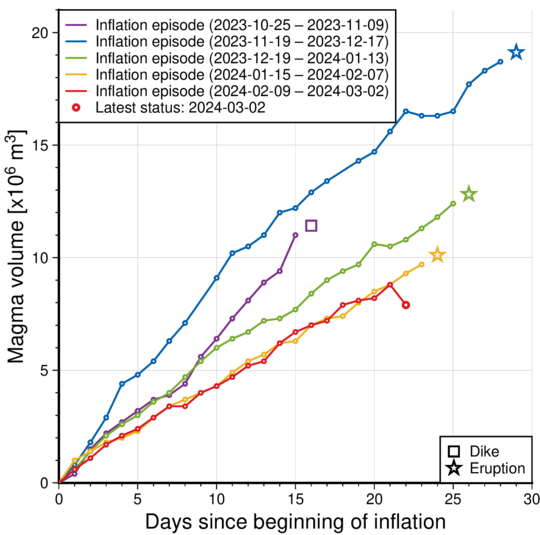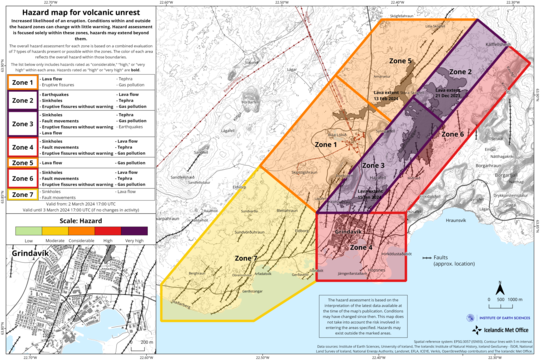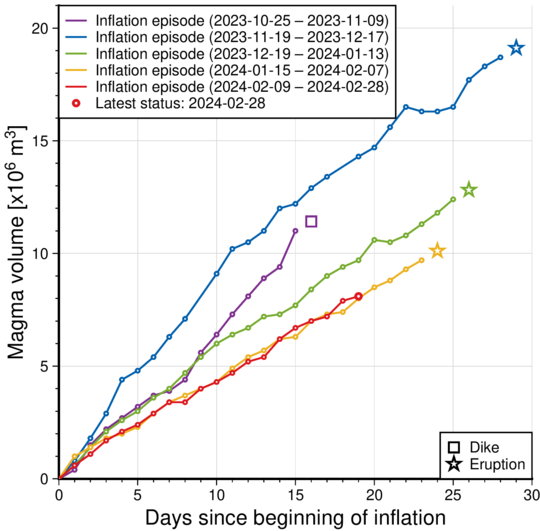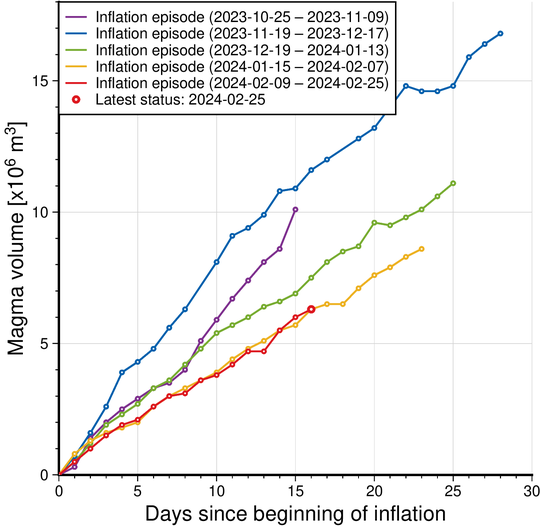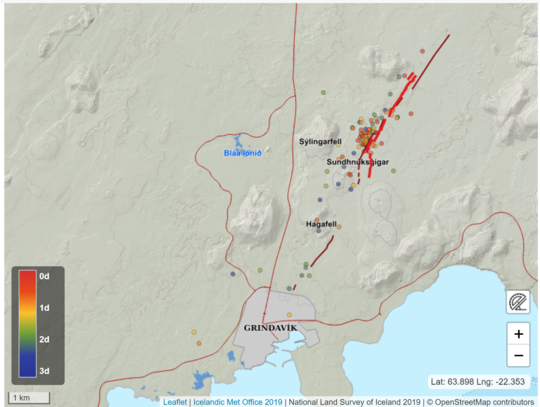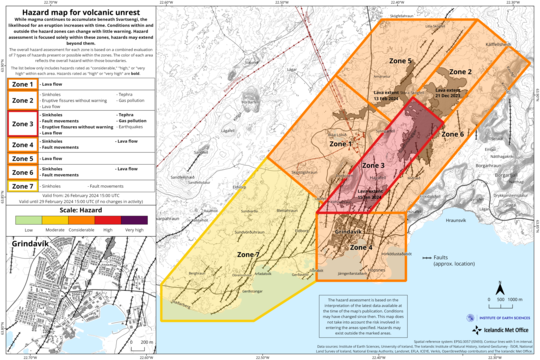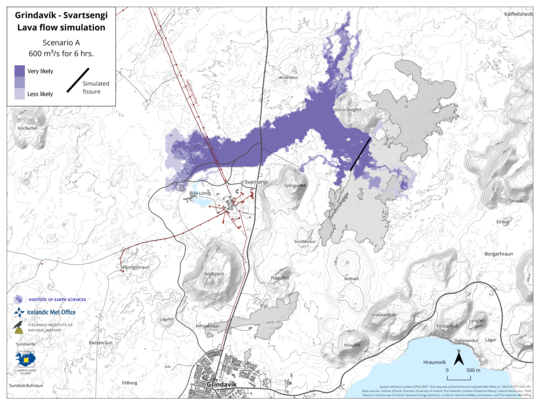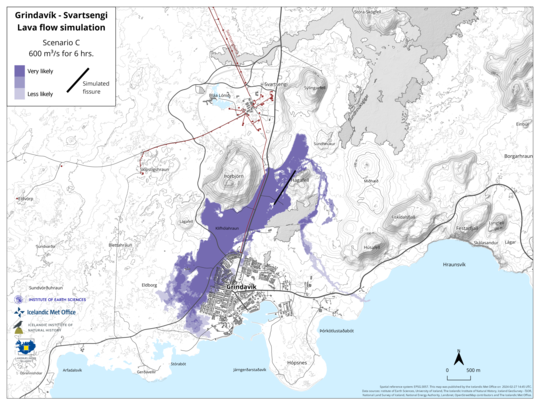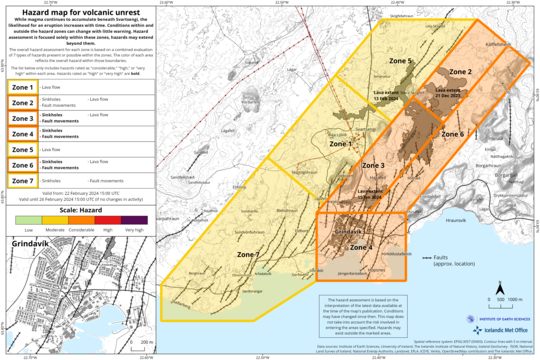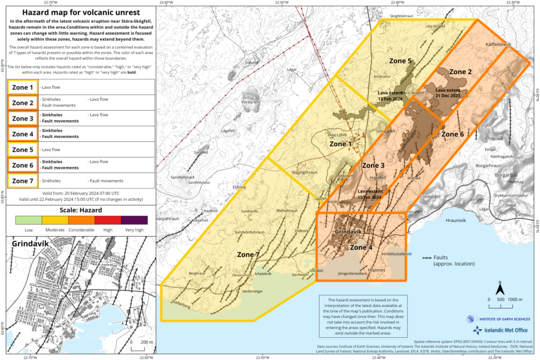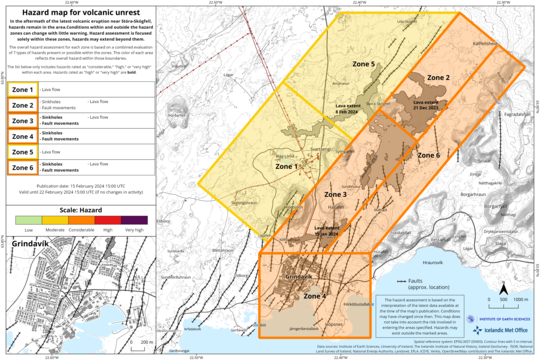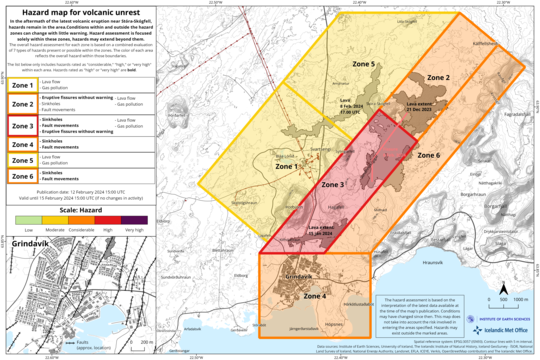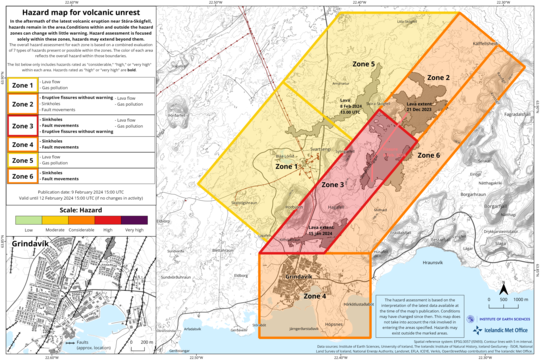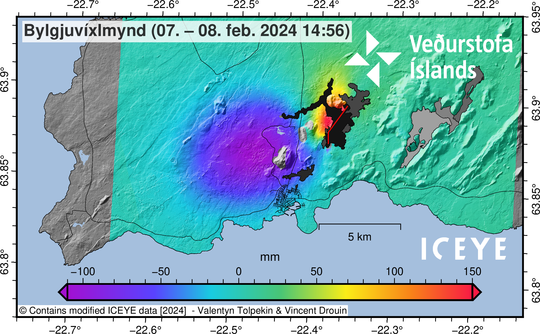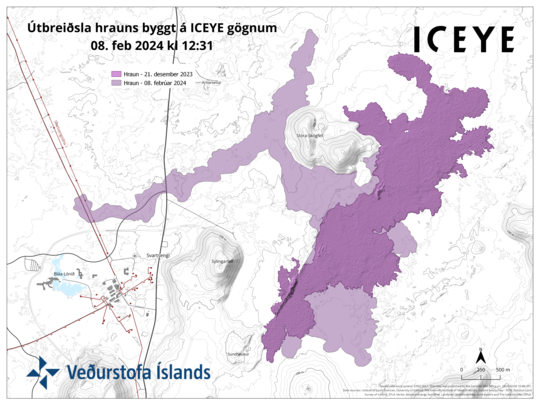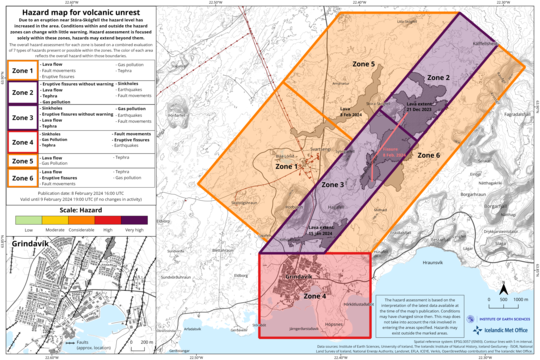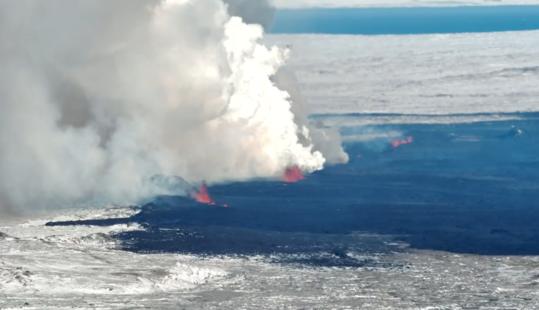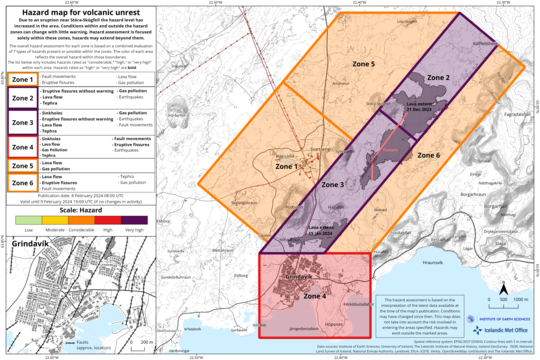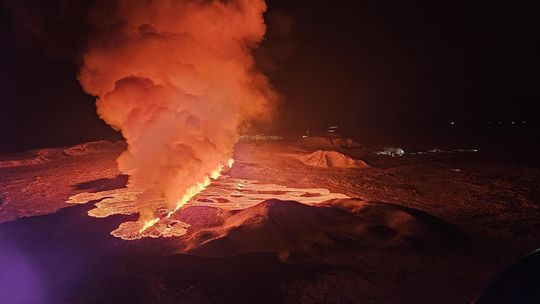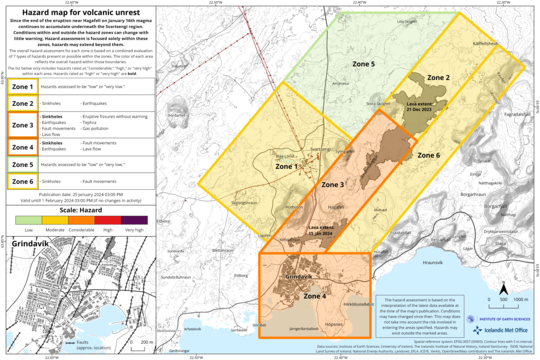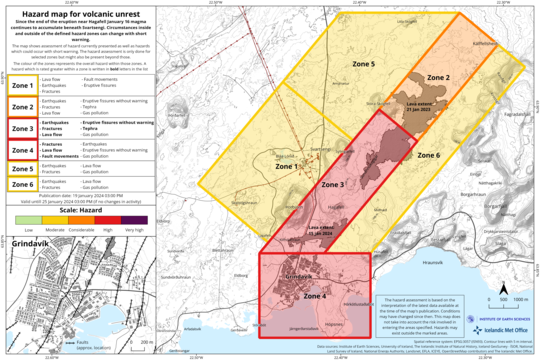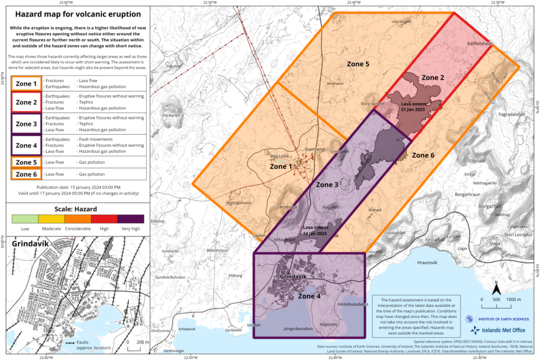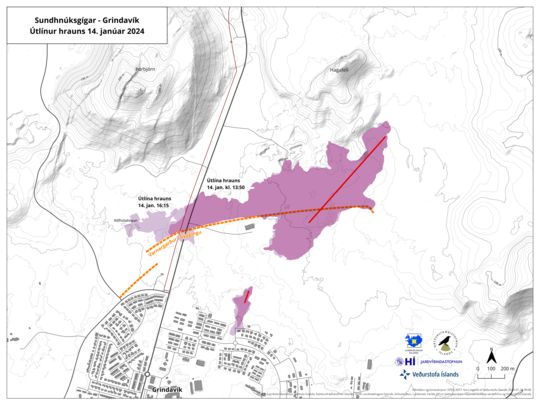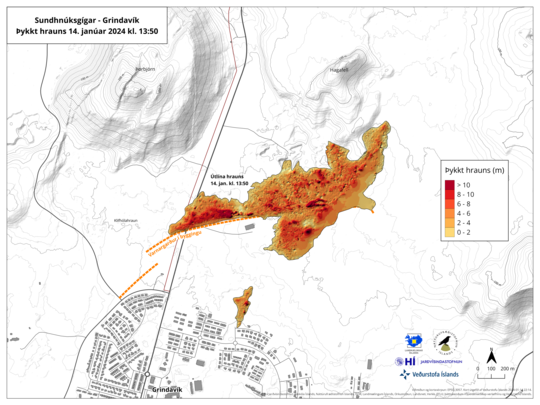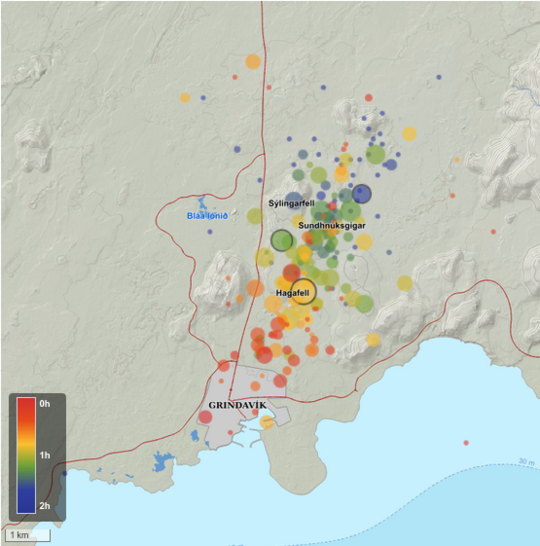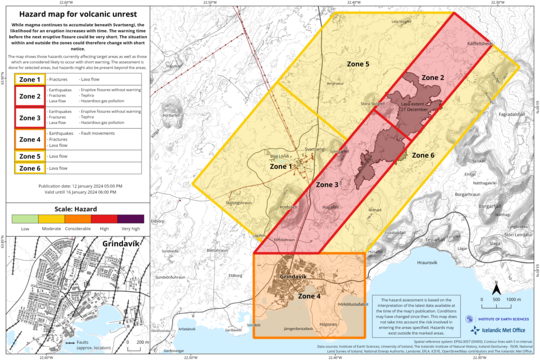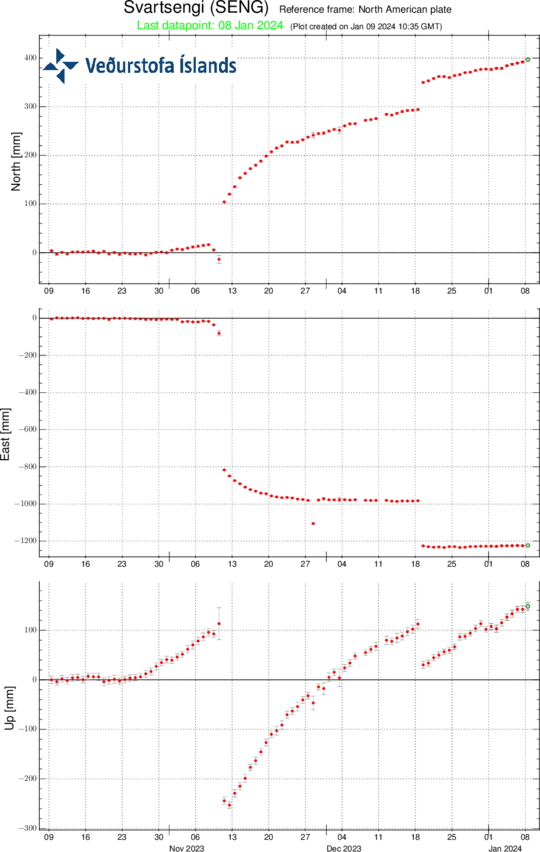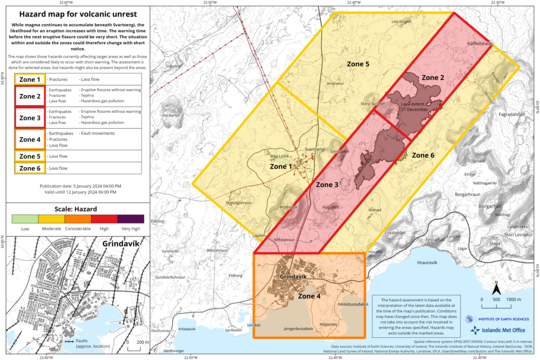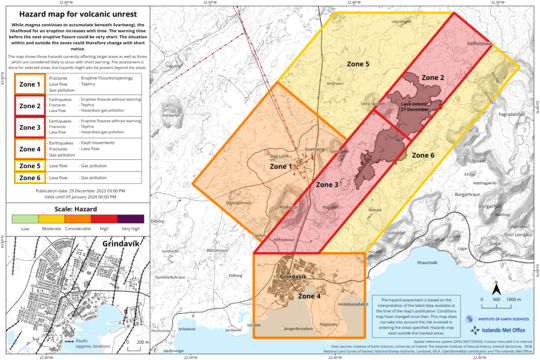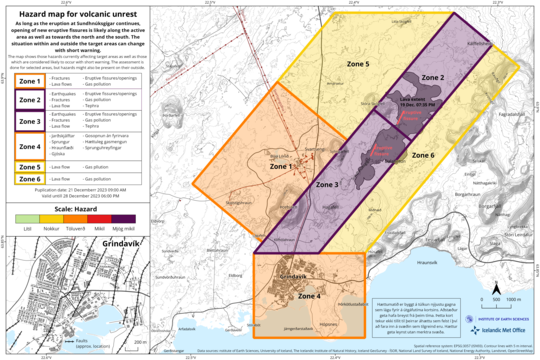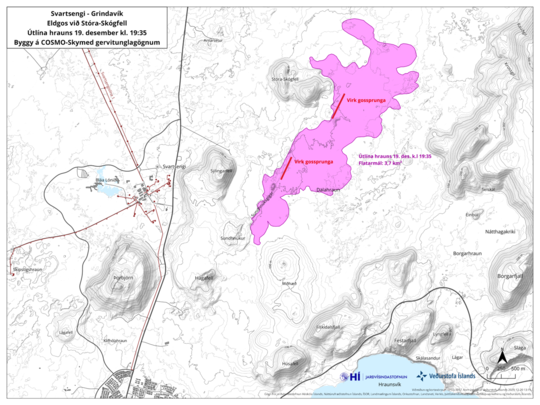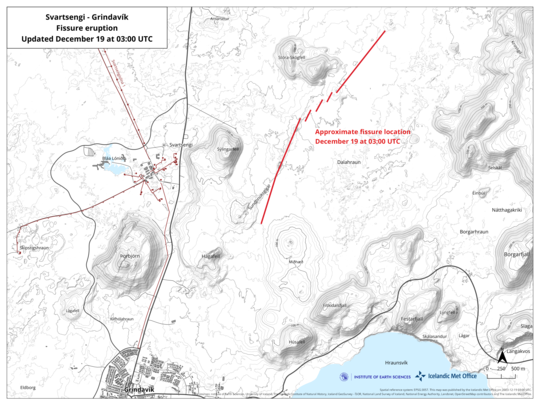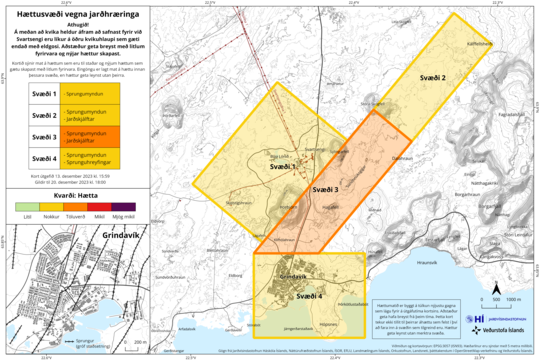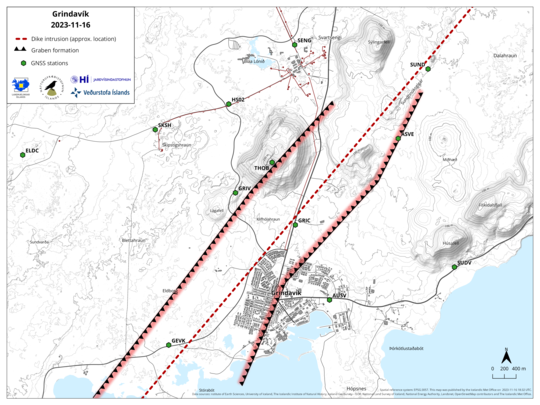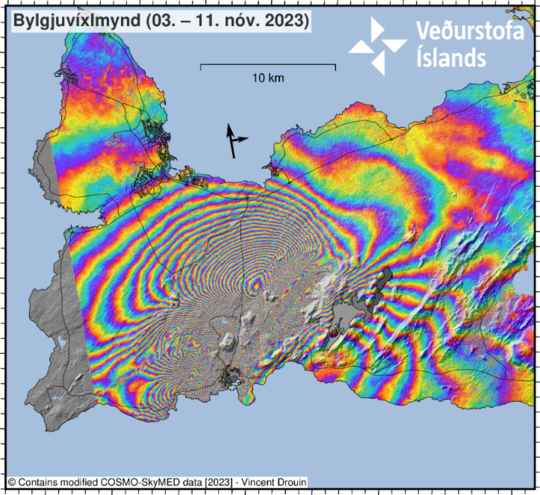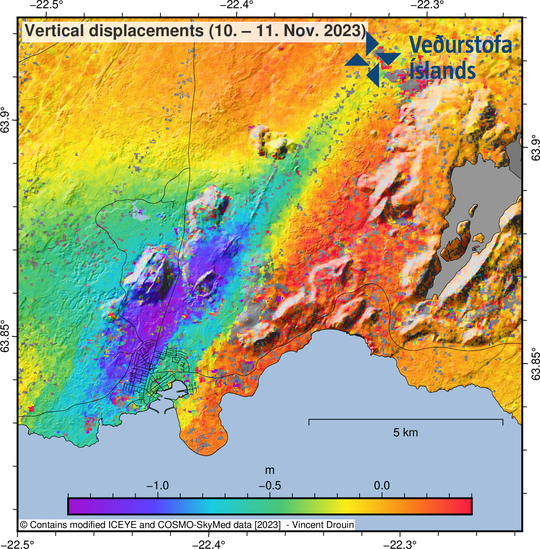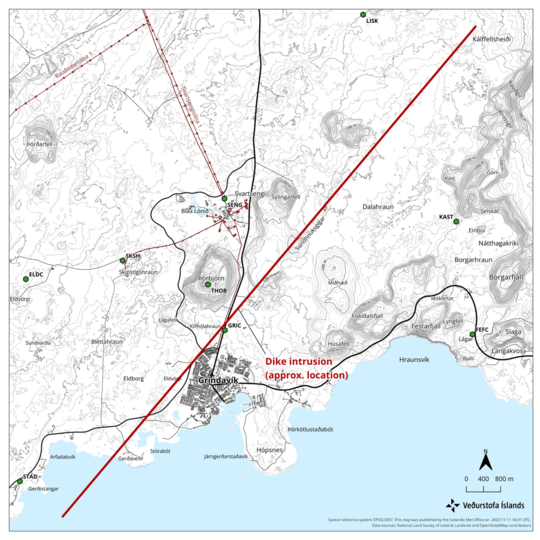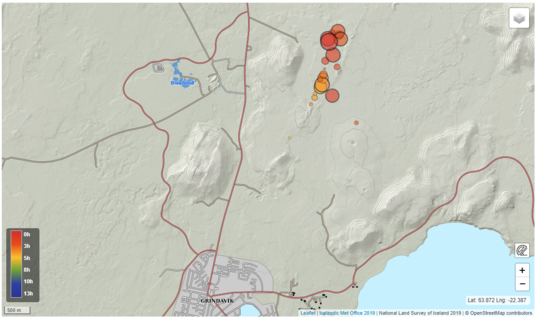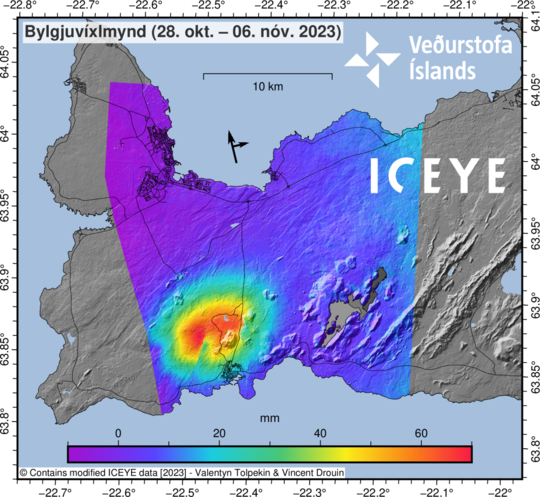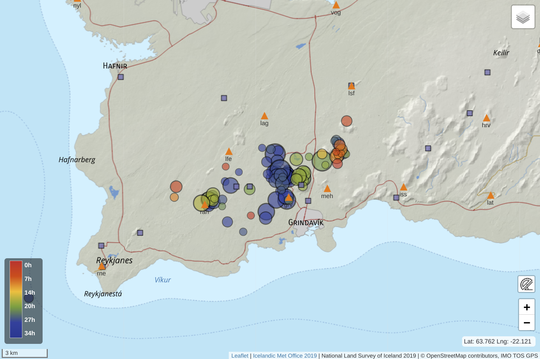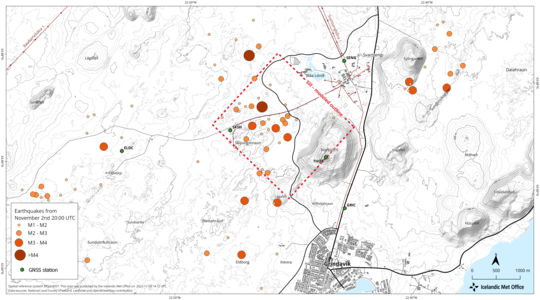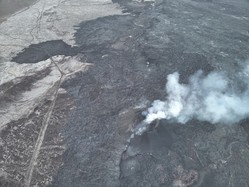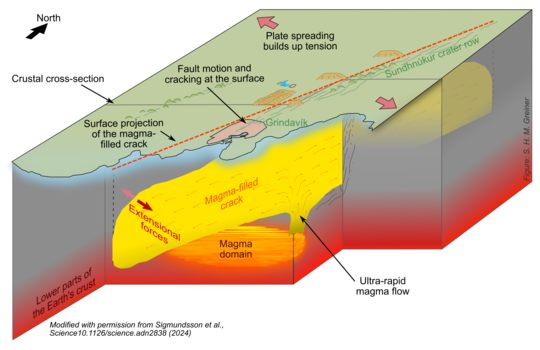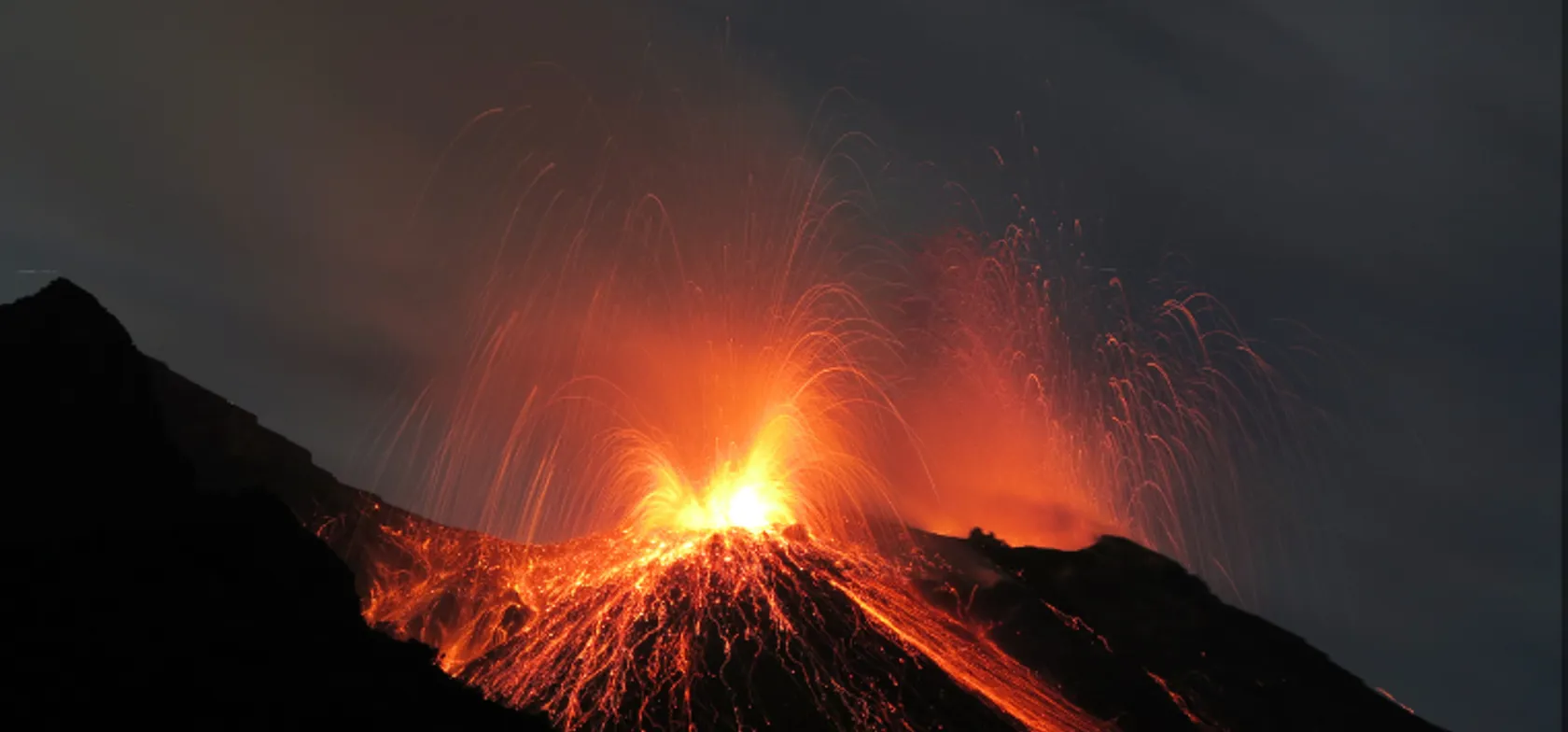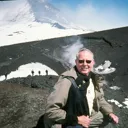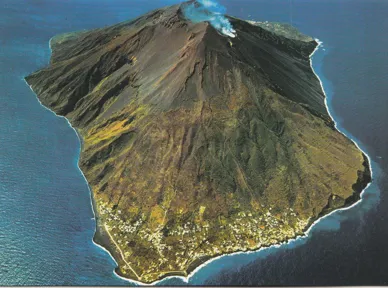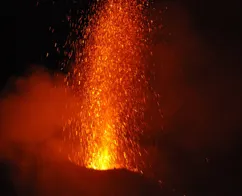Vulkanen rører på sig….
Magma-tilstrømningen fortsætter i Svartsengi-reservoiret med en jævn hastighed
En anden digebegivenhed og/eller et udbrud vil sandsynligvis forekomme i de kommende uger eller måneder.
Opdateret 11. juli kl. 9:45
- Omkring 20 jordskælv er blevet målt i området for urolighederne i sidste uge
- GPS-målinger viser, at stigningen under Svartsengi-området fortsætter med samme hastighed som i de seneste dage
- Farekortet er blevet opdateret . Faren for lavastrømsinvasion er blevet sænket
Omkring 20 jordskælv er blevet målt i området for urolighederne i sidste uge, det største af størrelsesordenen M1,3 fandt sted vest for Grindavík. Seismicitetsniveauet er generelt uændret de seneste to uger.
Omkring 260 jordskælv blev opdaget på Reykjanes-halvøen i sidste uge. Omkring 60 jordskælv fandt sted i Lambafell-bjergene ved Þrengsli. Omkring 10 fandt sted i Brennisteinsfjöll. 100 jordskælv var lokaliseret i omgivelserne af søen Kleifarvatn, omkring 40 var øst for søen og de resterende var vest og sydvest for den og omkring det geotermiske område Seltún. 40 jordskælv fandt sted i Fagradalsfjall, alle under M1,0 og de fleste af dem i en dybde på 7-10 km. Omkring 20 jordskælv blev opdaget ved Reykjanestá, spidsen af Reykjanes-halvøen, og omkring 20 var placeret i Reykjanes-ryggen, ca. 90 km ud for kysten sydvest for Island.
GPS-målinger viser, at stigningen under Svartsengi-området fortsætter med samme hastighed som i de seneste dage. Deformationsmønsteret vist af Sentinel-1 satellitbilleder, der dækker perioden 25. juni – 7. juli, stemmer godt overens med disse målinger. Resultaterne fra geodætisk modellering viser endvidere, at magmatilstrømningen nu er højere end før udbruddet, der startede den 29. maj. Disse data tyder på, at tidslinjen for en anden digebegivenhed og/eller udbrud forventes at være inden for uger eller måneder.
Farekortet er opdateret og er gyldigt indtil 16. juli forudsat at der ikke er ændringer i aktiviteten. Farekortet er stort set uændret bortset fra zone 1 (Svartsengi), hvor faren for lavastrømsinvasion er blevet sænket. Fareniveauet for dette område er derfor reduceret fra betydelig (orange) til moderat (gul). Risikoen for lavastrømsinvasion i zone 6 er også blevet reduceret.
Opdateret 5. juli kl. 17:15 UTC
Siden slutningen af udbruddet i Sundhnúks kraterrække den 22. juni, er niveauet af seismicitet i Svartsengi-regionen stadig meget lavt med kun få små jordskælv registreret dagligt.
Jorddeformationsdata viser, at løftningen i regionen fortsætter. Dette tolkes som fortsat magma-tilstrømning til Svartsengi-reservoiret.
Geodetisk modellering er blevet brugt til at estimere magma-tilstrømningshastigheden til Svartsengi-reservoiret i perioder uden udbrud. I disse perioder betragtes systemet som “lukket”, og som sådan tager analysen ikke højde for yderligere magmatilstrømning, der opstår, når systemet er åbent i perioder med udbrud (f.eks. mængden af magma, der strømmer gennem systemet og ekstruderes som lava under udbrud). Derfor afspejler grafen ikke den samlede tilstrømning i systemet siden november 2023, men kun den tilstrømning, der fodrer reservoiret, når systemet er lukket.
Skitsen viser det ”lukkede” system, når magmaen strømmer fra dybden (rød pil) ind i Svartsengi-reservoiret til et lavere niveau ved 4-5 km (orange domæne), hvilket forårsager en trykstigning og målbar jorddeformation ved overfladen.
Data viser tilstrømningshastigheder mellem 8 og 10 m3/s frem til det første udbrud i december 2023. Herefter indikerer modellen, at magmatilstrømningen i dybden typisk har ligget i området 4 til 6 m3/s, når der tages højde for usikkerheder i resultaterne. I betragtning af usikkerheden i modellen har tilgangsraterne siden midten af januar været relativt stabile. Tilstrømningen vurderes pr. i dag at være på linje med det, der er observeret siden midten af januar, uden tegn på faldende tendens. Kombineret analyse af udbrudte volumener og volumenændringer inden for Svartsengi vulkanske system indikerer, at den samlede tilgængelighed af magma faktisk er højere.
Grafen viser den estimerede indstrømningshastighed af magma til Svartsengi-reservoiret i perioder uden udbrud. De grå områder svarer til udbrudsperioder eller digebegivenheder. Modellen beregner magma-tilstrømningshastigheden for de perioder uden for de grå områder (farvede vandrette linjer). Den røde linje med tilhørende usikkerhed (rødt område) svarer til det aktuelle estimat af magma-tilstrømningshastighed. Bogstavet D står for Dike intrusion og stjernen for eruption.
Opdateret 2. juli kl. 17:00 UTC
- Hævningsraten er nu højere end før udbruddet, der startede den 29. maj
- Et magmavolumen på omkring 13-19 millioner m3 forlod reservoiret, da det sidste udbrud startede
- Det er sandsynligt, at den næste digebegivenhed og/eller udbrud vil forekomme i de kommende uger/måneder
- Farekortet er blevet opdateret
Siden slutningen af det femte udbrud i Sundhnúks-kraterrækken den 22. juni fortsætter magma med at samle sig i dybden under Svartsengi-regionen. Baseret på geodætiske modelleringsresultater er den aktuelle genopladningshastighed til Svartsengi-reservoiret estimeret til at være 4-6 m3/s. Under digebegivenheden den 29. maj og den første uge af udbruddet var det estimerede volumenfald fra reservoiret 13-19 mio. m3. De nuværende modelleringsresultater indikerer, at dette samlede volumentab vil blive genopfyldt til Svartsengi-reservoiret inden for de næste 3 til 6 uger. Fra i dag er dette den sandsynlige tidsramme for den næste digebegivenhed og/eller udbrud.
En graf, der viser progressionen af magmaakkumulering og det estimerede samlede volumen af magma under Svartsengi mellem rækken af indtrængen og udbrud, der strækker sig fra 25. oktober 2023 til i dag. De præsenterede værdier er baseret på modeller, der anvender geofysiske data. De røde prikker viser status siden 30. maj 2024.
Et nyt farekort er blevet offentliggjort af IMO. Farer forbundet med lavastrømning og gasforurening er blevet sænket i mange zoner. Den samlede vurdering er uændret bortset fra to zoner. Niveauet af farer i zone 3 går fra høj (rød) til betydelig (orange) og inden for zone 5 fra betydelig (orange) til moderat (gul ).
(Klik på kortet for at se det større)
Opdateret 28. juni kl. 17:00 UTC
- Lavafeltet har et areal på 9,3 km² og et volumen på cirka 45 millioner m³
- Hævningen i Svartsengi-regionen fortsætter i høj hastighed
- Data indsamlet i de kommende dage/uger vil hjælpe med at vurdere situationen med større sikkerhed
Den seismiske aktivitet i nærheden af Svartsengi og Sundhnúks er meget lille med få små jordskælv registreret i de sidste par dage. Lavafeltet, der gik frem mod NW for Sýlingarfell, fortsatte med at bevæge sig meget langsomt, siden udbruddet sluttede den 22. juni, og det er nu helt stoppet.
Et hold fra Naturhistorisk Institut og Landtilsynet har behandlet data indsamlet af eksperter fra Efla, Verkís og Svarmi under droneflyvninger over udbrudsstederne den 24. juni. Disse data afslører, at lavafeltet nu har et areal på 9,3 km² og et volumen på cirka 45 millioner m³.
Udvidelse og tykkelse af lavafeltet, der blev anbragt under udbruddet i Sundhnúk-kraterrækken, som begyndte den 29. maj og varede indtil den 22. juni 2024.
Opløftningen under Svartsengi-regionen fortsætter
De seneste jorddeformationsdata (både GNSS- og satellit-InSAR-billeder) viser, at løftningen under Svartsengi-regionen fortsætter. Hastigheden af stigningen vurderes i øjeblikket til at være højere end den hastighed, der blev observeret før udbruddet, der startede den 29. maj. Hastigheden af jorddeformation kan tolkes som en kontinuerlig magmaindstrømning ind i magmalegemet i 4-5 km dybde.
Interferogram (InSAR) for perioden 13. – 25. juni viser, at deformation i den periode er omkring 3-4 cm. Billedet er baseret på data fra Sentinel-1-satellitten. Områderne med hvide konturer svarer til udvidelsen af lavafelter i Fagradalsfjall- og Sundhnúks-regionerne.
Med disse præmisser forventes det, at systemet vil opføre sig på samme måde som før, og at en ny magmatisk digeudbredelse og/eller vulkanudbrud vil forekomme igen i Sundhnúks-regionen i de kommende uger. I dag er det svært at forudse med sikkerhed, hvordan situationen vil udvikle sig. De data, der indsamles i de kommende dage/uger, vil hjælpe med at vurdere situationen og muligvis forstå ændringer og evolution inden for det magmatiske system.
Opdateret 24. juni kl. 15:00 UTC
- Udbruddet, der begyndte den 29. maj, er ophørt, efter at have varet i 24 dage
- Dette var det femte udbrud i Sundhnúksgígaröð-serien siden december 2023
- Jordhævningen har været stabil, men i et langsommere tempo end mellem de tidligere udbrud
Udbruddet, der begyndte i Sundhnúksgígaröð-serien den 29. maj, er ophørt, uden aktivitet observeret i krateret siden den 22. juni. Udbruddet varede i 24 dage og var det femte i Sundhnúksgígaröð-udbrudsserien siden december 2023. Derudover dannedes lavafeltet under dette udbrud er det største efter volumen og areal.
Selvom der ikke aktivt strømmer lava fra krateret, fortsætter betydelige bevægelser i lavafeltet nord for Sýlingarfell på grund af stadig smeltet lava under den størknede overflade. I de sidste to dage er der observeret aktivitet i lava-tungerne, der krydsede den defensive barriere ved Sýlingarfell og i lavafeltet nord for barrieren. Bevægelsen i lavafeltet forventes at fortsætte i de kommende dage, da denne proces tager lang tid at stoppe.
Cirka ti dage efter udbruddet begyndte, genoptog jordløftningen i Svartsengi, hvilket tyder på en igangværende magmaophobning. Jordløftet har været stabilt siden da, men hastigheden er langsommere end det, der blev observeret mellem de tidligere begivenheder. Det islandske meteorologiske kontor fortsætter med at overvåge området, og målinger i de kommende dage og uger vil hjælpe forskerne med at fortolke enhver udvikling i den geologiske aktivitet.
En graf, der viser progressionen af magmaakkumulering og det estimerede samlede volumen af magma under Svartsengi mellem rækken af indtrængen og udbrud, der strækker sig fra 25. oktober 2023 til i dag. De præsenterede værdier er baseret på modeller, der anvender geofysiske data. De røde prikker viser status siden 30. maj 2024, hvilket indikerer, at hastigheden af magma-akkumulering nu er langsommere end i tidligere perioder med akkumulering.
Mens magma-akkumulering fortsætter under Svartsengi, er det sandsynligt, at det seneste mønster af magma-indtrængen og -udbrud vil fortsætte. På nuværende tidspunkt er det svært at forudsige, hvornår den næste begivenhed vil indtræffe, eller hvornår magma-akkumulering vil ophøre.
Opdateret farevurdering
Det islandske meteorologiske kontor har udsendt en opdateret farevurdering. Afslutningen på det sidste udbrud har ført til ændringer på flere områder. Faren vurderes at være lavere i alle områder på grund af den reducerede sandsynlighed for lavastrømning og gasforurening. Eksperter fra det islandske meteorologiske kontor målte fredag den 21. juni gasudledningen fra krateret til at være meget lav, cirka 1 kg/s.
Opdateret 22. juni kl. 19:00 UTC
Udbruddet, der begyndte den 29. maj, ser ud til at være forbi. I går var der lidt aktivitet synlig i krateret, og under en Civil Protection droneundersøgelse ved middagstid i dag blev der ikke observeret aktivitet. Derudover er rysten på nærliggende seismometre faldet og er nu sammenlignelig med, hvad der blev målt før udbruddet begyndte.
Det forventes dog, at ældre lava vil fortsætte med at strømme langsomt lidt længere langs den nordlige side af Sýlingarfell og ved forsvarsbarriere L1, hvor lava-tunger er strømmet over.
Billede af krateret taget omkring middagstid i dag under en Civil Protection-droneflyvning over udbrudsstedet. Foto: Civilbeskyttelse
Opdateret 21. juni kl. 18:00 UTC
Billeder taget i morges under en Civil Protection droneflyvning viser tydeligt, at aktiviteten i krateret er aftagende. Lavastrømme fra krateret er ikke synlige på overfladen, men kan fortsætte i lukkede kanaler. Der flyder dog stadig lava aktivt i lava-tungerne, der gik over forsvarsbarrieren nord for Sýlingarfell i går. Et billede fra Civil Protection-webkameraet på Sýlingarfell viser de tre lava-tunger, der flyder over barrieren, og maskineri, der bruges til at begrænse lavastrømmen. Den vestligste lavatunge ser ud til at være den mest aktive, idet den har rykket frem adskillige meter og blevet tykkere i de sidste par timer. Udbrudsskælven er også aftagende, hvilket tydeligt ses på Meteorologisk Kontors seismometer i Grindavík, som vist på den medfølgende graf.
Den faldende synlige aktivitet i krateret og reduktionen i udbrudsrysten tyder på, at dette udbrud kan ende snart, selvom der er usikkerhed om det nøjagtige tidspunkt. GPS-målinger viser stadig landhævning i Svartsengi-området. Dette indikerer, at trykket i magmakammeret under Svartsengi fortsætter med at opbygge, selvom stigningshastigheden er langsommere end før.
Billede af krateret taget omkring kl. 9:30 i morges under en Civil Protection-droneflyvning over udbrudsstedet. Foto: Civilbeskyttelse
Lavatungerne flyder over forsvarsbarrieren nord for Sýlingarfell og bestræbelser på at begrænse lavastrømmen. Foto: Civilbeskyttelse
Tremormålinger fra IMO-seismometeret i Grindavík, der strækker sig over perioden fra udbruddets start den 29. maj til den 21. juni. Dette plot viser, at udbrudsrysten er aftaget de seneste dage.
Opdateret 18. juni kl. 15:40 UTC
- Udbruddet er i gang, og lava flyder fra det ene krater.
- Lava flyder mest mod nord langs bjerget Sýlingarfell.
- Opløftningen fortsætter i Svartsengi i samme tempo. Hævningshastigheden er lidt lavere end før udbruddet startede.
- Gasspredningsprognose og aktuelle luftkvalitetsmålinger kan findes her.
Udbruddet har været ret stabilt de sidste par dage, og et krater er fortsat aktivt. Lava strømmer mest mod nord fra krateret, men en del af lavaen samler sig syd for krateret. Lavaen, der strømmer mod nord, kommer ind i lavasøen nær Sýlingarfell-bjerget og fortsætter mod nord, hvor lavafeltet fortsætter med at tykne. En lille åbning i den vestlige kraterkant dukkede op i går ved middagstid, og derfra flød en lavastrøm et lille stykke mod vest mod Sundhnúkur-bjerget, men det vandløb har siden været inaktivt. Lidt eller ingen seismicitet er blevet fundet i området.
I perioden 3. juni til 10. juni blev lavaekstruderingshastigheden fra udbruddet estimeret til omkring 10 m³/s, og siden da har der ikke været væsentlige ændringer i udbruddets aktivitet, hvilket indikerer, at strømningshastigheden er stabil. På trods af det igangværende udbrud fortsætter Svartsengi-reservoiret med at vise inflation (som det blev observeret under det forrige udbrud). Geodætisk modellering viser, at opblæsningen af magma-reservoiret under Svartsengi skyldes en yderligere volumenstigning i området 1-2 m³/s. Hvis magmaakkumuleringshastigheden under Svartsengi kombineres med lavaekstruderingshastigheden på overfladen, giver dette en indikation af den samlede magmaindstrømning fra dybden. Der er fortsat betydelig usikkerhed i modelberegningerne og estimeringen af lavaekstruderingshastigheden fra udbruddet i den seneste uge, hvilket kan påvirke denne vurdering. Udviklingen af urolighederne vil fortsat blive fulgt nøje.
Grafen viser den estimerede mængde magma, der er ophobet under Svartsengi mellem de vulkanudbrud eller magma-indtrængninger, der har fundet sted siden november 2023.
Ifølge vejrudsigter er vindretningen fra sydøst i dag, men mere sydlig i nat. Gasforurening fra udbruddet vil gå mod nordvest og senere mod nord, og øget gasforurening kan forventes i det nordlige Reykjanes. I morgen bliver vinden let, skiftende og vestlig senere på dagen. Gasforureningen vil så bevæge sig mod hovedstadsområdet. Realtidsmålinger af luftkvalitet kan findes på loftgaedi.is og gasspredningsprognosen her.
Farevurderingen, der blev offentliggjort den 13. juni , er stadig gyldig indtil den 20. juni , medmindre der sker væsentlige ændringer.
Opdateret 13. juni kl. 16:30 UTC
- Udbruddet har varet i 15 dage. Et krater forbliver aktivt
- Lavafeltet i dette udbrud har nået 9,2 km 2 og et volumen på omkring 41 millioner m 3 , hvilket gør det til det største siden december 2023
- Lavadammen forbliver ret stabil, men lava strømmer fra den ind i den aktive lavastrøm nord for Sýlingarfell
- Gasforurening vil sandsynligvis fortsætte i de kommende dage. Se gasspredningsprognose
- Farevurdering opdateret – få ændringer
Vulkanudbruddet, der startede den 29. maj, er stadig i gang og har derfor varet i 15 dage . Det har været nogenlunde stabilt de sidste par dage, og kun ét krater er stadig aktivt, som det har været siden 4. juni . Der er påvist meget lidt seismisk aktivitet i området.
Den vigtigste lavastrøm fortsætter med at være fra krateret mod mt. Sýlingarfell og langs bjerget på dets nordlige side. En lavadam er stadig til stede ved Sýlingarfell, men lava strømmer fra dammen ind i den aktive lavastrøm nord for Sýlingarfell. Den strøm er i en lignende kanal som lavaen, der oversvømmede Grindavík-vejen i lørdags. Lavastrømmens front nær Grindavík-vejen bevæger sig meget langsomt, men tykkere.
Fotogrammetriholdet fra Islands Naturhistorisk Institut (IINH) og National Land Survey of Iceland (NLSI) har behandlet data indsamlet af eksperter fra Efla, Verkís og Svarmi under en droneflyvning over udbrudsstedet den 10. juni. Dataene viser, at lavastrømningsfeltet har nået 9,2 km 2 og et volumen på omkring 41 millioner m 3 . Dette gør lavafeltet dannet i dette udbrud til det største af de fem udbrud, der har fundet sted i Sundhnúkur kraterrækkeområdet siden december 2023, både hvad angår areal og volumen. Til sammenligning var lavafeltet, der blev dannet i det udbrud, der startede den 16. marts og varede indtil 9. maj, omkring 6,2 km 2 i areal og 35 millioner m 3 .
Baseret på disse data er den gennemsnitlige strøm af lava fra udbruddet i perioden 3.-10. juni estimeret til 10 m 3 /s. Mellem eftermiddagen den 29. maj – 3. juni blev lavastrømmen estimeret til 27 m 3 /s, så aktivitetskraften er aftaget noget mellem disse to målinger.
GPS-målinger indikerer, at landhævningen i Svartsengi fortsætter, og at placeringen af magma-akkumuleringszonen under Svartsengi er uændret. Dette kan tyde på, at magmastrømmen fra dybden fortsætter og er større end strømmen ud af krateret på overfladen, hvilket får magma til at akkumulere under Svartsengi. Der er ingen klare tegn på en reduktion i magmastrømmen. Aktiviteten overvåges nøje, og videnskabsmænd fortsætter med at tolke enhver udvikling.
Tidsserier fra GPS-stationen SENG ved Svartsengi siden 11. november 2023, i nord, øst og lodret retning (hhv. top-, midt-, bundbilleder). Den nederste tidsserie viser landhævningen i millimeter, og gårsdagens datapunkt (12. juni) er vist med en grøn prik. De røde lodrette linjer er tidspunkter for de sidste fem udbrud (18. december 2023, 14. januar, 8. februar, 16. marts og 29. maj 2024). De blå lodrette linjer repræsenterer timingen af magma-udbredelsen, der har fundet sted uden at resultere i et vulkanudbrud (10. november 2023 og 2. marts 2024).
Betydelig gasforurening i de sidste dage
Gasforureningen fra udbruddet har været ret høj i går og i dag. Gasmålere placeret tæt på Den Blå Lagune og ved Hafnir registrerer betydelig gasforurening. Østlige vinde blæste i nat gassen mod vest, og den højeste koncentration af SO 2 blev målt over 8000 µg/m 3 . Gasforurening kan forventes at fortsætte de næste par dage. Østlige vinde fortsætter i dag, og gassen vil derefter rejse mod vest over Svartsengi-området og videre over den vestlige del af Reykjanes-halvøen. I morgen vil vindretningen variere, og gassen vil spredes bredt ud over halvøen, men som dagen går, vil vinden vende til nordlige retninger, og gas vil blæse syd over Grindavík.
Farevurderingen er blevet opdateret i lyset af udviklingen i udbruds- og vejr- og gasfordelingsprognoserne. Vurderingen er stort set uændret, bortset fra zone 5, hvor faren på grund af lavastrømmen er øget. Der er stadig en meget høj fare i zone 3, Sundhnúkur-kraterrækken, hvor udbruddet startede. Der er også en høj fare (rød) i zone 4 (Grindavík) og zone 6. I zone 1,5 og 7 er der en betydelig fare (orange). Farekortet er gyldigt indtil 20. juni med forbehold for eventuel udvikling.
(Klik på kortet for at se det større)
Opdateret 11. juni kl. 16:00 UTC
- Udbruddet har varet i 13 dage. Et krater aktivt, som forbliver relativt stabilt
- Betydelig forurening fra udbruddet i mange dele af hovedstadsområdet og i den vestlige del af Sydisland
- Det frarådes at deltage i udendørs aktiviteter i de områder, hvor der konstateres forurening. Luftkvaliteten kan overvåges her
- Målinger indikerer, at landhævningen er genoptaget
- Lava samles stadig i en lavadam lige sydøst for Sýlingarfell
Udbruddet ved Sundhnúkur-kraterrækken, der startede for 13 dage siden, forbliver stabilt. Et krater er aktivt, og aktiviteten har været ens de sidste par dage. Seismiciteten har været meget lav i den sidste uge, kun få jordskælv er blevet opdaget.
Som rapporteret i vores nyheder i weekenden, begyndte lavastrømmen at stige ved rødderne af Sýlingarfell mod vest, og Grindavík-vejen blev oversvømmet af lava for tredje gang siden den vulkanske aktivitet begyndte ved Sundhnúkur i november sidste år. Lavatungen skrider stadig frem og flyder nu mod nordvest langs en lignende kanal som den, der flød over Grindavík-vejen i lørdags. Dens aktive flowfront er dog stadig et par hundrede meter væk fra vejen og bevæger sig meget langsomt. Lava samler sig stadig i en lavadam lige sydøst for Sýlingarfell og kan briste igen og udløse endnu en lavabølge i de næste par dage.
Målinger tyder på, at landhævningen er startet igen i løbet af sidste weekend, og nedsynkningen, der blev opdaget i de første dage af udbruddet, er stoppet. Hævningshastigheden kan endnu ikke estimeres, men det kan antages, at tilstrømningen af magma til magmareservoiret har oversteget udstrømningen fra krateret.
Billedtekst: Bevægelser ved GPS-stationen THOB på Þorbjörn siden 11. november 2023 i nord, øst og lodret (top, midt, bund). Den nederste graf viser landhævningen i millimeter, og gårsdagens (10. juni) måling er vist med en grøn prik. De røde linjer er datoerne for begyndelsen af de sidste fem udbrud (18. december 2023, 14. januar, 8. februar, 16. marts og 29. maj 2024). De blå linjer repræsenterer tidspunktet for de magmaudbredelser, der er sket uden at resultere i et udbrud (10. november 2023 og 2. marts 2024).
Gaskoncentrationen i luften overstiger niveauet for sundhedseffektgrænserne.
Der måles nu betydelig forurening fra udbruddet i mange dele af hovedstadsområdet og i den vestlige del af Sydisland. Ifølge data fra Miljøstyrelsen i Island har de højeste niveauer af SO 2 i hovedstadsområdet oversteget 500 μg/m3, og forureningen forventes at vare ved hele dagen. Personer med følsomt åndedrætssystem kan opleve ubehag. Det er at foretrække at begrænse fysisk aktivitet udendørs og undgå at lade spædbørn sove udendørs under så høje koncentrationer af gas i luften.
Her til morgen har tågeskyer lagt sig over den vestlige del af landet, og der har også været synlig vulkansk smog forårsaget af omdannelsen af SO 2 -gas til SO 4 . Vulkansmog er sammensat af meget fine svovlpartikler (SO 4 ), der er blevet dannet som følge af vulkanfanens kemiske reaktion med fugt og ilt i atmosfæren ved hjælp af sollys. Når dagen er lang, som den er nu, er der en øget chance for, at der dannes vulkansk smog. Vulkansmog måles ikke på SO 2 gasdetektorer, men er synlig som en blå tåge, når en vis koncentration er nået. En stigning i meget fine partikler (PM1 og PM2.5) kan være en indikation på tilstedeværelsen af SO 4 . Luftkvaliteten kan overvåges på Miljøstyrelsens luftkvalitetsdetektorer .
Vejrvagtens prognose for gasfordeling er ret langsom, variabel retning og gasforurening kan ses mange steder i det sydvestlige hjørne. Drej mod syd om eftermiddagen, der blæste gas mod nord og forurening kunne mærkes i Vogar og Reykjanesbær. Sydøstlig vind i morgen, gas blæser mod nordvest.
Opdateret 8. juni kl. 16:20 UTC
-
Fortsat aktivitet i et krater, som forbliver relativt stabilt.
-
I nat steg lavastrømmen nord for Sýlingarfell og mod Grindavíkurvegur.
-
Lavatungen nåede vejen omkring halv elleve i morges.
-
Forsiden af lavafeltet er omkring 800 meter væk fra varmtvandsledningerne.
Udbruddet på Sundhnúksgígaröð fortsætter, og det er nu ti dage siden, det startede. Siden tirsdag den 4. juni har ét krater været aktivt. I de sidste par dage er lavaen for det meste strømmet mod nordvest og blevet tykkere nær Sýlingarfell, ligesom den langsomt er strømmet nordpå forbi Sýlingarfell og vestpå. Nat til lørdag steg lavastrømmen nord for Sýlingarfell mod vest og mod Grindavíkurvegur. I morges lørdag blev der arbejdet på at lukke hullet i beskyttelsesbarrieren ved Grindavíkurvegur, og omkring halv elleve nåede lava-tungen vejen lige nord for bommen. Lava er også strømmet ned langs barrieren og er meget tyk i nærheden af den og smuldrer nogle steder hen over barrieren. Lavastrømmens hastighed er faldet siden kl. Forsiden af lavafeltet er nået omkring 800 meter væk fra varmtvandsledningerne og bevæger sig langsomt hen imod dem.
Det kan konkluderes, at den nuværende bølge er forbi, men det forventes, at den vil fortsætte med at bevæge sig langsomt fremad. Situationen vil blive overvåget nøje, og endnu en stigning kan ikke udelukkes i de kommende dage.
Billedet blev taget kl. 10:10 i morges af et kamera ejet af det islandske meteorologiske kontor, placeret på Þorbjörn. Den viser lavafronten, der bevæger sig mod Grindavíkurvegur, og arbejdere i området lukker en åbning i beskyttelsesbarrieren L1.
Opdateret 7. juni kl. 18:00 UTC
-
Stabil eruptiv aktivitet fortsætter i et krater.
-
Lava flyder primært mod nordvest.
-
Landsynkning er stoppet i Svartsengi.
-
Farevurderingen er blevet opdateret. Gasforurening kan være bemærket i Grindavík.
Udbruddet ved Sundhnúkur-kraterrækken fortsætter og har stået på i ni dage. Siden tirsdag den 4. juni har ét krater været aktivt. Lava fra dette krater strømmer primært nordvest mod Sýlingarfell, hvor lavafeltet bliver tykkere; derfra bevæger aktive lavastrømme sig nord for Sýlingarfell.
Satellitbillede fra 5. juni , der viser aktive lavastrømme fra krateret, der strømmer nordvest mod Sýlingarfell og sydpå mod Hagafell. Dette billede er et såkaldt “nær-infrarødt” termisk billede, som fremhæver forskellen mellem varme og kolde overflader i landskabet og tydeligt adskiller lavafelter og lavastrømme i landskabet.
Et hold fra Naturhistorisk Institut og Landtilsynet har behandlet data indsamlet af eksperter fra Efla, Verkís og Svarmi under en droneflyvning over udbrudsstederne den 3. juni. Disse data afslører, at lavafeltet nu har et areal på 8,6 km² og et volumen på cirka 36 millioner m³.
Baseret på disse målinger er den estimerede gennemsnitlige strømningshastighed for lava fra udbruddet, der spænder over perioden fra eftermiddagen den 29. maj til den 3. juni, cirka 30 m³/s. Disse resultater er baseret på data, der dækker omkring 70% af lavafeltet, idet det antages, at der ikke har været væsentlige ændringer i lavafeltet uden for dette område mellem målingerne. Efter at disse målinger var opnået, ændrede udbruddets aktivitet sig, hvilket reducerede antallet af aktive kratere til et enkelt krater, der har været aktivt siden 4. juni. Der er ingen målinger af lavastrømningshastigheden siden da, men til sammenligning blev lavastrømmen fra det sidste udbrud i Sundhnúkur-kraterrækken estimeret til at være cirka 3-4 m³/s, når kun ét krater var aktivt.
I de første par dage efter udbruddet begyndte, blev der målt landsynkning i Svartsengi, hvilket indikerer, at der strømmede mere magma ud af magmareservoiret og til overfladen, end der strømmede ind i reservoiret fra dybden. Deformationsmålinger i de seneste dage viser, at landsynkning ser ud til at være stoppet, hvilket tyder på, at magmastrømmen fra dybden ind i magmareservoiret nu kan sammenlignes med strømmen mod overfladen ved Sundhnúkur-kraterrækken.
Følgende graf viser det estimerede volumen af magma, der er akkumuleret under Svartsengi mellem rækken af udbrud og digeindtrængninger siden november 2023. Den røde linje markerer modelberegninger fra 30. maj, hvilket indikerer, at volumen af magma under Svartsengi faldt i de første dage efter udbruddet begyndte. De seneste datapunkter indikerer dog, at mængden af magma under Svartsengi er stabil. Dette tyder på, at magmastrømmen fra dybden ind i magmareservoiret og op til overfladen i Sundhnúkur-kraterrækken er sammenlignelig. For mere detaljeret information om magma-akkumulering under Svartsengi, se den tidligere nyhedsrapport.
Overvågning af potentielle ændringer i magma-reservoiret under Svartsengi
Som nævnt i sidste nyhedsopdatering var dette første tilfælde siden vulkanurolighederne begyndte ved Sundhnúkur-kraterrækken i december 2023, at der blev målt landsynkning i Svartsengi under et udbrud. I går frigav Islands Universitets Institut for Jordvidenskab de første klippe- og geokemiske data fra det igangværende udbrud. Deres analyse afslører, at sammensætningen af den magma, der i øjeblikket når overfladen, er forskellig fra sammensætningen af de sidste fire udbrud ved Sundhnúkur-krateret, i stedet ligner magmaen fra begyndelsen af udbruddet i Geldingadalur i 2021. Disse resultater indikerer, at magma-reservoiret under Svartsengi udvikler sig. På dette tidspunkt er det ikke muligt endeligt at angive arten af disse ændringer. Flere data vil blive indsamlet og analyseret i den nærmeste fremtid for at muliggøre en klarere fortolkning af denne udvikling.
Vigtigt regelmæssigt at overvåge gasforureningsprognoser
Vejrudsigten forudser nordenvind i dag og i morgen. Derfor vil gasforurening blive ført sydpå, hvilket potentielt vil påvirke Grindavík. Der er stadig stor usikkerhed om mængden af gasser, der udsendes fra udbrudsstedet. Realtidsmålinger af forskellige gasser kan overvåges på hjemmesiden loftgaedi.is, og det islandske meteorologiske kontors gasfordelingsprognose kan findes her.
Farevurderingen er blevet opdateret på grund af udviklingen i udbruddet, foruden vejr- og gasfordelingsprognoserne. Farevurderingen forbliver stort set uændret, bortset fra zone 7, hvor faren for gasforurening er øget.
(Klik på kortet for at se det større)
Opdateret 4. juni kl. 18:30 UTC
-
Udbruddet har stået på i seks dage.
-
Et krater forbliver aktivt.
-
Lava er primært strømmet nordvest mod Sýlingarfell.
-
Nye data afslører, at det er sandsynligt, at magma fortsætter med at akkumulere under Svartsengi.
-
Farevurderingen forbliver stort set uændret.
Udbruddet, der begyndte den 29. maj ved Sundhnúkur-kraterrækken, har nu varet ved i seks dage. Efter en relativt kraftig start konsoliderede eruptiv aktivitet sig i tre åbninger, der forblev aktive i løbet af weekenden. Ændringer i aktiviteten blev observeret i nat, hvor kun ét krater ser ud til at forblive aktivt i dag. (Se placeringen af det aktive krater på farekortet.) Det aktive krater støder op til det krater, der tidligere udviste den mest omfattende aktivitet under det tidligere udbrud, som varede fra 16. marts til 9. maj.
Lava fra det aktive krater strømmer nordvest mod Sýlingarfell og fortsætter med at strømme nordpå. Derudover er der aktive lavastrømme, der bevæger sig sydpå mod Hagafell. Nu hvor aktiviteten er skiftet til et enkelt krater, er det sandsynligt, at lavastrømmen, der rejser sydøst mod Fiskidalsfjall, er blevet mindre.
Til denne opdatering følger to billeder fra det islandske meteorologiske kontors webkamera placeret på Þorbirn, som har udsigt over udbrudsstedet. Det første billede, taget klokken 02:00, viser magma, der kommer op fra to kratere, mens det andet billede taget en time senere kun viser magma, der kommer fra det større krater.
Magma fortsætter sandsynligvis med at akkumulere under Svartsengi som før
Hældningsmålinger indikerer, at jorden fortsætter med at aftage ved Svartsengi. Da digeindtrængningen begyndte i optakten til det nuværende udbrud den 29. maj, sænkede landet sig med 15 cm ved Svartsengi. Den er dog siden aftaget yderligere 4-6 cm de følgende dage. Den langvarige landsynkning efter udbruddets begyndelse er i modsætning til, hvad der er blevet observeret i tidligere udbrud ved Sundhnúkur-kraterrækken.
I tidligere udbrud skete næsten al indsynkning samtidigt med de første dage med aktivitet, efterfulgt af en gradvist fremkommende tendens til landhævning. Det nuværende nedsynkningsmønster tyder på, at der på dette stadium strømmer en større mængde magma ud fra magmareservoiret under Svartsengi ind i Sundhnúkur-kraterrækken, end der strømmer ind i reservoiret fra dybden.
Igangværende deformationsmålinger i Svartsengi-området og udviklingen af vulkansk aktivitet i de kommende dage vil give et klarere billede af den fortsatte magma-akkumulering under Svartsengi. Men numerisk modellering og lavastrømsvurderinger af udbruddet indikerer, at magmaophobning fortsætter, som det har gjort i tidligere udbrud.
Opdateret farevurdering
Dagens vejrudsigt (tirsdag) indikerer en nordlig vind, som sandsynligvis vil få vulkanske gasudledninger til at drive sydpå, hvilket udgør en risiko for forurening i Grindavík. I morgen, med en nordvestlig vind, vil gasudledningen skifte mod sydøst. Der er betydelig usikkerhed om størrelsen af gasemissioner fra udbrudsstedet. Realtidsmålinger af forskellige vulkanske gasser kan overvåges på hjemmesiden loftgaedi.is.
Farevurderingen er blevet opdateret i lyset af den igangværende vulkanske aktivitet og vejrudsigter. Samlet set er den stort set uændret, men Zone 7 er blevet nedgraderet til et moderat risikoniveau (gul). Zone 3, nær Sundhnúkur-kraterrækken og udbrudsstedet, udgør fortsat en høj risiko (mørkeblå). Zone 4 (Grindavík) og 6 forbliver på et betydeligt risikoniveau (rød), mens zone 1 og 5 er på en bemærkelsesværdig risiko (orange). Dette kort er gyldigt indtil 7. juni.
(Klik på kortet for at se det større)
Opdateret 31. maj kl. 16:30 UTC
-
Vulkanudbruddet har holdt sig relativt stabilt de seneste 24 timer
-
Lavastrømmen foregår hovedsageligt mellem Hagafell og Sýlingarfell
-
Den gennemsnitlige lavastrøm i løbet af de første fire timer af udbruddet blev estimeret til omkring 1500 m³/s
-
Vulkansk smog er blevet observeret i mange områder over hele landet. Luftkvaliteten kan overvåges her
-
Gasforurening kan blive bemærket i Ölfus og hovedstadsområdet i de kommende dage
-
Se den opdaterede farevurdering her
Vulkanudbruddet, der begyndte omkring middagstid den 29. maj, har været relativt stabilt i løbet af det seneste døgn. Aktiviteten på udbrudsspalten strækker sig fra placeringen af det krater, der brød ud i den længste del af det forrige udbrud og nord for det. Lava strømmer fra krateret mod området mellem Hagafell og Sýlingarfell, og det bliver også tættere på krateret. Lava fra den nordlige del af sprækken strømmer mest mod øst. Der har ikke været fremskridt i lavastrømsfronterne vest for Grindavík.
Der har været begrænset seismisk aktivitet i området, og udbrudsskælven har holdt sig stabil siden i forgårs. Der blev målt betydelige nedsynkninger på GNSS-stationer i Svartsengi-området efter digets udbredelse i onsdags, men siden er der ikke registreret væsentlige ændringer, der indikerer fornyet magma-ophobning der. Målinger i de kommende dage vil give yderligere information om udviklingen af magmaakkumulering under Svartsengi og udbruddets fremskridt.
Fotogrammetriholdet fra Islands Naturhistorisk Institut og Islands National Land Survey har behandlet data fra en luftundersøgelse foretaget omkring fire timer efter udbruddet begyndte, sammen med satellitbilleder. Baseret på disse data ses det, at arealet af lavafeltet var 8,7 km² og volumenet 24 millioner m³ kl. 17:06 den 29. maj. Den gennemsnitlige lavaudledning i løbet af de første fire timer af udbruddet er estimeret til ~1500 m³/s baseret på de samme data. Estimatet for lavaudledningen fra kraterne er ikke blevet opdateret siden da, men det kan antages, at det nu er meget lavere end ved begyndelsen af udbruddet. Til sammenligning blev den gennemsnitlige lavaudledning i de første timer af udbruddet, der begyndte den 16. marts, estimeret til omkring 1100-1200 m³/s (mere information på webstedet for Institut for Jordvidenskab).
Vulkansmog er blevet opdaget
Vejrudsigten er sydvestlig vind frem til søndag, hvor vinden skifter til vestlig retning. Der vil komme lidt let nedbør i mange områder, især i den sydvestlige del af landet. Derfor vil gasforurening blive ført nordøst og senere mod øst, hvilket potentielt vil påvirke Ölfus og hovedstadsområdet i de kommende dage. Vulkansmog er blevet påvist i forskellige dele af landet i løbet af det seneste døgn og er blevet målt af Miljøstyrelsens overvågningsinstrumenter. Vulkansmog består af meget fine svovlpartikler (SO 4 ), der dannes på grund af kemiske reaktioner mellem vulkanfanen og atmosfærisk fugt og ilt, hjulpet af sollys. Med lange dagslystimer, som det er tilfældet i øjeblikket, øges sandsynligheden for dannelse af vulkansk smog. Vulkansmog registreres ikke på SO 2 gasmonitorer, men er synlig som en grå-blå dis, når den når en vis koncentration. En stigning i fine partikler (PM1 og PM2,5) kan indikere tilstedeværelsen af SO 4 . Luftkvaliteten kan overvåges på Miljøstyrelsens luftkvalitetshjemmeside.
I næste uge er der chancer for nordlige og nordvestlige vinde, hvilket betyder, at der er lille sandsynlighed for gas- og luftforurening i befolkede områder.
Dette satellitbillede (Sentinel-5p) taget kl. 13:47 i går, den 30. maj, viser SO2-fanen båret mod øst fra udbruddet, som blev opdaget i Østfjordene
Opdateret farevurdering
IMO har opdateret farevurderingen i lyset af udviklingen af vulkanudbruddet. Zone 1, 5 og 7 er blevet nedgraderet fra høj fare til betydelig (orange). Den vigtigste ændring er, at chancerne for gasforurening, askefald og lavastrøm nu anses for at være lavere end før i disse områder. Der er fortsat en meget høj fare i zone 3 (lilla), som er Sundhnúkur-kraterrækken og udbrudskilden. Den samlede fare i zone 4 (Grindavík) forbliver uændret og anses stadig for høj (rød), selvom risikoen for udluftningsåbning, lavastrømning og askefald vurderes at være lavere end tidligere. Kortet forbliver gyldigt indtil 4. juni, medmindre forholdene ændres.
(Klik på kortet for at se det større)
Opdateret 30. maj kl. 14:00 UTC
- Væsentlig reduceret vulkansk aktivitet
- Lavastrømmen hovedsageligt i området omkring Hagafell
- Ingen eksplosiv aktivitet siden i går
- GPS-målinger tyder på, at jorden i Svartsengi-området aftog omkring 15 cm, da magma strømmede derfra
- Mulig gasforurening i S-Island i dag og i hovedstadsområdet i eftermiddag og i morgen
- Gasdistributionsprognose er tilgængelig her
- Betydelig usikkerhed om mængden af gasser fra udbrudsstedet. Realtidsmålinger af luftkvalitet tilgængelige på webstedet for EnvironmentAgency of Iceland
Siden i går eftermiddags er aktiviteten på eruptivspalten ved Sundhnúkur-kraterrækken faldet markant. Aktiviteten i udbruddet har været den samme i nat og i morges, og den vulkanske rystelse har været stabil siden sidst i aftes. Der er ikke set eksplosiv aktivitet siden i går eftermiddags, hvor dampeksplosioner skete på grund af lava, der strømmede ind i sprækker og kom i kontakt med grundvandet ved Hagafell. Aktiviteten er størst tæt på krateret, der var aktivt i længst tid af udbruddet, der startede den 16. marts.
I går eftermiddags en måleflyvning over udbrudsstedet med personale fra fotogrammetri-teamet fra det islandske naturhistoriske institut og de nationale landmålinger af Island. Luftfotograferingsforholdene var udfordrende, da udbrudsfanen lå over en del af lavafeltet, der blev dannet ved udbruddets begyndelse. De data, der er indsamlet under luftundersøgelsen, behandles yderligere sammen med satellitbilleder for at få et klarere billede af lavaudledningens hastighed i de første par timer af udbruddet. Det medfølgende kort viser de groft estimerede konturer af lavafeltet, da det var omkring kl. 17 i går, eller da udbruddet havde varet i omkring fire timer. Placeringen af eruptionsspalten er også angivet med røde stiplede linjer.
(Klik på kortet for at se det større)
GNSS-data viser 15 cm deflation i Svartsengi-området efter digets udbredelse
Satellitbilleder taget tidligt i morges den 30. maj viser ikke nævneværdige bevægelser på revner i Grindavík by. Deformationsmålinger i realtid indikerer også, at der ikke er målt nogen væsentlig deformation der siden i aftes.
GNSS-målinger viser 15 cm deflation i Svartsengi efter digets udbredelse derfra til Sundhnúksgígar-kraterrækken. Diget, der er dannet og nu nærer udbruddet, strækker sig fra bjerget Stóra-Skógfell til bjerget Hagafell. Det anslås, at omkring 15 millioner kubikmeter magma allerede har forladt magmaophobningen under Svartsengi.
Målinger og deformationsdata, der vil være tilgængelige i de kommende dage, vil give mere information om udviklingen af magma-akkumulering under Svartsengi og den mulige udvikling af udbruddet. Meteorologisk Kontor fortsætter med at overvåge området og observere begivenhedens forløb.
Gasspredningsprognose
Vejrudsigten for i dag (torsdag) forudser en vestlig vind, hvor gasforurening forventes at bevæge sig mod øst, hvilket potentielt vil blive bemærket i Ölfus og andre dele af det sydlige Island. En mere sydvestlig vind ventes senere på dagen og fortsætter i morgen (fredag). Det vil få gasforureningen til at bevæge sig mod nordøst og vil kunne opdages i hovedstadsområdet. Der er betydelig usikkerhed om mængden af gasudledninger fra udbrudsstederne. Du kan følge gasspredningsprognosen og realtidsmålinger af forskellige gasser på hjemmesiden loftgaedi.is.
Meteorologisk kontor har modtaget meldinger om vulkansk dis i mange dele af landet, ligesom de er blevet målt på Miljøstyrelsens overvågningsinstrument i Húsavík i det nordlige Island. Ifølge gasspredningsprognosen kan en stor del af landet opleve vulkansk dis i dag. Vulkandis består af svovlpartikler (SO4) dannet på grund af kemiske reaktioner mellem udbrudsfanen og ilt i atmosfæren. Denne proces accelererer, når lufttemperaturen er højere, og solen skinner, som det var tilfældet i går, da udbruddet begyndte. Disse svovlpartikler detekteres ikke af SO2-gasmålere, men er synlige som en gråblå dis, når en vis koncentration er nået. En stigning i fine partikler (PM1 og PM2,5) kan indikere tilstedeværelsen af SO4. Værdierne målt i dag ligger ikke over nogen sundhedstærskel, men du kan overvåge Miljøstyrelsens luftkvalitetsmålere .
Opdateret 29. maj kl. 19:10 UTC
-
Hoveddelen af eruptivspalten er omkring 2,4 km lang
-
Lavaen er strømmet over Grindavík-vejen og Nesvegur-vejen
-
Ekstruderingshastigheden ved begyndelsen af udbruddet blev estimeret til 1.500-2.000 m 3 /s
-
I nat skifter vindretningen mod sydvest. Gasforurening kan forekomme i hovedstadsområdet i aften og i morgen (30. maj)
Der er stadig et betydeligt lavaspringvand på hoveddelen af sprækken, som er omkring 2,4 km lang. Den eruptive sprække strækker sig syd for Hagafell og lava strømmer kraftigt derfra, mest mod syd og vest. Lava er strømmet over Grindavík-vejen mod Þorbjörn og videre langs lavabarriererne vest for Grindavík, der oversvømmer en del af Nesvegur-vejen. En del af lavaen, der flyder mod syd, løber ind i en sprække ved Hagafell, hvor den flyder under jorden, før den kommer frem lige nord for lavabarriererne nordøst for Grindavík. En lavalap nord for Sýlingafell flyder mod vest, og den nærmer sig Grindavík-vejen ved Svartsengi.
Modelberegninger tyder på, at der fra kl. 16:30 UTC er strømmet omkring 14 millioner m 3 /s magma fra magmareservoiret under Svartsengi til Sundhnúkur-kraterrækken. Deformationshastigheden er faldet betydeligt, men magma fortsætter med at strømme fra magma-reservoiret under Svartsengi til Sundhnúkur-kraterrækken.
Kort før klokken 16:00 UTC begyndte eksplosiv aktivitet, da magmaen kom i kontakt med grundvandet, hvor en lava strømmer ind i en sprække ved Hagafell. Magmaet får vandet til hurtigt at blive omdannet til gasformig tilstand (damp), hvilket forårsager dampeksplosioner og tephrafald (aske).
Der er betydelig usikkerhed omkring mængden af gasser fra udbrudsstedet. I nat skifter vindretningen mod sydvest og derfor føres gasforurening mod nordøst og kunne mærkes i hovedstadsområdet i nat og i morgen (torsdag). Gasfordelingsprognose kan ses her og realtidsmålinger af forskellige gasser på loftgaedi.is
(Klik på kortet for at gøre det større)
Opdateret 29. maj kl. 14:50 UTC
-
Et vulkanudbrud startede ved Sundhnúkur-kraterrækken kl. 12:46 UTC i dag
-
Lavaen flyder over Grindavík vej
-
Eruptivspalten er nu omkring 3,4 km lang
-
Ekstruderingshastigheden er groft estimeret til 1.500-2.000 m 3 /s
-
Seismisk aktivitet er faldet hurtigt
Det ser ud til, at det meste af kraften i udbruddet nu er i den sydlige ende af sprækken, der åbnede tidligere i dag. Ifølge oplysninger fra kystvagtens overvågningsflyvning er der en ret intens lavastrøm omkring Hagafell mod øst og derefter sydpå mod Melhólsnáma.
Den sydligste åbning af sprækken er nu mindre end en kilometer væk fra lavabarriererne nord for Grindavík.
Det første skøn fra videnskabsmænd er, at starten på dette udbrud er kraftigere end ved tidligere udbrud i området, men ekstruderingshastigheden er groft estimeret til 1.500-2.000 m 3 /s.
Opdateret 29. maj kl. 14:15 UTC
Lavaen er strømmet omkring 1 km mod vest, og der er en betydelig strøm syd for Stóra-Skógfell mod Grindavík-vejen. Klokken lidt over 14 nåede vulkanfanen omkring 3,4 km til luften. En anden vulkansk sprække åbnede sig vest for det største krater, der blev dannet i udbruddet, der startede den 16. marts 2024. Ekstruderingshastigheden er groft estimeret til at være 1.000 m 3 /s.
Gasforurening vil være mod sydøst og senere i dag mod øst og kan derfor mærkes i Selvogur og Ölfus. Vindretningen skifter i nat mod sydvest og dermed føres gasforurening mod nordøst og vil kunne mærkes i hovedstadsområdet i nat og i morgen (torsdag).
Opdateret 29. maj kl. 11:40 UTC
Intens seismisk aktivitet er i gang på Sundhnúkur-kraterrækken. En magma- udbredelse kan være i gang eller er startet, og et vulkanudbrud kan følge.
Opdateret 24. maj kl. 16:00 UTC
-
Stærk vind ind i natten kan påvirke følsomheden af seismiske sensorer.
-
Deformationsdata viser, at landhævningen ved Svartsengi fortsætter
-
Omkring 18 millioner kubikmeter magma er blevet tilført magmareservoiret siden 16. marts.
-
Stadig øget sandsynlighed for endnu en digeudbredelse og et udbrud
-
Sundhnúkur-kraterrækken er stadig det mest sandsynlige sted for et vulkanudbrud
-
Tiden for udbrudsforstadiet kan være meget kort
Omkring 140 jordskælv er detekteret i urolighedsområdet de seneste to dage, alle målte under M2,0. De fleste af jordskælvene er lokaliseret enten i området mellem bjerget Stóra-Skógfell og bjerget Hagafell eller syd for bjerget Þorbjörn. I dag er der fundet færre jordskælv i området sammenlignet med tidligere dage. Det skyldes kraftige vinde, der påvirker de seismiske sensorers følsomhed til at måle de allermindste jordskælv. Vejret forventes fortsat at påvirke de seismiske sensorers følsomhed ind i natten, men det påvirker ikke andre sensorer, der bruges til at overvåge området.
Deformationsdata viser en stabil og fortsat stigning i Svartsengi-regionen, hvilket indikerer, at magma fortsætter med at akkumulere der i dybden. Modelberegninger anslår, at ~18 millioner kubikmeter har samlet sig der siden den 16. marts, hvor det sidste udbrud begyndte. Det samlede volumen af akkumuleret magma er mere nu end i de seneste tidligere begivenheder. Det betyder, at trykket i systemet fortsætter med at stige, og derfor kan det konkluderes, at der stadig er betydelige odds for en ny digeudbredelse efterfulgt af et udbrud. Tidspunktet for, hvornår dette vil ske, er dog ret usikkert, men forløberen kan være meget kort.
Grafen viser den estimerede mængde magma, der er akkumuleret under Svartsengi mellem vulkanudbrud eller magma-indtrængninger, der har fundet sted siden november 2023. De små ændringer, der er synlige på grafen, er inden for fejlmarginen og er blevet observeret før under magma-akkumuleringsprocessen , hvilket indikerer, at magmaproduktionen er forblevet stabil, og at der ikke er sket væsentlige ændringer i magmastrømmen under Svartsengi siden november 2023.
Opdateret 21. maj kl. 17:30 UTC
-
Magmaakkumulering under Svartsengi fortsætter med en stabil hastighed
-
Omkring 17 millioner m3 er blevet genopladet i magma-akkumuleringszonen siden begyndelsen af det sidste udbrud (16. marts)
-
Stadig øget sandsynlighed for endnu en digeudbredelse og et udbrud
-
Den forudgående tid før et udbrud kan være kort
Omkring 200 jordskælv blev registreret i urolighedsområdet i løbet af sidste weekend, de fleste af dem under M1,0. Det er ligesom seismiciteten i sidste uge, hvor der blev målt omkring 40 til 80 jordskælv hver dag. De fleste af jordskælvene er lokaliseret enten i området mellem bjerget Stóra-Skógfell og bjerget Hagafell eller syd for bjerget Þorbjörn.
Magma-akkumulering fortsætter under Svartsengi-regionen, og hævningen fortsætter også med en jævn hastighed der. Mindre ændringer i hastigheden kan ses mellem dage på de følgende grafer, men generelt fortsætter tendensen med en konstant hastighed. På dette tidspunkt antages det stadig, at der er øget sandsynlighed for en digeudbredelse og/eller et udbrud ved Sundhnúksgígar-kraterrækken.
Sidste nyhedsopdatering rapporterede øget mikroseismicitet i løbet af de sidste uger i området syd for Mt. Þorbjörn og vest for Grindavík. Det blev også nævnt, at det ville være muligt, at magma kunne finde vej gennem svagheder i skorpen der. På dette tidspunkt anses dette scenarie for meget usandsynligt. Den fortolkning er baseret på ny geodætisk modellering og andre data diskuteret på et videnskabeligt møde i går, 21. maj.
Denne gradvise stigning i seismicitet er sandsynligvis et tegn på spændingsfrigivelse i og omkring digets indtrængning ved Sundhnúksgígar-kraterrækken på grund af øget tryk i magma-akkumuleringszonen under Svartsengi.
Det mest sandsynlige scenarie anses stadig for at være en digeudbredelse og/eller et udbrud ved Sundhnúksgígar-kraterrækken.
HS Orka overvåger trykændringer i boringer i Svartsengi-regionen. Pludselige trykændringer har været et af de foreløbige signaler, der er set før sidste digeudbredelse og udbrud. Det er tidligere blevet rapporteret, at tegnene på en ny digeudbredelse ville være lokaliseret seismisk sværm, ændringer i deformationshastigheden og trykændringer i boringer. Mindre tryksvingninger blev observeret i går i et borehul i Svartsengi-regionen, men der var ingen signifikant stigning i seismicitet eller deformation på samme tid. Derfor blev det ikke vurderet, at trykudsvingene var tegn på en digeudbredelse.
Opdateret 17. maj kl. 17:00 UTC
-
Magmaakkumulering under Svartsengi forbliver stabil.
-
Omkring 16 millioner kubikmeter magma er blevet tilført magmareservoiret siden 16. marts.
-
Fortsat øget sandsynlighed for endnu en digeudbredelse og endnu et vulkanudbrud.
-
Sundhnúkur-kraterrækken er stadig det mest sandsynlige sted for et vulkanudbrud.
-
Varsel om et udbrud kan være meget kort.
-
Nødvendig at være forberedt på andre scenarier end et vulkanudbrud på Sundhnúkur-kraterrækken.
Omkring 50 jordskælv blev registreret i området omkring diget i går den 16. maj, de fleste under M1,0. Dette svarer til den seismiske aktivitet, der er blevet opdaget i de seneste dage, men omkring 50 til 80 jordskælv er blevet målt om dagen, de fleste af dem forekommer i to hovedområder, mellem Stóra-Skógfell og Hagafell og syd for Þorbjörn.
Magma-akkumulering fortsætter under Svartsengi, og landhævningen fortsætter i samme hastighed som før. Derfor er der stadig en øget sandsynlighed for, at der i de kommende dage kan ske et nyt digeindbrud og endnu et vulkanudbrud i Sundhnúkur-kraterrækken.
Det sidste udbrud i Sundhnúkur-kraterrækken startede den 16. marts. I de 62 dage, der er gået siden da, er omkring 16 millioner kubikmeter magma blevet tilført magmareservoiret under Svartsengi. Dette er den længste periode med magma-akkumulering siden dette scenarie begyndte i slutningen af oktober 2023.
Opdateret farevurdering og mulige scenarier.
Det islandske meteorologiske kontor har offentliggjort et opdateret farevurderingskort, der er gyldigt indtil den 21. maj med forbehold for enhver udvikling. Faren for gasforurening i forbindelse med en øget sandsynlighed for endnu et vulkanudbrud anses nu for at være høj i område 7, men var tidligere betydelig. På grund af ændringen er den samlede fare i området nu vurderet som betydelig (organge), men var tidligere moderat (gul). Fare på grund af gasforurening i andre områder er uændret i forhold til sidste uge og vurderes som betydelig. På grund af øget mikroseismicitet i område 4 er risikoen for jordskælv blevet øget.
IMO har også opdateret de scenarier, der anses for mest sandsynlige.
Scenarie 1 Vulkanudbrud mellem Sýlingarfell og Stóra-Skógfell (Central del af zone 3 på farevurderingskort). Lignende sted som hvor udbruddene startede den 18. december 2023, den 8. februar og den 16. marts 2024.
-
Sandsynlige forstadier er lokaliserede, lille seismisk sværm mellem Stóra-Skógfell og Sýlingarfell, acceleration af deformation og trykændringer i boringer i området.
-
Meget kort varsel (mindre end 30 minutter), selv ingen varsel på grund af, at skorpen allerede er brækket.
-
Lava kunne nå Grindavíkurvegur på 2 til 4 timer.
Scenarie 2 – Vulkanudbrud syd eller sydvest for Hagafell (den sydligste del af zone 3 på farevurderingskortet). Lignende sted som hvor udbruddet startede den 14. januar 2024.
-
Sandsynlige forstadier er en lille seismisk sværm, der starter nær Stóra-Skógfell eller Sýlingarfell og bevæger sig mod syd, acceleration af deformation og trykændringer i boringer i området.
-
Varslet om et udbrud i denne zone vil sandsynligvis være længere end i scenario 1, men det er usikkert hvor meget længere.
-
Lava kunne nå barriererne ved Grindavík på omkring 1 time.
-
Et digeindbrud, der strækker sig syd for Hagafell, vil sandsynligvis forårsage betydelige sprækkebevægelser i Grindavík.
Den samlede mængde magma i magma-reservoiret under Svartsengi har aldrig været større end før 10. november 2023. Andre scenarier skal overvejes, hvis magma-akkumulering fortsætter uden magma-udbredelse eller vulkanudbrud.
Hidtil har man overvejet mængden af magma, der er blevet tilføjet til magmareservoiret mellem magmaudbredelse eller -udbrud. I forbindelse med stigende magmatryk i magmareservoiret under Svartsengi, er det nødvendigt at overveje den samlede mængde magma, der skønnes at være til stede.
Mellem 25. oktober og 10. november 2023 akkumulerede mere end 10 millioner m 3 magma under Svartsengi. Det anslås, at omkring 80 millioner m 3 magma forplantede sig fra magmareservoiret under dannelsen af et 15 km langt digeindbrud den 10. november. Det kan derfor antages, at omkring 70 millioner m 3 magma var til stede i magmareservoiret under Svartsengi på det tidspunkt. Magma-akkumulering er fortsat uafbrudt siden da, og magma er strømmet ud mindst fem gange fra Svartsengi til Sundhnúksgígar-kraterrækken. Fire af disse fem gange har resulteret i et udbrud.
Hver magmaudbredelse eller vulkanudbrud har ikke udtømt magmaakkumuleringsområdet, og derfor har den indledende status for magmaakkumulering under Svartsengi varieret i hver cyklus efter november 2023, som vist i figuren nedenfor.
Billedtekst: Graf, der viser udviklingen af magma-akkumulering og den estimerede samlede mængde af magma i magma-reservoiret under Svartsengi siden 25. oktober. Hver magma-udbredelse udtømte ikke reservoiret, og derfor vil startstatus for akkumulering under Svartsengi variere i hver cyklus efter november 2023. Grafen viser, at den samlede mængde magma aldrig har været højere siden dannelsen af det 15 km lange dige den 10. november.
Der er nogle ligheder mellem denne sekvens af begivenheder i Sundhnúkur-kraterrækken og den, der fandt sted i Krafla-brandene, der startede i 1975. Over en 10-årig periode var der 20 magmaudbredelser, hvoraf 9 endte i et udbrud. Under Kraflabrandene brød udbredelsen alle ind i den samme digeindtrængning, men varierede i størrelse. Erfaringer fra Krafla-brandene tyder på, at efterhånden som antallet af magma-udbredelser stiger, er der behov for mere tryk for at udløse dem. Derfor må det anses for sandsynligt, at magma igen vil strømme fra magma-reservoiret under Svartsengi ind i Sundhnúkur-kraterrækken.
Billedtekst: Figurer, der viser sammenhængen mellem dannelsen af et digeindbrud og landhøjden midt i Krafla-calderaen. Den nederste figur viser højden af målepunktet inden for calderaen, mens den øverste figur viser afstanden (km) af begivenheder fra Krafla-calderaen i hver begivenhed, med rød farve, der repræsenterer et vulkanudbrud (Páll Einarsson og Bryndís Brandsdóttir, 2021) .
Den samlede mængde magma i reservoiret under Svartsengi har aldrig været højere siden den 15 km lange digeindsats dannet den 10. november. Efterhånden som der går mere tid uden en ny magma-udbredelse ind i Sundhnúkur-kraterrækken, øges sandsynligheden for, at magma finder vej til andre områder, hvor der er svaghed i jordskorpen.
Mikroseismisk aktivitet har været i gang i de sidste par uger i området syd for Þorbjörn, i den store sprækkedal ved Grindavík. I dette område er der svagheder i jordskorpen og dermed kan magma nå overfladen der. Det faktum, at magma strømmer fra magmareservoiret til området syd for Þorbjörn, er på dette tidspunkt et mindre sandsynligt scenarie end de ovenfor nævnte. Derfor er dette scenarie ikke taget i betragtning i den opdaterede farevurdering. Det islandske meteorologiske kontor vil indsamle og behandle data i løbet af de næste par dage for at kaste et bedre lys over denne mulighed.
Kortet viser jordskælv fra 10.-16. maj. Den øverste graf viser størrelsen af jordskælvene, og den nederste graf viser antallet af jordskælv hver dag i samme periode.
Opdateret 16. maj kl. 13:00 UTC
-
Magma-akkumulering under Svarstengi fortsætter med en jævn hastighed.
-
Omkring 16 millioner kubikmeter magma er blevet tilføjet til magmareservoiret.
-
Øget sandsynlighed for endnu en digeudbredelse og/eller et vulkanudbrud i de kommende dage.
-
Sundhnúkur-kraterrækken er det mest sandsynlige sted for et andet udbrud.
-
Et udbrud kan starte med meget kort (eller ingen) advarselstid
Omkring 80 jordskælv blev registreret i området omkring diget i går den 15. maj, de fleste under M1,0. Dette svarer til den seismiske aktivitet, der er blevet opdaget i de seneste dage, men omkring 50 til 80 jordskælv er blevet målt om dagen, de fleste af dem forekommer i to hovedområder, mellem Stóra-Skógfell og Hagafell og syd for Þorbjörn. Tegn på ny magmavandring fra Svartsengi reservoiret til det tidligere digeområde kan omfatte lokale små seismiske sværme i og omkring intrusionen, hurtige ændringer i deformation og trykændringer i boringer i området.
Magmaophobning fortsætter under Svartsengi, og landhævningen foregår i samme hastighed som den, der er observeret siden begyndelsen af april 2024. Derfor er der stadig en øget sandsynlighed for, at der i de kommende dage kan forekomme et nyt digeindbrud og endnu et vulkanudbrud i Sundhnúkur-kraterrækken .
Forud for tidligere digeindbrud og vulkanudbrud var omkring 8 til 13 millioner kubikmeter blevet tilføjet til magmareservoiret, før reservoiret svigtede, og magma strømmede fra dette til Sundhnúkur-kraterrækken. Nu er mængden af magma, der er tilført, mere end den øvre grænse, da der i alt er blevet tilføjet ~16 millioner kubikmeter til reservoiret siden 16. marts, hvor det sidste udbrud startede.
Lektionen fra Krafla-brandene var, at efterhånden som antallet af digeudbredelser stiger, er der behov for mere pres for at udløse dem. Derfor må det anses for sandsynligt, at der igen vil strømme magma fra Svartsengi-magma-reservoiret til Sundhnúkur-kraterrækken, men der er usikkerhed om, hvornår der opnås tilstrækkeligt tryk til at udløse en ny digeudbredelse og/eller -udbrud.
Grafen viser den estimerede mængde magma, der er blevet genopladet til Svartsengi magma reservoir mellem de udbrud eller digeudbredelser, der har fundet sted siden november 2023. I tidligere digningsbegivenheder og udbrud er omkring 8 til 13 millioner kubikmeter blevet tilføjet magmaen reservoir, før reservoiret svigtede, og magma flød ind i Sundhnúkur-kraterrækken. Nu har magmamængden overskredet den øvre grænse, da der er tilføjet ~16 millioner kubikmeter til reservoiret siden 16. marts, hvor det sidste udbrud begyndte.
Opdateret 13. maj kl. 15:00 UTC
-
Der er øget sandsynlighed for et nyt digeindbrud og endnu et udbrud i de kommende dage.
-
Det mest sandsynlige sted for et nyt udbrud er Sundhnúk-kraterrækken.
-
Advarselsskilte forud for et udbrud kan være meget korte.
Jordhævningen fortsætter i Svartsengi-området i samme hastighed som tidligere observeret. Siden den 16. marts, hvor det sidste vulkanudbrud begyndte, har jordløftet nået cirka 20 cm ved GNSS-stationen i Svartsengi. Magmaophobningen fortsætter i reservoiret, og sandsynligheden for et nyt digeindbrud og et nyt udbrud stiger fortsat.
I de tidligere digeindtrængninger og udbrud i løbet af de sidste mange måneder blev cirka 8 til 13 millioner kubikmeter magma genopladet til reservoiret under Svartsengi mellem begivenhederne, før magmaen migrerede til overfladen mod Sundhnúk-kraterrækken. Nu har mængden af magma tilføjet siden 16. marts overskredet den tidligere observerede øvre grænse.
Seismisk aktivitet er relativt stabil mellem dage. I den sidste uge blev der registreret omkring 50 til 80 jordskælv om dagen, hovedsagelig i områderne mellem Stóra-Skógfell og Hagafell og syd for Þorbjörn. De fleste af jordskælvene har størrelsesordenen under 1,0, men der er registreret isolerede jordskælv med størrelsesordenen tæt på 2,0. Tegn på et nyt digeindtrængen forventes at svare til de tidligere observerede, såsom lokaliseret seismisk aktivitet i og omkring diget, hurtig jorddeformation og trykændringer i nærliggende boringer.
Det islandske meteorologiske kontor fortsætter sin 24-timers overvågning af området. Nye eruptive sprækker kan åbne sig i området mellem Stóra-Skógfell og Hagafell, og tegn på magma, der migrerer mod overfladen, vil sandsynligvis ligne de indledende faser af andre nylige udbrud i området. Dette kan ske med lidt eller ingen advarsel.
Grafen viser det estimerede volumen af magma, der er genopladet under Svartsengi-området mellem rækken af vulkanudbrud og digeindtrængninger, der begyndte i november 2023. Bemærk, at en geomagnetisk storm i weekenden forstyrrede målingerne. (Se diskussionen nedenfor.)
Forstyrrelse i GNSS-målinger på grund af den geomagnetiske storm
Landhævning beregnes ved at måle ændringen i den tid, det tager for et signal at rejse fra satellitter, der kredser om jorden, til GNSS-modtagere på jorden. Hvis varigheden for signalet til at rejse mellem satellitten og modtageren aftager, indikerer det, at landet har hævet sig.
I weekenden opstod en af de kraftigste geomagnetiske storme i de senere år, da solvinde fra store solpletter på Solen ramte Jorden. Den sidste geomagnetiske storm af samme størrelsesorden fandt sted den 30. oktober 2003.
Stærke solvinde sender ladede partikler ind i Jordens magnetfelt, hvilket påvirker signaltransmissioner mellem GNSS-modtagere på jorden og satellitter. Denne interferens påvirker signalets rejsetid, hvilket forårsager deformationsmålinger, der kunne fortolkes som en afmatning i magmaakkumuleringshastigheden. Dette er dog ikke tilfældet, da et nyt datapunkt beregnet her til morgen ligger på et “normalt” sted i forhold til tidligere målinger. (Se grafen ovenfor).
Forstyrrelser på grund af geomagnetiske storme påvirker ikke det islandske meteorologiske kontors mulighed for at give advarsler om forestående digeindbrud eller udbrud.
Opdateret 10. maj kl. 18:00 UTC
-
Der er øget sandsynlighed for et nyt digeindbrud og endnu et udbrud i de kommende dage.
-
Det mest sandsynlige sted for et nyt udbrud er Sundhnúk-kraterrækken.
-
Advarselsskilte forud for et udbrud kan være meget korte.
-
Der er udstedt et opdateret farevurderingskort.
Tendensen med landstigning ved Svartsengi har forblevet relativt stabil, siden det seneste vulkanudbrud sluttede, med magma-akkumulering fortsatte med en lignende hastighed. Fra i dag anslås det, at der er tilføjet cirka 14 millioner kubikmeter magma til magmakammeret siden udbruddet begyndte den 16. marts.
I digets indtrængninger og udbrud i løbet af de sidste par måneder blev der tilføjet cirka 8 til 13 millioner kubikmeter magma til kammeret under Svartsengi, før det forlod kammeret og rejste mod Sundhnúk-kraterrækken. Nu har mængden af tilført magma overskredet den tidligere observerede øvre grænse. Observationer fra Krafla-udbruddene kan tilføje kontekst til denne adfærd og afsløre, at efterhånden som flere digeindtrængninger forekommer, kræves der mere pres for at igangsætte dem. Derfor er det sandsynligt, at magmakammeret under Svartsengi i sidste ende vil føde endnu en indtrængen i Sundhnúk-kraterrækken. Der er dog usikkerhed om, hvornår der opnås tilstrækkeligt tryk til at igangsætte et nyt digeindbrud og potentielt et udbrud, hvis magma når overfladen.
Graf, der viser den estimerede mængde magma, der har ophobet sig under Svartsengi mellem de udbrud og digeindtrængninger, der har fundet sted på Reykjanes siden november 2023.
Det islandske meteorologiske kontor fortsætter sin 24-timers overvågning af området for nøje at overvåge aktiviteten. Nye eruptive sprækker kan åbne sig i området mellem Stóra-Skógfell og Hagafell og kan ligne de indledende faser af andre nylige udbrud i området. Dette kunne ske med lidt eller ingen advarsel. Tegn på en ny digeindtrængen vil ligne dem, der tidligere er observeret: Lokaliserede jordskælv i og omkring diget, accelereret deformation og trykændringer i nærliggende boringer.
Øget seismisk aktivitet er blevet registreret ved Sundhnúk-kraterrækken i de seneste dage. Denne stigning i seismisk aktivitet er sandsynligvis et tegn på, at stress frigives i og omkring det nylige udbrudssted på Sundhnúk-kraterrækken på grund af øget tryk i magmakammeret under Svartsengi.
I aftes opdagede det islandske meteorologiske kontors 24-timers overvågningshold en stigning i lokaliseret seismisk aktivitet syd for Stóra-Skógfell, på et lignende sted som hvor tidligere udbrud er startet. Deformations- og trykmålinger, som skulle indikere et digeindbrud, viste ikke væsentlige ændringer. Aktiviteten varede i relativt kort varighed, men det kan ikke udelukkes, at der kan være injiceret en lille mængde magma der.
Farligt at færdes i nærheden af Sundhnúk-kraterrækken
Det islandske meteorologiske kontor har udsendt en opdateret farevurdering. Afslutningen af det sidste udbrud har medført opdateringer i flere områder, men den nuværende farevurdering afspejler øgede chancer for et nyt digeindbrud og muligt udbrud.
Da skorpen mellem Stóra-Skógfell og Hagafell er kraftigt sprækket, vil magma sandsynligvis finde en klar vej til overfladen uden væsentlig modstand, og derfor vil betydelig seismisk aktivitet muligvis ikke ledsage magmavandring gennem skorpen. Derfor kan varslingstider før et nyt udbrud være meget korte eller ikke-eksisterende, så det er vigtigt at udvise ekstrem forsigtighed, når man rejser til område 3, defineret på det islandske meteorologiske kontors farekort. Den nye risikovurdering er gældende indtil 14. maj, medmindre situationen ændrer sig.
Opdateret 7. maj kl. 17:45 UTC
-
Landstigningen fortsætter i Svartsengi
-
Hastigheden af magmaakkumulering forbliver den samme som den, der er observeret i de seneste uger
-
Den synlige aktivitet i det aktive krater er faldet de seneste dage
-
Der er en stigende sandsynlighed for, at det aktuelle udbrud kan stige i intensitet, eller at en ny eruptiv sprække kan åbne
-
Advarsel om øget vulkansk aktivitet eller et nyt udbrud kan være meget kortvarigt
-
Gasspredningsprognosen kan følges her
-
Farevurderingen forbliver uændret
Udbruddet ved Sundhnúk-kraterrækken fortsætter. Lava fortsætter med at strømme et kort stykke fra den aktive udluftning, men aktiviteten i dette krater er aftagende. I løbet af den seneste uge er der kun blevet observeret ringe eller ingen ændringer i den sydlige del af lavafeltet nær defensive barrierer øst for Grindavík.
Magmaophobning og landstigning fortsætter i Svartsengi. Kursen har været konstant i de seneste uger (se figuren nedenfor). Disse målinger indikerer, at trykket fortsætter med at stige i magmakammeret. Derfor er en ny digeindtrængning fra magmakammeret under Svartsengi mod Sundhnúk-kraterrækken fortsat mulig.
Seismisk aktivitet er steget støt i og omkring udbrudsområdet den seneste uge. De fleste af jordskælvene, som generelt er mindre end størrelsesordenen 1, er placeret nord for det nuværende udbrudssted, mellem Sundhnúk og Stóra Skógfell, syd for Þorbjarnar i den store dal nær Grindavík, og mellem Grindavík og det nuværende udbrudssted. Denne gradvise stigning i seismisk aktivitet er sandsynligvis et tegn på, at der frigives stress omkring udbrudsstedet på Sundhnúk-kraterrækken på grund af øget tryk i magmakammeret under Svartsengi.
Denne figur viser et kort med placeringen af jordskælv siden den 15. april ( venstre), sammen med automatiske størrelser (øverst til højre) og antallet af jordskælv pr. dag (nederst til højre).
Dette er de mest sandsynlige to scenarier vedrørende fortsættelsen af aktiviteten ved Sundhnúkur-kraterrækken:
- Nye eruptive sprækker kan åbne sig i området mellem Stóra-Skógafell og Hagafell, og/eller det nuværende udbrudssted kan udvides på grund af en pludselig stigning i lavastrømmen, som kan sammenlignes med de indledende faser af det sidste vulkanudbrud i området. Dette kan ske med meget lidt eller ingen advarsel.
- Det er også muligt, at strømmen af magma fra magmakammeret under Svartsengi ind i den aktive udluftning ved Sundhnúkur-kraterrækken kan stige støt, indtil der er ligevægt mellem indstrømningen af magma ind i kammeret og udstrømningen til overfladen.
Tegn på et nyt vulkanudbrud vil sandsynligvis omfatte en pludselig stigning i jordskælv i og omkring udbrudsområdet, en acceleration i deformation og trykændringer i nærliggende boringer. Det er vigtigt at forstå, at advarselstider kan være ikke-eksisterende eller meget korte, muligvis mindre end en halv time.
Farevurderingen er uændret siden sidste opdatering. I den seneste uge er risikoen for mulige aktive lavastrømme i område 4 (Grindavík) steget fra betydelig til høj, baseret på de scenarier, der nu anses for mest sandsynlige.
(Klik på kortet for at se en større version)
Det er svært at forudsige, hvornår der kan være en ende på den igangværende sekvens af uroligheder, der begyndte i slutningen af oktober
Som tidligere nævnt er der stadig usikkerhed om forløbet af denne episode, nu hvor vulkanudbruddet har været i gang i over en måned, mens magma fortsætter med at ophobes i magmakammeret under Svartsengi. Selvom scenarierne skitseret ovenfor anses for at være mest sandsynlige, er tæt overvågning i gang for at afgøre, om magma søger andre veje end mod Sundhnúk-kraterrækken. Områder nord for Stóra-Skógfell og syd for Hagafell og Þorbjarnar overvåges nøje.
Hvis magma bevæger sig mod overfladen uden for de områder, hvor de seneste udbrud allerede har fundet sted, forventes advarselssignalerne at være mere signifikante og manifestere sig med stærkere og mere intens seismicitet end observeret i optakten til de seneste udbrud.
Opdateret 2. maj kl. 18:00 UTC
-
Landstigningen fortsætter ved Svartsengi. Tryk fortsætter med at bygge op i magmakammeret.
-
Lavastrømmen fra krateret, som har været aftagende de seneste dage, fortsætter.
-
Målinger og simuleringer indikerer, at der er betydelig usikkerhed om fremtiden. Sandsynligheden for et nyt vulkanudbrud og/eller en stigning i intensiteten af udbruddet ved Sundhnúkur-kraterrækken vokser.
-
Der er risiko for, at lava kan bryde Grindavíks østlige forsvarsværk, hvis udbruddets styrke igen øges.
-
Farevurderingen forbliver uændret.
Landdeformation bliver fortsat målt ved Svartsengi, og hævningshastigheden har været stabil i de seneste uger (se billedet nedenfor). Tidligere på ugen var der indikationer på, at stigningstakten for landstigninger kunne være aftaget i de foregående dage. Målinger siden afslører dog, at kursen har været stabil i de seneste par uger. Trykket fortsætter med at stige i magmakammeret, og der er risiko for, at magmakammeret under Svartsengi vil føde et nyt vulkanudbrud.
Grafen viser jordens bevægelse i den lodrette komponent ved GPS-stationen SKSH i Svartsengi. Målingerne indikerer, at hastigheden af jorddeformation har været stabil siden begyndelsen af april. Den blå linje repræsenterer tidspunktet for magma-indtrængningen, som ikke kulminerede i et udbrud, mens de røde linjer repræsenterer digebegivenheder, der resulterede i et udbrud. Den anden røde linje viser begyndelsen af det igangværende vulkanudbrud.
Seismisk aktivitet er steget langs Sundhnúkur-kraterrækken i de seneste dage. Disse jordskælv er små, hvilket sandsynligvis repræsenterer en frigivelse af stress i og omkring det stadigt mere tryksatte magmakammer under Svartsengi.
Lavastrømmen fra det aktive krater er væsentligt lavere end for tre uger siden, og den nuværende strømningshastighed er målt til at være relativt lille. En eventuel stigning i strømningshastigheden skal dog overvejes på trods af den i øjeblikket minimale lavastrøm.
Det medfølgende kort viser ændringer i lavastrømmens tykkelse mellem 15. april, 25. april og 30. april.
Lava fra krateret har samlet sig nær Grindavíks østlige forsvarsmur i de seneste uger (L12 på billedet ovenfor). Hvis intensiteten af udbruddet stiger eller nye sprækker åbner sig syd for det nuværende udbrudssted, forventes det, at lavastrømmen vil rykke frem mod det østlige forsvar af Grindavík. Lørdag den 27. april krydsede små lavastrømme forsvaret øst for Grindavík. Hvis udbruddets kraft øges igen, er der risiko for, at sådanne hændelser bliver hyppigere.
Dette er de mest sandsynlige to scenarier vedrørende fortsættelsen af aktiviteten ved Sundhnúkur-kraterrækken:
-
Nye vulkanske sprækker kan åbne sig i området mellem Stóra-Skógafell og Hagafell, og/eller det nuværende udbrudssted kan udvides på grund af en pludselig stigning i lavastrømmen, som kan sammenlignes med de indledende faser af det sidste vulkanudbrud i området. Dette kan ske med meget lidt eller ingen advarsel.
-
Det er også muligt, at strømmen af magma fra magmakammeret under Svartsengi ind i den aktive udluftning ved Sundhnúkur-kraterrækken kan stige støt, indtil der er ligevægt mellem indstrømningen af magma ind i kammeret og udstrømningen til overfladen.
Foreløbige signaler om et nyt vulkanudbrud ville ligne tidligere begivenheder med pludselig og intens seismisk aktivitet i og omkring magmakammeret og landdeformation i Svartsengi.
Det islandske meteorologiske kontors farevurdering forbliver uændret og er gyldig indtil den 7. maj, medmindre situationen ændrer sig.
Følg meteorologens prognose for gasudslip her .
Opdateret 26. april kl. 17:30 UTC
-
En del af lavafeltet nær barriererne øst for Grindavík fortsætter langsomt med at blive tykkere.
-
Jordhævningen i Svartsengi-området fortsætter med konstant hastighed.
-
Så længe magmaen fortsætter med at akkumulere i Svartsengi-reservoiret, øges sandsynligheden for en betydelig eskalering af den eruptive aktivitet i Sundhnúk-kraterrækken.
-
Fortsat fare på grund af gasemissioner i området.
Udbruddet ved Sundhnúkur fortsætter med et krater lige øst for Sundhnúkur, der forbliver aktivt fra den 5. april. Lavastrømme rejser et kort stykke syd for krateret i en åben lavakanal, men fortsætter videre i lukkede kanaler. En del af lavafeltet nær barrieren øst for Grindavík fortsætter langsomt med at tykne.
Billede fra det islandske meteorologiske kontors web-kamera taget klokken 4:30 i morges, kort før solopgang. Kameraet er placeret på toppen af Þorbjörn og ser nordøst mod krateret.
Jordhævningen i Svartsengi-området fortsætter med konstant hastighed. Analytiske modeller tyder på, at mængden af magma, der genoplades i reservoiret under Svartsengi, siden udbruddet begyndte den 16. marts, nu nærmer sig 10 millioner m 3 , som vist i grafen nedenfor. I tidligere hændelser begyndte magma at udbrede sig som digetrusioner fra reservoiret i 4-5 km dybde mod overfladen, da en tærskel på omkring 8-13 millioner m 3 genopladet magma blev nået.
Grafen viser den estimerede mængde magma, der er blevet genopladet under Svartsengi-området mellem vulkanudbrud eller magmaudbredelse, der har fundet sted siden november 2023.
Så længe magmaen fortsætter med at akkumulere i Svartsengi-reservoiret, øges sandsynligheden for en betydelig eskalering af den eruptive aktivitet i Sundhnúk-kraterrækken.
- Nye eruptive sprækker kan åbne sig i området mellem Stóra-Skógfell og Hagafell og/eller den nuværende eruptive sprække kan forstørre sig på grund af en pludselig stigning i lavastrømmen, som kan ligne den indledende fase af de sidste udbrud i området. Dette kan ske med meget korte, hvis nogen, forstadier.
- Det er også muligt, at hvis mere magma begynder at udbrede sig fra Svartsengi-reservoiret til Sundhnúks-kraterrækken, kan dette ske gradvist, indtil en balance mellem indstrømningshastigheden i dybden og ekstruderingshastigheden ved overfladen er nået.
Der er også mulighed for et nyt digeindbrud, der resulterer i, at en ny vulkansk sprække åbner sig andre steder end i området mellem Stóra-Skógfell og Hagafell. Dette scenario anses for at være mindre sandsynligt end de andre, og længere og mere intense forstadier forventes at forekomme.
Onsdag den 24. april foretog eksperter fra det islandske meteorologiske kontor målinger af gasudslip fra udbruddet. Det blev estimeret til at være 6-9 kg/s SO 2 , hvorimod ved den sidste måling, der blev foretaget for to uger siden den 12. april, blev gasudledningen estimeret til 10-18 kg/s. Dette er ikke en bekræftelse af, at tendensen i gasudledning fra udbruddet er aftagende. Faktisk, mens udbruddet fortsætter, kan emissionerne af SO 2 variere meget mellem dage (som det blev observeret under udbruddene ved Fagradalsfjall). Der er fortsat en fare på grund af gasudledning i området omkring krateret samt i bosættelser på Reykjanes-halvøen, og vi råder folk i området til at overvåge luftkvaliteten og sætte sig ind i reaktionen på luftforurening fra udbruddet.
Vulkangasforurening (SO 2 ) i atmosfæren var tydeligt synlig på et satellitbillede (Sentinel 5p) taget i går, 25. april kl. 14:27 UTC.
Vejrudsigten forudser nordlige vinde på 5-10 m/s i dag, fredag, og gasforurening vil blive spredt syd for udbrudsstedet og kunne mærkes i Grindavík. Vejrudsigten for gasspredning er her .
Opdateret 23. april kl. 18:00 UTC
Udbruddet fortsætter fra den enkelte udluftning, som er dannet lige øst for Sundhnúkur, på lignende måde siden 5. april. Lava fortsætter med at ekstrudere og forplante sig mod syd langs åbne kanaler, som er tydeligt synlige fra kameraerne. Lavaen rejser også længere afstande fra krateret gennem et netværk af lukkede rør, som forhindrer lavaen i at afkøle ved direkte kontakt med atmosfæren. Sektoren af lavafeltet, som har forplantet sig mod syd og nået de beskyttende barrierer, der er bygget øst for Grindavík by, er blevet tykkere i de seneste par dage, som vist på billederne nedenfor. Billederne viser forskellene i lavamarkens profil mellem 18. og 23. april. Billedet øverst er taget fra kameraet ejet af den islandske civilbeskyttelse, som er placeret ved barrieren øst for Grindavík og ser ud mod den del af lavafeltet, som forplantede sig mod Suðurstandavegur i begyndelsen af udbruddet. Billedet nederst er også fra et kamera ejet af den islandske civilbeskyttelse, og det er placeret på toppen af Hagafell-bakken og er orienteret mod syd.
Estimater af lavaekstruderingshastigheden viser værdier mellem 3-4 m3/s siden begyndelsen af april. De sidste målinger blev foretaget den 15. april, så vi afventer nu nye opkøb, som vil være tilgængelige i næste uge, for at belyse niveauet af den aktuelle aktivitet og for at forstå, om der er sket væsentlige ændringer.
Billede fra kameraet, ejet af den islandske civilbeskyttelse, som er placeret ved den beskyttende barriere øst for Grindavík by. Kameraet er orienteret til at følge lava-tungen, som forplantede sig mod Suðurstrandavegur i begyndelsen af udbruddet. Den gule boks angiver, hvor lavafeltet har tyknet mest de seneste dage.
Billede fra kameraet, ejet af den islandske civilbeskyttelse, som ligger på toppen af Hagafell-bakken og er orienteret mod syd. Den gule boks angiver, hvor lavafeltet tæt på den potentielle barriere har tyknet mest i løbet af de seneste par dage.
Jordhævningen målt omkring Svartsengi-regionen fortsætter, hvilket indikerer, at magma akkumuleres i dybden med en stabil hastighed, og den samlede tilstrømning til reservoiret er større end den udstrømning, der føder udbruddet. Ved at bruge analytiske modeller, begrænset af både GNSS- og InSAR-data, vurderes det, at mellem 7-8 millioner m3 magma er blevet genopladet til Svartsengi-reservoiret siden udbruddet startede den 16. marts. I tidligere hændelser begyndte magma at udbrede sig som digeindtrængninger fra reservoiret i 4-5 km dybde mod overfladen, da en tærskel på omkring 8-13 millioner m3 genopladet magma blev nået.
Så længe magmaen fortsætter med at akkumulere i Svartsengi-reservoiret, øges sandsynligheden for en betydelig eskalering af den eruptive aktivitet i Sundhnúk-kraterrækken.
- Nye eruptive sprækker kan åbne sig i området mellem Stóra-Skógfells og Hagafells, og/eller den nuværende eruptivåbning kan forstørre sig på grund af en pludselig stigning i magmastrømningshastigheden, som kan nå niveauer, der kan sammenlignes med dem, der blev observeret i begyndelsen af de sidste fire udbrud, som sket i området. Hvis dette sker, forventes meget korte forstadier, hvis nogen, er.
- Det er også muligt, at hvis mere magma begynder at udbrede sig fra Svartsengi-reservoiret til Sundhnúks-kraterrækken, kan dette ske gradvist, indtil en balance mellem indstrømningshastigheden i dybden og ekstruderingshastigheden ved overfladen er nået.
Der er også mulighed for, at en ny digeindtrængning vil resultere i åbning af yderligere eruptive sprækker i andre områder end mellem Stóra-Skógfells og Hagafells. Dette scenarie anses dog for at være mindre sandsynligt end de tidligere nævnte, og hvis dette sker, forventes der at forekomme længere og mere intense prækursorer.
Opdateret farekort
Under det videnskabelige møde i morges blev farevurderingen for den igangværende aktivitet gennemgået. Sandsynligheden for åbning af eruptive sprækker i Zone 1 (Svartsengi), Zone 4 (Grindavík) og Zone 7 er reduceret fra at være betydelig til lav.
Fredag i sidste uge, på grund af den fortsatte inflation af Svartsengi-reservoiret, og den høje usikkerhed omkring denne nye situation og mulige udfald, blev det besluttet midlertidigt at øge sandsynligheden for udbrudsåbninger i disse områder. Efter mødet i dag er det dog aftalt, at der på nuværende tidspunkt ikke er evidens for øget sandsynlighed for udbrudsåbninger i disse områder.
Mens udbruddet fortsætter, vurderes det, at hvis der opstår en øget magmastrøm, vil magmaen højst sandsynligt følge de åbne baner, der fodrer det nuværende udbrud, og/eller nye eruptive sprækker kan dannes i nærheden. Af denne grund vurderes sandsynligheden for udbrudsåbninger uden varsel stadig at være meget høj inden for Zone 3 (Sundhnúks kraterrække), som forbliver uændret.
Opdateret 19. april kl. 15:30 UTC
-
Jordløftet i Svartsengi fortsætter i et jævnt tempo.
-
Siden 5. april er der kun gået et krater i udbrud, og lavastrømmen fra det har siden holdt sig forholdsvis stabil, godt 3 m 3 /s.
-
Fortsat fare på grund af gasemissioner. Folk rådes til at overvåge luftkvaliteten .
-
Vejrudsigten for gasspredning er her
-
Fortsat magmaakkumulering under Svartsengi med den nuværende hastighed øger sandsynligheden for endnu en magmaudbredelse i de kommende dage eller uger, på trods af det igangværende udbrud.
Da udbruddet startede den 16. marts, aftog jordhævningen ved Svartsengi betydeligt og stoppede næsten. Dette indikerede en ligevægt mellem indstrømning af magma til magma-reservoiret under Svartsengi og til overfladen ved Sundhnúkur-kraterrækken (Figur 1).
I begyndelsen af april begyndte jordløftningen at stige igen, og en tilsvarende mængde magma er nu ved at bryde ud ved Sundhnúkur, som der er ophobet i reservoiret under Svartsengi, hvilket forårsager øget magmatryk (Figur 2).
Den nuværende udvikling er ny, som er et igangværende vulkanudbrud med en forholdsvis stabil lavastrøm ved Sundhnúkur kraterrække samtidig med, at jorden løfter sig i Svartsengi. Derfor er der mere usikkerhed nu end tidligere om eventets mulige udvikling.
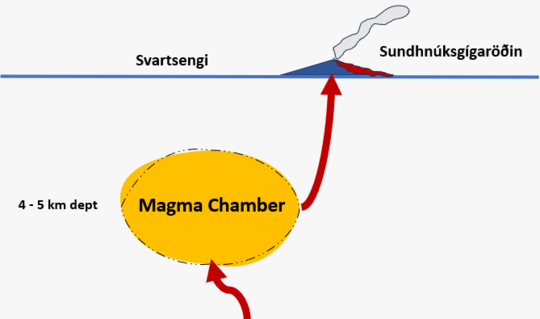
(Billede 1)
(Billede 2)
Modelberegninger tyder på, at over 6 millioner m 3 magma nu er blevet tilføjet magma-reservoiret under Svartsengi siden 16. marts. I tidligere hændelser har magma forplantet sig fra Svartsengi, når mellem 8 og 13 millioner m 3 er blevet tilføjet reservoiret siden sidste hændelse.
Grafen viser den estimerede mængde magma, der er blevet tilføjet under Svartsengi mellem vulkanudbrud og magma-udbredelse, der har fundet sted siden november 2023.
Mere usikkerhed omkring udviklingen af aktiviteten de næste dage eller uger.
Hidtil har den generelle tendens i Sundhnúkur-området været øget sandsynlighed for magmaudbredelse og endda et efterfølgende udbrud. Nu ser det dog ud til, at en ny situation er ved hånden, når en magma-udbredelse kan forekomme under et igangværende udbrud. Lad os huske på, at magma-udbredelse er en pludselig og stor strøm af magma, der forplanter sig ud af et magma-reservoir og kan kulminere med, at magma når overfladen. Efter magmaudbredelsen den 2. marts, som ikke endte med et udbrud, markerede en ændring i aktiviteten, der siden december havde været noget cyklisk.
Hvis magma-akkumulering fortsætter med en lignende hastighed, øges sandsynligheden for en anden magma-udbredelse i de kommende dage eller uger, selvom et udbrud stadig er i gang. Magmaudbredelse fra reservoiret under et igangværende udbrud er indtil videre ikke set før i området. Derfor er der mere usikkerhed om udviklingen af aktiviteten i de næste dage eller uger.
Sandsynligt scenarie, hvis magmaudbredelse falder sammen med det aktuelle udbrud:
- Magma forplanter sig fra magma-reservoiret under Svartsengi til Sundhnúkur-kraterrækken, som det er sket i de sidste seks gange.
- Efter magma-udbredelsen kunne nye eruptive sprækker åbne sig i området mellem Stóra-Skógfell og Hagafell og/eller det nuværende eruptive krater kunne blive forstørret på grund af en pludselig stigning i lavastrømmen. Dette kan ske med meget kort eller ingen varsel.
- Hvis magmaudbredelsen resulterer i, at nye vulkanske sprækker åbner sig andre steder over magmadiget, som blev dannet den 10. november, forventes der meget længere varsel, højst sandsynligt intens seismisk aktivitet, deformation og trykændringer i borehuller.
- Det er også muligt, at magma-udbredelse ikke vil forekomme, men at strømningen af det nuværende udbrud holder op med at falde og begynder at stige støt, indtil en ny ligevægt mellem indstrømningen af magma nedefra og strømning til overfladen fra krateret er nået.
- Men hvis magma-udbredelsen resulterer i, at en ny eruptiv sprække åbner sig andre steder end i området mellem Stóra-Skógfell og Hagafell, vil et sådant scenarie højst sandsynligt blive ledsaget af intens seismicitet og deformation med betydeligt mere varsel end tidligere udbrud.
Opdateret farevurdering
I lyset af usikkerheden forårsaget af stigende tryk i magma-reservoiret under Svartsengi har det islandske meteorologiske kontor øget faren på grund af mulig åbning af eruptive sprækker i zone 1, 4 og 7 fra “lav” til “betydelig”
Den overordnede fare (farve) i de berørte zoner ændres dog ikke.
(klik på billedet for at se det større)
Opdateret 18. april kl. 16:00 UTC
-
Lavafeltet dækker nu 6,15 km 2 og volumenet er 33,2 ± 0,8 millioner m 3 .
-
Gennemsnitlig lavastrøm fra krateret i perioden 8.-15. april er estimeret til 3,2 ± 0,2 m 3 /s.
-
Jordløftet i Svartsengi fortsætter i et jævnt tempo.
-
Fortsat fare på grund af gasforurening. Folk i området rådes til at tjekke luftkvaliteten .
-
Vejrudsigten for gasdistribution i dag (torsdag) er nordvestlig vind, 3-8 m/s, med gasudledning mod sydøst. Følg gasspredningsprognosen her .
Udbruddet ved Sundhnúkur-kraterrækken fortsætter, og et krater lige øst for Sundhnúkur er fortsat i udbrud. Lavafeltet fortsætter med at bygge op tæt på kraterne. Lavaen flyder også i lukkede kanaler omkring 1 km mod sydøst, og der er aktive områder i lavafeltet nord for Hagafell.
Mandag den 15. april gennemførte forskere fra det islandske naturhistoriske institut (IINH) og National Land Survey of Iceland (NLSI) en overvågningsflyvning over udbrudsområdet for at indhente billeder til lavakortlægning ved fotogrammetri. Resultaterne fra overvågningsflyvningen viser, at arealet af lavafeltet den 15. april målte 6,15 km 2 og volumenet 33,2 ± 0,8 millioner m 3 . Lavastrømningsfeltet og tykkelsen af det er vist på kortet nedenfor.
Kort, der viser lavastrømningsområdet og tykkelsen af lavaen dannet i det igangværende udbrud. Lilla farver viser lava dannet i området siden december 2023.
Den gennemsnitlige lavastrøm fra krateret i perioden 8.-15. april er estimeret til 3,2 ± 0,2 m 3 /s. Dette er en lille ændring i forhold til den gennemsnitlige lavastrøm i perioden 3.-8. april, som blev estimeret til 3,6 ± 0,7 m 3 /s. Resultatet af tidligere måling fra IINH og NLSI fotogrammetri-teamet kan ses i tabellen nedenfor.
| Fra | Til | Gennemsnitlig lavastrøm i perioden (m 3 /s) | Areal (km 2 ) |
Bind (millioner m 3 ) |
Gennemsnitlig tykkelse af lavafeltet (m) |
| 16. mar.2024 | 17. mar.2024 | 234 ± 9 | 5,72 | 18,1 ± 0,8 | 3,2 ± 0,1 |
| 17. mar.2024 | 20. mar.2024 | 14,5 ± 0,6 | 5,58 | 20,9 ± 0,5 | 3,7 ± 0,1 |
| 20. mar.2024 | 27. mar.2024 | 7,8 ± 0,7 | 5,99 | 25,7 ± 1,9 | 4,3 ± 0,3 |
| 27. mar.2024 | 3. apr. 2024 | 6,6 ± 0,3 | 6,13 | 29,7 ± 1,7 | 4,8 ± 0,3 |
| 3. apr. 2024 | 8. apr. 2024 | 3,6 ± 0,7 | 6,14 | 31,3 ± 2,4 | 5,1 ± 0,4 |
| 8. apr. 2024 | 15. apr. 2024 | 3,2 ± 0,2 | 6,15 | 33,2 ± 0,8 | 5,4 ± 0,1 |
Jordløftet i Svartsengi fortsætter i et jævnt tempo. Dette indikerer, at omkring halvdelen af magmaen, der stiger op fra dybden, akkumuleres i magmareservoiret, mens den anden halvdel bryder ud til overfladen ved Sundhnúkur-kraterrækken.

Forskydninger på GPS-stationen SENG i Svartsengi siden 11. november 2024 mod nord, øst og lodret (top, midt, bund). Den nederste kurve viser jordløft i millimeter, og gårsdagens (17. april) måling er vist med en grøn prik. De røde lodrette linjer er tidspunktet for de sidste fire udbrud (18. december 2023, 14. januar, 8. februar og 16. marts 2024), og de blå linjer viser indtrængen af magmadiget, der er sket i Sundhnúkur kraterrækkeområdet uden at resultere i et udbrud (10. november 2023 og 2. marts 2024).
Der er fortsat en fare på grund af gasemissioner fra udbruddet, som kan forårsage forurening i bosættelser på Reykjanes-halvøen, og vi råder folk i området til at overvåge luftkvaliteten og sætte sig ind i reaktionen på luftforurening fra udbrud.
Vejrudsigten for gasdistribution i dag (torsdag) er nordvestlig vind, 3-8 m/s, med gasudledning mod sydøst. I morgen (fredag) blæser der sydøst 8-13 m/s med regn. Mere sydlig vind om aftenen. Gasforureningen vil gå mod nordvest i løbet af dagen og senere mod nord. Følg gasspredningsprognosen her .
Opdateret 16. april kl. 18:00 UTC
- Farevurderingen er blevet opdateret. Den samlede fare for Grindavík (Zone 4) vurderes at være betydelig (orange).
- Landhævningen ved Svartsengi fortsætter, og hævningshastigheden har været konstant siden begyndelsen af april.
- Fortsat fare på grund af gasforurening. Folk i området rådes til at tjekke luftkvaliteten .
- Gasspredningsprognosen kan findes her .
- Et krater, der ligger øst for Sundhnúkur, er fortsat aktivt.
Udbruddet ved Sundhnúkur- kraterrækken fortsætter og har nu varet i en måned, hvilket var emnet for en nyhedsrapport offentliggjort tidligere i dag. Et krater, som ligger lige øst for Sundhnúkur, fortsætter med at bryde ud. Lava flyder stadig syd for krateret, men strækker sig ikke langt, så lavafeltet fortsætter med at bygge op nær krateret. Der er et aktivt lavafelt nær Hagafell, som det kan ses på et billede fra det islandske meteorologiske kontors webkamera placeret ved Þorbjörn.
Billede fra det islandske meteorologiske kontors webcam, taget kl. 05.10 den 16. april. Webkameraet er placeret på toppen af Þorbjörn og ser mod øst mod udbrudsstedet. Krateret er i midten af billedet, og lava strømmer ud fra det. Foran krateret er Sundhnúkur, og på højre side af billedet er Hagafell og lavastrømsfronter.
Seismisk aktivitet har været forholdsvis rolig nær udbrudsstedet siden begyndelsen af udbruddet, indtil en lille jordskælvssværm begyndte ved Lágafell efter middag den 14. april. Den seismiske sværm varede over 4 timer og har været forbundet med spændingsændringer i skorpen på grund af land. løft i Svartsengi. Seismisk aktivitet fortsætter i de vestlige skråninger af Fagradalsfjall i 6-8 km dybde og har været i gang siden urolighederne i Sundhnúkur-området i løbet af de sidste 4 måneder.
Landhævningen fortsætter og har været i et stabilt tempo siden begyndelsen af april. Modelberegninger baseret på GPS-data indikerer, at tilstrømningen af magma til magma-reservoiret er omkring halvdelen af, hvad den var før begyndelsen af udbruddet den 16. marts. Dette indikerer, at omkring halvdelen af magmaen, der kommer fra dybden, ophobes i magmaen. reservoir, mens den anden halvdel er udbrudt til overfladen.
I begyndelsen af april begyndte landhævningshastigheden at stige. I øjeblikket bryder en lignende mængde magma ud på overfladen og akkumuleres også i magmakammeret under Svartsengi, hvilket forårsager en trykstigning i magmakammeret.
Der er fortsat risiko for gasemissioner fra udbruddet, som kan forårsage luftforurening i bosættelser på Reykjanes-halvøen, og vi råder folk i området til at overvåge luftkvaliteten og sætte sig ind i symptomer og reaktioner relateret til luftforurening fra udbruddet. .
Vejrudsigten i dag (tirsdag) er en langsom vind, variabel retning. Der kan således samle sig gas i nærheden af udbrudsstedet. I nat vil der vinde sydøstlig 10-15 m/s, med gasudledning nordvest mod Reykjanesbær. Vest- og nordvestlig vind ventes at blive 3-10 m/s i morgen tidlig, og sprede gas øst og sydøst mod Þorlákshöfn. Følg gasspredningsprognosen her .
Farevurdering
Farevurderingen er blevet opdateret og er gældende fra kl. 15:00 i dag til den 23. april med forbehold for udvikling. Farevurderingen er ændret, så faren på grund af lavastrømme er blevet sænket i alle områder undtagen i Zone 3 (Sundhnúkur kraterrækken) og Zone 6. Denne ændring foretages, fordi der ikke har været en aktiv lavastrøm i de øvrige områder. i de sidste to uger. Baseret på den aktuelle aktivitet i udbruddet vurderes det, at lava sandsynligvis ikke vil strømme langt fra krateret og ind i andre farezoner. Denne ændring betyder, at den samlede fare i zone 4 (Grindavík) nu vurderes som betydelig (orange) i stedet for høj (rød). Den samlede fare i andre områder forbliver uændret. Faren fra gasemissioner vurderes fortsat som høj i alle områder undtagen i Sundhnúkur kraterrækkeområdet (zone 3), hvor den vurderes at være meget høj. Faren i Zone 4 (Grindavík) og Zone 6 vurderes fortsat som høj på grund af synkehuller og fejlbevægelser.
(Klik på billedet for at se det større)
Opdateret 15. april kl. 17:30 UTC
-
Vulkanudbruddet, der begyndte den 16. marts, er stadig i gang.
-
Stigningen fortsætter i samme takt siden starten af april.
-
Farevurderingen er gældende indtil 16. april, medmindre situationen ændrer sig.
-
Risikoen for gasemissioner er fortsat betydelig. Folk i området bliver mindet om at overvåge luftkvaliteten.
-
Gasspredningsprognosen kan findes her
Lige efter middag i går begyndte en lille jordskælvsværm nær Lágafell, lige nordvest for Grindavík. Den sluttede omkring halv fire om eftermiddagen. Sværmen bestod af cirka 90 jordskælv, hvor den mest intense aktivitetsperiode var 35 jordskælv mellem kl. 13.00 og 14.00. Alle jordskælv var under størrelsesordenen 1, og de fleste var på dybder på cirka 2-4 km. Denne lille jordskælvsværm skyldtes sandsynligvis stressændringer i jordskorpen på grund af igangværende landstigning i Svartengi, som diskuteret i gårsdagens nyhedsopdatering.
Vedhæftet er en figur, der viser placeringen af jordskælvene på et kort, og derunder er en graf, der viser deres dybde. Panelet øverst til højre viser jordskælvets størrelse i regionen fra middag til aften i går. Panelet i midten til højre viser det samlede antal jordskælv, mens det nederste panel viser antallet af jordskælv i timen. Som grafen viser, blev der registreret flere små jordskælv i området i går eftermiddags, men der har ikke været nogen seismisk aktivitet i regionen siden midnat i dag.
Foto taget onsdag den 10. april, der viser den aktive udluftning set fra Sundhnúkur. (Foto: Jón Bjarni Friðriksson/Island Meteorologisk Kontor). Klik på billedet for at se det større.
Opdateret 14. april kl. 18:00 UTC
-
Vulkanudbruddet, der begyndte den 16. marts, er stadig i gang.
-
Stigningen fortsætter i samme takt siden starten af april.
-
Farevurderingen er gældende indtil 16. april, medmindre situationen ændrer sig.
-
Risikoen for gasemissioner er fortsat betydelig. Folk i området bliver mindet om at overvåge luftkvaliteten.
-
Gasspredningsprognosen kan findes her.
Adskillige små jordskælv (under styrke 1) er blevet detekteret nordvest for Grindavík i de sidste par timer. (Se figurerne nedenfor.) Denne seismiske aktivitet er fokuseret nær diget, der blev dannet den 10. november og er sandsynligvis relateret til jorddeformationen i Svartsengi, som påvirker regionens trykregime.
Dagens seismiske aktivitet kan sammenlignes med aktiviteten målt i dette område i midten af marts sidste år. Derfor tyder den seismiske aktivitet ikke på ændringer i det igangværende vulkanudbrud, som har holdt sig relativt stabilt i weekenden. Den seismiske aktivitet nordvest for Grindavík tyder heller ikke på, at magma bevæger sig under dette område.
I skrivende stund er den seismiske aktivitet nordvest for Grindavík lidt aftaget. Det er usandsynligt, at store jordskælv vil ledsage denne nuværende aktivitet.
Skulle magma afvige fra sin nuværende rute, der kommer til overfladen ved Sundhnúkur-kraterrækken, og i stedet vælge en alternativ sti, såsom at gå mod vest mod Eldvörp eller syd for Þorbirnir, vil forløberen for et muligt udbrud i dette område involvere meget intens seismisk aktivitet og jord. deformation, der er tydeligt synlig på instrumenter og satellitbilleder. I øjeblikket er der ingen sådanne tegn på nuværende tidspunkt.
Det islandske meteorologiske kontor fortsætter sin 24-timers overvågning af området for at overvåge udbrudsstedet.
Denne figur viser seismisk aktivitet fra den 9. marts til i dag den 14. april. De sorte linjer repræsenterer de ydre grænser for de grabene, der er dannet i forbindelse med den betydelige digeindbrud den 10. november 2023 og udbruddet den 14. januar i år. De fleste af jordskælvene i dag har været mindre end 1. Blå cirkler repræsenterer jordskælv, der fandt sted fra 9. til 14. marts, mens røde cirkler repræsenterer jordskælv, der fandt sted i dag, 14. april. Jordskælvene er placeret på den vestlige kant af lavningen dannet i november 10.
I området nordvest for Grindavík er der en række kendte forkastninger med nord-syd orientering, som er dannet, da diget indtrængen skete den 10. november. Derfor er dagens jordskælv også tegn på spændingsudløsning langs disse forkastninger på grund af landhævningen i Svartsengi.
Opdateret 12. april kl. 14:15 UTC
- Vulkanudbruddet, der begyndte den 16. marts, er stadig i gang.
- Landstigningen fortsætter i samme takt siden starten af april.
- Farevurderingen er gældende indtil 16. april, medmindre situationen ændrer sig.
- Risikoen for gasemissioner er fortsat betydelig. Folk i området bliver mindet om at overvåge luftkvaliteten .
- Gasspredningsprognosen kan findes her .
Udbruddet, der startede ved Sundhnúkur-kraterrækken om aftenen den 16. marts, er stadig i gang. Én udluftning forbliver aktiv, som den har været siden 5. april. Lava fortsætter med at strømme sydpå fra udluftningen, men rejser sig ikke langt, så lavafeltet fortsætter med at bygge op nær krateret. Der er ingen synlige tegn på lava, der bevæger sig frem mod de beskyttende barrierer nord for Grindavík, Suðurstrandarvegur eller Melhólsnáma.
Landstigningen i Svartsengi fortsætter i samme takt, som steg i begyndelsen af april. Dette er en hurtigere hastighed end den, der blev observeret fra begyndelsen af udbruddet den 16. marts til slutningen af marts . Dette indikerer, at størstedelen af magmaen, der strømmer ind i reservoiret under Svartsengi, akkumuleres der, hvilket forårsager en stigning i tryk og jordløftning. Mens udbruddet fortsætter, er der stadig en åben forbindelse mellem magma-akkumuleringsområdet i Svartsengi og Sundhnúkur-kraterrækken, og en del af magmaen fortsætter med at strømme til overfladen der. Mindre ændringer i lavafeltet kan observeres mellem dage, men den samlede rate har været stabil siden begyndelsen af april.
Farevurderingen forbliver uændret og gyldig indtil kl. 15.00 den 16. april. Se flere detaljer her .
Der er stadig risiko for gasemissioner fra vulkanen, som kan forårsage forurening på Reykjanes-halvøen. Folk i området rådes til at overvåge luftkvaliteten og gøre sig bekendt med symptomer på udsættelse for vulkansk gasforurening.
Et fotografi taget onsdag den 10. april, der viser det aktive krater set fra Sundhnúkur. (Foto: Jón Bjarni Friðriksson)
Opdateret 9. april kl. 17:30 UTC
-
På trods af et fald i intensiteten af vulkanudbruddet er der ingen tegn på, at den samlede magmastrøm fra dybden er aftagende.
-
Den gennemsnitlige strømningshastighed for lavastrømmen fra åbningerne mellem 3. og 8. april er estimeret til at være 3,6 ± 0,7 m3/s.
-
I morgen forventes der østlige og sydøstlige vinde, der fører gasudslip mod vest og nordvest fra udbrudsstederne. Følg gasspredningsprognosen her.
-
Periodisk bliver der fortsat målt høje niveauer af SO2 omkring vulkanen og i bosættelser på Reykjanes-halvøen. Beboere opfordres til at overvåge luftkvaliteten i området.
Eksperter fra det islandske meteorologiske kontor og Landtilsynet foretog luftmålinger over udbrudsstedet i går den 8. april. Ved hjælp af de data, der er indsamlet under flyvningen, er det muligt at vurdere størrelsen af lavafeltet og strømningshastigheden af lava fra udbruddet. Resultaterne indikerer et konstant og væsentligt fald i intensiteten af vulkanudbruddet.
Den gennemsnitlige lavastrøm fra åbningerne mellem 3. og 8. april er estimeret til at være 3,6 ± 0,7 m3/s. Baseret på data indsamlet af ingeniørfirmaet Efla den 3. april under en droneflyvning blev den gennemsnitlige lavastrøm estimeret til at være 6,6 ± 0,3 m3/s fra 27. marts til 3. april. Lavafeltet har nået et areal på 6,14 km2 med et volumen på 31,3 millioner m3. Tidligere strømmede lavaen primært sydpå fra åbningerne, men skiftede kortvarigt mod nord søndag aften (7. april), da en åbningsvæg kollapsede, som nævnt i sidste opdatering. Som vist på det medfølgende kort, er lavaen tyknet betydeligt nær udluftningerne og lige syd for dem, hvor der er mest aktivitet i lavafeltet. Der er ingen synlige tegn på lavafremrykning mod beskyttende barrierer nord for Grindavík, Suðurstrandarvegur eller Melhólsnáma.
Kort, der viser omfanget og tykkelsen af lavaen dannet i det aktuelle udbrud. Lilla områder viser lava, der har strømmet i området siden december 2023.
Jorddeformation er steget i løbet af den seneste uge
Jorddeformation i Svartsengi fortsætter med at stige, hvilket falder sammen med et fald i intensiteten af vulkanudbruddet. Dette indikerer, at størstedelen af magmaen, der strømmer ind i reservoiret under Svartsengi, akkumuleres der, hvilket forårsager en stigning i tryk og jordløftning. Mens udbruddet fortsætter, er der stadig en åben forbindelse mellem magma-akkumuleringsområdet i Svartsengi og Sundhnúkur-kraterrækken, og en del af magmaen fortsætter med at strømme til overfladen der.
Seismisk aktivitet i diget nær Grindavík er forblevet meget lav og er fokuseret mellem Sýlingarfell og Stóra-Skógafell, med let seismicitet i det vestlige Grindavík. Seismisk aktivitet nær Fagradalsfjall, som har været vedvarende den seneste måned, er i gang og er fortsat lokaliseret på dybder på omkring 6-7 km.
Gasmålinger udført i går, den 8. april, estimerer en svovldioxid (SO2) emissionsrate på 10-18 kg/s fra ventilationsåbningerne. Periodisk bliver der fortsat målt høje niveauer af SO2 omkring vulkanen og i bosættelser på Reykjanes-halvøen. Gasemissioner fra udbruddet vil sandsynligvis forårsage forurening på Reykjanes-halvøen, og beboere rådes til at overvåge luftkvaliteten og gøre sig bekendt med symptomer relateret til luftforurening fra udbruddet.
Ifølge vejrudsigten forventes der i dag nordlige vinde, der fører gasudslip mod syd. Langsom, varierende vind om eftermiddagen kan resultere i gasforurening nær udbrudsstederne. I morgen forventes østlige og sydøstlige vinde, der fører gasudledninger mod vest og nordvest. Følg gasspredningsprognosen her.
Uændret risikovurdering
Farevurderingen er blevet opdateret og er gyldig fra kl. 15:00 i dag til den 16. april, medmindre situationen ændrer sig. Der er ingen ændringer i farevurderingen, og risikoen for gasforurening er fortsat høj i alle områder undtagen omkring Sundhnúkur-kraterrækken (Zone 3), hvor den vurderes at være meget høj. Risikoen i Zone 4 (Grindavík) og Zone 6 er fortsat høj på grund af jordskælv, jorddeformation, lavastrømme og gasforurening.
(Klik på billedet for at se det større)
På trods af faldet i intensiteten af vulkanudbruddet er der ingen tegn på, at den samlede magmastrøm fra dybden ind i Svartsengi-reservoiret er aftagende. Dette refererer til det samlede volumen af magma, der akkumuleres under Svartsengi, foruden magmaet, der strømmer mod overfladen i det nuværende udbrud ved Sundhnúkur-kraterrækken. Det er svært at forudsige, hvornår dette udbrud vil ende; den kan fortsætte i en længere periode med jævn strøm eller ophøre i den nærmeste fremtid. Efterhånden som magma fortsætter med at akkumulere under Svartsengi, og trykket stiger, er der stadig en mulighed for, at udbruddets intensitet kan stige igen, svarende til begivenhederne ved Fagradalsfjall i 2021. Hvis udbruddet snart ophører, vil magmaakkumulering sandsynligvis fortsætte under Svartsengi, og en række begivenheder svarende til det, der er observeret i den seneste måned, kan gentage sig.
Opdateret 8. april kl. 16:30 UTC
- Vulkanudbruddet fortsætter. En udluftning er aktiv.
- Landet har rejst sig i Svartsengi cirka 2-3 cm mellem 2. og 7. april.
- Der blev målt minimale gasudledninger i weekenden, men periodisk kan der stadig påvises høje niveauer af svovldioxid omkring vulkanen og i bebyggelser på Reykjanes-halvøen. Beboere opfordres til at overvåge luftkvaliteten i området.
- Dagens vejrudsigt indikerer en nordøstlig vindretning, hvilket får gasudledningen til at drive sydvestover over områder inklusive Grindavík. Der forventes østlige vinde i morgen den 9. april, og gasudledninger forventes at rejse mod vest fra udbrudsstederne. Følg gasspredningsprognosen her.
Udbruddet ved Sundhnúkur-kraterrækken fortsætter, med en udluftning nu aktiv. I går strømmede lava fra udluftningen sydpå i en begrænset strøm, hvilket resulterede i en storslået flod af lava. I mellemtiden steg overfladeniveauet af lava i krateret gradvist, indtil det næsten var fyldt. Den nordlige væg af udluftningen kollapsede omkring klokken 21:30 i går aftes, hvilket fik lavaen til at flyde nordpå. I dag, den 8. april, har lavastrømmen for det meste genoptaget sin sydlige retning. Lavaen, der rykker frem mod nord, som observeret i går aftes og natten over, ser ud til at være standset på bjergsiden. Krateret fortsætter med at fyldes op.
Seismiske målinger nær udbrudsstedet viser vulkansk tremor, der udviser stærke frekvenser mellem 1 og 2 Hz (grøn kurve på grafen); en stigning i styrken af denne tremor svarer til lavaens maksimale strøm fra udluftningen. Efter sammenbruddet af udluftningsvæggen ser den seismiske aktivitet ud til at falde igen. Lignende seismisk aktivitet blev observeret under det nylige vulkanudbrud i Geldingadalur, hvor den seismiske aktivitet steg, efterhånden som udledningen af lava blev intensiveret.
Hævningen er steget en smule i Svartsengi, og baseret på GPS-målinger og syntetiske blænderadarbilleder er landet steget med 2-3 cm fra 2. til 7. april. Det er dog mindre end jorddeformationen målt efter det forrige udbrud i sidste måned. Øget stigning kunne tyde på, at magma, der strømmer ind i Svartsengi, er steget, eller at der har været en opbremsning i strømmen af magma mod det nuværende udbrudssted.
Minimale gasemissioner er blevet opdaget på gasmonitorer, der drives af Miljøstyrelsen i Island (UST) og det islandske meteorologiske kontor i weekenden, men periodisk kan der stadig detekteres høje niveauer af svovldioxid omkring vulkanen og i bebyggelser på Reykjanes-halvøen. Beboerne bliver mindet om at overvåge luftkvaliteten på USTs luftkvalitetshjemmeside loftgæði.is
Dagens vejrudsigt indikerer en nordøstlig vindretning, hvilket får gasudledningen til at drive sydvestover over områder inklusive Grindavík. Der forventes østlige vinde i morgen den 9. april , så gasudslip kan forventes at drive vestpå fra udbrudsstederne. Den seneste gasspredningsprognose kan følges her.
Opdateret 4. april kl. 17:00 UTC
Udbruddet ved Sundhnúkur-kraterrækken fortsætter, og to kratere er stadig aktive som de seneste dage. Det nordlige krater er større, og det meste af lavastrømmen ser ud til at være udbrudt fra det, som det kan ses på billedet nedenfor, som blev taget i nat, den 3. april. Lava fortsætter med at strømme sydpå fra kraterne på toppen af lavafeltet dannet i de første par dage af dette udbrud. I aftes var der ingen tydelige tegn på lavastrømning langs lavabarriererne nord for Grindavík, Southcoast road eller Melhólsnáma-minen.
Luftbillede fra en droneflyvning opereret af Civil Protection i aftes den 3. april. Billedet viser de to kratere og lavaen, der strømmer fra dem mod syd.
Et interferogram, der dækker perioden 18. marts – 3. april, viser, at landet har hævet sig omkring 3 cm i Svartsengi i den tid. Dette er en betydeligt langsommere deformation, der blev målt forud for de udbrud og digeudbredelser, der har fundet sted i de sidste måneder. Data fra GPS-målinger i samme periode tyder på, at hastigheden af landhævningen har varieret, men det er vanskeligt at estimere dag-til-dag deformation baseret på disse data. I betragtning af GPS-dataene for samme tidsperiode som interferogrammet (18. marts – 3. april), er de to datasæt konsistente. Landhævning påvises i Svartsengi under udbruddet, hvilket ikke er set i de begivenheder, der tidligere har fundet sted på Sundhnúkur-kraterrækken. Dette indikerer, at systemet er åbent, og magma fortsætter med at strømme fra betydelig dybde under Svartsengi til overfladen i Sundhnúkur-kraterrækken.
Interferogram (InSAR) viser deformation fra 18. marts – 3. april. Gule og orange farver viser områder omkring Svartsengi, hvor landhævning registreres.
Gasmålinger gennemført sidste tirsdag den 2. april anslår, at ca. 37-41 kg/s SO 2 udsendes fra kraterne. Midlertidigt høje svovldioxidniveauer bliver fortsat målt omkring udbrudsstedet og i kommuner på Reykjanes-halvøen. Gas fra udbruddet vil sandsynligvis forårsage forurening på Reykjanes-halvøen, og vi råder folk i området til at overvåge luftkvaliteten på loftgaedi.is og sætte sig ind i reaktionen på luftforurening fra vulkanudbrud.
Vejrudsigten i dag (torsdag) er sydøstlige og sydlige vinde på 8-13 m/s på udbrudsstedet, hvilket medfører, at gas spredes mod nordvest og nord, hvilket betyder, at der kunne detekteres gas i Vogar, Reykjanesbær og Suðurnesjabær. Østlig vind 5-10 m/s i morgen (fredag), hvilket forårsager gasspredning mod vest, for eksempel til Svartsengi. Nordvestlig vind, 5-10 m/s sent i morgen forårsager gasforurening i sydvest og muligvis i Grindavík.
Gasdistributionsprognose er her .
Farevurdering offentliggjort den 2. april forbliver uændret og er gyldig indtil 9. april med forbehold for udvikling.
Opdateret 2. april kl. 17:30 UTC
-
Udbruddet fortsætter, og to kratere er nu aktive. Inflation er ikke blevet opdaget i de sidste par dage.
-
På det seneste er der opstået vegetationsbrande omkring lavafeltet, og det er en løbende risiko, mens vejret er tørt.
-
Gasforurening er spredt mod sydvest og senere mod vest og vil sandsynligvis blive opdaget lejlighedsvis i Grindavík og muligvis i Hafnir. Gasdistributionsprognose og luftkvalitet kan overvåges.
-
Lavakanterne har nået betydelige højder og kan være ustabile.
-
Farevurdering uændret.
Udbruddet ved Sundhnúkur-kraterrækken fortsætter, og to kratere er nu aktive. Det tredje krater, som var meget mindre end de to andre, blev slukket i påsken. Vulkansk tremor forbliver stabil.
Inflation i Svartsengi er ikke blevet opdaget i de seneste dage, hvilket indikerer, at mindre magma ophobes i magma-reservoiret under Svartsengi, og i stedet strømmer mod kraterne, hvor det bryder ud. Der kan opnås en balance mellem tilstrømningen af magma til Svartsengi-reservoiret og udbrudskratere, men geokemiske undersøgelser kan bekræfte dette i fremtiden.
Eksperter fra National Land Survey of Iceland har behandlet satellitdata fra den 27. marts, der viser, at lavafeltet dengang var 5,99 km2 og lavaens volumen siden begyndelsen af udbruddet var 25,7 ± 1,9 millioner m3. Den gennemsnitlige ekstruderingshastighed af lava fra kraterne blev estimeret til 7,8 ± 0,7 m3/s, hvilket er meget sammenligneligt med ekstruderingshastigheden under den første fase af Geldingadalir-udbruddet i 2021. Målet er at tage luftfotos af området i kommende dage for at få opdaterede ekstruderingsrater siden 27. marts, hvilket vil give yderligere indsigt i udviklingen af den eruptive aktivitet. Det følgende kort viser lavastrømningsfeltet og dets tykkelse, som det var den 27. marts.
Kort, der viser strømningsfeltet og tykkelsen af lavaen dannet under det igangværende udbrud. Lilla lag viser lavaer, der er dannet i området siden december 2023.
Vegetationsbrande omkring lavafeltet
På det seneste er der opstået vegetationsbrande omkring lavafeltet, og det er en løbende risiko, mens vejret er tørt.
Lavakanterne har nået betydelige højder og kan være ustabile, pludselige og hurtige lavaudbrud kan opstå, hvis nye lavalapper bryder ud fra kanten af en lavarand.
I de seneste dage er der lejlighedsvis påvist høje niveauer af svovlbrinte i Grindavík. Vejrudsigten i dag (tirsdag) er nordøstlig og senere østlig vind 5-13 m/s på udbrudsstedet. Gasforurening er derfor spredt mod sydvest og senere mod vest, og vil sandsynligvis blive opdaget lejlighedsvis i Grindavík og muligvis i Hafnir. Østlige og sydøstlige vinde 3-10 m/s i morgen (onsdag), hvilket får gasforurening til at rejse mod vest og nordvest, og kan således opdages i mange dele af det vestlige Reykjanes-område, herunder Reykjanesbær. Gasdistributionsprognose er her .
Farevurdering uændret
Farevurderingen er blevet opdateret og gælder fra kl. 15:00 i dag til den 9. april, med forbehold for væsentlige udviklinger. Der er ingen ændringer i farevurderingen, og faren fra gasforurening vurderes fortsat høj i alle områder undtagen ved Sundhnúkur kraterrækkeområdet (zone 3), hvor den vurderes som meget høj. Faren i zone 4 (Grindavík) og zone 6 vurderes fortsat som høj på grund af synkehuller, fejlbevægelser, lavastrømning og gasforurening.
Opdateret 27. marts kl. 14:00 UTC
- Høje niveauer af SO 2 (Svovldioxid) blev målt i weekenden. Gasspredningsprognose kan følges her .
- Denne koncentration af SO 2 anses for at være meget usund. Det er vigtigt at være meget opmærksom på udviklingen i luftkvaliteten.
- Vulkanudbruddet har været stabilt siden mandag den 25. marts.
Vulkanudbruddet har været stabilt siden mandag den 25. marts. Udbrudsrysten har været konstant siden da, ligesom aktiviteten i de tre kratere. Lava fortsætter med at strømme sydpå fra kraterne, for det meste oven på lavafeltet, der blev dannet i løbet af de første dage af udbruddet. Det følgende billede viser udvidelsen af lavafeltet som ekstrapoleret fra satellitbilleder (ICEYE). Den seneste anskaffelse var den 26. marts, og den viser udvidelsen af lavafeltet mod vest, syd for Hagafell, samt yderligere lavafremrykning mod øst og syd for de aktive åbninger.
Stribede områder angiver områder, hvor der skete ændringer i lavafeltet mellem den 20. og 26. marts. Den rødstribede del af området betegner et område, hvor lava ikke havde strømmet tidligere i dette udbrud. Lyslilla områder betegner områder, hvor lava strømmede fra udbrud i februar og januar.
Hævningen fortsætter i Svartsengi, men i et langsommere tempo end før tidligere udbrud eller digeindtrængninger i de seneste måneder. Dette tyder på, at magma stadig ophobes under Svartsengi på trods af igangværende udbrud. Lidt eller ingen seismisk aktivitet er blevet påvist i området.
Høje niveauer af SO2 målt de sidste par dage
Siden fredag (22. marts) er der blevet installeret to yderligere stationer til at overvåge koncentrationerne af SO2 ved jorden. VÍ har i samarbejde med Almannavarnir lokaliseret dem ved Blue Lagoon og i havneområdet i Grindavík. Begge stationer streamer data til USTs hjemmeside, loftgæði.is.
Tidligt i går morges omkring klokken 03:00 afslørede stationen i BL niveauer af SO2 op til 7000 mikrogram/m3, og i morges omkring klokken 04:00 målte stationen i Grindavík (Nesvegur) koncentrationer op til 9000 mikrogram/m3. Sådanne koncentrationer betragtes som óholl, og folk anbefales at følge instruktionerne fra UST og Embætti landlæknis (link). Den 26. marts viste stationen i Hafnir også høje koncentrationer af SO2 op til omkring 2000 mikrogarm/m3 omkring middagstid. Mængden af SO2 frigivet ved udbruddet og meteorologien i området skaber stadig betingelser for alvorlig gasforurening på halvøen.
Foto siden i morges (27. marts) fra IMO’s webcam placeret ved Hópsnes SE for Grindavík. I midten af billedet er bjerget Þorbjörn og udbrudsstedet øst for det, hvor gasfanen stiger og bevæger sig mod vest på grund af østenvind.
Opdateret 25. marts kl. 16:30 UTC
- Høje niveauer af SO 2 (Svovldioxid) blev målt i weekenden. Gasspredningsprognose kan følges her .
- Denne koncentration af SO 2 anses for at være meget usund. Det er vigtigt at være meget opmærksom på udviklingen i luftkvaliteten.
- Vulkanaktiviteten ser ud til at være faldet ved Sundhnúksgíga.
- Farevurderingen forbliver uændret. Øgede farer fortsætter på grund af gasemissioner
Den vulkanske aktivitet ved Sundhnúksgíga ser ud til at være faldet i løbet af de sidste par dage. Aktiviteten i åbningerne er faldet og muligvis ophørt i de mindste kratere. Derudover er vulkansk tremor gradvist aftaget i løbet af de sidste par dage. Hovedlavastrømmen løber sydpå fra åbningerne og bøjer derefter mod vest. I weekenden fortsatte lava med at strømme ind i Melhólsnáma og har nu fyldt den. Lavaen fortsætter dog også med at blive tykkere nær kraterne.
GPS-målinger i de seneste dage indikerer en igangværende landstigning i Svartsengi, men den udviser en langsommere hastighed end før. Dette tyder på, at magma fortsætter med at akkumulere i reservoiret under Svartsengi på trods af det igangværende udbrud.
Høje niveauer af SO2 målt de sidste par dage
Høje niveauer af SO 2 er blevet målt i Höfn og Grindavík de seneste par dage. Denne koncentration anses for at være meget usund, og folk vil sandsynligvis opleve luftvejssymptomer, hvis de udsættes. Det er vigtigt at blive indendørs, lukke vinduer og slukke for aircondition. Dette er især vigtigt, hvor der udføres udendørs arbejde, som oplyst af arbejdssikkerhedsmyndighederne; virksomheder og institutioner i den sydvestlige region af landet skal være meget opmærksomme på den videre udvikling i luftkvaliteten på grund af den potentielle risiko for gasforurening. Folk i området rådes til at overvåge luftkvaliteten og gøre sig bekendt med symptomer på luftforurening fra vulkanske gasser.
Vejrudsigten for i dag (mandag) forudser nordøstlige vinde på 3-8 m/s ved udbrudsstederne, hvor forureningen driver sydvestover (over Grindavík og Svartsengi); gas kan samle sig i nærheden af udbrudsstederne på grund af langsomme vindhastigheder. Om aftenen, natten og de tidlige morgentimer forventes der at komme vind fra øst med 8-13 m/s ved udbrudsstederne, hvilket får forureningen til at drive vestpå mod områder inklusive Hafnir. I denne periode er det også muligt, at vinden til tider kan blive sydøstlig, hvilket potentielt kan forårsage forurening i Njarðvík, Keflavík og Sandgerði. Senest på eftermiddagen i morgen (tirsdag) vil vinden skifte til nordøst med 3-8 m/s, hvilket får gasforureningen til at drive mod sydvest (over Grindavík og Svartsengi) og muligvis samle sig nær udbrudsstederne på grund af svag vind. Gasspredningsprognosen kan findes her .
Ingen ændringer i farevurderingen
Farevurderingen er blevet opdateret og gælder fra kl. 15:00 i dag til den 2. april, med forbehold for væsentlige udviklinger. Der er ingen ændringer i farevurderingen, og risikoen for gasforurening er fortsat høj i alle områder bortset fra Sundhnúksgíga kraterrækken (område 3), hvor den vurderes at være meget høj. Faren i område 4 (Grindavík) er fortsat høj på grund af forkastningsbevægelser, synkehuller over sprækker, lavastrømme og gasforurening.
(Klik på kortet for at se det større)
Opdateret 22. marts kl. 17:20 UTC
- Opdateret farevurdering.
- Øget risiko på grund af gasudledning. Gasspredningsprognose her
- Volcanis aktivitet på udbrudsstedet stabil
Vulkanaktiviteten på udbrudsstederne nær Sundhnúkur er fortsat stabil. Der er ringe eller ingen jordskælvsaktivitet i diget eller dets nærhed. Landhævningen i området omkring Svartsengi har været meget lille siden digets indtrængning og det efterfølgende udbrud begyndte den 16. marts. Dette tyder på, at mindre magma ophobes under Svartsengi og i stedet strømmer mere direkte ud af reservoiret gennem de eruptive sprækker. Der kan dog være tegn på, at stigningen er steget i Svartsengi siden da, men det kan ikke bekræftes på nuværende tidspunkt. Målinger i de kommende dage vil kaste mere lys over denne udvikling.
Dagens (fredagens) vejrudsigt inkluderer nord til nordvestlig vind omkring 8-15 m/s, skiftende til en mere nordøstlig retning om aftenen med noget lavere hastigheder, og svagere nordøstlig vind i morgen tidlig. Gasemissioner vil for det meste blive rettet syd for udbrudsstederne mod Grindavík. Gasspredningsprognoser kan findes her .
Øgede farer på grund af gasemissioner
Farevurderingen er blevet opdateret og gælder fra kl. 15.00 i dag fredag den 22. marts til mandag den 25. marts kl. 15. Risikoen på grund af gasudledning vurderes at være højere inden for alle regioner sammenlignet med de foregående dage. Det skyldes den ugunstige vejrudsigt for de næste dage og højere målte værdier af svovldioxid (SO2)-emissioner fra udbrudsstederne og lavafeltet end tidligere. I område 1 og 5 (nordvest for udbrudsstederne) er risikoen for lavastrømme lavere, end den var de seneste tre dage. Denne risiko er faldet, fordi lavastrømmen nord for udbrudsstederne er stabiliseret, og lava flyder nu fortrinsvis mod syd. Lavafeltet er dog stadig farligt, fordi det er dannet for ganske nylig.
(Klik på kortet for at se det større)
Opdateret 21. marts kl. 11:40 UTC
-
Gennemsnitlig udledningshastighed for 17. – 20. marts er 14,5 m 3 /s
-
Den nye lava dækker nu et areal på 5,58 km 2 og har et volumen på 20,9 millioner kubikmeter.
-
Ophobning af magma under Svartsengi ser ud til at være stoppet, og i stedet strømmer magma direkte til overfladen og føder udbruddet.
-
Der er målt mindre deformationer i Svartsengi-området og i nærheden af digets indbrud.
Den eruptive aktivitet ser ud til at have været relativt stabil de sidste 24 timer. De samme åbninger ser ud til at være aktive, og kratere fortsætter med at bygge sig op omkring åbningerne. Lava strømmer mod syd fra kraterne i en aktiv lavastrøm, både på overfladen og under lavaens størknede overflade.
Oversigt over udbrudsstedet taget på et fly i går morges den 20. marts kl. 9.00. Det viser alle de aktive vulkanske åbninger.
I går morges gennemførte eksperter fra National Land Survey of Iceland og Naturhistorisk Institut luftfotoflyvninger over udbrudsstedet. Ud fra disse billeder er det estimeret, at den gennemsnitlige udledningshastighed for udbruddet i perioden 17.-20. marts er 14,5 m3/s. Dette er den samme udledningshastighed som observeret under udbruddene i Fagradalsfjall 2021-2023. Udledningshastigheden i de første 24 timer af udbruddet var dog væsentligt højere. Arealet af det nye lavafelt blev målt til 5,58 km2 og rumfanget 20,9 millioner kubikmeter. Kortet nedenfor viser omfanget og tykkelsen af den nye lava målt i går morges den 20. marts. Lavaen er 16 m tyk, hvor den er tykkest ved kraterne.
Kort, der viser omfanget af den nyligt udbrudte lava. Violet lag viser den ældre lava, der brød ud i december 2023, januar 2024 og februar 2024.
Der er målt meget lidt deformation i Svartsengi-området og i nærheden af digeformationen. Enhver målt deformation er så lille, at variationen mellem dage er ubetydelig. Der er behov for adskillige flere datapunkter for at udlede, om en stigning fortsætter i området. Det kan dog fastslås, at magma nu strømmer direkte til overfladen og fodrer udbruddet.
Vejrudsigten i dag for området er nord- og nordvestlig vind, 8-15 m/s, gasforurening er spredt mod øst og sydøst og kunne mærkes i Sydisland, for eksempel i Þorlákshöfn og i Vestmannaeyjar. En mere nordlig vind i morgen (fredag), der får gasforurening til at spredes mod syd og sydøst og kunne mærkes i og omkring Grindavík.
Opdateret 20. marts kl. 13:45 UTC
Eruptivaktiviteten ser ud til at være relativt stabil, og udbrudsåbninger forbliver de samme steder som i går. Lava flyder fra kratrene mod syd, oven på lava, der flød i de første dage af udbruddet. Lidt eller ingen bevægelse er blevet opdaget på lavastrømsfronterne nær South Coast Road og Svartsengi. Seismisk aktivitet siden udbruddet startede lørdag aften har været mindre.
Vejrudsigten er stigende sydøstlig vind i dag, 13-20 m/s om eftermiddagen, men aftager om aftenen. Gasforurening spredes således mod nordvest og kunne påvises i Reykjanesbær og nærliggende områder. Gasfordelingsprognose kan findes her . Den 17. marts blev SO 2 -gasudledningen fra udbruddet målt op til 50 kg/s, men foreløbige resultater fra nye målinger tyder på, at udledningen af gas er faldet betydeligt siden da.
Et InSAR-billede offentliggjort i går viste tydelige tegn på jordinflation i Svartsengi fra 17. til 18. marts. GPS-data fra 18. marts tyder på, at inflationen muligvis er faldende. Dette kan skyldes, at magma nu strømmer mod overfladen i Sundhnúkur-kraterrækken og derfor ikke akkumuleres under Svartsengi. Udviklingen af udbruds- og deformationssignalerne i løbet af de næste par dage vil afsløre, om der vil blive opnået en ligevægt mellem magma-tilstrømningen under Svartsengi og lavastrømmen på overfladen i Sundhnúkur-kraterrækken.
Her til morgen foretog eksperter fra National Land Survey of Iceland og Naturhistorisk Institut luftfotoflyvninger over udbrudsstedet. Ud fra disse billeder er det muligt at estimere størrelsen af lavafeltet og den gennemsnitlige lavastrøm fra udbruddet. Der vil blive offentliggjort estimater, så snart dataene er blevet behandlet.
Billedtekst: Oversigt over udbrudsstedet taget på en flyvning i morges. Det viser alle de aktive vulkanske åbninger og flavastrømme fra dem mod syd. I baggrunden til venstre ses Grindavík og til højre er Svartsengi. (Billede: Birgir V. Óskarsson – Naturhistorisk Institut).
Opdateret farekort
Det islandske meteorologiske kontor har opdateret sin farevurdering i lyset af de seneste data. Den nye farevurdering træder i kraft i dag onsdag den 20. marts og gælder indtil den 22. marts, medmindre situationen ændrer sig. Zone 3 (Sundhnúkur-kraterrækken), hvor udbruddet stadig er i gang, forbliver uændret, og faren anses for meget høj. Faren i zone 1 (Svartsengi) anses nu for at være betydelig, mens den tidligere blev anset for høj. Faren i zone 4 (Grindavík) er fortsat høj, da risikoen på grund af synkehuller, fejlbevægelser og lavastrøm anses for høj. I zone 3 (Sundhnúkur-kraterrækken) vurderes risikoen på grund af gasforurening som meget høj, men i alle andre områder vurderes risikoen for gasforurening nu at være betydelig, hvorimod den tidligere var høj. Denne ændring skyldes lavere gasemissioner fra udbruddet end ved begyndelsen. Faren på grund af gasforurening og aske vurderes også ud fra vejr- og spredningsprognosen for de næste dage, hvilket påvirker spredningen.
(Klik på kortet for at se det større)
Opdateret 19. marts kl. 17:30 UTC
- Udbruddet fortsætter og har været i gang siden 16. marts kl. 20:23 UTC.
- Vulkansk tremor er detekteret og har været relativt stabil de seneste to dage, hvilket indikerer, at udbruddets kraft ikke er aftaget.
- Inflationen fortsætter i Svartsengi, hvilket tyder på, at magma stadig stiger fra dybden ind i magma-reservoiret under Svartsengi såvel som strømmer mod udbrudsstedet.
- Farevurderingskortet, som blev opdateret i går (18. marts) er uændret.
Udbruddet fortsætter og har nu varet i over to et halvt døgn, hvilket er længere end de tidligere tre udbrud, der har fundet sted i området siden december 2023. Udbrudsaktiviteten er de samme steder som i går eftermiddags, på den sydlige del af den vulkanske sprække. Kraterkanter fortsætter med at bygge op, og lavaspringvandet er stadig betydeligt. Lavastrømsfronten, som lå cirka 300 m fra Sydkystvejen i går, ser ikke ud til at have bevæget sig fremad. Lavastrømmen fra kraterne forbliver for det meste mod syd, med aktive lavastrømsfronter på toppen af lavaen, der flød i begyndelsen af udbruddet.
Seismisk aktivitet har været ubetydelig ved digeområdet siden udbruddet startede, men vulkansk rystelse er registreret og har været relativt stabil de seneste to dage, hvilket tyder på, at udbruddets kraft ikke er aftaget.
Da magma forplantede sig fra Svartsengi mod Sundhnúkur-kraterrækken om aftenen den 16. marts, blev der påvist landsynkning i Svartsengi, som da tidligere magmadige blev dannet. GPS-data og satellitbilleder modtaget efter magma-udbredelsen viser, at overfladeinflationen fortsætter i Svartsengi, hvilket tyder på, at magma stadig stiger op fra dybden ind i magma-reservoiret under Svartsengi, samt fodrer udbruddet.
Det skal bemærkes, at der stadig er opnået relativt få datapunkter i den korte tid siden udbruddet begyndte, og at dataene altid er behæftet med usikkerhed. Deformationsdata, som vil være tilgængelige i løbet af de næste par dage, vil give eksperter mulighed for yderligere at estimere ved hjælp af modelberegninger mængden af magma, der strømmer ind under Svartsengi.
InSAR-billede, der viser målt inflation (røde områder) mellem 17. og 18. marts efter udbruddet begyndte. Billedet er baseret på data fra ICEYE-satellitten
Ifølge målinger foretaget i nat er udstrømningen af gas fra udbruddet faldet i forhold til, hvad den var i begyndelsen af udbruddet. Det er dog stadig sandsynligt, at der vil blive opdaget gasforurening, og vejrudsigten indikerer tiltagende sydvestlig vind, omkring 13-20 m/s på udbrudsstedet i dag, men vinden vil aftage i aften. Gasforureningen er således rettet mod nordøst. Se gasfordelingsprognose her .
Farevurderingskortet, der blev opdateret i går, forbliver uændret indtil kl. 15:00 i morgen den 20. marts, med forbehold for ændringer i situationen.
Opdateret 18. marts kl. 18:30 UTC
Det islandske meteorologiske kontor har opdateret farevurderingen for at tage højde for de seneste data. Den nye farevurdering træder i kraft i dag mandag den 18. marts og gælder indtil den 20. marts, medmindre situationen ændrer sig. Zone 3 (Sundhnúkur-kraterrækken), hvor vulkanudbruddet stadig er i gang, forbliver uændret, mens fareniveauet forbliver meget højt. Fareniveauet vurderes at forblive højt i zone 1 (Svartsengi) på grund af gasemissioner og lavastrømme. Det samme gælder for Zone 4 (Grindavík), hvor faren på grund af synkehuller over sprækker, fejlbevægelser, lavastrømme og gasudledning anses for høj. Zone 5 er blevet nedgraderet til betydelig risiko (orange), og Zone 7 er nu nedgraderet til en vis risiko.
Årsagen til at vurdere faren som større i zone 1 end i zone 5 er den tættere afstand til den aktive ende af eruptivfissuren. Vejrudsigten og gasspredningsprognosen for de næste par dage vil påvirke vurderingen af gasforurening og aske i farevurderingen.
Opdateret 18. marts kl. 16:50 UTC
- Vulkanudbruddets aktivitet har været relativt stabil siden sent i går.
- Der er en meget langsom bevægelse af lavastrømmen mod vejen Suðurstrandarvegur.
- Her til morgen var lavastrømmen cirka 330 meter fra vejen. Marginen er ikke steget væsentligt siden i går aftes.
Eruptiv aktivitet har været relativt stabil siden i går eftermiddags. Udbruddet er fokuseret på to steder langs den eruptive sprække, men de nordligste kratere, der var aktive i går, er ikke aktive nu. De mest aktive områder er nær den sydlige ende af eruptiv sprække, der åbnede lørdag aften, med lava, der strømmer fra disse steder sydpå mod vejen Suðurstrandarvegur. Her til morgen var lavastrømmen cirka 330 meter s fra vejen, med en mindre bevægelse af marginen siden i går aftes. Observationer af området i går aftes tyder på, at der ikke er væsentlig aktivitet eller bevægelse af lavastrømmen, der krydsede vejen Grindavíkurvegur få timer efter, at udbruddet startede.
Udstrækningen af den nye lava er estimeret til at være 5,85 kvadratkilometer, baseret på satellitbilleder optaget kl. 14:56 i går, den 17. marts. Se det medfølgende kort. Denne arealvurdering, baseret på satellitdata, indeholder større usikkerhed end beregninger baseret på luftfotos. Hvis vejrforholdene tillader det, vil der senere i dag blive gennemført en luftundersøgelse af udbrudsstedet, hvilket giver mere nøjagtige beregninger af lavaens areal og volumen.
Konturerne af lavastrømmen er tegnet fra satellitbilleder fra Iceye. Det første billede blev taget den 17. marts kl. 01:55 (orange farve), hvilket er cirka fem en halv time efter, at udbruddet begyndte. Det andet billede blev taget kl. 14:56 den 17. marts og viser konturerne af lavaen, som den var dengang, vist med rødt. Lilla farver indikerer lavastrømme fra tidligere udbrud.
Vejrudsigten for senere i dag bringer vind fra sydøst og øst med en hastighed på 8-13 m/s på udbrudsstedet, efterfulgt af aftagende vind fra syd og sydvest. Gasudledningen vil derfor drive mod nordvest og vest, med et skift mod nord senere i dag. Der er betydelig usikkerhed om styrken af gasemissioner. Der ventes vind fra sydvest med en hastighed på 10-18 m/s i morgen tidlig, så gasudslippet vil herefter rejse mod nordøst. Det er usandsynligt, at gasudledningen vil nå Region Hovedstaden på grund af hård vind. Gasspredningsprognosen kan overvåges her .
Der er mindre seismisk aktivitet nær udbrudsstedet og på hele Reykjanes-halvøen. Kun en håndfuld små jordskælv er blevet observeret. Risikovurderingen vil blive opdateret senere i dag.
Opdateret 17. marts kl. 18:40 UTC
Siden kl. 04:00 UTC i dag er udbredelsen af lava aftaget betydeligt. Udbruddet er dog ikke afsluttet, og lava bliver fortsat ekstruderet fra en 0,5 km lang sprække, som bekræftet af webkamera og dronebilleder. En lavafront strækker sig mod vest fra Sundhnúkur-kraterrækken. Denne front oversvømmede Grindavíkurvegur i de tidlige timer søndag morgen omkring kl. 00:30 UTC, hvilket gjorde vejen ufremkommelig.
Lava rejste også sydpå, og den er nu mindre end 250 m fra Suðurstrandarvegur – hovedvejen på den sydlige kyst af Reykjanes-halvøen. Mellem 10:15 og 16:30 UTC i dag bevægede denne lavafront sig med en gennemsnitshastighed på 12 m i timen. Hvis man antager samme bevægelseshastighed, vil det tage fronten yderligere ~20 timer at nå hovedvejen. I tilfælde af at lavaen når vejen, ville der være behov for yderligere 350 m udbredelse, før lava kunne komme ud i havet.
Nedenfor er et kort, der viser nedslagsområdet, hvis lavaen skulle nå havet. Dette scenarie og reaktionsplaner relateret til det er blevet drøftet på statusmøder i Meteorologisk Kontor og Civilbeskyttelse i går og i dag.
I tilfælde af at lava interagerer med havvand, vil der være en række vulkanske risici på grund af den pludselige afkøling af lava. I første omgang ville disse farer omfatte lokaliseret tephraaflejring (faste vulkanske partikler) og dannelsen af vulkanske gasser, primært hydrogenchlorid (HCl). Inden for en radius af 0,5 km fra indsejlingen til havet vil der være potentielt dødelige sundhedsfarer. Med stigende afstand falder sværhedsgraden af de vulkanske farer over en radius på 3 km. Ud over denne afstand ville sundhedsfarer på grund af gasforurening være af mindre karakter.
Baseret på udviklingen af udbruddet i dag er vores vurdering, at lavastrømning i havet er et usandsynligt scenarie. Indtil udbruddet slutter, og lavaudbredelsen stopper helt, forbliver det et resultat at overveje med henblik på risikovurdering. Hvis man antager samme bevægelseshastighed (12 m i timen), ville det tage den sydlige lavafront to dage at nå kysten.
Opdateret 17. marts kl. 13:00 UTC
Vulkanudbruddet, der begyndte klokken 20:23 i nat, fortsætter, men i løbet af natten faldt intensiteten af udbruddet, og nu er der tre aktive åbninger på udbrudsspalten. Seismisk aktivitet faldt også signifikant natten over, med meget få jordskælv målt efter 3:00, hvilket faldt sammen med et fald i vulkansk tremor. Denne udvikling minder meget om de tre tidligere udbrud på Sundhnúkur-kraterrækken.
Kort efter midnat flød lava over Grindavík-vejen mod vandfordelingsrøret fra Svartsengi kraftværk. Der har været begrænset fremskridt i denne lavastrømsfront siden i morges, og den er nu omkring 200 meter fra røret. En anden lavastrømsfront løber langs de beskyttende barrierer øst for Grindavík og mod Suðurstrandarvegur-vejen. Reaktionsarbejdere i området overvåger lavaens fremrykningshastighed, som har været langsom og stabil siden i morges.
Udbrudsspalten, som den var kl. 11:00 i dag. Til højre for billedet er bjerget Stóra-Skógafell, og til venstre er bjerget Sýlingarfell. Den mest aktive del af sprækken er øst for Sýlingarfell, med mindre åbninger mod nord.
Dagens vejrudsigt er nordøstlige vinde på 8-13 m/s med periodisk regn, men vinden vil gradvist aftage. Gasemissioner vil hovedsageligt drive mod sydvest fra udbrudsstedet. I morgen ventes der sydøstlig vind på 8-13 m/s med byger, og gasudslippet vil sandsynligvis drive nordvest. Temperaturer varierer generelt fra 1 til 5 grader Celsius nær udbrudsstederne. Der er betydelig usikkerhed om intensiteten af gasudledninger. Se gasspredningsprognosen her .
Opdateret 17. marts kl. 01:25 UTC
Det islandske Met Office har opdateret farekortet for området. Lavastrømmen fortsætter mod syd og sydøst. Lavafrontens hastighed anslås til 1 km/t.
Hvis udbruddet fortsætter i samme hastighed, skal scenariet med lava, der når havet, overvejes.
Nu, omkring fem timer inde i udbruddet, har aktiviteten været nogenlunde konstant i hele sprækkens længde.
Opdateret 16. marts kl. 23:50 UTC
Et vulkanudbrud er begyndt mellem bjerget Hagafell og bjerget Stóra Skógfell. Udbruddet begyndte kl. 20:23 UTC den 16. marts, hvor der hurtigt dannedes en 2,9 km lang sprække. Længden og placeringen af sprækken svarer til udbruddet den 8. februar 2024.
Den præ-eruptive advarselsfase var meget kort. Den første advarsel til Department of Civil Protection and Emergency Management var klokken 19:43 UTC, og udbruddet blev bekræftet på webkameraer kun 40 minutter senere. Udbruddet er oversvømmet af natur, så udbrudsfanen består hovedsageligt af damp og gas.
Billede der viser status for udbruddet kl. 21:40. (Foto: DCPEM/Björn Oddsson)
Den islandske kystvagt udførte en helikopterflyvning over udbrudsområdet. Flyvningen havde eksperter fra IMO, Islands Universitet, Department of Civil Protection and Emergency Management. Lava strømmer mod vest fra udbrudsspalten i retning af Grindavíkurvegur (vej) og beskyttelsesbarriererne for Svartsengi-regionen. Derudover flyder en stor lavalap mod sydøst mod beskyttelsesbarriererne for Grindavík.
Kortet viser sprækkeåbningen med rødt. Orange linjer viser lavabarrierer.
Ud fra indledende vurderinger af webkamerabilleder og luftfotos fra helikopterflyvningen menes udbruddet at være det største (i form af magmaudledning) af de tre tidligere sprækkeudbrud fra Sundhnúkur-kraterrækken. Dette skøn gælder for den første time med eruptiv aktivitet.
Klokken 22:10 UTC var den sydlige lavafront kun 200 m fra barriererne på den østlige side af Grindavík og bevægede sig med en hastighed på omkring 1 km i timen. 22:20 UTC var lava 700 til 800 m væk fra Grindavíkurvegur, nordvest for Grindavík, og bevægede sig med en hastighed på cirka 1 km på 1,5 time.
Opdateret 15. marts kl. 14:30 UTC
Større usikkerhed end tidligere om tidspunktet for næste digeindbrud og eventuelt udbrud.
GNSS-forskydninger og nylige interferogrammer viser fortsat oppustning af Svartsengi magma-reservoiret – med en tilsvarende hastighed som den, der blev observeret før digehændelsen den 2. marts 2024. Geodætisk modellering ved hjælp af disse datasæt bekræfter, at inflationskilden også er på en lignende placering og dybde som den. observeret under tidligere inflationsepisoder.
Modellerne angiver en genopladningsvolumen på ca. 4 millioner kubikmeter til Svartsengi-reservoiret siden 3. marts.
For digebegivenhederne, der fandt sted mellem 14. januar og 2. marts, blev fejlgrænsen beregnet til at udløse disse digeindbrud og/eller udbrud konsekvent estimeret til omkring 10 millioner kubikmeter. Dette gjorde det muligt at lave langsigtede prognoser baseret på volumentabet fra magma-reservoiret under digebegivenhederne og derefter estimere tidsvinduet, når denne mængde ville være fuldt genopladet, og dermed udløse den næste hændelse.
Den 2. marts vurderes det dog, at et meget mindre volumen gik tabt fra magmareservoiret under denne hændelse (ca. 1,3 mio. m3), hvilket udløste et mindre digeindbrud, der ikke resulterede i et udbrud.
Et større volumen, sammenlignet med den mængde tabt fra Svartsengi reservoiret den 2. marts, er nu blevet genopladet, men der er endnu ikke sket et nyt digeindbrud/udbrud. Dette indikerer en mulig ændring i magma VVS-systemet og større usikkerhed i den nye fejlgrænse, der nu skal nås, og dermed tidspunktet for næste digeindbrud og/eller udbrud.
Når denne nye grænse er nået, er det mest sandsynlige scenarie endnu en digeindtrængning inden for det eksisterende digeområde – mellem Stóra-Skogfell til Grindavík – som måske eller måske ikke kulminerer i et udbrud.
Seismicitet NW for Grindavík er ikke et tegn på digeindtrængen der
Vi kan ikke udelukke muligheden for et udbrud inden for et tilstødende område eller vulkansystem f.eks. vest for Mt Þorbjörn eller i Eldvörp, men før dette sker, skal et nyt dige først trænges ind i det tilsvarende område.
Der er på nuværende tidspunkt ikke tegn på digeindbrud indenfor disse områder. En sådan indtrængen i et nyt område forventes at være præget af en stærk jordskælvssekvens og store mængder jorddeformation detekteret på både GNSS-netværket og på interferogrammer – ingen af disse overvågningsdatasæt viser i øjeblikket noget bevis på dette.
Der har været en stigning i seismiciteten (alle jordskælv < M1,5) nordvest for Grindavík. Det er sandsynligt, at den fortsatte oppustning af Svartsengi magma-reservoiret nu udløser små bevægelser på allerede eksisterende forkastninger i dette område, som blev aktiveret under digebegivenheden den 10. november 2023.
Kortet viser seismicitet registreret fra 3. marts til 14. marts. Sorte linjer skitserer Grabens, der blev dannet i digebegivenheder den 10. november 2023 og 14. januar 2024.
Opdateret 12. marts kl. 17:00 UTC
- Mængden af magma under Svartsengi fortsætter med at stige, hvilket kan resultere i et nyt digeindbrud og muligvis et udbrud.
- Et udbrud kan forekomme med meget kort varsel, muligvis mindre end 30 minutter.
- Det mest sandsynlige udbrudssted er mellem Stóra-Skógafell og Hagafell.
Modelberegninger viser, at magmaakkumulering ved Svartsengi fortsætter med en jævn hastighed. I tidligere hændelser er der dannet en magma-indtrængning, når volumenet af akkumuleret magma har nået 8 til 13 millioner kubikmeter. Det samlede akkumulerede volumen har allerede nået denne tærskel. Trykopbygningen fortsætter derfor med at stige i magmakammeret, og sandsynligheden for et nyt digeindtrængen og endda et udbrud i de næste dage øges.
140 jordskælv er blevet opdaget i nærheden af Sundhnúkur-kraterrækken og Grindavík siden fredag. Størstedelen af disse jordskælv har været mindre eller under størrelsesordenen 1,0, mens den største målte hændelse var en M2,8 fredag aften, på omkring 5 km dybde lige SØ for Þorbjörn. Seismisk aktivitet i området er steget en smule de seneste dage i forhold til sidste uge, hvilket muligvis kan kædes sammen med roligere vinde og optimale vejrforhold til jordskælvsdetektering.
IMO har opdateret farevurderingskortet. Fareniveauet forbliver uændret i forhold til det sidste kort. Det nye farevurderingskort trådte i kraft kl. 15.00 i dag, tirsdag den 12. marts og er gyldigt indtil den 19. marts, med forbehold for ændringer i situationen.
(Klik på billedet for at se det større)
Usædvanligt rytmisk mønster af uro, indtil dette punkt.
Som rapporteret i sidste uge afveg adfærden af digeudbredelsen den 2. marts på nogle måder fra de tidligere digedannelser. Forskere vil fortsætte med at indsamle data og konkludere, om hændelsen den 2. marts indikerer mulige ændringer i det usædvanlige rytmiske mønster af uro med magmaophobning ved Svartsengi og gentagne digeindbrud og udbrud.
Disse uroligheder er tidligere blevet sammenlignet med urolighederne i Krafla, der startede i 1975. I løbet af en periode på 10 år skete der 20 magma-indtrængninger, hvoraf 9 kulminerede med et vulkanudbrud (Se billedet nedenfor). I Krafla trængte urolighederne sig altid ind i det samme dige, men i forskellige størrelsesskalaer. Udbruddene fulgte dog ikke et tilsvarende regelmæssigt mønster som hidtil observeret i Sundhnúkar-kraterrækken og har faktisk været usædvanligt rytmiske.
Billedet viser samspillet mellem magma-indtrængninger og jordløft i midten af Krafla-calderaen. Grafen nedenfor viser højden af målepunktet inden for Krafla-calderaen, og grafen ovenfor viser afstanden fra calderaen til digeformationerne.
Opdateret 7. marts kl. 17:00 UTC
Sandsynlig række af begivenheder i løbet af de næste dage:
- Mængden af magma under Svartsengi fortsætter med at stige, hvilket kan resultere i et nyt digeindbrud og muligvis et udbrud.
- Et udbrud kan forekomme med meget kort varsel, muligvis mindre end 30 minutter.
- Det mest sandsynlige udbrudssted er mellem Stóra-Skógafell og Hagafell.
Seismisk aktivitet i forbindelse med de vulkanske uroligheder har været faldende siden lørdag, med meget få jordskælv opdaget i de seneste par dage. Imidlertid har ugunstige vejrforhold forstyrret seismisk overvågning ved at dæmpe små begivenheder, så der har sandsynligvis været yderligere mindre jordskælv, som ikke kunne detekteres.
Vejrforholdene i løbet af de næste 24 timer vil sandsynligvis hindre Meteorologisk Kontors jordskælvsovervågningssystem. Prognosen indikerer, at Reykjanes vil opleve kraftig vind fra sydøst ledsaget af regn og begrænset sigtbarhed, især i bjergområder. Nedbøren vil falde tidligt om morgenen, med lejlighedsvise byger, der falder sammen med nedsat sigtbarhed, der forventes i morgen og de følgende dage. Vinden forventes at aftage i løbet af weekenden og kommer fra sydøst eller nordvest søndag.
Inflationen fortsætter ved Svartsengi, og modelberegninger baseret på GNSS-data fra 3. til 6. marts indikerer, at cirka 1,2 millioner kubikmeter magma er blevet sprøjtet ind i magmakammeret i løbet af disse dage. Derfor er der samlet set samlet omkring 10 millioner kubikmeter magma i magmakammeret siden sidste udbrud. Den nuværende situation svarer derfor til, hvad den var før udbruddet den 2. marts.
Opdateret farevurdering
Meteorologisk Kontor har opdateret farevurderingskortet. Fareniveauet forbliver uændret i forhold til det sidste kort. Der er foretaget en ændring af zoneinddelingen; Zone 2 og 3 er slået sammen til én enkelt zone. På baggrund af aktivitetens udvikling er der ikke længere grund til at vurdere risikoen på disse områder særskilt. Det nye farevurderingskort trådte i kraft klokken 15 i dag, torsdag den 7. marts. Denne farevurdering er gyldig indtil den 12. marts, med forbehold for ændringer i situationen.
(Klik på kortet for at se det større)
Opdateret 5. marts kl. 14:20 UTC
Sandsynlige scenarier i løbet af de næste par dage:
- Mængden af magma i Svartsengi-reservoiret fortsætter med at stige, hvilket kan resultere i en ny digeudbredelse og/eller vulkanudbrud i de kommende dage.
- Et vulkanudbrud kan starte med en meget kort advarselstid, endda mindre end 30 minutter.
- Det er mest sandsynligt, at der vil ske et udbrud i området mellem bjerget Stóra-Skógfell og bjerget Hagafell.
Seismiciteten over diget har været lav, siden magmaudbredelsen sluttede lørdag (2. marts) aften. Der er lidt mere aktivitet ved bjerget Fagradalsfjall, hvor der er registreret omkring 20 jordskælv i løbet af de sidste 24 timer.
Modelberegninger indikerer et volumentab på omkring -1,3 millioner kubikmeter fra Svartsengi magma reservoir i lørdags – som fodrede en 3 km lang diget intrusion mellem bjerget Stóra-Skógfell og bjerget Hagafell. Volumentabet fra Svartsengi reservoiret var meget lavere end det, der skete under tidligere hændelser, hvor der blev beregnet et volumentab på omkring -10 millioner kubikmeter.
Kontinuerlig landhævning er påvist på GNSS-observationer siden lørdagens magmaudbredelse. Magmatilstrømning under Svartsengi fortsætter således, og modelberegninger tyder på en tilstrømning/akkumuleringshastighed på omkring en halv million kubikmeter pr. dag. I alt er omkring 9,5 millioner kubikmeter magma blevet genopladet til reservoiret under Svartsengi siden udbruddet den 8.-9. februar.
Derfor fortsætter trykket i magmareservoiret med at bygge op, og der er øget sandsynlighed for endnu en digeudbredelse inden for Sundhnúkur-kraterrækken og/eller et vulkanudbrud i de kommende dage.
Grafen viser en sammenligning af volumenstigning i Svartsengi reservoiret før digeudbredelse og/eller udbrud. Status for volumenændringen pr. 4. marts er angivet med den røde linje. Denne linje viser også, hvilken indflydelse magmaudbredelsen den 2. marts havde på akkumuleringsprocessen i magmareservoiret under Svartsengi. De viste mængder på denne graf er afledt af modelberegninger baseret på GNSS-data alene. Fælles InSAR-GNSS-modellering af digebegivenheden i lørdags indikerer et volumentab på omkring -1,3 millioner kubikmeter fra Svartsengi-reservoiret, som fodrede digets udbredelse inden for Sundhnúkur-kraterrækken, uden at resultere i et udbrud. Værdier afledt af både GNSS alene og de fælles InSAR-GNSS inversioner er behæftet med usikkerhed.
Vejrforholdene kan påvirke IMO’s overvågningssystemer.
Det islandske meteorologiske kontor har opdateret farevurderingskortet, som er uændret i forhold til den tidligere farevurdering. Den nye farevurdering er gældende indtil torsdag den 7. marts, medmindre udviklingen i aktiviteten kræver en revurdering.
Vejret i de næste par dage vil sandsynligvis påvirke overvågningssystemerne. Udsigten for ugen er sydøstlig og østlig vind, omkring 10-15 m/s. Regnbyger de fleste dage med stigende vindhastigheder og mere rolige vinde imellem byger.
Opdateret 4. marts kl. 16:00 UTC
Sandsynlige scenarier i løbet af de næste par dage:
- Mængden af magma under Svartsengi fortsætter med at stige, hvilket kan resultere i en magmaudbredelse og endda et vulkanudbrud.
- Et vulkanudbrud kan starte med en meget kort advarselstid, endda mindre end 30 minutter.
- Det er mest sandsynligt, at der vil ske et udbrud i området mellem mt. Stóra- Skógfell og mt. Hagafell.
Modelberegninger tyder på, at mængden af magma, der forplantede sig fra Svartsengi til Sundhnúkur-kraterrækken, var omkring 1,3 millioner kubikmeter.
Det var tidligere blevet beregnet, at omkring 0,5 millioner kubikmeter magma akkumuleres under Svartsengi hver dag. I betragtning af dette vil den samlede mængde magma under Svartsengi være omkring 9 millioner kubikmeter ved udgangen af i morgen, tirsdag den 5. marts.
I tidligere begivenheder har magma forplantet sig, når det samlede volumen af magma akkumuleret under Svartsengi når mellem 8-13 millioner kubikmeter. Derfor er der en øget sandsynlighed for ny magmaudbredelse og vulkanudbrud, når disse betingelser er opfyldt.
Det skal dog også bemærkes, at efter gentagne udbrud i mt. Fagradalsfjall var der eksempler på, at magma nåede langsomt til overfladen uden megen seismisk aktivitet. Denne form for udvikling bør også forventes på Sundhnúkur-kraterrækken.
Opdateret 3. marts kl. 12:15 UTC
Sandsynligt scenarie i løbet af de næste par dage
- Magmavolumen under Svartsengi fortsætter med at stige, hvilket kan føre til endnu en magmaudbredelse og endda et vulkanudbrud.
- Et vulkanudbrud kan starte med en meget kort advarselstid, begivenhed mindre end 30 minutter.
- Et vulkanudbrud vil højst sandsynligt forekomme i området mellem mt. Stóra-Skógfell og mt. Hagafell.
Det islandske meteorologiske kontor har opdateret farevurderingskortet på grund af faldet i seismisk aktivitet på Reykjanes-halvøen.
I betragtning af udviklingen i aktiviteten siden i går, er fareniveauet blevet sænket i to zoner – Zone 2 og 3. Fareniveauet forbliver uændret i andre områder, så farevurderingen er nu den samme som før gårsdagens begivenhed.
Farevurderingskortet er gyldigt fra kl. 13.00 UTC i dag den 3. marts til kl. 15.00 tirsdag den 5. marts, medmindre udviklingen i aktiviteten kræver en reevaluering.
(Klik på kortet for at se det større)
Opdateret 3. marts kl. 11:50 UTC
Seismisk aktivitet ved mt. Sýlingarfell skyldtes en magma-indtrængen. Den seismiske aktivitet startede omkring kl. 16:00 UTC i går (2. marts) og aftog støt efter kl. 18:00, og efter kl. 20:00 var den stort set slut.
Data indikerer, at gårsdagens magma-indtrængen er stoppet ved mt. Hagafell. Sandsynligheden for, at magma stiger op i forhold til denne magma-indtrængning er faldet, men området bliver fortsat nøje overvåget for denne mulighed.
Modelberegninger indikerer, at mængden af magma, der forplantede sig ud af Svartsengi i går, var ubetydelig sammenlignet med tidligere magmaudbredelser, som kulminerede med et udbrud.
Derfor kan det antages, at magmaakkumulering under Svartsengi fortsætter som før, og at den mængde magma, der allerede er ophobet, er tilstrækkelig til at udløse endnu en magmaudbredelse. Det kan forventes, at der kan ske endnu en magma-udbredelse i løbet af de næste par dage, og der er fortsat en øget sandsynlighed for et udbrud, som før gårsdagens begivenhed.
Dette afhænger af, hvor hurtigt trykket forårsaget af magmaakkumulering under Svartsengi bygges op for at udløse en anden magmaudbredelse.
I betragtning af denne udvikling arbejder det islandske meteorologiske kontor på et nyt farevurderingskort, som vil blive opdateret i de kommende timer.
Sandsynlige scenarier i løbet af de næste par dage:
- Magmavolumen under Svartsengi fortsætter med at stige, hvilket kan føre til endnu en magmaudbredelse og endda et vulkanudbrud.
- Et vulkanudbrud kan starte med en meget kort advarselstid, begivenhed mindre end 30 minutter.
- Et vulkanudbrud vil højst sandsynligt forekomme i området mellem mt. Stóra-Skógfell og mt. Hagafell.
Grafen viser en sammenligning af volumen af magma akkumuleret under Svartsengi, før den forplanter sig mod Sundhnúkur-kraterrækken. Magmavolumenets status ved 2. marts efter magmaudbredelsen er angivet med rød farve. Beløbet er udledt gennem modelberegninger baseret på GPS-data og med forbehold for usikkerheder. Ændringer kan variere fra dag til dag, fra at være små til mere fremtrædende ændringer. Den lilla linje viser det magmavolumen, der er akkumuleret før den store digebegivenhed under Grindavík dannet den 10. november 2023.
Opdateret 2. marts kl. 19:10 UTC
På dette tidspunkt er den seismicitet, der begyndte lige før kl. 16:00 UTC i dag, ophørt. Det anses således for sandsynligt, at magma-indtrængningen er stoppet midlertidigt eller er væsentligt formindsket. Der bliver dog fortsat målt mindre deformationer i området, så det er for tidligt at påstå, at magma-indtrængningen er afsluttet, og at der ikke vil være et udbrud på nuværende tidspunkt. Når der sker magmaindtrængning, kan deformation måles i flere timer efter, at den seismiske aktivitet er stoppet.
Det islandske meteorologiske kontor fortsætter med at overvåge området for at observere, om aktiviteten genoptages i løbet af de næste par timer, eller om magma-indtrængningen er stoppet helt. Det er fortsat muligt, at magma kan stige op til overfladen, som det er blevet observeret i udbrud nær Fagradalsfjall.
Opdateret 2. marts kl. 17:30 UTC
- En intens sværm af mikroseismisk aktivitet finder sted øst for Sýlingarfell på Reykjanes-halvøen.
- Seismiciteten indikerer, at magmabevægelser er begyndt, og at et sprækkeudbrud er sandsynligt.
- Seismiciteten begyndte i den sydlige ende af sprækken, der blev dannet den 18. december 2023.
-
Fra kl. 17:30 UTC er det tydeligt, at den seismiske aktivitet har bevæget sig sydpå i retning af Hagafell.
- GPS-baserede målinger i realtid viser meget færre tegn på deformation end før tidligere udbrud siden december 2023. Dette kan betyde, at mindre magma er på vej end før de foregående tre udbrud på Sundhnúkur-kraterrækken.
- På nuværende tidspunkt indikerer dybden af seismiciteten ikke, at magma forplanter sig til overfladen.
- Fra 17:30 UTC er det sandsynlige scenarie, at magma-indtrængen ikke nødvendigvis vil føre til et vulkanudbrud. Men mens situationen fortsat er usikker, kan et forestående sprækkeudbrud ikke udelukkes.
Et nyt farevurderingskort fra IMO blev offentliggjort i dag og er gyldigt til i morgen (3. marts 2024) kl. 17:00 UTC
Opdateret 29. februar kl. 12:30 UTC
- Et udbrud kan starte med meget kort advarselstid, endda mindre end 30 minutter.
- Placeringen af udbrud er højst sandsynligt i området mellem bjerget Stóra-Skógfell og bjerget Hagafell.
- Farevurderingen tager ikke højde for vejrforhold eller andre faktorer, der kan påvirke risikoen for at være inden for farezonerne.
- Det er muligt, at der sker et digeindbrud, uden at det resulterer i et vulkanudbrud.
Modelberegninger tyder på, at der i dag er ophobet omkring 8,5-9 millioner kubikmeter magma under Svartsengi. Inflationstakten har været nogenlunde konstant de seneste dage. I tidligere udviklinger er inflationstakten faldet kort før et udbrud starter.
Ifølge modelberegninger akkumuleres cirka 0,5 millioner kubikmeter magma i Svartsengi-reservoiret hver 24. time.
I betragtning af forstadier til tidligere vulkanudbrud i Sundhnúkar-kraterrækken stiger sandsynligheden for et vulkanudbrud, når volumenet af magma når 8-13 millioner kubikmeter. Hvis magmaophobningen fortsætter med samme hastighed, skulle mængden nå den øvre grænse i næste uge.
Der er fortsat en øget sandsynlighed for et vulkanudbrud i de kommende dage. Det mest sandsynlige scenario er, at en vulkansk sprække åbner sig i området mellem mt. Stóra-Skógfell og Hagafell-bjerget, som kunne forekomme med en meget kort varslingstid.
Grafen viser en sammenligning af volumen af magma akkumuleret under Svartsengi, før den forplanter sig mod Sundhnúkur-kraterrækken. Magmavolumenets status den 28. februar er angivet med rød farve. Beløbet er udledt gennem modelberegninger baseret på GPS-data og med forbehold for usikkerheder. Ændringer kan variere fra dag til dag, fra at være små til mere fremtrædende ændringer. Den lilla linje viser det magmavolumen, der er akkumuleret før den store digebegivenhed under Grindavík dannet den 10. november 2023.
Et nyt farevurderingskort fra IMO blev offentliggjort i dag og forbliver uændret i forhold til det forrige. Farevurderingskortet er gyldigt indtil 5. marts , medmindre udviklingen i aktiviteten kræver en revurdering. Sandsynlige scenarier præsenteret tidligere på ugen forbliver også uændrede (se nyheder fra 26. februar ).
Bemærk venligst, at selvom IMO på nuværende tidspunkt ikke har øget fareniveauet på uroområdet, kan udviklingen ske meget hurtigt og uden varsel. Folk, der kommer ind i uroområdet, skal huske på dette. IMO’s farevurdering tager ikke højde for vejrforhold eller andre faktorer, som kan påvirke den involverede risiko, når man befinder sig i et farligt område.
Opdateret 27. februar kl. 13:00 UTC
- Akkumuleret magma under Svartsengi når samme mængde som før tidligere udbrud.
- Et udbrud kan starte med meget kort advarselstid, endda mindre end 30 minutter.
- Forhøjede fareniveauer i en opdateret farevurdering på grund af forestående udbrud.
- Placeringen af udbrud er højst sandsynligt i området mellem bjerget Stóra-Skógfell og bjerget Hagafell.
- Farevurderingen tager ikke højde for vejrforhold eller andre faktorer, der kan påvirke risikoen for at være inden for farezonerne.
- Det er muligt, at der sker et digeindbrud, uden at det resulterer i et vulkanudbrud
Modelberegninger tyder på, at omkring 7,6 millioner m 3 magma er blevet genopladet i Svartsengi-reservoiret. I betragtning af forstadier til tidligere vulkanudbrud i Sundhnúkar-kraterrækken, øges sandsynligheden for et vulkanudbrud, når volumenet af magma når 8 – 13 millioner m 3 . Hvis magmaophobningen fortsætter i samme hastighed, skulle mængden nå den nedre grænse i morgen (27. februar ).
Seismisk aktivitet er steget en smule siden sidste weekend og har været mest fremtrædende lige øst for Mt. Sýlingarfell. Placeringen af den seismiske aktivitet er i et område, der anses for at være den østlige spids af magma-reservoiret, som er centreret under Svartsengi-Þórbjörn-området. Den nuværende seismicitet svarer til den observerede dage før tidligere vulkanudbrud i området.
Derfor har IMO opdateret farevurderingen for uroområdet. Øget sandsynlighed for et vulkanudbrud og relaterede farer påvirker vurderingen. Fareniveauerne er blevet hævet i flere zoner. Selvom farven på Zone 4 – Grindavík – forbliver uændret, er farerne dér øget på grund af muligheden for lavastrømme. Det samme gælder for Zone 1 – Svartsengi.
Ingen væsentlig deformation i Grindavík er blevet detekteret af GNSS eller satellitdata. Det er dog sandsynligt, at nye fejl vil blive afsløret, når sneen smelter eller nedbør får jord, som kan dække forkastninger, til at blive skyllet væk.
Sandsynlige scenarier
Hvis der opstår et udbrud, vurderer forskerne, at magma højst sandsynligt vil forplante sig fra reservoiret under Svartsengi-Þórbjörn-regionen mod Sundhnúkur-kraterrækken, hvilket resulterer i lava-springvand og lavastrømme i området mellem Stóra-Skógfell og Hagafell. Det primære signal for stigende magma er en pludselig stigning i seismisk aktivitet med mange lokaliserede jordskælv af lille størrelse. I betragtning af de tidligere vulkanudbrud i området, kan et udbrud starte med meget lidt advarsel (mindre end 30 minutter), afhængigt af hvor magma når overfladen på Sundhnúkur-kraterrækken.
På et lokalmøde afholdt i dag med beboere i Grindavík præsenterede IMO resultater fra lavastrømsmodeller, der viser scenarier, der anses for at være sandsynlige, og som blev forklaret før sidste weekend.
De præsenterede modellerede resultater viste estimeret lavastrøm fra to separate eruptive sprækker placeret på Sundhnúkur-kraterrækken. Lavastrømsmodellerne forudsiger ikke opførselen af det næste vulkanudbrud. Modellerne bruges kun til at forudsige mulige lavastrømningsbaner fra forskellige placeringer af eruptive sprækker.
Mange faktorer påvirker en lavastrøm: placeringen og længden af den eruptive sprække, volumen af udbrudt materiale, topografi af landoverfladen og om der dannes kratere eller lavalapper.
Disse modellerede scenarier forudsiger lava, der strømmer fra en 800 m lang eruptiv sprække med en konstant ekstruderingshastighed på 600 m 3 /s. Sprækkerne er vist på kortene som sorte streger.
Disse modellerede resultater nedenfor er derfor kun 2 eksempler for Sundhnúkar kraterrækken, men lavastrømmens adfærd i det næste vulkanudbrud kan være meget forskellig afhængig af hvor præcist en sprække åbner på overfladen og hvor lang den vil være. Et mindre skift i placeringen kan ændre lavastrømmens vej betydeligt.
Udbrud mellem Sýlingarfell og Stóra-Skógfell – Som skete den 18. december 2023 og den 8. februar 2024.
- Precursor: Pludselig, lokaliseret og intens seismisk aktivitet med små jordskælv. Deformation over magmadiget (hvis et dige er trængt ind) og Svartsengi magmareservoiret
- Meget kort advarselstid (mindre end 30 minutter), fordi en ny digeudbredelse muligvis ikke er nødvendig for at magma når overfladen.
- Lava når Grindavík-vejen inden for 2 til 4 timer, men muligvis mindre, hvis hastigheden af den fremrykkende lavafront er højere end den, der er observeret under tidligere udbrud
De præsenterede modellerede resultater viste estimeret lavastrøm fra en sprække lige syd for Stóra-Skógfell. Lavastrømsmodellerne forudsiger ikke opførselen af det næste vulkanudbrud. Modellerne bruges kun til at forudsige mulige lavastrømningsbaner fra forskellige placeringer af eruptive sprækker. Hastigheden af den fremadskridende lavafront kan også være højere end den, der er vist i modellen.
Udbrud af Hagafell – Som sket den 14. januar 2024.
- Forløber: Seismisk aktivitet med små jordskælv på Sundhnúkur-kraterrækken, der starter nær Sýlingarfell og migrerer sydpå. Deformation over magmadiget og Svartsengi magmareservoiret
- Sandsynligvis varslingstid er cirka 1-3 timer fra opdagelsen af de første jordskælv til starten af et udbrud.
- Lava når lavabarriererne omkring Grindavík inden for 1 time.
- Magma-indtrængen, som når syd for Hagafell, vil sandsynligvis forårsage betydelige fejlbevægelser i Grindavík
De præsenterede modellerede resultater viste estimeret lavastrøm fra en sprække vest for Hagafell. Lavastrømsmodellerne forudsiger ikke opførselen af det næste vulkanudbrud. Modellerne bruges kun til at forudsige mulige lavastrømningsbaner fra forskellige placeringer af eruptive sprækker. Hastigheden af den fremadskridende lavafront kan også være højere end den, der er vist i modellen.
Udbrud inde i lavabarriererne omkring Grindavík
- Seismisk aktivitet med små jordskælv på Sundhnúkur-kraterrækken, der starter nær Sýlingarfell og migrerer sydpå. Deformation over magmadiget og Svartsengi magmareservoiret
- Sandsynlig varslingstid er mellem cirka 1-5 timer fra opdagelsen af de første jordskælv til starten af et udbrud.
- Det er muligt, at en udbrudssprække vil åbne sig inden for Grindavík eller regionen lige nord herfor (inde i barriererne). Lignende aktivitet fandt sted den 14. januar , da en vulkansk sprække åbnede sig lige inden for byens ydre omkreds cirka 4 timer efter et udbrud nær Hagafell.
- Magma-indtrængen, som når syd for Grindavík, vil forårsage betydelige fejlbevægelser i Grindavík.
Det islandske meteorologiske kontor og Islands Universitet har samlet materiale, der beskriver den vulkantektoniske reaktivering af Reykjanes-halvøen siden 2019. Se her .
Opdateret 23. februar kl. 15:00 UTC
Modelberegninger viser, at ca. 5 millioner kubikmeter magma var genopladet til Svartsengi-reservoiret den 22. februar. I betragtning af den tendens, der er observeret før tidligere vulkanudbrud i Sundhnúkur-kraterrækken, er sandsynligheden for et udbrud meget høj, når volumenet når mellem 8-13 millioner kubikmeter (afledt af fælles InSAR-GNSS-modeller). Baseret på resultaterne af modelberegningerne kan dette ske i begyndelsen af næste uge, hvis magmaakkumuleringen fortsætter med den nuværende hastighed.
Det skal bemærkes, at der er en vis usikkerhed i denne fortolkning, og det kan ikke antages, at adfærden vil være identisk med de tidligere udbrud her. Efterhånden som magma VVS-systemet udvikler sig, kan vi heller ikke udelukke muligheden for, at mængden af magma, der kræves for at udløse en ny digebegivenhed og/eller udbrud, kan blive reduceret.
Derudover er der mulighed for, at der sker en ny digeindtrængning i denne region uden at resultere i et vulkanudbrud.

Figur: Grafen viser en sammenligning af mængden af magma akkumuleret under Svartsengi, før magmaen strømmede mod Sundhnúkur-kraterrækken under de seneste digeindtrængninger og udbrud, der fandt sted mellem december 2023-februar 2024. Volumenet er beregnet ved en model baseret på GNSS data og er behæftet med usikkerhed. Der kan også observeres betydelige variationer mellem på hinanden følgende dage. Den nuværende magmaakkumuleringsstatus pr. 22. februar er markeret med den lilla linje. Den røde linje viser mængden af magma, der er akkumuleret før den store digebegivenhed under Grindavík den 10. november.
Hvis der opstår et udbrud, vurderer forskerne, at magma højst sandsynligt vil forplante sig fra reservoiret under Svartsengi mod Sundhnúkur-kraterrækken, hvilket resulterer i lava-springvand og lavastrømme i området mellem Stóra-Skógfell og Hagafell. Det primære signal for stigende magma er en pludselig stigning i seismisk aktivitet med mange lokaliserede jordskælv af lille størrelse. I betragtning af de tidligere vulkanudbrud i området, kan et udbrud starte med meget lidt advarsel (mindre end 30 minutter), afhængigt af hvor magma når overfladen på Sundhnúkur-kraterrækken.
Sandsynlige scenarier
Udbrud mellem Sýlingarfell og Stóra-Skógfell – Som sket den 18. december 2023 og den 8. februar 2024 .
- Precursor: Pludselig, lokaliseret og intens seismisk aktivitet med små jordskælv. Deformation over magmadiget (hvis et dige er trængt ind) og Svartsengi magmareservoiret
- Meget kort advarselstid (mindre end 30 minutter), fordi en ny digeudbredelse muligvis ikke er nødvendig for at magma når overfladen.
- Lava når Grindavík vej på mindre end 4 timer.
Udbrud af Hagafell – Som sket den 14. januar 2024.
- Forløber: Seismisk aktivitet med små jordskælv på Sundhnúkur-kraterrækken, der starter nær Sýlingarfell og migrerer sydpå. Deformation over magmadiget og Svartsengi magmareservoiret
- Sandsynligvis varslingstid er cirka 1-3 timer fra opdagelsen af de første jordskælv til starten af et udbrud.
- Lava når lavabarriererne omkring Grindavík inden for 1 time.
- Magma-indtrængen, som når syd for Hagafell, vil sandsynligvis forårsage betydelige fejlbevægelser i Grindavík
Udbrud inde i lavabarriererne omkring Grindavík
- Seismisk aktivitet med små jordskælv på Sundhnúkur-kraterrækken, der starter nær Sýlingarfell og migrerer sydpå. Deformation over magmadiget og Svartsengi magmareservoiret
- Sandsynlig varslingstid er mellem cirka 1-5 timer fra opdagelsen af de første jordskælv til starten af et udbrud.
- Det er muligt, at en udbrudssprække vil åbne sig inden for Grindavík eller regionen lige nord herfor (inde i barriererne). Lignende aktivitet fandt sted den 14. januar , da en vulkansk sprække åbnede sig lige inden for byens ydre omkreds cirka 4 timer efter et udbrud nær Hagafell.
- Magma-indtrængen, som når syd for Grindavík, vil forårsage betydelige fejlbevægelser i Grindavík.
Selvom der er klare indikationer på stigning i Svartsengi-Þórbjörn-området (relateret til magma-opladning af dette reservoir), betyder dette ikke, at det er det mest sandsynlige sted for et udbrud at starte. Dette skyldes, at magma-reservoiret i øjeblikket svigter på sin nordøstlige kant og føder digeudbredelsen, som påbegyndes mellem Stóra-Skógfell- og Sundhnúkur-kraterrækken. I et scenarie, hvor magma stiger op mod overfladen direkte fra Svartsengi-reservoiret, anslås det, at de første tegn på magma-vandring vil blive opdaget 4-7 timer før magma når overfladen.
Bemærk venligst, at disse scenarier er baseret på fortolkninger af de seneste data og den observerede udvikling af de tidligere hændelser i Sundhnúkur kraterrækkeområdet. Der skal tages højde for usikkerhed i denne fortolkning, da den kun er baseret på få begivenheder.
Opdateret 23. februar kl. 9:30 UTC
Seismisk aktivitet i uroområdet nord for Grindavík er fortsat minimal. Omkring 20 små jordskælv er blevet opdaget på 24-timers basis de seneste dage.
Magmaophobningen under Svartsengi fortsætter, og tempoet i ophobningen har været ret stabilt. Dette er en lignende tendens, som er blevet observeret før de tidligere vulkanudbrud.
Arrangementet, der startede i slutningen af oktober 2023 med en inflation ved Svartsengi, fortsætter således. Mens magma-akkumulering fortsætter, forventes endnu et vulkanudbrud i lignende områder som før.
Hvis magmaakkumuleringen fortsætter i det nuværende tempo, vil mængden nå en tærskel, der menes at være nødvendig for at udløse en digeudbredelse og endda et udbrud i næste uge. Mængden af magma akkumuleret under Svartsengi før tidligere udbrud anslås at have været 8-13 millioner m 3 . Nye modelberegninger er i gang for at opnå en bedre forståelse af, hvor meget magma der nu er ophobet.
På nuværende tidspunkt vurderes det ikke at være nødvendigt at hæve fareniveauet i området og dermed forbliver farevurderingen udstedt af IMO uændret.
Farevurderingen vil blive opdateret mandag den 26. februar , og skulle udviklingen fortsætte i samme hastighed som nu, vil fareniveauerne i zoner blive hævet, da der vil blive ophobet mere magma, og dermed er der større sandsynlighed for et udbrud.
(Klik på kortet for at se det større)
Opdateret 20. februar kl. 11:00 UTC
Det islandske meteorologiske kontor har udsendt et opdateret farevurderingskort efter Rigspolitichefens beslutning om at ophæve påbudet om en midlertidig evakuering fra Grindavík, der træder i kraft den 19. februar, og på grund af politikommissærens afgørelse i Suðurnes vedr. ændringer i adgangsbegrænsninger for både enkeltpersoner såvel som forretningsdrift.
Et opdateret farevurderingskort er gyldigt fra den 20. februar kl.
I den seneste version af IMO’s farevurderingskort er Zone 7 tilføjet i samråd med Civilbeskyttelse. Nesvegur-vejen ligger inden for zone 7, som i øjeblikket er mere brugt til at få adgang til Svartsengi og Grindavík. Farer til stede i zone 7 er fejlbevægelser og synkehuller. Farvekoden for andre områder forbliver uændret i forhold til tidligere farekort.
Læs her om politikommissærens afgørelse på Suðurnes . (islandsk).
Kortet viser som tidligere vurdering af de aktuelle farer samt farer, der kan opstå med kort varsel. Der er kun foretaget en vurdering for farer inden for de definerede zoner, men der kan også være farer uden for dem.
Opdateret 15. februar kl. 16:00 UTC
Landhævningen i Svartsengi-området fortsætter med lignende tendenser og hastigheder, som er blevet påvist efter digeudbredelse derfra.
Modelberegninger baseret på GPS-data tyder på, at magmaophobningen fra slutningen af udbruddet 9. februar til i går, 14. februar , er omkring 2 millioner m 3 . Det blev anslået, at da udbruddet begyndte den 8. februar , forplantede sig omkring 10 millioner m 3 magma fra Svartsengi mod Sundhnúkur kraterrækken. Hvis magmaophobningen fortsætter i samme hastighed, vil i alt 10 millioner m 3 være akkumuleret i slutningen af februar eller begyndelsen af marts, hvorefter sandsynligheden for digeudbredelse og vulkanudbrud vil stige markant. Disse modelberegninger er baseret på GPS-data, men vil blive opdateret, når nye satellitdata kommer ind.
Seismisk aktivitet i de vestlige dele af mt. Fagradalsfjall fortsætter med omkring 80 små jordskælv i størrelsesordenen 1,5 eller mindre, der er registreret siden den 12. februar . Dybden af jordskælvene under den vestlige del af mt. Fagradalsfjall ligger 6-8 km. Området forbliver nøje overvåget, men i øjeblikket viser deformationsdata ikke tegn på magmaakkumulering.
Et opdateret farekort er blevet offentliggjort. Den er gyldig indtil den 22. februar , medmindre udviklingen kræver en revurdering. De vigtigste ændringer er, at sandsynligheden for udbrudsåbninger er faldet i alle zoner. Sandsynligheden for synkehuller og forkastningsbevægelser anses stadig for høj i Zone 4 (Grindavík). Vær opmærksom på, at farezonerne er aktive, og der kan ske ændringer med kort varsel. Ydermere kan der være farer uden for de specificerede farezoner, såsom de forkastninger, der opstod den 10. november 2023 vest for Grindavík (se fejl på kortet).
(Klik på kortet for at gøre det større)
Opdateret 12. februar kl. 16:00 UTC
IMO har opdateret farevurderingen i henhold til udviklingen i den eruptive aktivitet. Der er foretaget ændringer i farevurderingen for nogle farer inden for zoner.
Den samlede farevurdering for området forbliver uændret i forhold til sidste kort. Der vurderes stadig at være synkehuller og forkastningsbevægelser i område 4 (Grindavík).
(Klik på kortet for at gøre det større)
Farevurderingskortet er gyldigt indtil torsdag den 15. februar, medmindre ændringer i aktiviteten kræver en revurdering.
Opdateret 12. februar kl. 14:30 UTC
Inflationen er begyndt igen ved Svartsengi efter at have aftaget efter udbruddet, der startede 8. februar. Inflationshastigheden er omkring 0,5-1,0 cm/dag, hvilket svarer til de hastigheder, der blev opdaget før sidste udbrud. Magma fortsætter således med at akkumulere i magma-reservoiret under Svartsengi. Det er derfor højst sandsynligt, at cyklussen fortsætter om få uger med endnu en digeudbredelse og et vulkanudbrud.
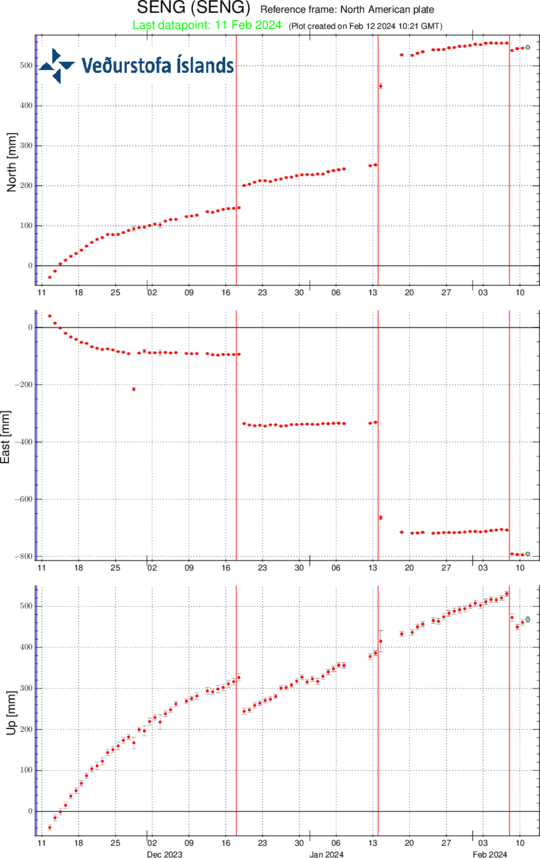
Tidsserier fra GPS-stationen Svartsengi (SENG) siden 11. november 2023 i nord-, øst- og lodret retning (hhv. top-, midt- og bundbilleder). Den nederste tidsserie viser landhævningen i millimeter og gårsdagens datapunkt (11. februar ) er vist med en grøn prik. De røde lodrette linjer er tidspunkter for de sidste tre udbrud (18. december 2023, 14. januar 2024 og 8. februar 2024).
Siden middag den 8. februar har den seismiske aktivitet i området nord for Grindavík været mindre, omkring 50 små jordskælv er blevet opdaget, som alle var omkring eller mindre end M1,0. En lille seismisk sværm har været i gang i de vestlige dele af bjerget Fagradalsfjall med omkring 100 jordskælv detekteret, for det meste M1 begivenheder eller mindre. Mindre sværme i Fagradalsfjall-området har forekommet hyppigt de seneste uger, dybden af jordskælvene er på omkring 6-8 km.
Opdateret 9. februar kl. 15:30 UTC
Der blev ikke observeret nogen udbrudsaktivitet i en droneflyvning over udbrudsstedet udført ved middagstid i dag (9. februar) af Rigspolitichefens Specialenhed. Dette tyder på, at udbruddet er ved at ende. Vulkansk tremor detekteres ikke længere på seismiske sensorer.
IMO har opdateret farevurderingen i henhold til udviklingen i den eruptive aktivitet. Der er foretaget ændringer i farevurderingen for nogle farer inden for zoner. Farer på grund af åbning af vulkanske sprækker er faldet, men farer på grund af gasforurening anses stadig for at være sandsynlige af lavastrømmens front. Farer på grund af lavastrøm er stadig på plads, da lava-lapper kan bryde ud fra lavastrømsfronten. Farer på grund af synkehuller og fejlbevægelser anses stadig for at være høje i Zone 4 (Grindavík).
(Klik på kortet for at se det større)
Farevurderingskortet er gyldigt indtil mandag den 12. februar kl. 15.00, medmindre ændringer i aktiviteten kræver en revurdering.
Opdateret 9. februar kl. 13:00 UTC
Vulkansk tremor er faldet betydeligt siden i går (8. februar). Faldet blev opdaget kort efter middag i går sammen med nedsat udbrudsaktivitet på den vulkanske sprække, og aktiviteten blev mere begrænset i separate kratere. Midlertidige stigninger i den vulkanske rystelse blev noteret i går aftes, hvilket faldt sammen med øget vulkansk aktivitet i kraterne. I løbet af natten faldt aktiviteten yderligere og mellem klokken 7 og 8 i morges var to udbrudskratere aktive. I de sidste timer er der ikke observeret lava-springvand på web-kameraer, men aktiviteten i kraterne er muligvis stadig i gang.
Satellitradarbillede taget kl. 14:56 i går viser overfladesænkning på 10 cm i Svartsengi-området, nordvest for mt. Þorbjörn, da magma strømmede derfra mod Sundhnúkur kraterrækken. Modelberegninger baseret på disse data tyder på, at omkring 10 millioner m 3 magma er strømmet fra magma-reservoiret under Svartsengi mod udbrudsstedet ved Sundhnúkur-kraterrækken.
(Klik på Insar-satellitbilledet for at gøre det større)
Seismisk aktivitet på udbrudsstedet har været mindre i løbet af de seneste 24 timer. Omkring 40 jordskælv er blevet opdaget der, rundt omkring eller mindre end M1.
Volumenvurderinger af den udbrudte lava fra udbruddets start kl. 6:02 til kl. 13:00 i går (8. februar ) er omkring 15 millioner m 3 , hvilket svarer til en gennemsnitlig ekstruderingshastighed på 600 m 3 /s i løbet af den første syv timer (data leveret af det islandske naturhistoriske institut og Landmælingar Íslands).
Selvom udbruddet er faldet betydeligt, er det stadig for tidligt at erklære, om det er kommet til en ende. IMO holder 24-timers vagt og holder nøje øje med området. En opdateret farevurdering vil blive offentliggjort senere i dag.
Opdateret 8. februar kl. 17:15 UTC
Kraften af udbruddet fortsætter med at aftage. Den eruptive aktivitet er i øjeblikket på to eller tre steder på den eruptive fissur. Den eksplosive aktivitet, der begyndte mellem klokken 13 og 14, er nu for det meste overstået, men mindre konvektive skyer rejser sig fra nogle dele af sprækken.
Synkront med udbruddets aftagende kraft aftog de deformationssignaler, der blev detekteret ved digeområdet, hvilket indikerer, at magma ikke længere stiger op under lige så meget tryk som før. Kort efter udbruddets begyndelse faldt den seismiske aktivitet betydeligt og har indtil videre været mindre. Omkring 20 små jordskælv er blevet opdaget over diget siden klokken 08.00 i morges.
Kortet viser konturerne af lavastrømmen, som den blev set på et satellitbillede taget kl. 12:31 i dag (torsdag den 8. – februar). Satellitbilledet viser, at lava flød længst omkring 4,5 km mod vest fra udbrudsstedet. Til sammenligning er lavastrømningsfeltet, som blev dannet ved udbruddet den 18. december 2023, også vist på kortet. Dagens lavastrømme delvist over lavastrømmen dannet i december 2023.
(Klik på kortet for at gøre det større)
IMO har opdateret farevurderingskortet i betragtning af processen med den eruptive aktivitet. Der er foretaget ændringer i farevurderingen for nogle farer inden for zoner. Disse ændringer har dog ikke indflydelse på den samlede farevurdering for zonerne. Det nye lavastrømsfelt er også blevet tilføjet til kortet. Farevurderingskortet er gyldigt til kl. 19.00 i morgen, fredag den 9. februar 2024, medmindre udviklingen i aktiviteten kræver en revurdering.
(Klik på kortet for at gøre det større)
Opdateret 8. februar kl. 14:25 UTC
Udbruddets styrke er aftagende. Aktiviteten er nu hovedsageligt på 3 steder på den eruptive sprække, som åbnede i morges. Dette er ikke ulig den proces, der blev observeret i udbruddet den 18. december 2023, hvor aktiviteten var begrænset til et par kratere få timer efter udbruddets begyndelse.
En iøjnefaldende, mørk fane rejser sig fra den ene del af den eruptive sprække. Dette skyldes sandsynligvis magma-interaktion med grundvand, hvilket resulterer i en let eksplosiv aktivitet, hvor hvid dampfane blandes med mørk vulkansk fan.
Det ser ud til, at tephra ikke rejser langt fra den eruptive sprække i øjeblikket. Vulkanfanen er spredt mod sydvest.
Foto taget mod nordvest. (Foto: Rigspolitikommissærens specialenhed).
Opdateret 8. februar kl. 12:20 UTC
Geodætiske data tyder på, at deformationen er aftaget betydeligt i digeområdet. Derfor er sandsynligheden for nye eruptive sprækkeåbninger faldet.
IMO har modtaget anmeldelser om tephrafald i Grindavík.
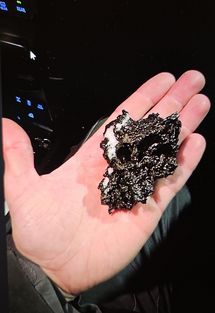 Tephra er skummende og vesikulært materiale, som dannes, når lavasprøjt afkøles hurtigt i luften under lavafontæneaktiviteten. Denne proces fandt sted, da en eruptiv sprække åbnede i morges (8. februar 2024). På grund af tephras’ vesikulæritet og lethed kan den transporteres langt inde i vulkanfanen med vind. Den falder i Grindavík nu, 3-5 km fra dannelseskilden på grund af lavafontænernes højde, nordøstlig vindretning, termisk opstrømning fra lavaen og lav lufttemperatur.
Tephra er skummende og vesikulært materiale, som dannes, når lavasprøjt afkøles hurtigt i luften under lavafontæneaktiviteten. Denne proces fandt sted, da en eruptiv sprække åbnede i morges (8. februar 2024). På grund af tephras’ vesikulæritet og lethed kan den transporteres langt inde i vulkanfanen med vind. Den falder i Grindavík nu, 3-5 km fra dannelseskilden på grund af lavafontænernes højde, nordøstlig vindretning, termisk opstrømning fra lavaen og lav lufttemperatur.
Tephra er et synonym for alle luftbårne, faste, eruptive materialer, uanset størrelse og type. Tephra-dannelse er velkendt i Island, såsom i de eksplosive udbrud i Grímsvötn 2011 og 2004, og Eyjafjallajökull 2010. I eksplosive udbrud er lavaen mere fragmenteret i luften og producerer finere kornet tephra, men tephra kan også produceres i effusive udbrud som nu er i gang på Reykjanes-halvøen. I effusive udbrud aflejres størstedelen af tephra tæt på udluftningen og er derfor ikke godt påviselig uden for lavastrømningsfeltet. I maj 2021, da lavaspringvandet var mest aktivt i udbruddet i Fagradalsfjall, faldt store stykker tephra (op til 10 cm i diameter) i omkring 1 km afstand fra udbrudskilden.
Tephra er skarp som glas og bør derfor håndteres forsigtigt. Forrudeviskere bør ikke bruges til at fjerne tephra fra køretøjer, da det vil ridse glasset. Tephra bør hellere blæses eller vaskes af med vand fra vinduer og lignende overflader.
Gasspredning
Vejrudsigten for gasspredning fra det vulkanske område er nordøstlig vind, 4-8 m/s i dag (torsdag), således at gas spredes mod sydvest. Aftagende vindhastighed i nat, hvilket kan få gaskoncentrationer til at opbygge sig på vulkanområdet. Østlig og sydøstlig vind, 5-10 m/s efter middag i morgen (fredag), hvilket medfører, at gas spredes mod vest og nordvest, mod Keflavík.
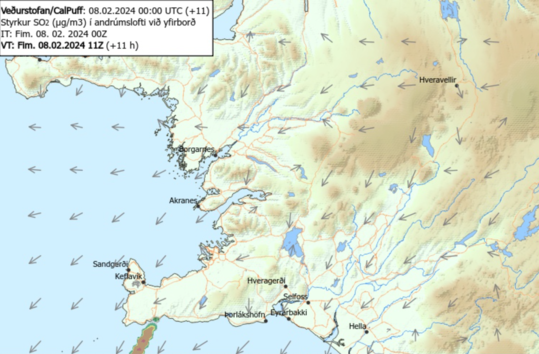
Opdateret 8. februar kl. 11:40 UTC
Det islandske Met Office har opdateret farekortet for området. Fareniveauet er steget i alle områder på grund af udbruddet.
Opdateret 8. februar kl. 7:50 UTC
Klokken 5:30 i morges startede en intens seismisk aktivitet nordøst for mt. Sýlingarfell. Omkring 30 minutter senere startede et vulkanudbrud på stedet.
Den eruptive sprække blev forlænget både mod nord og syd i løbet af de første minutter.
De første billeder fra den islandske kystvagts overvågningsflyvning tyder på, at udbruddet finder sted på et lignende sted som udbruddet den 18. december 2023. Eruptivspalten er cirka 3 km lang, fra mt. Sundhnúkur i syd og strækker sig mod den østlige del af mt. Stóra-Skógfell. Lava strømmer for det meste mod vest i øjeblikket, og strømningen ser ud til at være lidt mindre end ved starten af det 18. december-udbrud.
Lavafontænerne når omkring 50-80 m højde, og vulkanfanen rejser sig omkring 3 km over udbrudsspalten.
Billede fra den islandske kystvagts overvågningsflyvning. Stóra-Skógfell i forgrunden og lysene ved Svartsengi kraftværket til højre. (Foto: Björn Oddsson).
Opdateret 5. februar kl. 16:00 UTC
Den igangværende magma-akkumulering under Svartsengi-Þorbjörn-området fortsætter, selvom inflationen er faldet en smule de seneste dage. Lignende processer blev observeret før de tidligere digeindbrud og udbrud nord for Grindavík i januar 2024 og december 2023. Ifølge opdaterede geodætiske modeller baseret på satellit- og GNSS-data, der dækker intervallet fra 16. januar til 5. februar, genoplades mængden af magma til Svartsengi reservoir er nu anslået til omkring 9 mio. m 3 . Fra geodætisk modellering af indtrængen og udbruddet i januar 2024 anslås det, at der strømmede omkring 9 til 13 millioner kubikmeter magma fra Svartsengi magma-reservoiret og brødføde det udbrud, der begyndte nær Hagafell den 14. januar. Derfor har den estimerede mængde magma-genladning nu nået den nedre grænse for den mængde, der menes at være blevet tappet i januar. Derfor er der en øget sandsynlighed for et nyt magmatisk digeindtrængen og efterfølgende vulkanudbrud i de kommende dage til uger.
Siden i fredags er der målt knap 200 jordskælv i området nord for Grindavík, de fleste omkring eller under størrelsesordenen 1 på 3-4 km dybde. Det største jordskælv fandt sted søndag morgen den 4. februar nær Sundhnúkur og var et M2.2 i en dybde på cirka 6 km.
IMO fortsætter med at overvåge området nøje, og det nuværende farevurderingskort forbliver gyldigt indtil kl. 15.00 den 8. februar, hvis der ikke er ændringer i aktiviteten.
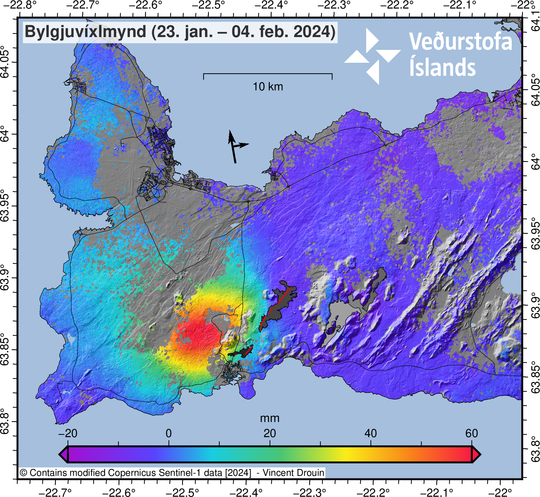
Seneste satellitradarsammenligning, der viser jordoverfladeændringer mellem 23. januar og 4. februar 2024. Rød skygge viser området med maksimal inflation og grå skygge viser område, hvor målinger ikke var mulige på grund af variationer i snedække mellem billederne.
Opdateret 1. februar 17:00 UTC
Modeller baseret på GPS-data, gennemgået i morges (1. februar) af forskere fra det islandske meteorologiske kontor og Islands Universitet, viser, at der er samlet omkring 6,5 millioner kubikmeter magma under Svartsengi-regionen. Ifølge denne vurdering vil magma snart nå samme volumen som drænet under udbruddet i januar 2024. Derfor kan tidsskalaen for det næste udbrud være inden for to uger eller muligvis dage. Det betyder, at sandsynligheden for et magma-indtrængen og et vulkanudbrud er steget.
Der er ingen absolut sikkerhed for, at varslingstiden forud for næste indbrud eller udbrud vil være den samme som 14. januar, hvilket var cirka fem timers varsel fra jordskælvsværmen begyndte, til udbruddet begyndte lige syd for Hagafell. Varslingsperioden for udbruddet mellem Stóra-Skógfell og Sundhnúkur den 18. december sidste år var omkring 90 minutter, og det udbrud fandt sted cirka midt på den (nu størknede) magma-indtrængning under Sundhnúksgígar-kraterrækken. Med gentagne laterale magma-indtrængninger er det sandsynligt, at vejen for magma-udbredelse til overfladen vil være lettere, hvilket resulterer i mindre seismicitet. Hurtige bevægelser af magma er dog altid ledsaget af øget mikroseismicitet. Vi vurderer, at minimumsvarselstiden vil være en time før et vulkanudbrud, og at den mest sandsynlige vej vil være langs sprækkerne fra magma-indtrængningen den 10. november sidste år.
Seismisk aktivitet har været den samme i den seneste uge. Næsten 200 jordskælv er blevet målt i området mellem Stóra-Skógfell og syd for Hagafell i de seneste syv dage. De fleste af disse jordskælv var mindre, under 1,0 i styrke i en dybde på 2 til 5 km. Det største jordskælv registrerede en styrke på 1,8, og det var placeret omkring en kilometer syd for Hagafell.
Det islandske meteorologiske kontor har udgivet et opdateret farevurderingskort. De vigtigste ændringer er, at zone 3 (Sýlingarfell – Hagafell) er blevet opgraderet til rød (høj risiko), og zone 2 og 6 er blevet opgraderet til rav (betydelig fare). Grindavík (zone 4) forbliver uændret med et betydeligt fareniveau.
Den overordnede vurdering for hver zone er baseret på en samlet vurdering af syv typer farer, der kan forekomme inden for de enkelte zoner. Listen på kortet viser farer inden for de zoner, der er klassificeret som “betydelige”, “høje” eller “meget høje”. Farer vurderet som “høj” eller “meget høj” er fremhævet med fed skrift.

Det skal bemærkes, at selvom den overordnede farevurdering for Grindavík er den samme som i sidste uge, vurderes lavastrømningsfaren nu som høj. Faren for synkehuller, der åbner sig over sprækker i Grindavík, vurderes stadig som meget høj.
Opdateret 25. januar 17:30 UTC
Inflationen fortsætter i Svartsengi. I løbet af de sidste par dage er landet steget med en hastighed på cirka 8 mm om dagen, hvilket er lidt over den registrerede stigningshastighed før udbruddet den 14. januar.
På dette tidspunkt er det udfordrende at fastslå præcis, hvor meget magma, der har ophobet sig under Svartsengi, siden udbruddet sluttede den 16. januar. Mest sandsynligt vil tidsrammen, der kræves for at nå den samme mængde magma som før det sidste udbrud, være i størrelsesordenen uger, ikke dage. Beregningsmodeller er ved at blive forfinet for at opnå en klarere vurdering af status for magmaakkumulering.
Lave niveauer af seismisk aktivitet fortsætter og er for det meste koncentreret omkring Hagafell. Den aktuelle seismiske aktivitet stemmer overens med den, der er observeret i området efter det forrige udbrud.
Det islandske meteorologiske kontor har udgivet et opdateret farevurderingskort. De vigtigste ændringer omfatter en reduktion af det overordnede fareniveau for Grindavík til orange (betydelig fare).
Det skal bemærkes, at selvom det overordnede fareniveau for Grindavík er reduceret med et niveau, er faren forbundet med sprækker fortsat meget høj. Den nuværende fare omtales nu som “nedsynkning i en sprække”, der beskriver den fare, der kan være til stede, hvor sprækker er skjult under ustabile overflader, der kan kollapse og udvikle synkehuller.
Farevurderingen relateret til sprækkeudvikling i Grindavík er faldet. Evalueringer er i gang for at afgøre, om der er fare for, at eksisterende sprækker udvider sig, eller at der dannes nye sprækker. GPS-data har udvist meget lidt bevægelse i Grindavík de seneste par dage, hvilket reducerer den vurderede fare sammenlignet med tidligere. Faren på grund af synkehuller, der ligger over sprækker, anses nu for at være betydelig.
(Klik på billedet for at se det større). Øget fare i området på grund af udbruddet nær Hagafell den 16. januar og landhævning nær Svartsengi. Forholdene inden for og uden for fareområderne kan ændres med lidt advarsel. Risikovurdering er udelukkende fokuseret inden for disse områder, men faren kan strække sig ud over dem. Den overordnede farevurdering for hvert område er baseret på en samlet vurdering af 7 typer af farer, der er til stede eller mulige inden for regionerne. Farven på hvert område afspejler den overordnede fare inden for disse grænser.
Opdateret 19. januar 16:30 UTC
Der registreres stadig tydelige signaler om en fortsat landhævning under Svartsengi. Det er endnu for tidligt at sige, om hastigheden af landhævningen er steget siden før udbruddet den 14. januar. De første målinger tyder på, at det er tilfældet, men som tidligere skrevet kan målinger svinge fra den ene dag til den anden og en længere tidslinje for måling er nødvendig for at kunne fortolke den langsigtede udvikling af landhævningen.
Seismisk aktivitet fortsætter med at falde i området af magmadiget, og deformationssignaler set på GPS-enheder tyder på en betydelig opbremsning af jordens bevægelse sammenlignet med tidligere dage. Disse oplysninger tyder på, at magma ikke længere strømmer ind i diget, og at udbruddet er afsluttet.
GPS-målinger viser også små deformationer i Grindavík. Der er stadig stor fare for, at jorden kollapser til sprækker i byen, og derfor er det vigtigt at kortlægge nye sprækker og ændringer af kendte estimerede.
Det islandske meteorologiske kontor har opdateret farevurderingen på grund af den vulkanske og seismiske aktivitet. Fareniveauet er blevet reduceret i alle zoner.
En samlet farevurdering for zone 1, Svartsengi, er nu nede på gul (moderat fare).
En samlet farevurdering for zone 4, Grindavík, er nu nede i rødt (høj fare). Bemærk, at farven på zoner repræsenterer den overordnede fare inden for disse zoner. En fare, der vurderes til at være større inden for en zone, er skrevet med fede bogstaver i listen over farer på kortet.
Farevurderingskortet træder i kraft kl. 15:00 i dag, fredag den 19. januar og er gyldigt til torsdag den 25. januar kl. 15:00, medmindre der er væsentlige ændringer.
Opdateret 18. januar 15:30 UTC
Som rapporteret i nyhederne i går, er der stadig klare tegn på landstigning under Svartsengi, men det er stadig for tidligt at bestemme stigningshastigheden på grund af den seneste vulkanske aktivitet i området. GNSS-målinger evalueres for at give en samlet vurdering af situationen. Det ser dog ud til, at deformationen forbliver magen til den, der blev observeret efter vulkanudbruddet den 18. december.
Omkring 200 jordskælv er blevet registreret nær magmakanalen siden i går, hvor det største måler 1,4 i styrke. Siden midnat er der sket cirka 70 små jordskælv, hvilket er færre end målt dagen før. Vejret har påvirket antallet af jordskælv, der er opdaget i de seneste dage, men antallet af jordskælv ser ud til generelt at være faldet.
Der er fortsat en betydelig risiko i Grindavík på grund af sprækker og potentialet for jordkollaps ind i dem .
Opdateret 17. januar kl. 18:00 UTC
Magmaophobning fortsætter under Svartsengi. Det er for tidligt at hævde hastigheden af landhævningen kort efter vulkanudbruddet. Eksperter vil fortsat vurdere data fra GNSS-stationer i området for at få en samlet vurdering af situationen. En af målerne, som var placeret nord for Grindavík, gik under lava, men over 20 GNSS-stationer er i området og bliver brugt.
Seismisk aktivitet har været mild over magmakanalen i de sidste 24 timer. Ifølge beregningsmodeller ligger magma lavvandet i den sydlige ende af kanalen, hvor landet ser ud til at være stærkt opbrudt, hvilket gør det lettere for magmaen at nå overfladen. Derfor er der fortsat sandsynlighed for, at nye eruptive sprækker kan åbne sig uden varsel.
Der er stadig fare i Grindavík relateret til sprækker og potentialet for jordkollaps ind i dem. Der er sket betydelige deformationer i forbindelse med graben i den østlige del af byen. Disse bevægelser var for det meste langs de sprækker, der blev dannet den 10. november og allerede var blevet kortlagt.
Gasforurening blev målt i går under arbejde på brønde forbundet til forsyningssystemet i Grindavík. Det islandske meteorologiske kontor overvåger ikke lokal gasforurening i Grindavík. Det skal undersøges nærmere, om gasforureningen er relateret til magmaen, der ligger meget lavt i området. Det skal bemærkes, at farlig gasforurening er blandt de emner, der nævnes i den nuværende farevurdering for Grindavík.
IMO har udsendt et opdateret farevurderingskort. Der er ingen ændringer i den samlede farevurdering for områderne i forhold til tidligere. Kortet træder i kraft klokken 15.00 i dag og gælder til fredag den 19. januar klokken 15.00, medmindre der sker væsentlige udviklinger.
Opdateret 16. januar kl. 18:00 UTC
Magma fortsætter med at akkumulere under Svartsengi med en hastighed svarende til den, der blev observeret før de sidste to udbrud. Dette var konsensus opnået under et høringsmøde mellem forskere her til morgen. Under udbruddet sidste søndag, ligesom udbruddet den 18. december, strømmede magma østpå fra akkumuleringsstedet under Svartsengi, hvilket skabte en magmaledning, der strækker sig fra Stóra-Skógfell sydpå under Grindavík. Beregningsmodeller understøtter denne observation og indikerer, at magmaens oprindelse var lidt længere mod vest sammenlignet med det tidligere udbrud, hvilket førte til variationer i de seneste GPS-målinger sammenlignet med dem, der blev registreret den 18. december.
Da der dannes en magmakanal tæt på overfladen, forspændes jordskorpen, hvilket får landet over den centrale del af kanalen til at aftage og danne en graben. Derudover er jorden forhøjet på hver side af den. Beregningsmodeller, der blev gennemgået på høringsmødet, viser, at GNSS-stationen i Svartsengi er placeret i kanten af kanalen, hvor jorden hæver sig i takt med, at ledningen dannes. Nu, to dage efter kanalens dannelse, forventes Svartsengi GNSS-stationen at vise nedsynkning, hvis magmaakkumuleringen er ophørt. Dette er dog ikke observeret, hvilket indikerer, at magmaakkumulering fortsætter som før.
Magmakanalen, der blev genereret i udbruddet, der begyndte i søndags, ligger lidt længere mod øst end kanalen, der strakte sig under Grindavík den 10. november. Data indsamlet og behandlet af Islands Naturhistoriske Institut og National Land Survey of Iceland afslører, at en ny graben har dannet øst for den, der dukkede op den 10. november. Den nydannede graben måler cirka 800-1000 meter i bredden, som vist på kortet nedenfor. Den største nedsynkning i den er cirka 30 cm, men det er værd at bemærke, at regionen stadig oplever nedsynkninger, og dalen udvides gradvist. Til sammenligning havde graben, der udviklede sig i Grindavík den 10. november, en bredde på omkring 2 km, hvor den mest markante indsynkning målte omkring 1,3 meter.
Inde i denne nyligt dannede graben er tidligere kortlagte sprækker, der var synlige på overfladen, udvidet, og yderligere sprækker er opstået. Følgelig er risikoen forbundet med disse sprækker og muligheden for jordkollaps i dem steget i den østlige del af Grindavík sammenlignet med tidligere.

Kort, der viser placeringen og bredden af graben dannet den 10. november (“Mörk sigdals 10-11. nóvember”) og den nyeste graben, der for nylig blev dannet mod øst (“Mörk sigdals 14-15. janúar”).
Opdateret 16. januar kl. 11:45 UTC
Der er i øjeblikket ingen synlig aktivitet i de eruptive sprækker, med den seneste lava observeret udgået fra den nordlige sprække kort efter kl. 1 i nat. Seismisk aktivitet fortsætter med at falde, hvilket betyder, at området er ved at stabilisere sig. Omkring 200 små jordskælv blev registreret nær magmakanalen siden midnat, hvilket indikerer, at magma stadig migrerer. Den mest seismiske aktivitet er placeret nær Hagafell, tæt på den første eruptive sprække, der åbnede søndag morgen. På dette tidspunkt er det for tidligt at erklære, at udbruddet er forbi.
GPS-sensorer fortsætter med at registrere jorddeformation i og omkring Grindavík, hvilket illustrerer, at magmakanalen under Grindavík stadig forårsager udvidelse i området. Termiske billeder fra en drone i aftes viser, at sprækker, der tidligere er kortlagt sydvest for Grindavík, er blevet betydeligt større. Der er fortsat betydelige farer i området.
Opdateret 15. januar kl. 16:40 UTC
Baseret på webcam-optagelser er det tydeligt, at lavastrømmen er faldet fra de eruptive sprækker, der åbnede i går. Strømmen fra den sydlige eruptivspalte, som opstod omkring middagstid i går nær byens grænse, ser ud til at være ophørt. Størstedelen af den resterende lavastrøm er nu rettet mod sydvest langs de beskyttende barrierer, og dens bane ser ud til at have stabiliseret sig.
Det er svært at vurdere, hvor længe dette udbrud vil vare. Seismisk aktivitet er faldet, og GPS-målinger indikerer, at deformationshastigheden i området er reduceret. Deformation er dog stadig påvist nær den sydligste del af magmakanalen under Grindavík.
Målinger tyder på, at der har været en forskydning på op til 1,4 meter det seneste døgn, fordelt på talrige sprækker inden for byens grænser. Friske sprækker har udviklet sig, og eksisterende er udvidet. Det er muligt, at yderligere sprækker kan dukke op på overfladen i løbet af de næste par dage.
Som tidligere nævnt er udbrudsstederne ekstremt farlige, og muligheden for, at nye sprækker opstår uden varsel, kan ikke afvises. Dette blev demonstreret af den eruptive sprække, der dukkede op nær grænsen til Grindavík i går, som ikke gav nogen genkendelige advarselsskilte på overvågningsudstyret.
I dag blæser der en mild vind fra nordøst ved udbrudsstederne, men den tager til senere på dagen. Derfor driver gasforurening mod sydvest mod havet. I morgen vil området opleve vind fra nord, der når 10-18 m/s, hvilket får gassen til at drive sydpå. Se vejrtjenestens vejrudsigt for detaljer om gasspredning.
Det islandske meteorologiske kontor fortsætter med at overvåge området og er i direkte kontakt med civilbeskyttelses- og indsatshold i regionen om begivenhedens forløb.
Forskere mødtes i morges til et konsultationsmøde arrangeret af det islandske meteorologiske kontor. De gennemgik de seneste data relateret til udbruddet.Top of Form
I de kommende dage vil der være løbende målinger og indsamling af yderligere data, efterfulgt af analyser. Disse data bliver blandt andet brugt til at konstruere modeller, der forbedrer forståelsen af de præ-eruptive indikatorer, der førte op til denne begivenhed, og til at evaluere den mest sandsynlige progression af udbruddet. Der foretages også sammenligninger mellem udbruddet den 18. december og udbruddet, der begyndte i går for at øge forståelsen af ændringer i området og for at evaluere de mest sandsynlige scenarier fremover.
Det islandske meteorologiske kontor har udgivet et opdateret farevurderingskort baseret på de seneste data. Det forbliver uændret i forhold til sidste opdatering. Kortet er gyldigt indtil kl. 19.00 onsdag den 17. januar, medmindre der opstår nyt.
Kort, der viser lavaens udbredelse baseret på målinger udført af det islandske naturhistoriske institut og Islands Universitets institut for geovidenskab. Der blev gennemført undersøgelser to gange i går. Den mørkelilla form viser udstrækningen af lavaen kl. 13.50 den 14. januar, mens den lyse lilla form viser udstrækningen kl. 16.15, næsten 2,5 timer senere. De eruptive sprækker er markeret med røde linjer, mens barriererne konstrueret for at forhindre lava i at nå Grindavík er repræsenteret af orange stiplede linjer
Kort, der viser tykkelsen af lavastrømmen baseret på målinger kl. 13:50 i går.
Opdateret 14. januar kl. 15:30 UTC
Udbruddet nær Hagafell-Grindavík har bevaret samme styrke den seneste time eller deromkring.
Seismiske målinger viser, at ved begyndelsen af urolighederne i morges (~2:30 om morgenen), flyttede den magmafyldte digeindtrængning sig først fra den SE-kant af Stóra-Skógfell og fortsatte derefter mod sydvest til den sydlige ende af Grindavík. Klokken 05.30 havde seismiciteten nået den nordlige ende af Grindavík, og både seismicitet og deformationsmålinger indikerer, at diget siden har forplantet sig under Grindavík by. En ny eruptiv sprække åbnede kl. 12:10 i eftermiddags, lige nord for byen. Lavastrømme ekstruderet fra denne sprække er nu kommet ind i byen.
På grund af digets udbredelse blev eksisterende forkastninger og sprækker reaktiveret, og der er sandsynligvis dannet nye sprækker i Grindavík.
Gas distribution
Det islandske meteorologiske kontors vejrudsigt for gasfordeling fra udbruddet ved Hagafell indikerer, at retningen er nord og nordøst, med en hastighed på 3-8 m/s, og vejret er tørt og lyst i dag. Det bliver til tider overskyet med mindre snefald sent i aften og i morgen tidlig. Det vil klare op om eftermiddagen i morgen. Forureningen fra udbruddet breder sig mod syd og sydvest.
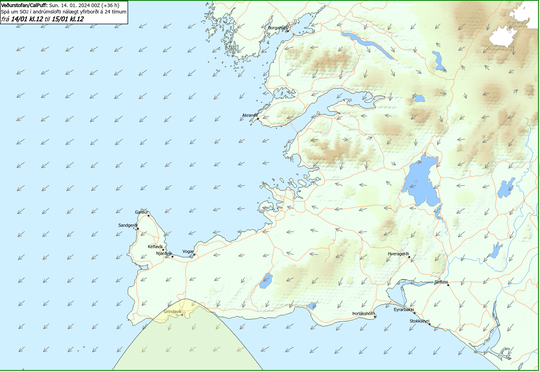
Nyt Hazard Map udgivet
Det islandske meteorologiske kontor har opdateret farevurderingskortet i lyset af fortolkningen af de seneste data.
Risikoen er steget på alle områder. Farevurderingskortet er gyldigt indtil kl. 19.00, mandag den 15. januar, medmindre andet er angivet.
Opdateret 14. januar kl. 8:20
Et udbrud startede klokken 7:57 UTC
Sprækkeåbningen er sydøst for Hagafell-bjerget.
Den sydligste del af sprækken er omkring 900 m fra byen Grindavík.
Åbningen er syd for lavastrømsafbøjningsbarrierer, der bygges nord for Grindavík. Lava strømmer nu mod byen.
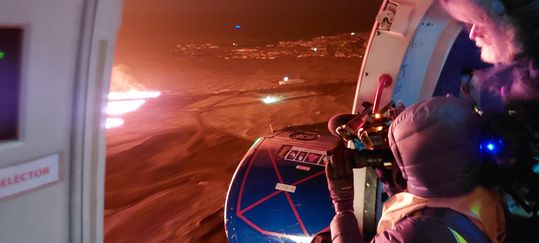 Et billede taget ombord på kystvagtens fly. Sprækkeåbning kan ses med lysene i Grindavík i det fjerne. Et kort, der viser sprækkeåbningen markeret med en rød linje.
Et billede taget ombord på kystvagtens fly. Sprækkeåbning kan ses med lysene i Grindavík i det fjerne. Et kort, der viser sprækkeåbningen markeret med en rød linje.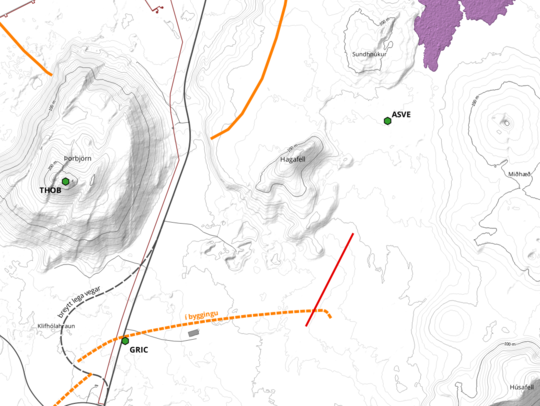
Opdateret 14. januar kl. 06:15 UTC
Omkring 03:00 UTC i dag begyndte en intens serie af jordskælv ved Sundhnúksgígar-kraterrækken.
På tidspunktet for offentliggørelsen er der målt over 200 jordskælv i området, og seismiciteten har bevæget sig mod byen Grindavík.
Indtil videre er det største registrerede jordskælv på 3,5 i styrke, og det blev målt klokken 04:07 UTC ved Hagafell.
Både realtids GPS-målinger og borehulstrykaflæsninger (fra HS Orka) viser store ændringer siden begyndelsen af dagens jordskælvsaktivitet. Disse observationer, ud over den igangværende seismicitet, bekræfter, at magma bevæger sig inden for regionen.
Vores vurdering er, at muligheden for et udbrud er stor, og at det kan ske umiddelbart.
Et kort, der viser den seneste jordskælvsaktivitet.
Opdateret 12. januar kl. 17:45 UTC
Det islandske meteorologiske kontor har opdateret farevurderingskortet for Grindavík – Svartsengi-regionen på grund af de igangværende uroligheder på Reykjanes-halvøen. Kortet viser som tidligere en vurdering af eksisterende farer, der kan opstå med ringe advarsel inden for de angivne områder. Bemærk, at vurderingen kun gælder for farer inden for de definerede områder, selvom farer er mulige uden for de vurderede regioners grænser.
Med hensyn til farvekodning er den samlede vurdering for de seks zoner uændret i forhold til det tidligere kort. Der er dog en ændring i farevurderingen forbundet med sprækker i Grindavík (zone 4). Farerne forbundet med pludselig åbning af kortlagte og ukendte sprækker i Grindavík vurderes nu at være højere. Det skal bemærkes, at farerne forbundet med sprækker er begrænset til kendte områder inden for kommunegrænsen.
Med mindre andet er angivet, er kortet gyldigt til tirsdag den 16. januar 2024.
Opdateret 9. januar kl. 13:00 UTC
Seismisk aktivitet fortsætter med at udvise et mønster, der ligner det de seneste dage. Jordskælvets aktivitet er fortsat relativt lav, primært centreret mellem Hagafell og Stóra Skógfell, hvor centrum af indtrængen er beliggende. Derudover er der igangværende seismisk aktivitet i Fagradalsfjall, der har været ved siden 18. december.
Landhævningen måles stadig i Svartsengi-området, der har vist en relativt stabil tendens siden udbruddet den 18. december . Det medfølgende billede, markeret med røde prikker, der repræsenterer data fra GPS-stationen SENG i Svartsengi, illustrerer denne bane. Den seneste stigningshastighed er ca. 5 mm pr. dag, hvilket resulterer i en aktuel højde, der er ca. 5 cm højere end før digets indbrud på 10. november og 18. december sidste år.
Beregninger fra modeller baseret på deformationsmålinger (GPS og satellitbilleder) indikerer, at mængden af magma akkumuleret i reservoiret under Svartsengi har nået et niveau, der kan sammenlignes med det volumen, der førte til dannelsen af magmakanalen og det efterfølgende udbrud den 18. december sidste år. år. Det tyder på, at der er en øget risiko for et udbrud i de kommende dage.
Det islandske meteorologiske kontor udsendte et opdateret farekort den 5. januar, og det vil blive revurderet den 12. januar.
Relative målinger fra GPS-stationen SENG i Svartsengi fra begyndelsen af oktober 2023 til i dag, viser nord-, øst- og lodrette komponenter (top, midt, bund). Den nederste kurve viser landhævningen i millimeter, med dagens måling angivet med en grøn prik.
Opdateret 5. januar kl. 17:40 UTC
Et nyt farekort er udstedt af IMO. Kortet afspejler en farebaseret vurdering af Grindavík – Svartsengi-regionen, foretaget den 5. januar 2024. Farevurderingen er baseret på de seneste overvågningsdata, herunder seismisk aktivitet og jorddeformation, samt geodætiske modelleringsresultater. Vurderingen tager også højde for sandsynligheden for vulkanske farer i hver af de seks zoner, som vist på kortet.
I dagens vurdering påvirker hovedændringen Svartsengi-regionen (zone 1), som nu anses for at være på et moderat fareniveau, hvilket afspejler et fald i forhold til den tidligere version af farekortet. Begrundelsen for denne ændring er, at farevurderingen på grund af dannelsen af større overfladebrud er faldet, da der ikke er dannet nye større brud på det seneste. Derudover gør de seneste geofysiske observationer sammen med vores videnskabelige konsensus Sundhnúksgígar til det bedste sted for et udbrud.
I mellemtiden fortsætter IMO med at overvåge området, og eventuelle ændringer vil blive kommunikeret direkte til civilbeskyttelsen via de sædvanlige kommunikationskanaler.
Opdateret 5. januar kl. 14:30 UTC
Landhævningshastigheden nær Svartsengi fortsætter med at falde. Eksperter samlet på Meteorologisk Kontor her til morgen bekræftede dette gennem en analyse af GPS-data. Som tidligere rapporteret, signalerer dette en stigning i magmatrykket, hvilket øger sandsynligheden for et nyt digeindtrængen og potentielt udbrud. Det kan dog ikke udelukkes, at dette alternativt kan tyde på et fald i magmatilstrømningen.
Cirka 490 jordskælv har fundet sted nær magmakanalen siden tirsdag den 2. januar. Blandt disse havde 14 en styrke på over 1,0, hvoraf det største målte 1,8 nord for Hagafell. Onsdag den 3. januar indtraf et jordskælv med en styrke på 4,3 nær Trölladyngja, kort efterfulgt af et jordskælv med en styrke på 3,5 og adskillige efterskælv; omkring 900 jordskælv er blevet målt i området.
Den seismiske aktivitet nær Trölladyngja den 3. januar fandt sted langs en anerkendt brudlinje, hvor større jordskælv tidligere er sket flere gange. Der er intet, der tyder på, at disse jordskælv er direkte forbundet med magmabevægelser. Ikke desto mindre er de bemærkelsesværdige ændringer i landskabet i forbindelse med vulkansk aktivitet i Fagradalsfjall, landhævningen nær Svartsengi, magmakanalen nær Sundhnúk den 10. november og udbruddet den 18. december blevet målt på tværs af det vestlige Reykjanes og påvirker seismisk aktivitet i hele regionen .
Ifølge deres vurdering konkluderer forskerne, at hvis magma når overfladen, vil det mest sandsynlige sted for et efterfølgende udbrud igen være Sundhnúksgígaröðinni, beliggende mellem Stóra-Skógfell og Hagafell. Det er dog vigtigt at huske, at digeindtrængninger ikke altid kulminerer i et udbrud, hvilket aktiviteten ved Fagradalsfjall og også under Krafla-brandene vidner om.
Opdateret 3. januar kl. 12:30 UTC
Klokken 10:50 opstod et jordskælv med en styrke på 4,5 nær Trölladyngja, kort efterfulgt af et andet jordskælv, der målte 3,9 kl. 10:54, og en række efterskælv. Jordskælvene fandt sted i en dybde på cirka 5 km og blev sandsynligvis udløst som reaktion på stress frigivet fra jordbevægelser andre steder på Reykjanes-halvøen. Disse jordskælv blev almindeligt mærket i den sydvestlige region af Island.
Placeringen af jordskælvene er omkring 20 km NNE for Svartsengi, hvor landstigning på grund af magmaakkumulering er i gang.
Det medfølgende billede viser placeringen af jordskælvet, der fandt sted kl. 10:50 og dets nedslagsområde.
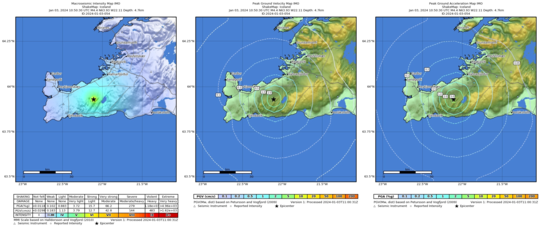
Opdateret 2. januar kl. 14:00 UTC
Hastigheden af jordforskydning ved Svartsengi er faldende. Eksperter samlet på Meteorologisk Kontor her til morgen bekræftede dette gennem en analyse af GPS-data.
Opbremsningen af inflationen er en indikation af, at magmatrykket stiger, hvilket øger chancerne for nye digeindtrængen og også vulkanudbrud. Dette er en lignende ændring i jordforskydning, som blev observeret sidst på dagen den 15. december, som kulminerede med et udbrud tre dage senere. Det er dog svært at sige, om dette mønster vil gentage sig.
De første tegn på et forestående vulkanudbrud er en pludselig stigning i seismisk aktivitet, og sådanne tegn blev observeret kort før udbruddet begyndte den 18. december.
I de seneste dage har den seismiske aktivitet i området været relativt konstant, med omkring 200 jordskælv registreret om dagen. De fleste af jordskælvene måler under størrelsesordenen 1,0, men omkring 30 jordskælv med størrelsesordenen over 1,0 er blevet registreret siden den 29. december, hvor det største er en styrke på 2,1 beliggende i den nordlige del af Grindavík.
Fortsat videnskabelig vurdering indikerer, at hvis der skulle opstå et udbrud, er Sundhnúkur-kraterrækken mellem Stóra-Skógafell og Hagafell det mest sandsynlige sted for et udbrud. Det er dog vigtigt at bemærke, at magmavandring ikke altid resulterer i et udbrud, som demonstreret af aktiviteten ved Fagradalsfjall og i Krafla-brandene.
Farevurderingskortet udstedt af Meteorologisk Kontor den 29. december forbliver uændret og er gyldigt indtil 5. januar.
Seismisk aktivitet bliver fortsat målt vest for Fagradalsfjall, hvor omkring 100 små jordskælv er blevet registreret siden 29. december. Yderligere analyse af overvågningsdataene vil snart blive udført for at få et klarere billede af situationen ved Fagradalsfjall.
Opdateret 29. december kl. 15:15 UTC
Jorden fortsætter med at puste op ved Svartsengi. På GPS-stationen Svartsengi (SENG) har landet nu nået en tilsvarende højde som målt lige før udbruddet den 18. december. Hævningshastigheden siden 18. december har været konstant, hvilket er forskellig fra situationen før det sidste udbrud, hvor stigningen aftog i dagene før udbruddet. Det er dog vanskeligt at påstå, at stigningen vil bremse før det næste udbrud, selvom dette har været tilfældet i udbrud på Reykjanes-halvøen i de senere år, og det blev også bemærket under Krafla-brandene. Der er fortsat usikkerhed om, hvor meget magmatryk, der skal opbygges, før magma begynder at bevæge sig mod overfladen.
Det nuværende løft er ikke ledsaget af så meget seismisk aktivitet som tidligere. Årsagen til dette er, at der blev udløst betydelig stress i området under begivenhederne den 10. november og den 18. december. Derfor skal der akkumuleres betydeligt mere magma, før den seismiske aktivitet stiger fra dets nuværende niveau. Før det sidste udbrud var der flere jordskælv over 3 og et over 4. Lignende seismisk aktivitet kan forventes i forbindelse med næste magma-indtrængning.
Efterhånden som magmaakkumulering fortsætter under Svartsengi, øges sandsynligheden for endnu en magmaindtrængning og et udbrud for hver dag, der går. Det er mest sandsynligt, at det næste udbrud vil ske i Sundhnúkur, mellem Stóra-Skógfell og Hagafell. Det er vigtigt at bemærke, at indtrængning af magma ikke altid fører til et udbrud, som det fremgår af aktiviteten ved Fagradalsfjall og i Krafla-brandene.
Det islandske meteorologiske kontor har udgivet et opdateret farekort, baseret på fælles fortolkning af data på et statusmøde afholdt i dag, 29. december. Den samlede vurdering af fareniveauer inden for områderne er uændret i forhold til sidste opdatering. Der er dog foretaget ændringer i listen over potentielle farer inden for område 4, Grindavík, hvor risici på grund af mulig lavastrøm og gasforurening er tilføjet. Ændringerne skyldes øgede chancer for et udbrud nord for Grindavík. Dette farekort vil blive gennemgået den 5. januar 2024.
I mellemtiden fortsætter IMO med at overvåge området, og eventuelle ændringer vil blive kommunikeret direkte til civilbeskyttelsen via de sædvanlige kommunikationskanaler.
Opdateret 27. december kl. 14:20 UTC
Siden 22. december er der registreret omkring 730 jordskælv i nærheden af magma-indtrængningen, hvoraf 40 havde en størrelsesorden over M1. Det største jordskælv i denne periode havde en styrke på 2,1 den 26. december nord for Hagafell. De fleste af jordskælvene sker i en dybde på 4 km. Derudover er der mellem den 22. december og i dag blevet lokaliseret omkring 140 jordskælv på den vestlige side af Fagradalsfjall. Fem af disse jordskælv var over M1 i størrelse, og det samlede dybdeområde var 4 til 7 km.
Jorddeformationen fortsætter i Svartsengi-regionen, og deformationshastigheden svarer nu til før udbruddet den 18. december 2023. Det betyder, at magma fortsætter med at akkumulere under Svartsengi. Derfor er det mere og mere sandsynligt, at endnu en magma-indtrængning vil forekomme, hvilket kan føre til et andet vulkanudbrud. Geodætiske modelleringsresultater indikerer, at over 10 millioner m 3 magma blev hentet fra under Svartsengi for at fodre den indtrængning, der dannede sig den 18. december, som førte til udbruddet. Baseret på den igangværende hævningshastighed vil det tage en til to uger for den samme mængde magma at samle sig igen under Svartsengi. Der er stadig betydelig usikkerhed om, hvornår det opbyggede magmatryk vil være tilstrækkeligt til at udløse den næste magmaindtrængning.
Det skal bemærkes, at den oprindelige magma-indtrængning, som blev dannet den 10. november, strakte sig 15 km fra Kálfafellsheiði i nord til sydvest for Grindavík, lige ud for kysten. Det betyder, at magma forplantede sig i dybden under hele området, inklusive byen Grindavík. Det mest sandsynlige kildeområde for det næste udbrud er dog mellem Stóra-Skógfell og Hagafell. Baseret på indsigt fra udbruddet i december 2023, stiger sandsynligheden for den næste begivenhed dag for dag.
Farevurderingskortet udstedt den 22. december 2023 forbliver gyldigt. Forudsat en uændret situation udsendes et nyt kort den 29. december.
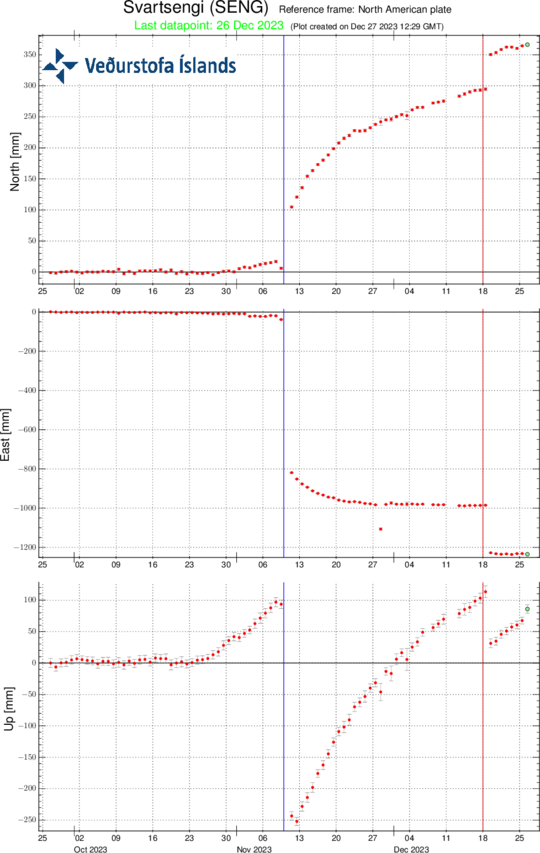
Tidsserier af kontinuerlige GPS-løsninger fra station Svartsengi (SENG). Grafen viser jordforskydninger i tre komponenter over de seneste 90 dage. Fra bund til top er de: op, øst og nord, alle målt i millimeter. Den blå, lodrette linje viser tidspunktet for magmaindtrængningen den 10. november, og den røde linje vulkanudbruddet den 18. december 2023. Hvert datapunkt repræsenterer en 24-timers løsning, og den lodrette komponent viser tydeligt den igangværende jordhævning ved Svartsengi.
Opdateret 22. december kl. 17:00 UTC
Som annonceret i går er sprækkeudbruddet ved Sundhnúksgígar afsluttet. Dette indikerer et midlertidigt ophør af eruptiv aktivitet. I de sidste 24 timer blev der registreret næsten 90 jordskælv i Grindavík-, Sundhnúksgígar- og Svartsengi-regionerne. Det største jordskælv var M1,6 vest for Hagafell, lige efter kl. 16:00 UTC i går (21. december). Samlet set er seismicitetsniveauerne lave, men varierende på daglig basis.
Ifølge GPS og satellitbaserede målinger var jordløftning i Svartsengi-regionen tydelig umiddelbart efter udbruddet begyndte om aftenen den 18. december. Indledende målinger viser, at stigningshastigheden er større end før udbruddet fandt sted. Dette betyder, at magma-akkumulering fortsætter uformindsket under Svartsengi. Denne udvikling vil sandsynligvis føre til endnu et digeindbrud og i sidste ende et vulkanudbrud. I tilfælde af et udbrud er den mest sandsynlige kilderegion mellem Stóra-Skógfell og Hagafell.
Kontinuerlige GPS-målinger viser, at hastigheden af den daglige jordhævning ved Svartsengi mellem 10. november, hvor den magmatiske indtrængning dannedes, og 18. december gradvist aftog. Denne proces vil sandsynligvis gentage sig selv, hvilket betyder, at det næste digeindbrud kan begynde med lidt advarsel, når hævningshastigheden falder igen. Derfor stiger sandsynligheden for et udbrud dag for dag.
Efter bekræftelse af slutningen af udbruddet den 18. december har det islandske meteorologiske kontor udsendt en ny farevurdering. Farekortet træder i kraft kl. 16.00 UTC i dag (22. december), og det forbliver gyldigt indtil kl. 18.00 UTC den 29. december. De vigtigste ændringer påvirker zone 2 og 3, hvor fareniveauerne er reduceret fra meget høje (lilla) til høje (røde). Farevurderingen for alle andre zoner er uændret. Navnlig er vurderingen for Grindavík uændret i forhold til det tidligere kort, og fareniveauet er fortsat betydeligt . Vi lægger vægt på, at forholdene kan ændre sig hurtigt, og at vejrforholdene i væsentlig grad kan påvirke følsomheden af vores overvågningsnetværk. Under sådanne forhold kan varslingstiden forkortes betydeligt.
Vejrudsigten for Grindavík den 23. december lyder på nordøst vind 10-15 m/s, periodisk snefald og muligvis drivsne. Temperaturerne bliver lave, mellem 3 og 5°C. Den 24. december vinder fra nord 13-18 m/s med enkelte snebyger, men 10-15 m/s om eftermiddagen med aftagende snebyger. Der kan forventes periodisk drivende sne. Temperaturerne vil ligge fra 0 til 2°C
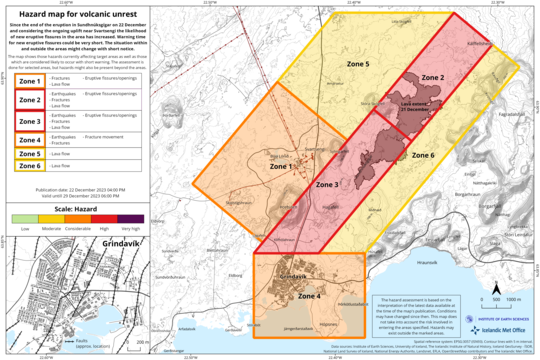
Det seneste farevurderingskort, offentliggjort den 22. december kl. 16:00 UTC. Det er vigtigt at bemærke, at nye farer kan opstå med lidt advarsel inden for de specificerede områder. Derudover gælder vurderingen kun for de specificerede områder, hvorimod farer kan strække sig eller forekomme ud over de identificerede zoner.
Opdateret 21. december kl. 12:55 UTC
Forskere, der fløj over udbrudsstedet i morges, bekræfter, at ingen udbrudsaktivitet er synlig, og at lavastrømmen fra kraterne ser ud til at være ophørt. Glødende er stadig synligt i lavafeltet, muligvis inden for lukkede kanaler. Dette blev også bekræftet af en Elfu-medarbejder i Sýlingarfell. Aktiviteten ser ud til at være aftaget sent i nat eller meget tidligt i morges. Det er dog stadig muligt, at lava flyder i lukkede kanaler, så det er for tidligt at erklære udbruddet for afsluttet.
Jordskælvsaktiviteten er fortsat med at falde, og i løbet af de sidste 24 timer er der målt cirka 70 mindre jordskælv over magmarørene. Det største jordskælv i går skete klokken 14:27 og målte 1,4 i størrelsesordenen, mens det største siden midnat i nat var på 1,9. Deformationsmålinger ved Svartsengi viser lidt bevægelse, men målinger over de næste par dage vil yderligere afklare situationen dér.
Gasspredning, hovedsageligt på grund af afgasningen af lavafeltet, vil i dag være sydøst og ud til havet. I morgen, med en langsommere nordøstlig vind, vil gassen rejse mod sydvest.
På nuværende tidspunkt er det svært at forudsige fortsættelsen af udbruddet, men forskere ved Meteorologisk Kontor vurderer konstant de seneste data og fortsætter med at overvåge området tæt.
Opdateret 20. december kl. 18:50 UTC
Udbruddet, der begyndte i Sundhnúksgígar-kraterrækken den 18. december, startede med betydelig kraft, og varslingsperioden var kort. Der gik omkring 90 minutter fra de første tegn på seismicitet, til udbruddet begyndte. Udbruddet skete på magma-indtrængen, der dannedes den 10. november. Magmaen stammer højst sandsynligt fra under Svartsengi, hvor landet har rejst sig gentagne gange siden 2020.
I det seneste døgn har den højeste aktivitet i udbruddet holdt sig omkring midten af sprækken, der åbnede den 18. december. Seismisk aktivitet har været relativt stabil, og der har været små ændringer i deformation siden udbruddet begyndte. I betragtning af dette vurderer det islandske meteorologiske kontor (IMO), at sandsynligheden for, at et nyt udbrud dannes uden varsel i nærheden af Grindavík, er faldet. Derfor har IMO udsendt et nyt farevurderingskort, der træder i kraft i morgen, torsdag den 21. december kl. 7:00 UTC. Farevurderingskortet er gyldigt indtil 28. december. Det skal bemærkes, at selvom sandsynligheden for dannelse af ventilationsåbninger inden for område 4 er faldet, anses fareniveauet i dette område alligevel for at være betydeligt. Selvom aktiviteten er faldet siden udbruddet begyndte, er intensiteten af udbruddet stadig betydelig og kan sammenlignes med udbrud ved Fagradalsfjall. Det har også vist sig, at magmaen kan nå overfladen hurtigt, hvilket giver lidt tid til at udsende advarsler.
På grund af det vulkanudbrud, der begyndte ved Sundhnúksgígar-kraterrækken den 18. december, er der en øget sandsynlighed for yderligere udluftningsåbninger på den oprindelige sprække. Baseret på det pludselige udbrud ved Sundhnúksgígar kan varslingstiden for nye sprækkeåbninger være meget kort.
Opdateret 20. december kl. 17:00 UTC
Kraften fra udbruddet fortsætter med at aftage. Nye billeder af området viser, at i øjeblikket er to kratere i udbrud. Det mest aktive i dag er krateret direkte øst for Sýlingarfell, som er det sydligste af de kratere, der var aktive i går.
Lava fortsætter for det meste med at strømme mod øst fra de vulkanske åbninger, men en lava-tunge er også løbet vest for, nord for Stóra-Skógfell. Den sydligste kant af lavaen ser ikke ud til at være på vej frem. Satellitbilleder taget i aftes viser, at lavafeltet er omkring 3,7 kvadratkilometer stort.
Vinden vil vende nordvest i nat og i morgen, og forureningen vil blive transporteret mod sydøst og ud i havet. Det islandske meteorologiske kontor udsender regelmæssigt gasforureningsprognoser.
Der er sket et markant fald i jordskælvsaktiviteten, og i løbet af de sidste 24 timer er der målt omkring 80 små rystelser over magmakanalerne. Det største jordskælv var 2,2 i størrelsesordenen klokken 10:55 i går morges, og det største siden midnat er 1,2 i størrelsesordenen.
Opdateret 19. december kl. 18:30 UTC
Udbruddet fortsætter med at svækkes. Nye luftbilleder af området viser, at der nu er tre åbninger, der bryder ud sydøst for Stóra-Skógfell, ned fra de tidligere fem. Lavaen er for det meste strømmet mod øst fra udbrudsstedet, men der er også en lava-tunge, der flyder mod vest fra regionen nord for Stóra-Skógfell.
Siden udbruddet begyndte, er omkring 320 jordskælv blevet målt over magmakanalerne. Det største jordskælv, med en styrke på 4,1, fandt sted klokken 23:25 mandag. Efter midnat faldt den seismiske aktivitet markant, og siden klokken 12.00 i dag er der kun registreret 10 jordskælv i regionen. Efter udbruddet ved Sundhnúksgíga sænkede landet i Svartsengi sig mere end 5 cm. Tidligere havde landet hævet sig der med omkring 35 cm siden dannelsen af magmakanalen den 10. november. Det er for tidligt at afgøre, om magma vil fortsætte med at samle sig under Svartsengi, og om landet vil begynde at rejse sig igen.
Mens udbruddet fortsætter ved Sundhnúksgíga, er der en øget sandsynlighed for, at flere åbninger kan åbne langs den oprindelige sprække såvel som længere mod nord eller syd. Når man ser tilbage på optakten til udbruddet, afslører det, at der gik cirka 90 minutter mellem de første indikatorer og starten af udbruddet. Derfor kan varslingstiden for nye udluftningsåbninger ved Sundhnúk være meget kort.
Opdateret 19. december kl. 14:30 UTC
Størrelsen af vulkanudbruddet ved Sundhnúksgígar fortsætter med at falde. Lavastrømmen anslås at være omkring en fjerdedel af, hvad den var ved begyndelsen af udbruddet den 18. december, og en tredjedel af den oprindelige sprække er aktiv. Lavafontænerne er også lavere end ved begyndelsen af udbruddet og når omkring 30 meter på deres højeste. Disse tal er baseret på visuelle skøn fra en rekognosceringsflyvning tidligt den 19. december.
Udbruddets udvikling ligner nylige udbrud ved Fagradalsfjall, hvor sprækkerne begynder at trække sig sammen og danne individuelle udbrudsåbninger. I øjeblikket er der omkring fem udbrudsåbninger spredt langs den oprindelige sprække.
Ifølge oplysninger fra videnskabsmænd, der tog på en anden helikopterflyvning med den islandske kystvagt omkring kl. 04:00 UTC i dag, har den samlede længde af sprækkeudbruddet ikke ændret sig meget fra begyndelsen. Der var ringe aktivitet i den sydlige ende af sprækken nær Hagafell, og størstedelen af lavastrømmen er på vej mod øst mod Fagradalsfjall. To vandløb når vest, begge nord for Stóra-Skógfell.
På tidspunktet for offentliggørelsen driver vulkanfanen fra vest og nordvest. Gasforurening kan være mærkbar i Vestmannaeyjar i dag, men ikke andre steder i befolkede områder. Ifølge vejrudsigten kan der blive opdaget gasforurening i hovedstadsområdet sent i aften eller i morgen tidlig.
Et nyt farevurderingskort er under udarbejdelse, og det vil blive offentliggjort senere i dag.
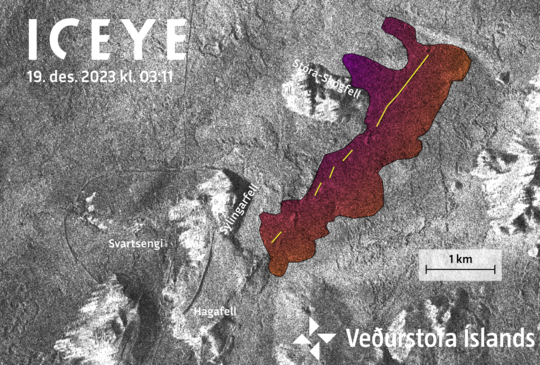
Amplitudebillede fra en ICEYE-satellit optaget kl. 03:11 i morges (19. december 2023). Foreløbig analyse af dette billede viser den nye eruptive sprække (gul linje) og lavastrøm (farvet område). Læg mærke til, at dæmningerne bygget omkring Svartsengi er tydeligt synlige.
Opdateret 19. december kl. 3:00
Intensiteten af vulkanudbruddet, der startede for omkring fire timer siden, er aftagende. Dette fremgår af seismiske og GPS-målinger. At aktiviteten allerede er faldende er ikke en indikation af, hvor længe udbruddet vil vare, men derimod at udbruddet er ved at nå en tilstand af ligevægt. Denne udvikling er blevet observeret i begyndelsen af alle udbrud på Reykjanes-halvøen i de senere år.
Den eruptive sprække er omkring 4 km lang, med den nordlige ende lige øst for Stóra-Skógfell og den sydlige ende lige øst for Sundhnúk. Afstanden fra den sydlige ende til kanten af Grindavík er næsten 3 km.
Det islandske meteorologiske kontor fortsætter med at overvåge aktiviteten og er i direkte kontakt med civilbeskyttelses- og indsatsenheder i området. Et møde med videnskabsmænd vil blive afholdt i morgen formiddag for at evaluere udviklingen af udbruddet natten over.
Denne nyhed vil blive opdateret kl. 09:00 den 19. december.
Opdateret 19. december kl. 02:10
Ifølge de seneste luftobservationer og seismicitet udvider udbrudsspalten sig mod syd. På tidspunktet for offentliggørelsen var den sydlige ende af sprækken tæt på Sundhnúkur.
Udbruddet er placeret på digeindtrængningen, der blev dannet i november. Hastigheden af lavaudledning i løbet af de første to timer af udbruddet menes at være på en skala på hundredvis af kubikmeter i sekundet, med de største lavafontæner i den nordlige ende af sprækkerne.
Lava spreder sig lateralt fra hver side af de nyligt åbnede sprækker. Fra realtids GPS-målinger har betydelig jorddeformation ledsaget åbningen af udbrudssprækkerne.
Siden midnat den 19. december er niveauet af seismicitet på udbrudsstedet faldet. Derudover tyder estimater af sprækkeforlængelse på, at udbruddet er faldet i intensitet siden det begyndte kl. 22:17 den 18. december.
Opdateret 18. december kl. 23.00
Klokken 22:17 i aften begyndte et vulkanudbrud nord for Grindavík på Reykjanes-halvøen. Udbruddet ligger tæt på Sundhnúkagígar, cirka fire kilometer nordøst for Grindavík, og det kan ses på nærliggende webkameraer. Forud for udbruddet skete et jordskælvsværm, der startede kl. 21.00.
En kystvagthelikopter vil snart lette for at bekræfte udbruddets nøjagtige placering og størrelse.
Mere information vil snart være tilgængelig.
Opdateret 16. december kl. 14:00 UTC
På nuværende tidspunkt er det for tidligt at sige, om magmaakkumuleringen ved Svartsengi er stoppet, og inflationen er forbi. Deformationshastigheden er faldet noget de seneste dage, men der er brug for flere data for at fortolke den mulige udvikling af aktiviteten i Svartsengi.
Forskere vil fortsætte med at analysere dataene i de kommende dage.
Et nyt farekort vil blive frigivet onsdag den 20. december, som vil afspejle fortolkningen af de seneste data.
Opdateret 15. december kl. 13:00 UTC
Generelt fortsætter svag seismicitet i det område, der er påvirket af diget, og er for det meste koncentreret nær Hagafell. Siden tirsdag den 12. december er der målt 460 jordskælv, hvoraf 30 var større end M1,0. Det største jordskælv i denne tid var M2,8 nær Hagafell tirsdag morgen. Data fra GPS-stationer og satellitbilleder viser, at løft som følge af ophobning af magma fortsætter omkring Svartsengi. Mens magma fortsætter med at akkumulere i dette område, er yderligere diger eller et udbrud stadig muligt.
Farekortet offentliggjort den 6. december Islandsk kort her nedenfor fortsætter med at være gyldigt indtil 20. december. Forholdene inden for og uden for de afgrænsede farezoner kan ændre sig med lidt advarsel.
Opdateret 13. december kl. 11:15 UTC
Området omkring Svartsengi fortsætter med at blæse op. Inflationstakten er faldet en del siden fredag, men den er stadig større, end den var før dannelsen af diget, der rejste under Grindavík 10. november.
Mens magma fortsætter med at samle sig omkring Svartsengi, er yderligere diger eller et udbrud stadig muligt.
Hvis der dannes et andet dige, anses det for at være mest sandsynligt, at det vil følge samme vej som diget den 10. november. Det mest sandsynlige sted for et potentielt udbrud under disse forhold vurderes at være nord for Grindavík i retning af Hagafell og området omkring Sundhnúkagígar.
Seismisk aktivitet fortsætter på samme niveau som de foregående dage. Den er generelt svag og mest i området omkring Hagafell.
Opdateret 6. december kl. 18:00 UTC
Seneste geodætiske modelleringsresultater tyder på, at magmatilstrømningen til diget, der blev dannet den 10. november, sandsynligvis er ophørt. Chancerne for et udbrud langs diget på dette tidspunkt er derfor faldet betydeligt. Magmaakkumulering fortsætter dog under Svartsengi.
Den igangværende aktivitet ved Svartsengi, som begyndte i oktober, er endnu ikke slut, og et nyt kapitel kan være begyndt med en øget chance for en ny magmaudbredelse og efterfølgende øget sandsynlighed for et udbrud.
Som tidligere nævnt blev diget under Grindavík fodret med magma, der akkumuleredes under Svartsengi. Det er sandsynligt, at denne sekvens af begivenheder vil gentage sig. Når man ser på det overordnede mønster med gentagen magma-akkumulering, kan det estimeres, at den næste magma-udbredelse fra Svartsengi kan være i mindre skala end den, der tidligere blev dannet den 10. november. En magma-udbredelse kan vare i flere timer eller dage med en øget risiko på grund af seismisk aktivitet og deformation i den periode.
Tegn på en magma-udbredelse omfatter en pludselig stigning i seismisk aktivitet og hurtige ændringer i jordens deformation. Disse tegn kan observeres på instrumenter flere timer før magmaudbredelsen sandsynligvis vil udgøre en trussel mod Svartsengi eller Grindavík. Hvis der opstår en magma-udbredelse, vil det islandske meteorologiske kontor straks aktivere indsatsplaner for offentlig sikkerhed.
Efter en magma-udbredelse øges sandsynligheden for et udbrud. Som nævnt ovenfor er det mest sandsynligt, at magma vil forplante sig fra Svartsengi ind i det tidligere dannede dige den 10. november. Det gør det til det mest sandsynlige område for et udbrud.
Det er ikke muligt at estimere, hvornår den næste magmaudbredelse vil finde sted. Usikkerheden er betydelig, og en magma-udbredelse kan ske i løbet af de næste par dage eller muligvis efter flere måneder.
Det islandske meteorologiske kontor fortsætter med at overvåge området tæt og fortsætter med at overvåge tegn på magmaudbredelse og andre ændringer, der kan udgøre yderligere fare i området nær Svartsengi og Grindavík.
Sammenligning af Svartsengi og Krafla Brande
I den sidste uge er der registreret cirka 300-500 jordskælv i en 24-timers periode omkring digets indbrud. Det største jordskælv var et M2,7 nær Hagafell fredag aften. Siden midnat i dag er omkring 90 jordskælv blevet detekteret langs diget, alle målte under en M2,0. Størstedelen af den seismiske aktivitet er fortsat koncentreret langs midten af diget i omkring 3-4 km dybde. På grund af nedsynkning i Svartsengi har spændingen i jordskorpen ændret sig. Indtil det tidligere stressniveau er nået, kan det forventes, at mindre seismicitet fortsætter i regionen.
På trods af det seneste fald i seismisk aktivitet i de sidste uger, kan yderligere uroligheder forventes på Reykjanes-halvøen. Eksempler på lignende uroligheder kan ses i Krafla-brandene, der startede i 1975. Over en 10-årig periode var der 20 magmaudbredelser, hvoraf 9 resulterede i et udbrud (se forklarende billede nedenfor). I Krafla-brandene fodrede alle magma-udbredelsen det samme dige, men de varierede i størrelse. En lignende gentagelse kan også observeres i aktiviteten omkring Fagradalsfjall.
De seneste geodætiske modelleringsresultater indikerer, at mængden af magma, der i øjeblikket er akkumuleret under Svartsengi, er betydeligt mindre end volumen akkumuleret før digets indtrængning den 10. november. Når man ser på magma-akkumuleringen og magma-udbredelsen i Krafla-brandene, er det tydeligt, at den største mængden af magma havde ophobet sig i Krafla-calderaen før det første vulkanudbrud. En mindre mængde magma akkumulerede i calderaen, før den næste magma-udbredelse fandt sted. Det kan estimeres, at en lignende udvikling vil ske i forhold til magmaophobning under Svartsengi, og der skal ophobes en mindre mængde magma, før den udløser den næste magmaudbredelse ind i diget. Det er sandsynligt, at langsomt stigende seismicitet vil blive opdaget, før en ny magmaudbredelse finder sted, hvilket indikerer øget tryk under Svartsengi.
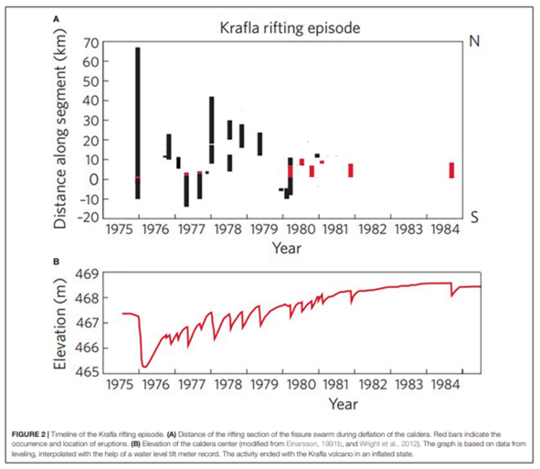
Billedet viser samspillet mellem dannelsen af diger og løft midt i Krafla-krateret. Det nederste billede viser højden af land inden for Krafla-krateret, mens det øverste viser afstanden mellem Krafla-krateret og urolighederne. (Páll Einarsson og Bryndís Brandsdóttir, 2021)
Opdateret 1. december kl. 16:50 UTC
Seismiciteten på halvøen fortsætter med at falde. I de sidste par dage har det automatiske jordskælvslokaliseringssystem registreret relativt få jordskælv, for det meste mikrojordskælv under størrelsesordenen 1. Den seneste seismicitet er koncentreret i området mellem Sýlingarfell og Hagafell, hvor diget højst sandsynligt fødes af magma, der ophobes under Svartsengi. Nogle deformationer detekteres stadig på cGPS-stationerne tæt på diget, men signalet tolkes nu hovedsageligt som skorpens reaktion på den igangværende inflation i Svartsengi-området.
Selvom aktiviteten langs diget og dets omegn nu foregår med meget lav intensitet, fortsætter inflationen, som startede i Svartsengi få dage efter digets dannelse, med et nogenlunde stabilt tempo. Nogle cGPS-stationer omkring Svartsengi og Mt. Þorbjörn viser en langsom faldende tendens, men andre stationer viser stadig en konstant tendens, hvilket tyder på, at indstrømningshastigheden af magma i dybden ikke er reduceret væsentligt.
Processen, der begyndte den 25. oktober med en betydelig seismisk sværm og toppede den 10. november med dannelsen af et 15 km langt magmatisk dige, er ikke slut. Med sikkerhed kan det konstateres, at en fase er startet, hvor et lignende hændelsesforløb kan gentage sig med tiden.
På dette stadium er det dog svært at sige, hvornår den næste energiske indtrængen af magma på lavere dybde kan forekomme, og om den vil forekomme i et lignende område eller ej. IMO fortsætter med at opretholde overvågningen af området på et højt niveau.
Opdateret 29. november kl. 17:00 UTC
Den seismiske aktivitet er fortsat langsomt faldende i løbet af de sidste to dage. I går blev der målt omkring 340 jordskælv nær magma-indtrængningen i området øst for Sýlingarfell, og siden midnat i dag er der registreret omkring 150 jordskælv. De fleste af jordskælvene har været mindre end 1,0.
Hævningshastigheden nær Svartsengi har været faldende, men den er stadig i gang med en hastighed på omkring 1 cm pr. dag. Størstedelen af forskydningen i regionen tilskrives i øjeblikket tilstrømning under Svartsengi med en mindre del, der strømmer ind i den magmatiske indtrængning. Med andre ord er deformationen målt og modelleret ved Svartsengi nu meget større end den, der ses nær magma-indtrængningen, men alle deformationssignaler aftager langsomt. Observerede tegn på indstrømning i den magmatiske indtrængen er nu begrænset til området øst for Sýlingarfell. På trods af opbremsningen af seismisk aktivitet og deformation anses et udbrud stadig for at være muligt. Hvis der opstår et udbrud, er det sted, der menes at være mest sandsynligt, øst for Sýlingarfell.
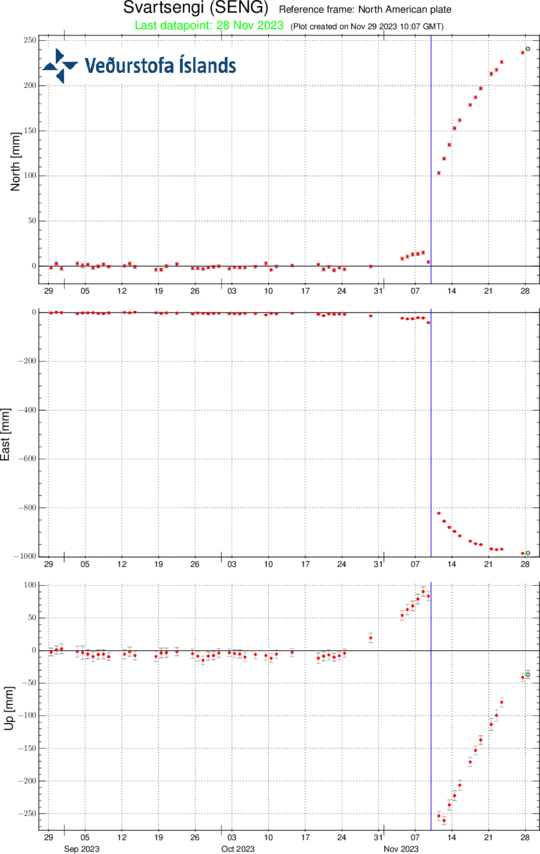
Her er en tidslinje for GPS-stationen Svartsengi (SENG). Den viser bevægelser over de sidste 90 dage i nordlige, østlige og lodrette retninger. Den blå linje markerer magma-indtrængningen fra den 10. november til i dag.
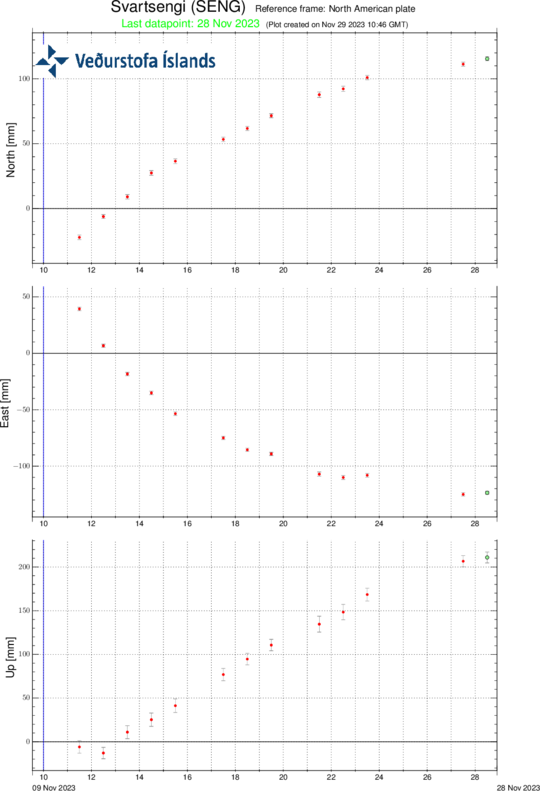
Dette billede viser bevægelserne fra stationen siden 10. november og frem til i dag .
Opdateret 27. november kl. 16:30 UTC
Seismisk aktivitet har været relativt stabil de seneste par dage med en daglig rate på omkring 500 jordskælv i området ved det magmatiske dige. Det meste af seismiciteten er fortsat i nærheden af Sýlingarfell og Hagafell. Omkring midnat begyndte en kortvarig seismisk sværm i nærheden af Sýlingarfell og varede i omkring en time. I alt blev der registreret 170 jordskælv i området i 3-5 km dybde. Jordskælvene var næsten alle meget små med én M3.0.
Data fra GPS-stationer og satellitbilleder viser, at stigningen fortsætter i området ved Svartsengi, og deformation er stadig i gang langs og omkring diget. Den forhøjede seismiske aktivitet, der fandt sted omkring midnat, er ikke forbundet med nogen ændringer i den igangværende deformation. Både seismiske data og deformationsdata tyder på, at magma fortsætter med at akkumulere under Svartsengi og strømme ind i den midterste del af diget, som blev dannet den 10. november. Den seismiske sværm, der opstod denne nat, kan tyde på stigende tryk i diget.
I lyset af de tilgængelige data og den nyeste analyse anses et udbrud langs diget stadig for sandsynligt, så længe magmatilstrømningen fortsætter. Det vurderes, at området med størst sandsynlighed for et udbrud ligger i den midterste del af diget mellem Hagafell og Sýlingarfell. Farekortet offentliggjort af IMO den 22. november forbliver gyldigt.
Yderligere geodætisk modellering er blevet udført for at rekonstruere udviklingen af diget, som blev dannet den 10. november. Disse nyeste resultater tyder på, at diget i dybden kunne være bredere end oprindeligt vurderet. Den tid, der er nødvendig for at størkne magmaen, der trængte ind i diget, ville derfor blive anslået til at være i størrelsesordenen et par måneder.
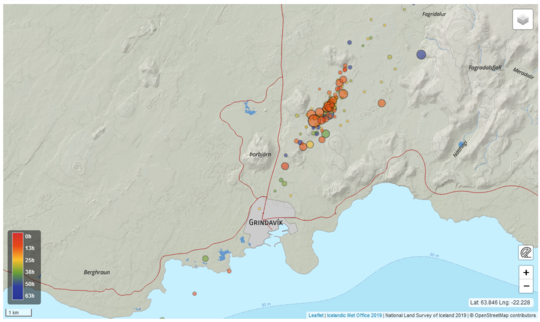
Dette billede viser gennemgåede jordskælv siden 24. november.
Opdateret 24. november kl. 13:30 UTC
I går blev der målt omkring 650 jordskælv nær digets indtrængning nord for Grindavík, og siden midnat i dag er der registreret knap 300 jordskælv. De fleste af jordskælvene er under M1,0, men det største jordskælv i de sidste to dage var M2,7 nær Hagafell. Den seismiske aktivitet fortsætter med at falde.
Data fra GPS-målinger viser, at deformationen fortsætter nær Svartsengi, og der måles stadig deformation omkring digets indtrængning. Der er dog tegn på, at deformationshastigheden er faldet baseret på data fra den seneste uge. Selvom fortolkningen af deformationsdata er kompleks på dette stadium. Det skyldes, at andre processer, såsom forkastningsbevægelser relateret til jordskælv og den viskoelastiske reaktion fra jordskorpen på uroligheder i området, har indflydelse på deformationssignalerne.
I betragtning af den seneste fortolkning af alle data, fortsætter sandsynligheden for et vulkanudbrud på et eller andet sted langs længden af magma-indtrængningen. Det er muligt, at magma kan dukke op i området mellem Hagafell og Sýlingarfell. Men efterhånden som skorpeafslapning fortsætter med at forekomme, og seismiciteten falder, sammen med et fald i magmatilstrømningen til indtrængningen, mindskes sandsynligheden for et forestående vulkanudbrud med tiden.
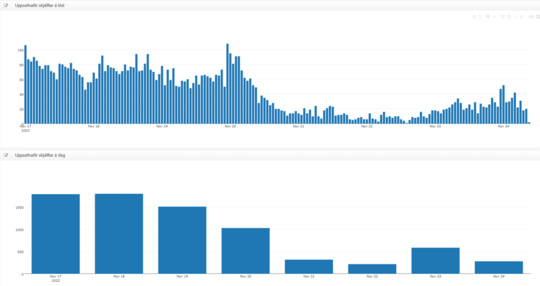
Oversigt over seismisk aktivitet fra fredag den 17. november. Den øverste graf viser antallet af jordskælv i timen, og den nederste graf viser antallet af jordskælv pr. dag. Virkningerne af stærk vind og kraftige havdønninger på Reykjanes-halvøen den 21. og 22. november er tydelige i færre registrerede jordskælv på grund af reduceret følsomhed af det seismiske netværk i det tidsrum.
Opdateret 23. november kl. 12:30 UTC
Den 21. november blev der registreret cirka 300 jordskælv i området for magma-indtrængningen. Fra midnat den 22. november til kl. 18.00 UTC samme dag var der registreret omkring 100 jordskælv i samme region, hvilket er betydeligt færre end de seneste dage. Derudover er intensiteten af jordskælv over størrelsesordenen 2,0 faldet. I perioden med hårdt vejr den 21. og 22. november blev der arbejdet på at vurdere, hvordan vejrforhold og havdønninger påvirker IMO’s overvågningssystemer.
Magma-tilstrømningshastigheder og skorpejusteringer relateret til dannelsen af indtrængen fortsætter med at falde. Derudover fortsætter jordskorpen i nærheden af Svartsengi i et lignende tempo. Geodetiske modeller baseret på data fra 21. november tyder på, at tilstrømningen til intrusionen er størst nær Sundhnúkur-kraterrækken, omkring 4 km nordøst for Grindavík. Mindre overfladeforskydninger er påvist inden for graben-regionen i og omkring Grindavík.
Sandsynligheden for et vulkanudbrud på et eller andet sted langs længden af magma-indtrængningen består. Det er muligt, at magma kan dukke op i området mellem Hagafell og Sýlingarfell. Men efterhånden som skorpeafslapning fortsætter med at forekomme, og seismiciteten falder, sammen med et fald i magmatilstrømningen til indtrængningen, mindskes sandsynligheden for et forestående vulkanudbrud med tiden.
Baseret på de seneste data og i betragtning af aktivitetsudviklingen siden 10. november er sandsynligheden for et pludseligt udbrud i Grindavík byområde dagligt faldende, og den vurderes i øjeblikket som lav. Det kan antages, at nyligt anbragt magma under Grindavík er størknet delvist, hvilket reducerer sandsynligheden for, at magmaen når overfladen inden for bygrænsen. Vi understreger dog, at muligheden for et vulkanudbrud på et tidspunkt i længden af intrusionen, især mellem Hagafell og Sýlingarfell, forbliver plausibel.
Det er tydeligt, at der er en stærk sammenhæng mellem jordskorpehævningen i Svartsengi-regionen og den pludselige, indledende udbredelse af magma-indtrængningen den 10. november. Modeller indikerer, at magmaen i reservoiret under Svartsengi kan være strømmet østpå mod Sundhnúkur-kraterne og efterfølgende dannet den 15 km lange vulkanske indtrængen. Mens jordskorpeløftet i Svartsengi fortsætter, forventes det, at den akkumulerende magma igen kan strømme mod øst, hvilket potentielt genaktiverer indtrængen. Det er også muligt, at der kan dannes en magma-indtrængning vest for magmakroppen, der akkumuleres under Svartsengi. Forstadier til en sådan hændelse vil omfatte udtalt seismicitet og hurtige jordforskydninger, som begge overvåges nøje af IMO kontinuerligt.
Opdateret 21. november kl. 15:30 UTC
Siden midnat i dag er der registreret 165 jordskælv på grund af de igangværende vulkanske uroligheder, alle under størrelsesordenen 2,0 i størrelse. Niveauet af seismicitet i dag er betydeligt lavere end i de seneste dage, hvor der blev registreret 1.500-1.800 jordskælv hver dag. Det kan forventes, at det intense vejr, der påvirker landet, har betydning for følsomheden af det seismiske overvågningssystem til at detektere de mindste jordskælv, hvilket gør det svært at vurdere, om den seismiske aktivitet generelt er faldende.
Deformationen i forbindelse med magma-indtrængningen, der blev dannet den 10. november, fortsætter. Ligeledes fortsætter jordskorpehævningen nær Svartsengi. Hastigheden af hævningen ved Svartsengi har været næsten den samme i løbet af de seneste 24 timer.
I samarbejde med specialister fra Islands Universitet fortsætter IMO med at overvåge området så effektivt som muligt, idet de konstant revurderer og fortolker de modtagne data.
Som tidligere nævnt har IMO øget overvågningen i og omkring Grindavík og området omkring Hagafell. Effektiviteten af denne overvågning afhænger af jordskælvets høje følsomhed og GPS-målinger i realtid, som er meget afhængige af vejrforholdene. Givet vejrudsigten for de næste to dage, som indikerer nedbør og betydelig vind, kan det forventes, at både seismisk overvågning og realtids GPS-observationer vil blive påvirket. Havets bølger skaber også mikroseismer, der overvælder lavfrekvente detektionskapaciteter af seismometre på Reykjanes-halvøen. Tåge og haglbyger kan også påvirke den visuelle bekræftelse af et udbrud, hvilket øger overvågnings- og vurderingsusikkerheden.
Opdateret 20. november kl. 13:20 UTC
Siden midnat i dag er over 700 jordskælv blevet opdaget i området for magma-indtrængningen, hvoraf det største var 2,7 på Richterstyrken nær Hagafell.
I de seneste dage er der målt mellem 1.500 og 1.800 daglige jordskælv i regionen, hvor den største hændelse registrerede en styrke på 3,0 sidste fredag (17. november). Baseret på radarbilleder fra 18. og 19. november 2023 viser det seneste interferogram af magma-indtrængningen og det omkringliggende område en betydelig jordskorpeløft i nærheden af Svartsengi. Det nyligt behandlede interferogram blev gennemgået af eksperter i weekenden (18. – 19. november) fra det islandske meteorologiske kontor, Islands Universitet og Department of Civil Protection and Emergency Management. Resultaterne blev også diskuteret på dagens statusmøde, afholdt i IMO. Den hurtige, igangværende løft tæt på Svartsengi sker i det samme område, hvor stigningen blev målt før magma-indtrængningen dannede den 10. november. Geodætiske modeller udledt af satellitbilleder viser, at løftningen i Svartsengi-området er betydeligt hurtigere end tidligere. Generelt, når der dannes en magma-indtrængning, sker nedsynkning over indtrængningens midterlinje, som det ses i Grindavík, med tegn på landhævning, der kan ses ved siden af indtrængningen. Skorpehævning i Svartsengi-regionen på grund af magma, der akkumuleres i dybden, har været målbar, siden indtrængen begyndte at dannes den 10. november. Oprindeligt var opløftningstegnet påvirket af dannelsen af indtrængen, men nu er dominansen af dyb magma genopladning tydelig.
Det klare tegn på jordskorpeløft i Svartsengi-regionen ændrer ikke på sandsynligheden for et udbrud fra magma-indtrængningen. Dette vurderes blandt andet ud fra, at jordskorpen over magma-indtrængningen er meget svagere end skorpen over hævningsområdet tæt på Svartsengi. Så længe der ikke er signifikant seismicitet i Svartsengi-regionen, er der ikke stor sandsynlighed for et udbrud på det sted. Desuden vurderes et udbrud stadig mere sandsynligt fra indtrængningen, især hvis der er en pludselig, stor indstrømning af magma ind i indtrængningen.
Vores overvågnings- og farevurderingsforberedelser er stadig baseret på den antagelse, at situationen kan ændre sig pludseligt med lidt advarsel. Det islandske meteorologiske kontor vil i tæt samarbejde med eksperter fra Islands Universitet fortsætte med at overvåge området tæt med det mål løbende at fortolke og evaluere alle tilgængelige overvågningsobservationer.
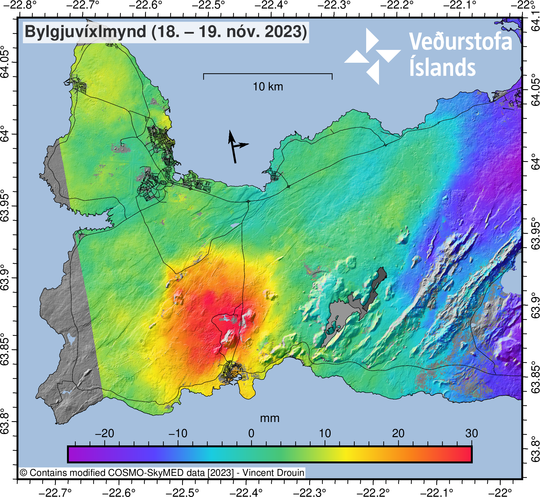
COSMO-Skymed interferogram spænder over 24 timer mellem 18-19 november kl. 06:41. Det brede opløftningssignal, der er synligt i orange/rødt omkring Svartsengi, er tegn på, at en dyb oppustning (>5 km) finder sted.
Opdateret 18. november kl. 15:00 UTC
Seismicitet relateret til magma-indtrængen, der pludselig blev dannet for en uge siden, forbliver høj og konstant. Cirka 1.700 jordskælv er blevet registreret i de sidste 24 timer, 1.000 af dem er registreret siden midnat. Det største jordskælv i løbet af de sidste 24 timer havde en styrke på 2,8 og fandt sted nær Hagafell, 3,5 km NNE for Grindavík.
Opdateret 17. november kl. 12:00 UTC
Seismiciteten relateret til magma-indtrængningen, der pludselig blev dannet for en uge siden, forbliver høj og konstant, selvom aktivitetsniveauet er væsentligt lavere end 10. – 12. november 2023. Der er registreret ca. 2.000 jordskælv inden for de sidste 24 timer, med mest aktivitet i et område nord for Hagafell, mod Sundhnúkar-kraterne. Det meste af seismiciteten er mikrojordskælvsaktivitet omfattende jordskælv under M 1. Det største jordskælv i løbet af de sidste 24 timer fandt sted kl. 06:35 nær Hagefell; den havde en størrelsesorden på 3,0.
Ifølge GPS-målinger fortsætter jorddeformationen, men med en faldende hastighed. De seneste geofysiske modeller baseret på GPS-data og satellitbilleder indikerer, at de største bevægelser i magma-indtrængningen finder sted nord for Grindavík, nær Hagafell. Hvis det lykkes magma at nå overfladen, menes Hagafell at være det bedste sted for et udbrud.
Indsynkning over magma-indtrængningen forbliver aktiv, selvom målinger viser en lille opbremsning fra dag til dag. På nuværende tidspunkt viser GPS-stationer placeret i og omkring Grindavík, nær midten af indsynkningszonen, omkring 3-4 cm indsynkning om dagen.
Baseret på fortolkningen af de seneste data og modelresultater er et vulkanudbrud fortsat sandsynligt, med den største sandsynlighed for, at det starter nord for Grindavík nær Hagafell.
Et kort, der viser omfanget af nedsynkningen over magma-instruktionen i og omkring Grindavík. En GPS-station (GRIC) placeret nær midten af synket har registreret et samlet synkning på 25 cm siden begyndelsen af hændelsen.
Opdateret 16. november kl. 17:50 UTC
I løbet af de sidste par dage har seismiciteten nær magma-indtrængningen været relativt stabil. Fra kl. 17.00 i dag er der registreret omkring 1.400 jordskælv siden midnat, hvoraf det største er 2,9 i styrke, opstået nær Hagafell lige efter kl. 13.00. De fleste af jordskælvene var under størrelsesordenen 2, med den højeste koncentration af aktivitet nær Hagafell.
Deformation relateret til magma-indtrængningen bliver fortsat målt, selvom den er aftaget lidt siden i går. De seneste modeller, afledt af GPS-målinger og satellitdata, tyder stadig på, at de største bevægelser af magma-indtrængningen er nord for Grindavík nær Hagafell. Hvis magma formår at bryde igennem til overfladen, er det højst sandsynligt, at det sker i Hagafell-regionen.
Tidligt i dag blev svovldioxid (SO 2 ), en type vulkansk gas, målt fra et borehul ved Svartsengi, der ligger lige nord for Þorbjörn. Boringen strækker sig mod øst til betydelig dybde mod Sundhnúkur-kraterrækken. Grunden af borehullet når derfor tæt på det sted i skorpen, hvor magma-indtrængningen er lokaliseret. Yderligere gasmålinger vil blive gennemført i morgen den 17. november. Detekteringen af vulkansk gas fra et sådant borehul er en anden uafhængig bekræftelse af tilstedeværelsen af magma nord for Hagafell, som indikeret af seismisk aktivitet og geofysiske modelleringsresultater.
Sandsynligheden for et udbrud er fortsat høj. Overvågning fortsætter for tegn på overfladisk seismicitet og pludselige jordskorpebevægelser, som kan være forløbere for magma, der bryder sin vej til overfladen. I skrivende stund var der ikke observeret sådanne tegn.
Opdateret 15. november kl. 11:30 UTC
Siden midnat er der målt omkring 800 jordskælv, de fleste af dem midt på magmadiget ved Sundhnúk i omkring 3-5 km dybde. Seismisk aktivitet har været konstant siden 11. november . Det primære overvågningsfokus på seismisk aktivitet er fortsat i området omkring diget og Grindavík.
Deformationsmålinger viser fortsat deformation i området. De stemmer overens med magma, der stadig strømmer ind i diget. En del af magmadiget ser ud til at størkne, især i kanterne, men ikke ved magmaindstrømningen, som menes at være nær Sundhnúk.
Målinger af svovldioxid (SO 2 ) ser ud til at vise svingende afgasning på grund af magmadiget, men yderligere målinger er nødvendige for bekræftelse. Analyse af disse data er i øjeblikket i gang i samarbejde med Chalmers Universitet i Sverige.
Det fiberoptiske kabel fra HS Orka, der løber fra Svartsengi vest for Þorbjörn til Arfadalsvík, bliver brugt som en kontinuerlig seismisk målelinje med høj følsomhed. Dette er en ny teknologi, der har udviklet sig i de senere år, og som nu bruges som yderligere målinger i samarbejde med HS Orku og ETH i Schweiz.
Generelt ser situationen ud til at være uændret siden i går. Sandsynligheden for et udbrud anses stadig for høj. I tilfælde af et udbrud er den mest sandsynlige placering ved magmadiget.
Opdateret 14. november kl. 19:20 UTC
Tidligere på ugen installerede IMO-specialister to DOAS-fjernmålingsinstrumenter på Húsafell. Disse instrumenter kan måle tilstedeværelsen og mængden af SO2 i atmosfæren. Et af DOAS-instrumenterne detekterede SO2 i går og i dag ved den nydannede graben, der ligger mellem Sundhnúkagígar og Grindavík. På grund af den lave mængde dagslys kan målingerne være upræcise, og det tog tid at gennemgå dataene og fortolke dem. I de sidste to dage har østenvinde været fremherskende i området, så det kan ikke udelukkes, at den seneste stærk seismicitet har forårsaget frigivelsen af SO2 fra under Fagardalsfjall, da magma på det sted endnu ikke er størknet siden udbruddet i juli 2023 .
Det er svært at vurdere dybden, hvorfra SO2 frigives, da processen er påvirket af magmatryk. Det menes dog, at magmaen skal være i de øverste hundrede meter af skorpen, for at SO2 kan frigives. Dette er en af grundene til, at DOAS-instrumenterne er blevet placeret tæt på Grindavík.
DOAS (Differential Optical Absorption Spectrometer) er et værktøj, der kan detektere svovldioxid i atmosfæren. Metoden er afhængig af synligt lys, som bevæger sig gennem atmosfæren, rammer en sensor i måleapparatet, som derefter analyseres for bestemte farver (bølgelængder), der mangler i spektret. Svovldioxid absorberer visse bølgelængder af lys, hvilket betyder, at lys rammer måleinstrumentet på en anden måde, hvis der detekteres SO2. Sonden scanner visse dele af himlen, og den giver information om koncentrationen af svovldioxid i det scannede område. DOAS-målinger kræver dagslys for at fungere, så det kan være udfordrende at betjene sådanne instrumenter om vinteren i Island.
Opdateret 14. november kl. 12:40 UTC
Siden midnat den 14. november har over 700 jordskælv været lokaliseret langs orienteringen af magma-indtrængningen, hvoraf det største var M 3.1 nær Hagafell. I aftes, 13. november, fandt stress-udløst seismicitet sted tæt på Kleifarvatn, hvor det største jordskælv registrerede M 3,8 kl. 21:09 UTC. I dag forekommer de fleste jordskælv langs magma-indtrængningen, hvor størstedelen er mikrojordskælv, almindeligvis i brænddybder på 3 til 5 km.
Deformationsmålinger, herunder luftobservationer i høj opløsning, satellitradarbilleder og jordbaserede GPS-observationer afslører fortsatte, igangværende jordbevægelser på grund af den igangværende dannelse af magma-indtrængningen. Disse resultater er i overensstemmelse med fortsat, omend meget lavere magmatilstrømning til området for indtrængningen.
Mellem 12. og 13. november er tilstrømningen estimeret til 75 m 3 / s, og den gennemsnitlige dybde til toppen af magma-indtrængningen menes at være omkring 800 m. Tilløbs- og dybdeestimaterne er afledt af modelbaserede beregninger, og de er behæftet med usikkerhed.
I hele denne periode med vulkansk uro har fokus været kontinuerlig overvågning af seismicitet og jorddeformation i Grindavík – Svartsengi-regionen. For at fremme vores overvågningsmuligheder har vi installeret yderligere GPS-stationer i og omkring Grindavík. De seneste målinger fra disse stationer viser, at den graben-lignende formation stadig dannes og er mekanisk aktiv. For at øge vores evne til at advare om et udbrud har vi desuden installeret jordbaserede SO2-detektorer, der har udsigt over Grindavík og syd for Sundhnúkur.
Sammenfattende er sandsynligheden for et udbrud fortsat høj. Hvis der opstår et udbrud, vil det mest sandsynlige sted være langs retningen af magma-indtrængningen, begyndende som et sprækkeudbrud.
Opdateret 13. november kl. 16:20 UTC
Seismiciteten langs magma-indtrængningen fortsætter, selvom størrelsen og intensiteten af aktiviteten er aftagende. Siden midnat i dag den 13. november er der blevet registreret omkring 900 jordskælv. Den seismiske aktivitet er koncentreret om området for indtrængen mellem Sundhnúkur og Grindavík i en dybde på omkring 2-5 km.
Faldende hastigheder for jorddeformation ses i GPS-data fra Grindavík. Satellitradarresultater viser en graben-lignende formation, der skærer gennem en del af Grindavík. Denne funktion blev først identificeret af IMO i satellitradarbilleder tidligt den 11. november.
Dette stigende COSMO-SkyMed (CSK) interferogram dækker tidsperioden 3-11 november og viser et omfattende deformationsfelt relateret til diget intrusion, der begyndte om eftermiddagen den 10. november i Reykjanes-Svartsengi vulkanske system. Dette CSK-interferogram og det forrige (spænder fra 2.-10. november) understøttede den vanskelige beslutning, som Civilbeskyttelsen traf om at evakuere byen Grindavík sent fredag aften. Det muliggjorde også modellering af dimensionerne af digets indtrængning (den 11. november), hvilket gav en median digelængde på 15 km og topdybde på mindre end 1 km under overfladen. Billederne viser over 1 m jordforskydning i den vestlige del af Grindavík, forårsaget af udbredelsen af magma-indtrængningen. Fra geodætiske modelleringsresultater konkluderer vi, at (pr. 12. november) det største område af magma-opstrømning er hentet tæt på Sundhnúkur, 3,5 km nord-nordøst for Grindavík.
Ny geodætisk modellering udføres i øjeblikket ved hjælp af et ICEYE-interferogram og GNSS-observationer, der strækker sig over de sidste 24 timer, for bedre at vurdere den igangværende aktivitet og give et estimat af de nuværende magma-tilstrømningshastigheder.
Ifølge vores seneste skøn er vurderingen af vulkanfare i og omkring Grindavík uændret fra den 12. november. Alle overvågningssystemer overvåges tæt i realtid, især nær Grindavík, for tegn på pludselige ændringer. Overvågningsteamet for naturfarer hos IMO arbejder med maksimal overvågning, mens Department of Civil Protection and Emergency Management koordinerer kortvarig, midlertidig adgang til Grindavík i dag, den 13. november.
Skøn over de lodrette forskydninger forårsaget af diget under dets indledende udbredelse fra fredag eftermiddag til lørdag morgen. Forskydningerne blev estimeret ved at kombinere ICEYE og COSMO-SkyMed pixel offset tracking resultater.
Opdateret 12. november kl. 12:30 UTC
Siden morgenen den 11. november har seismisk aktivitet relateret til magma-indtrængningen været nogenlunde konstant. Siden midnat den 12. november er der registreret omkring 1000 jordskælv i diget, og alle har været under M3,0 i styrke. Den mest seismiske aktivitet har fundet sted i regionen nord for Grindavík. De fleste jordskælv er i en dybde på 3-5 km svarende til den nederste del af digets indtrængning.
GPS-målinger, der dækker de seneste 24 timer, viser, at deformationen i forbindelse med digeindtrængningen, der blev dannet fredag den 10. november, er aftaget. Dette kan være en indikation af, at magma bevæger sig tættere på overfladen, nye modeller vil blive kørt, så snart nye data kommer ind for at opdatere modellen.
Det var en fælles vurdering fra mødet, baseret på de seneste data, at der er plads til midlertidige foranstaltninger under kontrol af Department of Civil Protection and Emergency Management for at indsamle fornødenheder til beboerne og varetage akutte ærinder i Grindavík og omegn. areal. Under sådanne operationer er det nødvendigt at øge områdets årvågenhed gennem yderligere overvågning med det formål at forbedre påvisningen af magma, der når overfladen. Det var forskernes opfattelse, at det ville være tilrådeligt at påbegynde disse operationer med det samme, da usikkerheden om begivenhedens fremskridt vokser, som dagen skrider frem. Den endelige beslutning om, hvorvidt disse handlinger vil blive gennemført, og deres gennemførelse er i hænderne på den offentlige sikkerhed og politimesteren på Suðurnes.
I lyset af denne fælles vurdering har politimesteren i Suðurnes besluttet at tillade indbyggere at dele af et begrænset område i Þorkötlustaðahverfi, og det er kun for at hente vitale genstande, kæledyr og husdyr. Dette vil blive organiseret og kontrolleret af politiet. Denne tilladelse gælder kun for Þorkötlustaðahverfi. Bemærk, en særlig operation er i gang med at hente alle heste i området nord for Austurver.
Denne nyhed er blevet opdateret siden de seneste oplysninger fra politimesteren i Suðurnes.
Opdateret 11. november kl. 18:30 UTC
Klokken 18.00 i dag, den 11. november, afsluttedes et statusmøde mellem forskere ved det islandske meteorologiske kontor, Islands Universitet og Institut for Civilbeskyttelse og Beredskab. Formålet med mødet var at diskutere de seneste målinger af seismicitet og jorddeformation i Grindavík-regionen, udover at gennemgå de nyeste geofysiske modeller og farevurderinger. Fra kombinerede vurderinger af satellitradarbilleder, jordbaserede GPS-målinger og seismicitet blev det konkluderet, at den igangværende digeindtrængen udgør en alvorlig vulkansk fare.
Ud fra geofysiske modeller af digets indtrængning vurderes det, at indtrængningen forplanter sig langsomt opad, idet magma menes at være 800 m under overfladen. Den nøjagtige placering af et muligt udbrudssted er ukendt, men digets 15 km længde og orientering giver en god indikation af mulige kilder. Den overordnede vurdering fra statusmødet var, at sandsynligheden for et vulkanudbrud er stor, og at et udbrud kunne være muligt på en tidsskala på blot dage. Baseret på digets udstrækning kunne magma dukke op fra dens sydlige del, lige uden for Grindavik. Derfor er sandsynligheden for et ubådsudbrud også steget, så der skal forberedes mulighed for eksplosiv aktivitet. Der er defineret et fareområde ud fra digets placering, som vist på kortet.
Statuskort, der viser placeringen af digets indtrængen baseret på kombineret satellitradarbilleder, GPS-målinger og geofysisk modellering.
Opdateret 11. november kl. 12:00
Siden midnat er der målt omkring 800 jordskælv i den region, hvor magma-indtrængningen finder sted. Jordskælvets aktivitet er aftaget en smule de seneste timer, men den er fortsat høj. De fleste af de seneste jordskælv har fundet sted tæt på Grindavík, hvor den sydvestlige ende af det magmatiske dige skønnes at være placeret.
Analyse af jordskælvene fra i dag og i går er i gang. Målet med dette arbejde er bedre at forstå udviklingen af magma-indtrængningen. I øjeblikket tyder data på, at magma-indtrængningen strækker sig fra Stóra-Skógsfell i nord til Grindavík i syd, hvor den strækker sig under havet. I overensstemmelse med de seneste foreløbige modeller, ved hjælp af de seneste satellitdata indsamlet i aftes, er den laveste dybde af toppen af magma-indtrængningen nord for Grindavík 1,5 km. Fælles fortolkning af jord- og satellitmålinger indikerer, at størrelsen af magma-indtrængningen og hastigheden, hvormed den bevæger sig, er flere gange større, end der tidligere er blevet målt på Reykjanes-halvøen. Vores vurdering er, at et udbrud, hvis det skulle ske, vil stamme fra den nordlige side af magma-indtrængningen. Det betyder, at der er større sandsynlighed for, at et udbrud begynder tæt på Sundhnjúkagígur.
Forskere mødes regelmæssigt for at fortolke dataene og opdatere de nyeste modeller og farevurderinger. Der afholdes et møde for journalister kl. 12.00 i Institut for Civilbeskyttelse og Beredskab. De nuværende forhold og fremtidige scenarier vil blive diskuteret.
Sandsynligheden for et vulkanudbrud i den nærmeste fremtid vurderes at være betydelig.
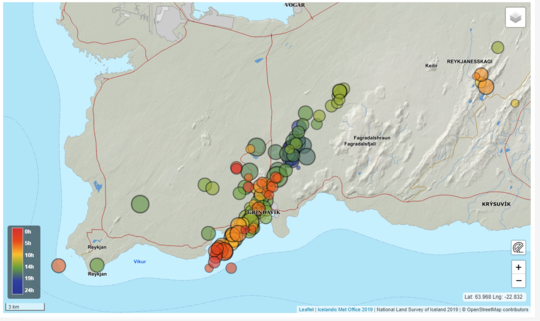
Gennemgået jordskælv siden kl. 21 i nat.
Opdateret 10. november kl. 23:30
Der er sket væsentlige ændringer i den seismiske aktivitet målt nær Sundhnjúkagígar nord for Grindavík og deformation observeret på Reykjanes-halvøen i eftermiddag. Den seismiske aktivitet har bevæget sig sydpå mod Grindavík. Baseret på hvordan den seismiske aktivitet har udviklet sig siden kl. 18.00 i dag, sammen med resultater fra GPS-målinger, er der en sandsynlighed for, at en magma-indtrængning har strakt sig under Grindavík. I lyset af dette resultat har politimesteren i Suðurnes i samarbejde med civilbeskyttelsesmyndighederne besluttet at evakuere Grindavík. Et nødniveau for civilbeskyttelse er nu i kraft. Dette er ikke en nødevakuering. Beboere i Grindavík rådes til at gå forsigtigt frem.
På nuværende tidspunkt er det ikke muligt at afgøre præcist, om og hvor magma kan nå overfladen. Noget tyder på, at en betydelig mængde magma bevæger sig i et område, der strækker sig fra Sundhnjúkagígum i nord mod Grindavík. Mængden af involveret magma er betydeligt mere end hvad der blev observeret i de største magma-indtrængninger i forbindelse med udbruddene ved Fagradalsfjall. Yderligere data indsamles for at beregne modeller, der giver et mere præcist billede af magma-indtrængningen. Det er på nuværende tidspunkt ikke muligt at sige, hvornår dette arbejde vil være afsluttet.
Opdateret 10. november kl. 20.00
Den seismiske aktivitet, der i øjeblikket måles ved Sundhnjúkagígar, forekommer inden for et område omkring 3 km nordøst for Grindavík. De laveste jordskælv, der er målt nu, er i en dybde på omkring 3-3,5 km.
De tegn, der kan ses nu ved Sundhnjúkagígar, ligner dem, der blev set på tærsklen til det første udbrud ved Fagradalsfjall i 2021 og minder meget om den seismiske aktivitet, der blev målt omkring en måned før det udbrud. Det mest sandsynlige scenarie nu, når man tager den aktivitet i betragtning, der kulminerede i begyndelsen af den 19. marts 2021 , er, at det vil tage flere dage (i stedet for timer) for magma at nå overfladen.

Jordskælv den 10. november (indtil kl. 18.48). Det islandske meteorologiske kontors seismiske netværk er vist med trekanter. Fire seismiske stationer omkring den aktuelle seismiske aktivitet har vist en stor stigning i rysten siden kl.
Opdateret 10. november kl. 18.30
Nationalkommissæren for det islandske politi har i samråd med politichefen i Suðurnes erklæret en civilbeskyttelses-alarmfase på grund af den intense jordskælvsværm, der startede kl. 15 i dag ved Sundhnjúkagígar, nord for Grindavík. Der er mulighed for større jordskælv, end man hidtil har oplevet, og dette hændelsesforløb kan føre til et udbrud. Civilbeskyttelsesberedskabsfasen betyder, at risikoen er stigende, og der bliver truffet foranstaltninger for at sikre den største sikkerhed for dem, der bor/opholder sig i området. Dette gøres ved at øge forholdsreglerne i det relevante område.
Flyfarvekoden er blevet forhøjet til orange (øget uro med øget sandsynlighed for udbrud). IMO følger situationen nøje. Beboere opfordres til at følge informationen på Almannavarnir .
Opdateret 10. november kl. 14.00
Tidligere i dag, klokken 12:44, opstod et jordskælv med en styrke på 4,1 nær Sýlingarfell, vest for Sundhnjúkagígar. Kraterne ligger omkring 2-3 km nordøst for Grindavík. En tæt sværm af jordskælv begyndte omkring klokken 07.00 i morges i samme område, og der er registreret næsten 800 jordskælv siden midnat, heraf 9 større end 3. Jordskælvenes dybde er omkring 5 km. Sådanne jordskælvsværme er tidligere blevet registreret i dette område. Det kan ikke udelukkes, at den seismiske aktivitet nær Sundhnjúkagígar skyldes magmabevægelser i dybden.
Magmaophobning fortsætter nær Þorbjörn i samme dybde og med samme hastighed som før. Det er ledsaget af sværmlignende seismisk aktivitet, som det blev bemærket i går og i morges. Mens magmaakkumulering fortsætter, kan der forventes igangværende seismisk aktivitet på grund af stressfrigivelse i området. Jordskælv op til størrelsesordenen M5,5 kan forventes i sådanne sværme, og den seismiske aktivitet kan skifte mellem områder. På dette stadium er der ingen indikationer på, at magma tvinger sig vej til overfladen.
Gennemgået jordskælv siden midnat
Opdateret 9. november kl. 12:20
Omkring 1400 jordskælv er blevet registreret i de sidste 24 timer. Seismisk aktivitet steg fra midnat, og SILs seismiske netværk har detekteret syv jordskælv over M4.0 siden da. Det største jordskælv målte M4,8 kl. 12:46. Det lå vest for Þorbjörn. Det er det største jordskælv siden aktiviteten begyndte den 25. oktober. Syv jordskælv M4.0 eller større i størrelse blev målt i området fra Eldvörp til området øst for Sýlingarfell. Mens ophobningen af magma fortsætter, kan der forventes seismisk aktivitet på Reykjavík-halvøen, fordi magma-indtrængningen forårsager øget spænding i området.
Ifølge GPS-data ved midnat fortsætter stigningen i området. GPS-dataene bliver gennemgået i forhold til den seismiske aktivitet i aften. Siden inflationens begyndelse og frem til i dag har stigningen været nogenlunde jævn, selvom der er observeret en acceleration af processen mellem dage. Den seismiske aktivitet i nat og i morges er et eksempel på denne episodiske seismiske aktivitet, der kan forventes, mens magmaakkumulering er i gang. At der nu er større jordskælv end tidligere i området, betyder ikke nødvendigvis en øget hastighed af magma-akkumulering.
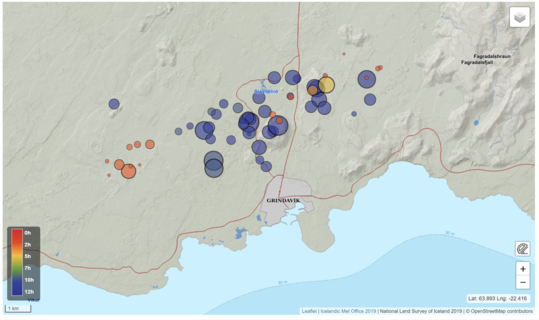
Gennemgået jordskælv siden midnat i nat
Opdateret 8. november kl. 14:40
Cirka 1200 jordskælv er blevet målt i de sidste 24 timer, de fleste af dem i området mellem Þorbjörn og Sýlingafell, svarende til dagen før. Det største jordskælv var M3.4 kl. 12.31 i nat, lige syd for Þorbjörn. Den seismiske aktivitet fortsætter i samme dybde som før. Det er sandsynligt, at seismisk aktivitet vil fortsætte og være episodisk i intensitet, mens magmaakkumulering er i gang.
Opløftningen fortsætter med samme hastighed som før ifølge satellit- og GNSS-data. Interferogram (InSAR) for perioden 28. oktober – 6. november, der viser næsten lodret bevægelse, bekræfter dette, men det viser også forskydninger på grund af fejlbevægelser forbundet med den seismiske aktivitet. Opdaterede modeller baseret på de samme data estimerer, at magma fortsætter med at akkumulere i en vandret tærskel i en dybde på omkring 5 km, og siden begyndelsen af inflationsbegivenheden (27. oktober) er den gennemsnitlige tilstrømning estimeret til omkring 5 m 3 /s (usikkerhed er ±2 m 3 /s)
Interferogram (InSAR) for perioden 28. oktober – 6. november viser, at deformationen i den periode er omkring 7 cm. SW for bjerget Þorbjörn er en offset i deformationssignalet forårsaget af fejlbevægelser fra jordskælv.
Opdateret 7. november kl. 13:30
Der har været omkring 900 jordskælv i de sidste 24 timer, de fleste af dem i området mellem Þorbjörn og Sýlingafell. Det største jordskælv var M2,9 og fandt sted omkring klokken 7 i morges. Den seismiske aktivitet forbliver på samme dybde som før.
Ifølge satellitdata behandlet omkring kl. 17 i går og dækker perioden mellem 4.-6. november, bekræfter det, at løftningen fortsætter omkring Þorbjörn. De samme data viser ingen tegn på magmaakkumulering i Eldvörp eller nær Sýlingarfell, øst for Svartsengi, hvor seismisk aktivitet er blevet målt i de seneste dage.
Magmaophobning fortsætter i en dybde på omkring 5 km i NW for Þorbjörn. Hvis den 27. oktober betragtes som startdagen for inflationsbegivenheden indtil i dag, har stigningstakten været nogenlunde konstant, selvom der er observeret en acceleration af processen mellem dage. Det er sandsynligt, at seismisk aktivitet vil fortsætte og være episodisk i intensitet, mens magmaakkumulering er i gang.
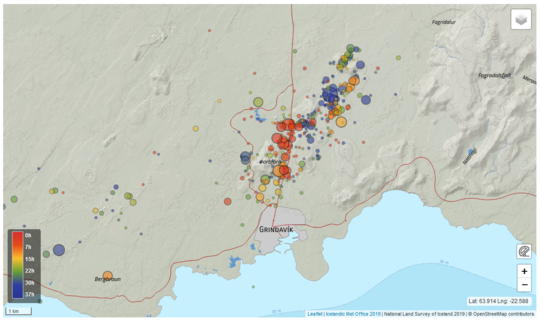
Gennemgået jordskælvssteder siden den 6. november og i dag indtil kl.
Opdateret 6. november kl. 13:15
I de sidste 24 timer er omkring 1300 jordskælv blevet opdaget på Reykjanes-halvøen, hvoraf tre jordskælv var over M3. Det største jordskælv var M3,6 i morges og fandt sted 3 km NØ for Þorbjörn-bjerget.
Deformationsdata viser, at stigningen fortsætter i området, og der er indikationer på GNSS-observationer om en stigning i inflationsraterne siden 3. november. Siden starten af inflationen er stigningen ved GNSS-stationen ved Þorbjörns bjerg nået 7 cm. Deformationen er forårsaget af en indtrængning af tærsklen på omkring 5 km dybde. Modellering, baseret på data siden 27. oktober, indikerer, at volumenændringen forbundet med denne inflationsbegivenhed har nået næsten det dobbelte af volumenændringen forbundet med de fire tidligere inflationsbegivenheder i samme område mellem 2020-2022. Indstrømning af magma/magmatiske væsker ind i karmlegemet er estimeret til ca. 7 m3/s, hvilket er ca. fire gange større end den højeste tilstrømning, der er estimeret under tidligere inflationsbegivenheder her.
Mens inflationen fortsætter, kan øget seismicitet i området forventes fra yderligere stressændringer induceret i skorpen.
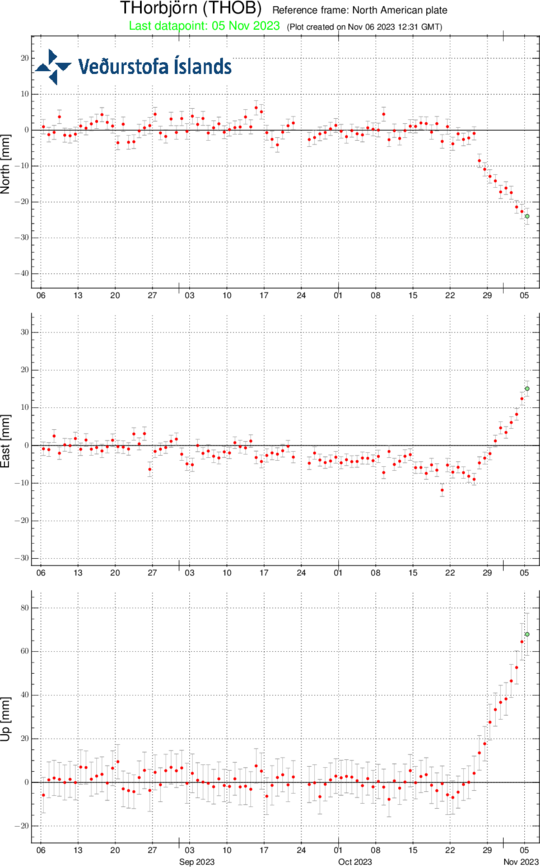
Data fra GNSS station ved Mt. Þorbjörn. Grafen nederst viser stigningen.
Opdateret 4. november kl. 23:30
Efter klokken 17.30 i går faldt den seismiske aktivitet betydeligt. I de sidste 12 timer er der registreret omkring 900 jordskælv, alle under M3.0. Aktiviteten efter midnat har primært været placeret ved Sundhnjúkagígar – NØ for Þorbjörn, samt vest for Eldvörp.
Seismiciteten er faldet betydeligt siden i går, men udviklingen af jordskælvets størrelse, antallet af jordskælv og deres placering er sammenlignelig med udviklingen, der tidligere er set relateret til magma-akkumulering i nærheden af Þorbjörn.
De seneste deformationsdata viser, at løftningen fortsætter i området. Denne hævning menes at skyldes magmaophobning NV for Þorbjörn i 4-5 km dybde. Mens denne magma-akkumulering fortsætter, kan øget seismicitet i området forventes fra øgede spændinger i skorpen. Stenspyn kan forekomme efter store jordskælv, så der skal udvises forsigtighed ved stejle skråninger.
Det islandske meteorologiske kontor fortsætter med at overvåge området tæt og mødes med civilbeskyttelsesagenturet for at diskutere situationen. Tegn på magma, der kommer mod overfladen, vil fremstå som øget, mere lavvandet seismicitet og hurtig skorpedeformation ved overfladen samt vulkansk tremor, som er en høj grad af mange små jordskælv. På nuværende tidspunkt kan der ikke ses klare tegn på noget af dette, men situationen kan ændre sig med kort varsel.
Jordskælv (cirkler) med styrke over 1,5 fra midnat den 3. november til kl. 10.45 den 4. november. Farvebjælken til venstre viser tidspunktet for jordskælvene, og størrelsen af cirklerne repræsenterer begivenhedernes relative størrelse. Placeringer af seismiske stationer (trekanter) og GPS-deformationsstationer (firkanter) er også vist.
Opdateret 3. november kl. 15.00
Et jordskælv med en styrke på 4,3 blev opdaget kl. 13.14 i dag mellem Þorbjörn og Sýlingarfell. Endnu et jordskælv med en styrke på 3,5 blev opdaget kl. 14:01 i Þorbjörn. Disse jordskælv menes at skyldes vedvarende stress i skorpen fra magma-akkumulering under Þorbjörn-bjerget. Der er ikke påvist vulkansk rystelse, og området bliver stadig overvåget nøje.
Opdateret 3. november kl. 13:50
Ifølge målinger fra kl. 11.00 i dag fortsætter hævningen centreret nordvest for Þorbjörn. Hævningen er forårsaget af en magma-indtrængning i en dybde på omkring 4 km. Seismisk aktivitet fortsætter på Reykjanes-halvøen på grund af ændringer i skorpespændingen forårsaget af indtrængen. En stigning i jordskælvsaktivitet blev registreret efter midnat og om morgenen. Siden midnat er der registreret omkring 1.000 jordskælv i området, hvoraf to er over M3.0 og to over M4.0. Det største jordskælv af den nuværende sværm blev målt kl. 8:06 og var 4,3 i størrelse. De største jordskælv i nat ser ud til at opstille sig i nord-sydlig retning vest for Þorbjörn. Dette sker på tidligere kendte sprækker, hvor spændinger har akkumuleret i forbindelse med pladetektonik og kan krølle på grund af spændinger fra indtrængninger.
Der er i øjeblikket ingen klare tegn på, at magma bevæger sig tættere på overfladen. Tegn på, at magma er på vej op til overfladen, vil dukke op i mindre seismisk aktivitet og stigende rysten, som er en høj frekvens af små jordskælv. Samtidig skal pludselig deformation af overfladen måles med GPS-målinger. Udviklingen af denne begivenhed følges nøje, da begivenhedsforløbet kan ændre sig med meget kort varsel.
Modelberegninger viser, at indtrængen er lokaliseret nordvest for Þorbjörn, som vist på det medfølgende billede. Den seneste seismiske aktivitet har været over selve indtrængen. Jordskælvene målt ved Eldvörp og øst for Grindavík-vejen skyldes spændinger fra indtrængning af magma fra Þorbjörn, snarere end tegn på magmabevægelser i disse områder.
Omtrentligt centrum for magma-indtrængning ifølge modelberegninger baseret på GPS- og satellitbilleder sammen med seismisk aktivitet fra 2. november kl. 20.00 til 3. november kl. 12.00 større end M1.0 i størrelse. Modellen antager en kasseformet indtrængen, men dens længde og bredde er behæftet med en del usikkerhed. Modellen vil jævnligt blive opdateret med de nyeste data, når den først er erhvervet, og størrelsen og formen af indtrængen kan ændre sig betydeligt, så der er en del usikkerhed omkring modellen.
Opdateret 2. november kl. 15.00
GPS-data fra de sidste 24 timer indikerer, at stigningen fortsætter med en lignende hastighed i området nordvest for Mt. Þorbjörn. Jordskælvsaktiviteten har været ret stabil, men i går blev der registreret omkring 800 jordskælv i området omkring Þorbjörn, og det største var M3,7 kl. 12:56. Siden midnat i dag er der registreret omkring 400 jordskælv i området, hvoraf det største måler M2,8 kl. 9:51. Mere detaljerede analyser af nyere GPS-data bekræfter, at der dannes en magma-indtrængning i en dybde på 4-5 km under området nordvest for Þorbjörn.
Det er vigtigt at bemærke, at seismisk aktivitet sandsynligvis vil fortsætte nordvest for Þorbjörn, og jordskælv over M4.0 kan findes i befolkede områder. Udløst seismisk aktivitet kan også forventes i de kommende dage, fordi magma-indtrængningen forårsager øget spænding i området. Stenspyn kan forekomme efter kraftige jordskælv, så det er vigtigt at være forsigtig på stejle skråninger.
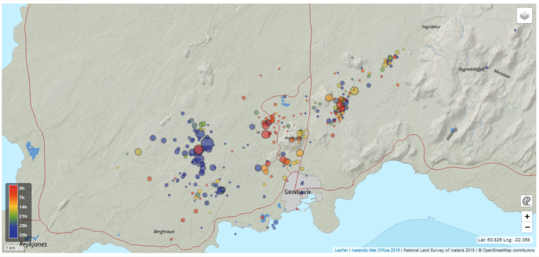
Gennemgået jordskælv fra midnat den 1. november til den 2. november kl.
Opdateret 1. november kl. 12:20
Den 25. oktober begyndte en intens jordskælvsværm nær Svartsengi, nord for Grindavík på Reykjanes-halvøen. Indtil videre er over 10.500 jordskælv blevet opdaget i sværmen, med over 26 jordskælv, der overstiger størrelsesordenen tre, hvoraf det største var på størrelsesordenen 4,5 den 25. oktober kl. 08:18 UTC.
Det seneste satellitradarbillede, optaget sent den 31. oktober, afslører 5 til 6 cm jordbevægelser over 12 dage, centreret lige nordvest for Mt. Þorbjörn. Samme forskydningssignal ses i kontinuerlige GPS-målinger fra stationer i regionen, begyndende den 27. oktober. De seneste GPS-resultater fra 1. november indikerer, at jordforskydninger fortsætter i regionen. Ved at kombinere seismiske, geodætiske og satellitbaserede observationer konkluderer vi, at en vulkansk indtrængen er placeret på omkring 4 km dybde lige nordvest for Mt. Þorbjörn. På nuværende tidspunkt er der ingen indikationer på, at den vulkanske indtrængen bliver mere lavvandet. Vi forventer, at seismiciteten vil fortsætte nordvest for Mt. Þorbjörn, og dette kan omfatte mærkede jordskælv, der overstiger størrelsesordenen fire. Udløst jordskælvsaktivitet er også mulig i de kommende dage på grund af stressstigninger forårsaget af indtrængen. Dette er en sandsynlig forklaring på den igangværende seismiske aktivitet, der blev opdaget vest for Þorbjörn i Eldvörp den 1. november. Udløst seismicitet er også mulig på grund af de langsigtede virkninger af magmaakkumulering under Fagradalsfjall.
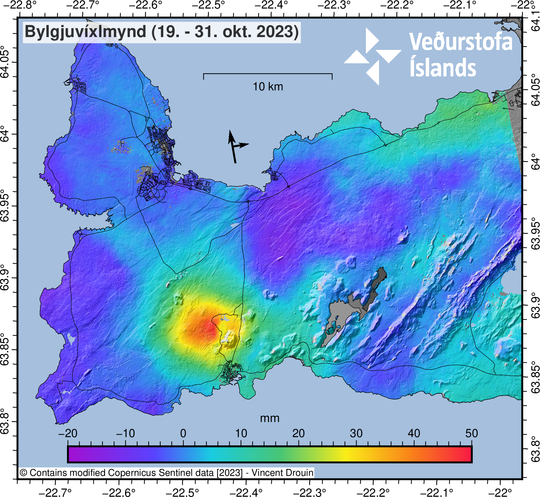
Satellitbaseret InSAR-billede af Reykjanes-halvøen, der strækker sig fra 19. til 31. oktober. Dette billede giver et indblik i jordens deformation i løbet af de sidste 12 dage. Det største deformationssignal er centreret nordvest for bjerget Þorbjörn. Fra GPS-målinger er det tydeligt, at størstedelen af centimeterskalaen jordforskydning er sket siden 27. oktober.
Opdateret 31. oktober kl. 17.00
I morges kl. 8.40 begyndte en jordskælvsværm ved Þorbjörn, som varede i næsten 2 timer og var usædvanlig intens. Det største jordskælv i sværmen målte M3,7. Aktivitetens centrum var lige øst for midten af den stigning, der er observeret de seneste dage. Jordskælvenes dybde blev anslået til mellem 5 og 1,5 km dybde. Jordskælvsværmen er et tydeligt tegn på magmabevægelser i dybden. GPS-målinger understøtter fortolkningen, selv om stigningen, der startede for omkring fire dage siden, er aftaget. Tidligere i dag var der et møde med civilforsvaret og interessenter på Reykjanes-halvøen, hvor de seneste målinger og mulige scenarier og svar på det aktuelle scenarie blev diskuteret.
Situationen overvåges nøje
IMO følger udviklingen nøje og ser på, om mikroseismisk aktivitet stiger tættere på overfladen, hvilket kan være et tegn på, at magma bryder sig vej gennem jordskorpen. I øjeblikket er der ingen tegn på, at jordskælvsaktiviteten bliver mere lavvandet. Situationen kan dog hurtigt ændre sig, og det er ikke muligt at udelukke et scenarie, der involverer et lavaproducerende udbrud i området nordvest for Þorbjörn. Det er vigtigt at påpege, at magmabevægelser, svarende til dem, der observeres tæt på Þorbjörn, ofte forsvinder og ikke fører til et vulkanudbrud. Ikke desto mindre kunne langvarig riftning og øget (udløst) jordskælvsaktivitet i Svartsengi-området have skabt svagheder i skorpen, hvilket gør det lettere for magma at bevæge sig til lavere dybder.
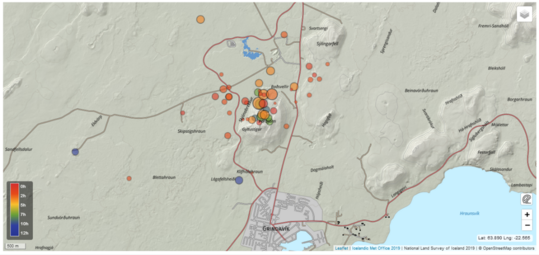
Gennemgået jordskælv fra midnat i dag.
Opdateret 30. oktober kl. 11.30
Sentinel-satellitdataene, der forventes at blive modtaget i går, er ikke ankommet endnu, men cGPS-dataene i området omkring Svartensgi og Þorbjörn viser, at deformationen stadig er i gang. Deformationshastigheden siden begyndelsen af denne påtrængende begivenhed har været svagt faldende over tid. Foreløbige resultater fra deformationsmodeller tyder på, at den gennemsnitlige dybde, hvor den magmatiske instruktion finder sted, er omkring 4 km.
I løbet af de sidste 24 timer er omkring 1300 jordskælv automatisk blevet registreret på Reykjanes-halvøen. Det meste af denne seismicitet er placeret i en dybde mellem 2-4 km. Det største jordskælv havde en størrelsesorden M2,7 den 29. oktober kl. 11:40 UTC.
Forskere fra det islandske meteorologiske kontor foretager yderligere overflademålinger i området, herunder geokemiske observationer. Der opretholdes regelmæssig kommunikation mellem IMO, HS-Orka og Civilbeskyttelsen, mens denne uro fortsætter.
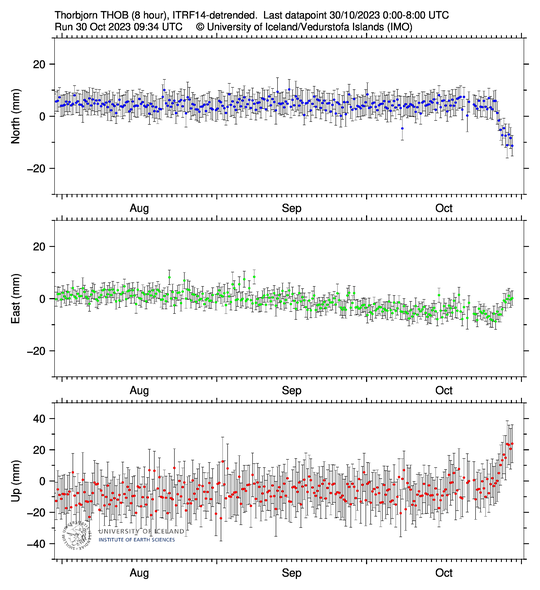
8-timers løsning til cGNSS THOB-stationen i Þorbjörn, der viser det seneste datapunkt opdateret kl. 08:00 UTC i dag
Opdateret 29. oktober kl. 14.00
De seneste cGPS-deformationsdata omkring Þorbjörn og Svartengi-området bekræfter, at deformationen, som startede 27. oktober, fortsætter. Som indledningsvis anført, er de igangværende deformationshastigheder højere end i tidligere hændelser, som fandt sted i et lignende område i 2020 og 2022. Samlet set har seismiciteten nord for Grindavík været faldende i løbet af det seneste døgn, og der er ingen væsentlige ændringer i jordskælvsdybderne. Det er dog vigtigt at understrege, at den nuværende deformation kan udløse fornyet seismicitet i området, som kunne mærkes af mennesker.
Nye satellitdata forventes at blive leveret senere i dag, og et nyt interferogram vil blive behandlet, så snart dataene er tilgængelige. Resultaterne vil give os mulighed for at identificere og fortolke de deformationsprocesser, der har fundet sted på halvøen i løbet af de seneste 12 dage. Vi forventede at offentliggøre resultaterne i morgen.
En episode med kompleks vulkan-tektonisk uro påvirker i øjeblikket Reykjanes-halvøen. Det fortolkes som et resultat af flere deformationskilder i dybden, som interagerer og påvirker et bredt område på tværs af halvøen.
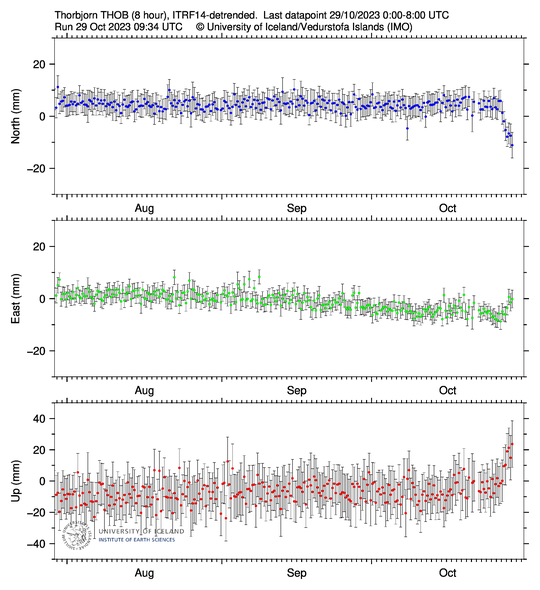
8-timers løsning til cGNSS THOB-stationen i Þorbjörn, der viser det seneste datapunkt opdateret kl. 08:00 UTC i dag, den 29. oktober.
Opdateret 28. oktober kl. 13.30
De seneste cGPS-målinger, sammen med et nyligt erhvervet InSAR-billede over Reykjanes-halvøen, afslører et tydeligt tegn på jordløft, centreret omkring Svartsengi. Dette løftesignal begyndte på et tidspunkt den 27. oktober, og det afspejler en trykstigning, der sandsynligvis er forårsaget af en magmatisk indtrængen i dybden. Midten af løftesignalet er omkring 1,5 km nordvest for Þorbjörn, tæt på Den Blå Lagune. I 2020 og 2022 blev lignende opløftningssignaler detekteret i samme område og med lignende geometri. Dette er nu den femte inflationsbegivenhed i området. Fra en indledende vurdering forekommer det igangværende opløftningssignal hurtigere end tidligere. I øjeblikket er der ingen indikationer på, at magma bevæger sig på lavere dybde. Situationen kan dog udvikle sig hurtigt. For eksempel er der sket betydelige fraktureringer i Svartsengi-området på grund af udløst seismicitet i de seneste dage. En sådan frakturering kunne gøre det muligt for magma at finde veje til lavere dybde.
Samlet set viser de seneste deformationsresultater fra Reykjanes-halvøen en kompleks, igangværende proces med magmabevægelser i jordskorpen. Disse processer påvirker et bredt område, herunder Fagradalsfjall (hvor langsigtet inflation fortsætter), øst for Festarfjall (hvor deformationen ser ud til at være stoppet), og – i de sidste 24 timer – viser et område tæt på Svartsengi inflation.
Den seismiske sværm, der begyndte den 25. oktober nord for Grindavík, har resulteret i over 7.000 jordskælv. Niveauet af jordskælv er reduceret betydeligt, selvom sværmen stadig er i gang, hvilket betyder, at der stadig er sandsynlighed for jordskælv.
Geofysisk modellering er i gang i dag for at bestemme dybden og størrelsen af hævningskilden tæt på Svartsengi. Et ekstra satellitradarbillede vil være tilgængeligt fra Reykjanes-halvøen den 29. oktober. Dette billede skulle give et endnu nærmere indblik i de seneste magmabevægelser og deformationsmønstre på halvøen.
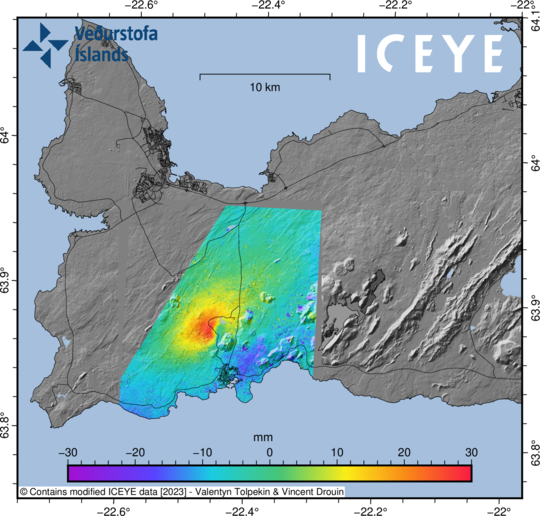
“Line-of-sight” (LOS)-deformation målt af ICEYE SAR-satellitten mellem den 26. oktober kl. 05:21 UTC og den 28. oktober kl. 05:21 UTC. Satellitdata leveret i samarbejde med ICEYE ( https://www. iceye.com/ ).
Opdateret 27. oktober kl. 14.00
Det jorddeformationssignal, der er detekteret siden i går i området øst for Festarfjall, bekræftes af de seneste cGPS-data. Den vandrette forskydning i løbet af de sidste par dage er ~ 2 cm som set på FEFC-stationen, og bevægelse er nu også blevet målt på en anden cGPS-station i Selatangar. Et 1-dages interferogram, der spænder over 26. til 27. oktober, afslører ikke nogen væsentlige ændringer i området, men signalet ved FEFC målt i løbet af denne 24-timers periode var mindre end 1 cm, sandsynligvis for lille til at blive detekteret af dette interferogram. cGPS-stationer i Grindavík og nord herfor viser ingen væsentlige ændringer.
Den seismiske sværm nord for Grindavík fortsætter med omkring 1000 jordskælv siden midnat. I alt 5800 eqs er blevet registreret siden starten af aktiviteten. Et jordskælv M4.0 blev målt kl. 04:02 UTC den 27. oktober omkring 2 km nord for Grindavík. Den seismiske aktivitet tolkes som skorpens reaktion på stressændringerne induceret af fortsat magmatisk indstrømning i dybden under Fagradalsfjalls vulkanske system.
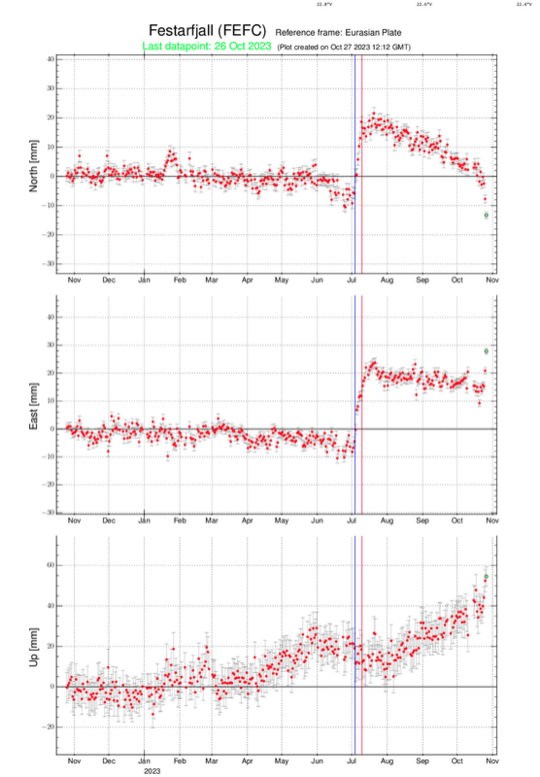
Forskydning ved cGNSS station FEFC øst for Festarfjall. Blå lodret linje markerer begyndelsen på en digeindtrængning i juli 2023, og den røde linje starter et udbrud nær Litli-Hrútur den 10. juli 2023. De seneste datapunkter viser bevægelse og vandret bevægelse mod SØ.
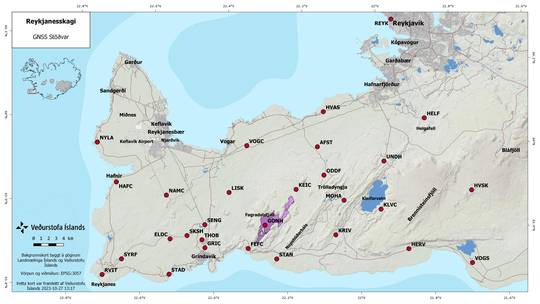
cGNSS-stationer på Reykjanes-halvøen. Data fra stationerne FEFC og STAN øst for Festarfjall viser bevægelser i det sidste døgn.
Opdateret: 26. oktober kl. 17.00
Den seismiske sværm, der begyndte den 24. oktober, fortsætter. Over 4.000 jordskælv er blevet registreret på Reykjanes-halvøen, hvoraf 14 havde en styrke på over M3. Det meste af aktiviteten har fundet sted mellem Stóra-Skogafell og nordøst for Eldvörp. Seismiciteten er placeret mellem 2 og 6 km dybde, med det største jordskælv (M4.5) målt den 25. oktober kl. 08:18 UTC. Forskere ved det islandske meteorologiske kontor (IMO) fortolker den igangværende seismiske aktivitet som udløst af stress induceret af den igangværende deformation ved Fagradalsfjall, som begyndte kort efter sommerens 2023-udbrud. Den igangværende seismiske sværm forventes at fortsætte de kommende dage. På længere sigt kan den fortsatte ophobning af magma under Fagradalsfjall forårsage yderligere seismiske sværme på halvøen.
Jorddeformationsmålinger nær Svartsengi og Grindavík viser ingen ændringer relateret til den igangværende seismiske sværm nord for Grindavík. En enkelt GPS-station (FEFC), øst for Festarfjall, begynder at vise lokaliseret bevægelse i sydøstlig retning. Disse målinger kunne indikere tilstedeværelsen af magma i dybden langs fortsættelsen af digeindtrængninger, der er i nordøstlige retning mod sydvest, som er dannet under Fagradalsfjall siden 2021.
Personale fra IMO fortsætter med at overvåge de seismiske uroligheder nøje. I de kommende dage vil satellitdata blive brugt til bedre at vurdere den rumlige udstrækning af enhver jorddeformation. Målingerne vil også blive brugt til bedre at forstå igangværende geofysiske processer på Reykjanes-halvøen.
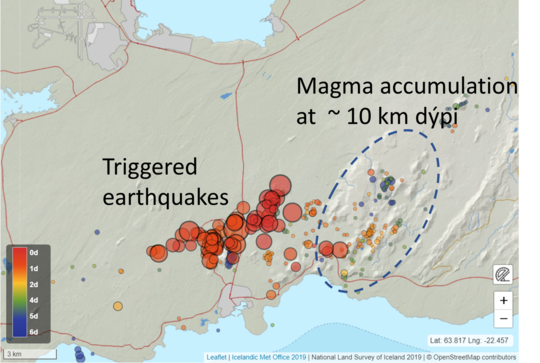
Gennemgået udløste jordskælv fra 20.-26. oktober.
Skrevet 25. oktober:
I nat startede en intens jordskælvsværm nær Svartsengi, nord for Grindavík. Over 1000 jordskælv er blevet opdaget der siden midnat, og sværmen er stadig i gang. De største jordskælv, der er registreret, er M3.9 kl. 5.35 UTC og M4.5 kl. 8.18 UTC. Begge disse jordskælv opstod på omkring 5 km dybde. Seneste deformationsdata indsamlet fra flere stationer omkring Þorbjörn/Grindavík området viser ikke signifikante ændringer korreleret med den igangværende seismiske aktivitet. I lyset af de data, der i øjeblikket er tilgængelige, fortolkes denne seismicitet til at være sandsynligt udløst af stressændringer relateret til tidligere påtrængende aktivitet på halvøen. Der er i øjeblikket ingen indikationer på magmavandring under Þorbjörn/Grindavík-området, men situationen kan ændre sig når som helst, og den kan udvikle sig over kort tid fra timer til dage. Som rapporteret i september er en magmatisk indtrængen i gang under Fagradalsfjall.
Personale fra IMO fortsætter med at overvåge området tæt og fortolke de nyeste data, efterhånden som de bliver tilgængelige.
Usikkerhedsniveauet for Department of Civil Protection er blevet erklæret på grund af denne seismiske sværm.
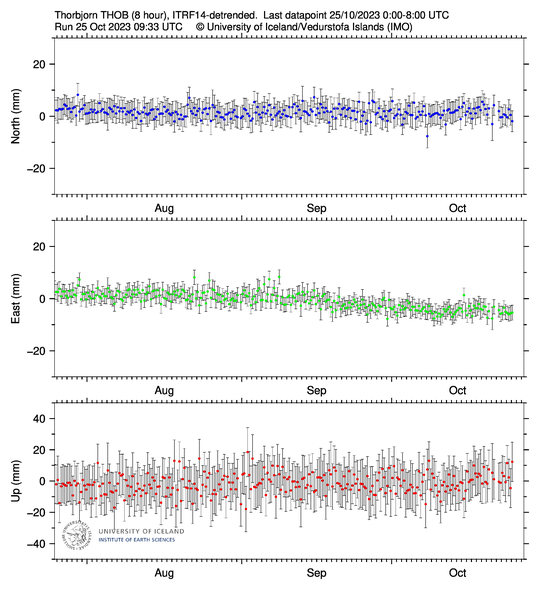
8-timers løsning til cGNSS THOB-stationen i Þorbjörn, der viser det seneste datapunkt opdateret kl. 08:00 UTC i dag.
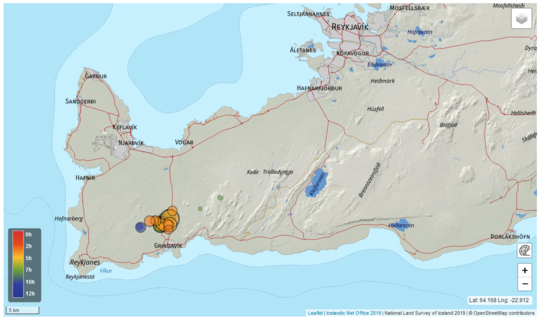
Gennemgået jordskælvssteder fra midnat til middag den 25. oktober .
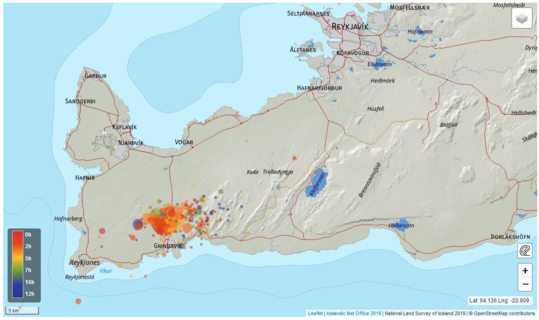

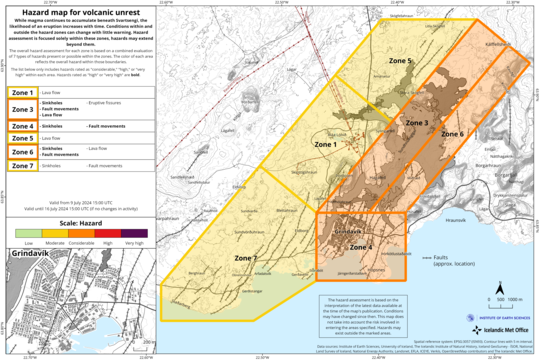
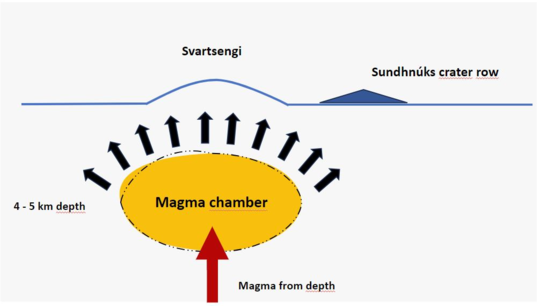
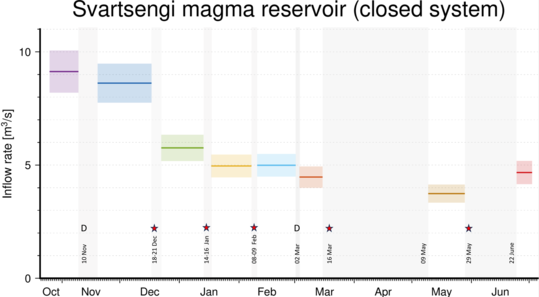
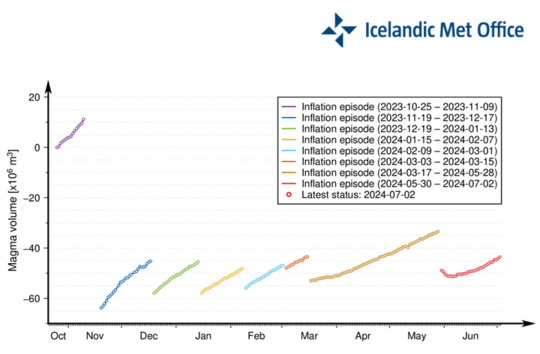
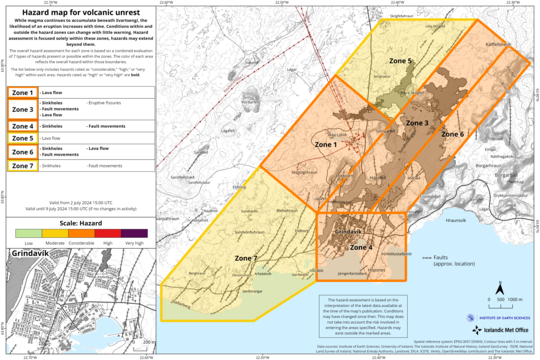
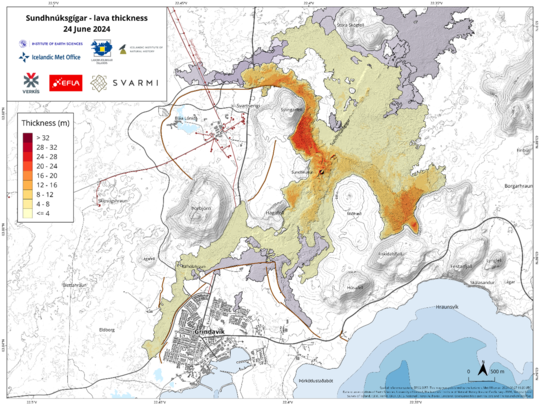
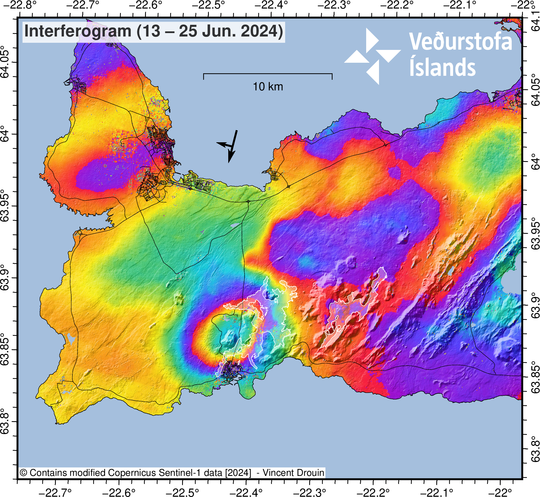
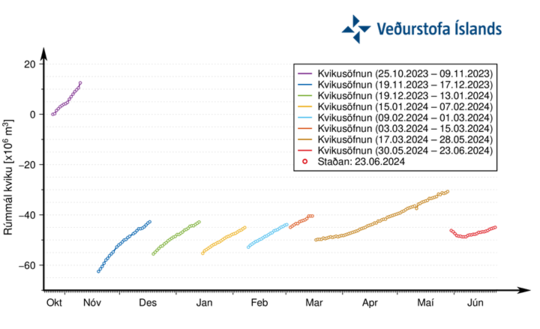
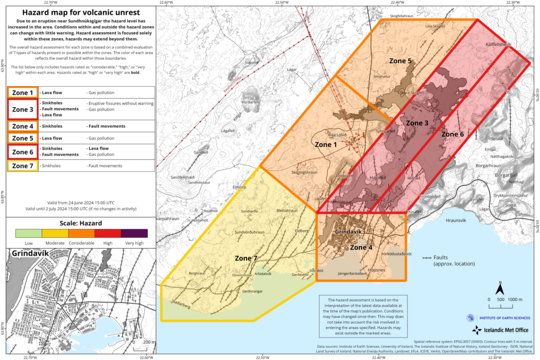
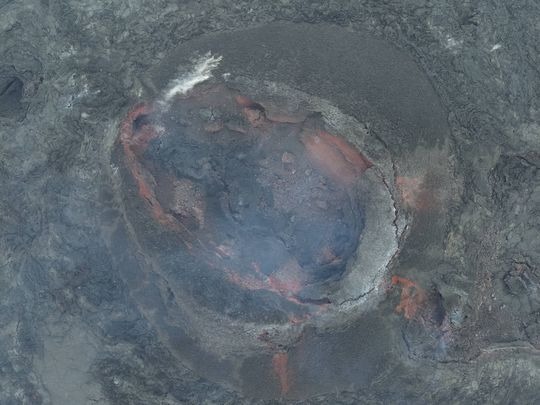
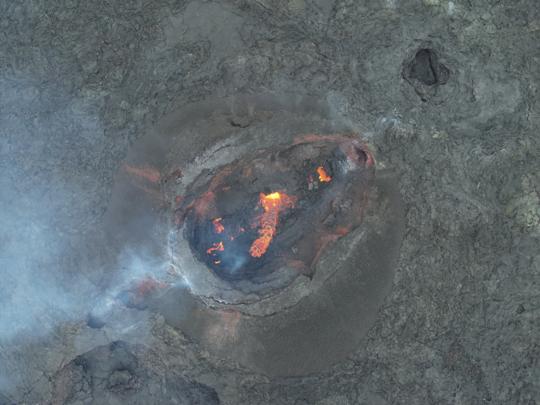
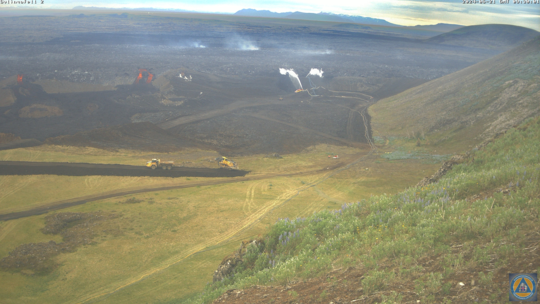
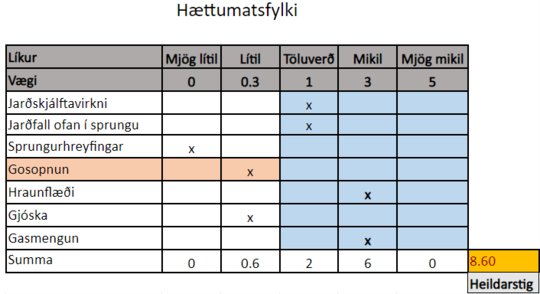
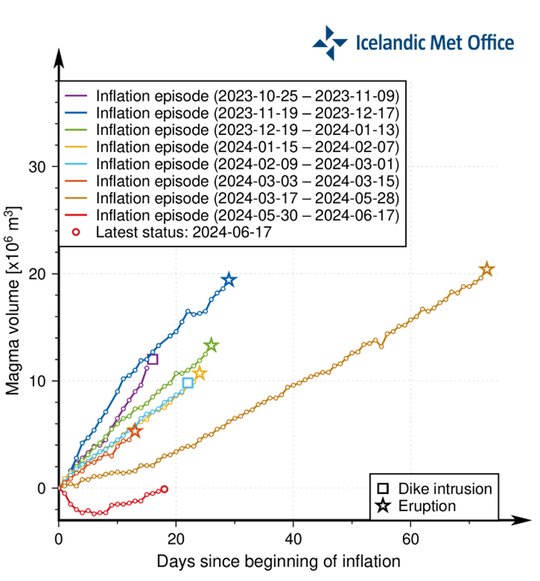
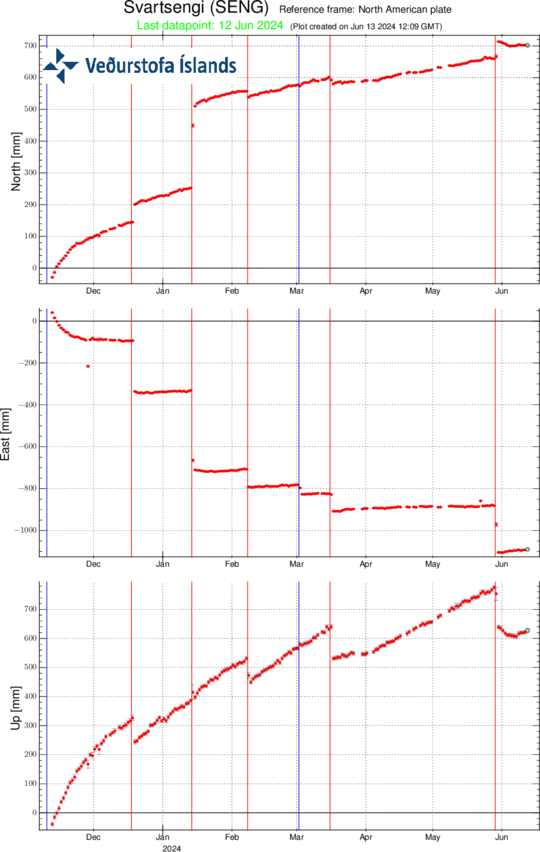
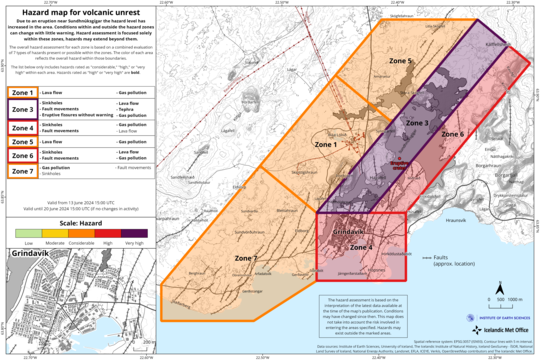
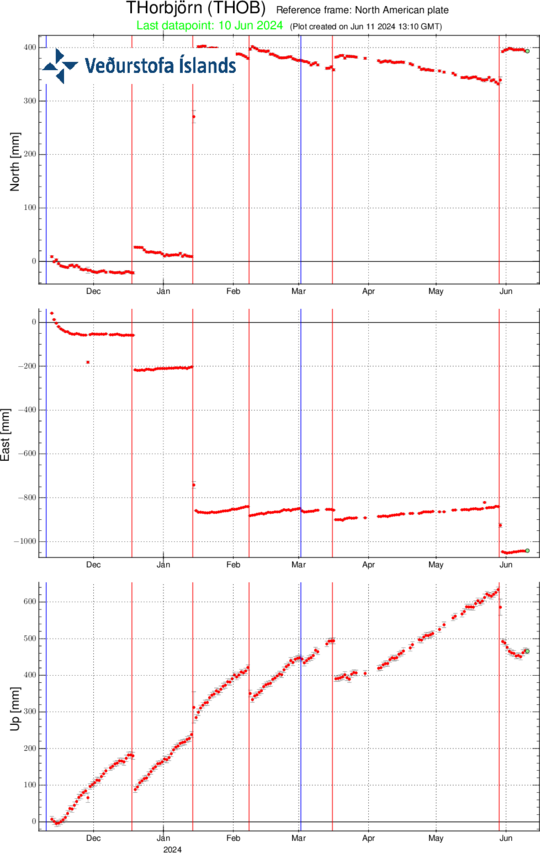
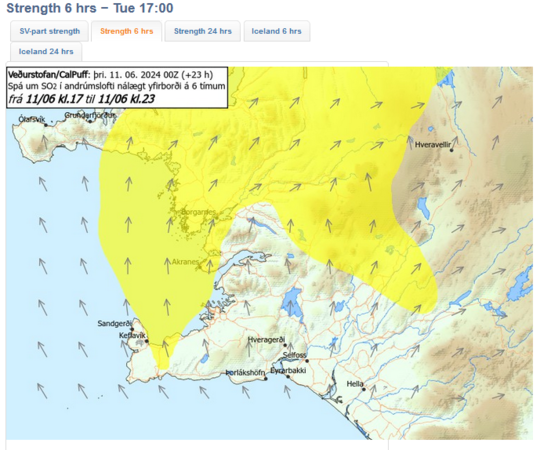
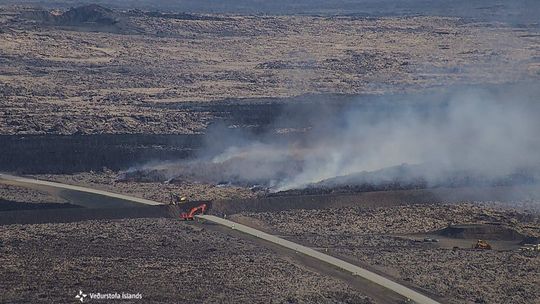
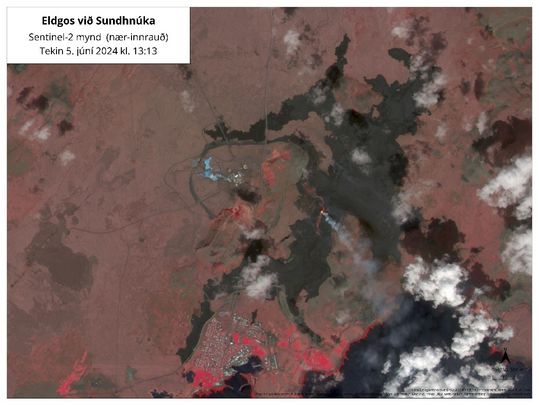
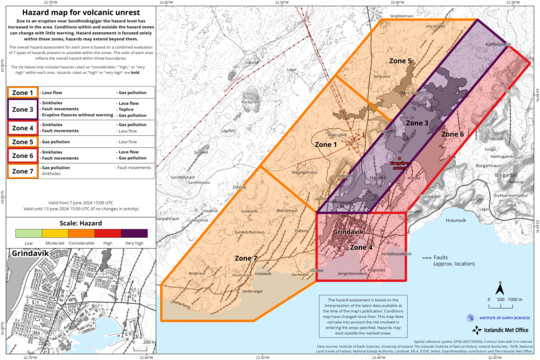
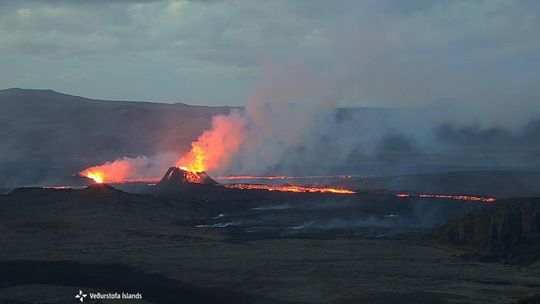
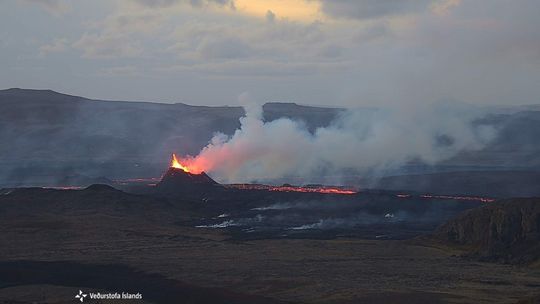
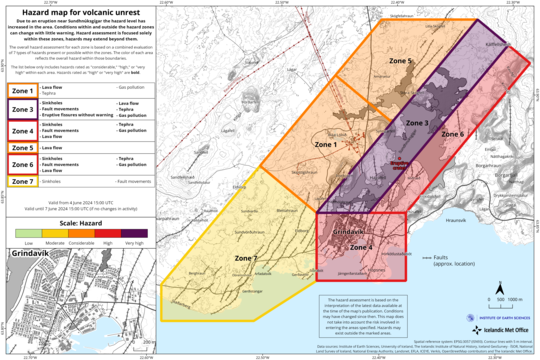
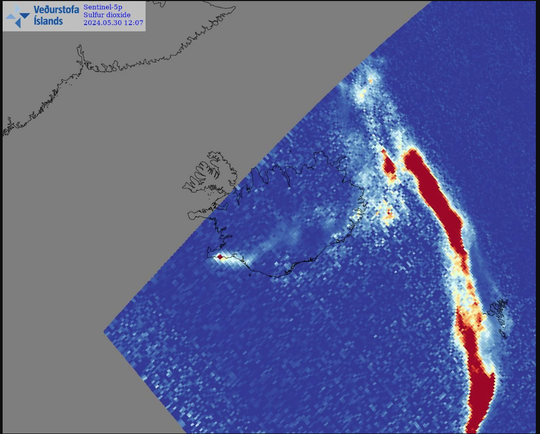
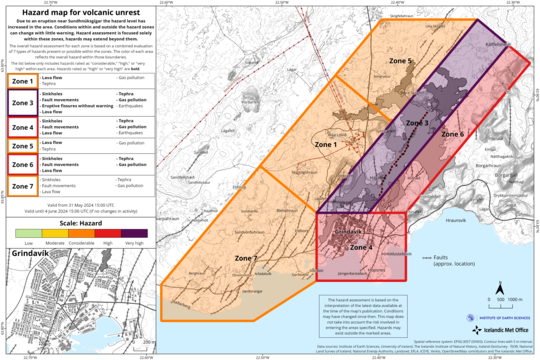
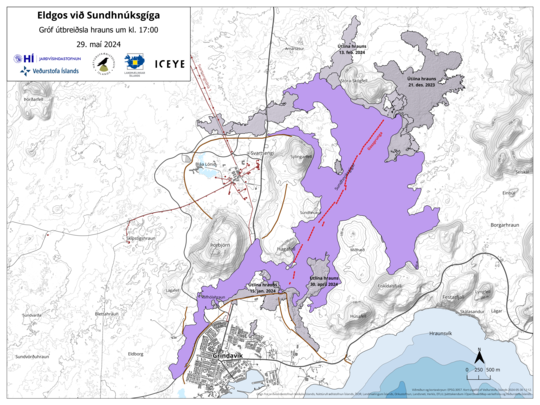
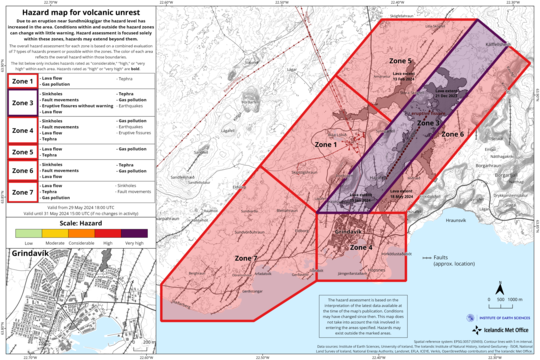
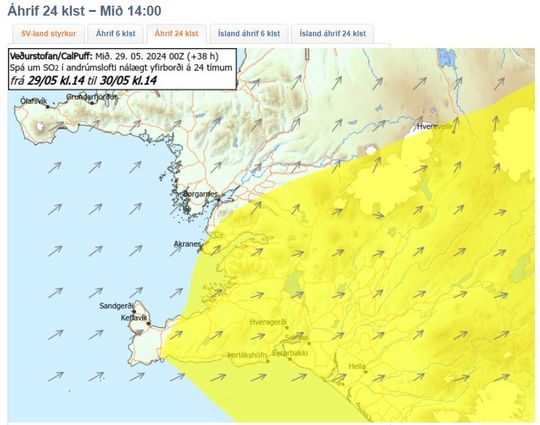
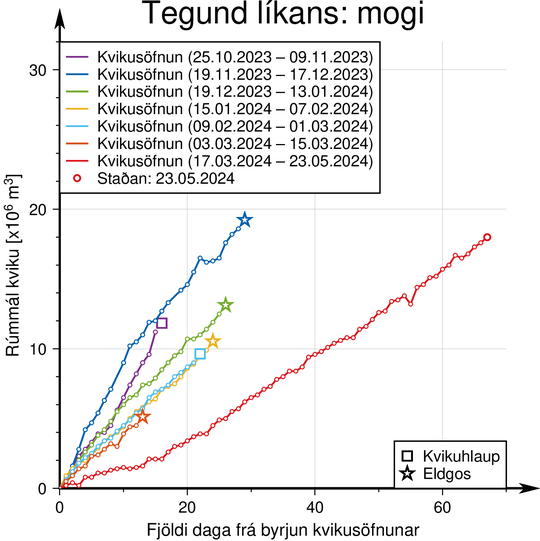


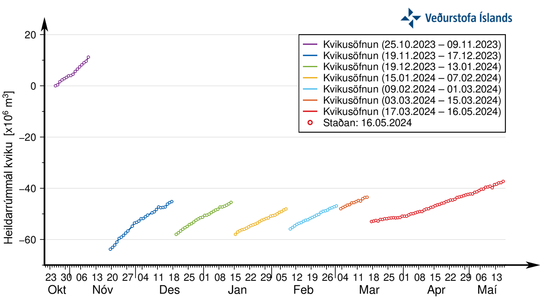

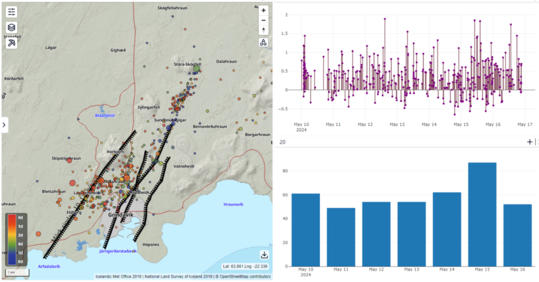
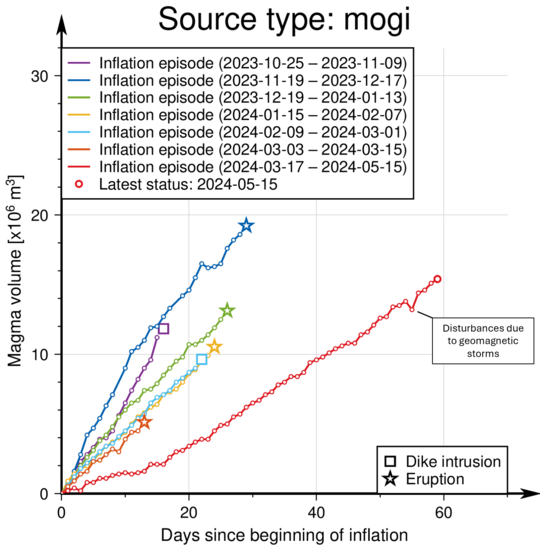
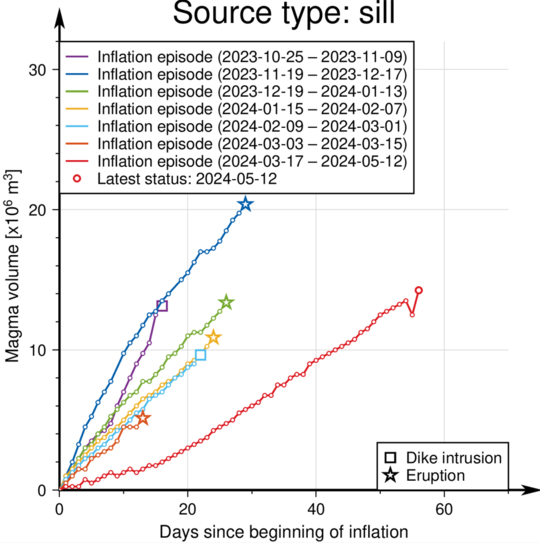
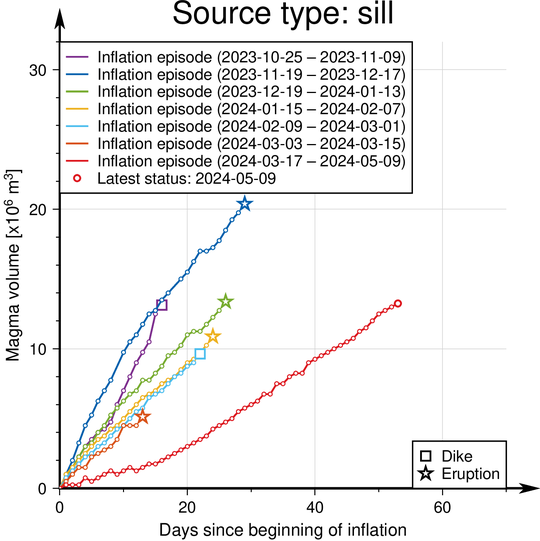
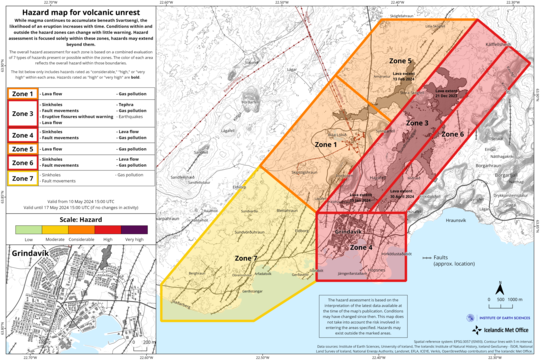

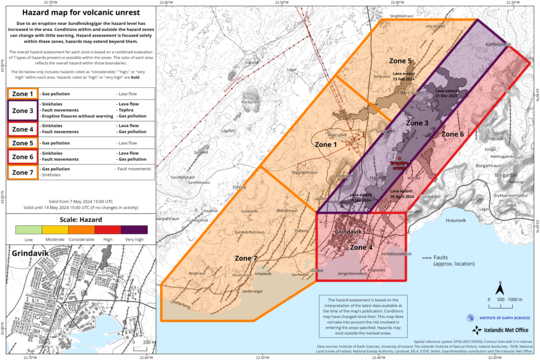
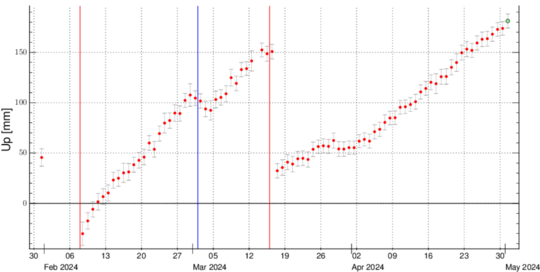
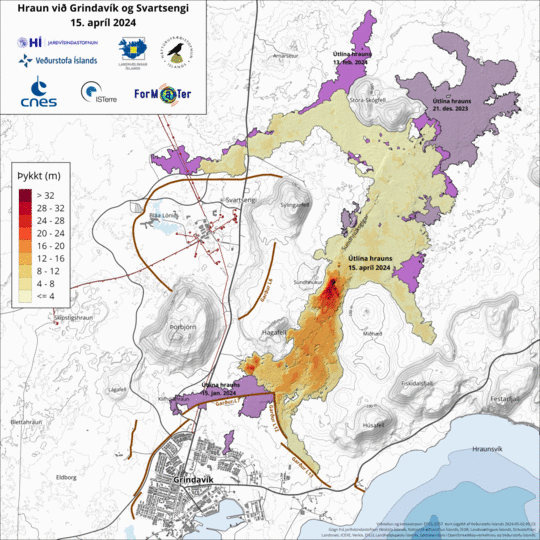
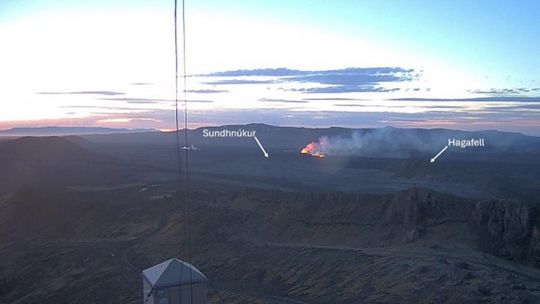
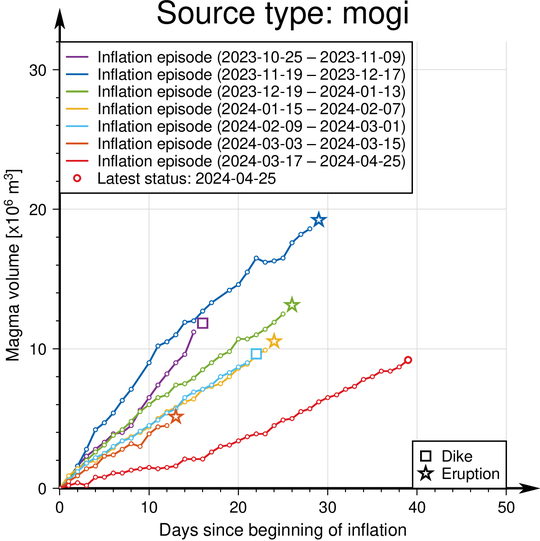
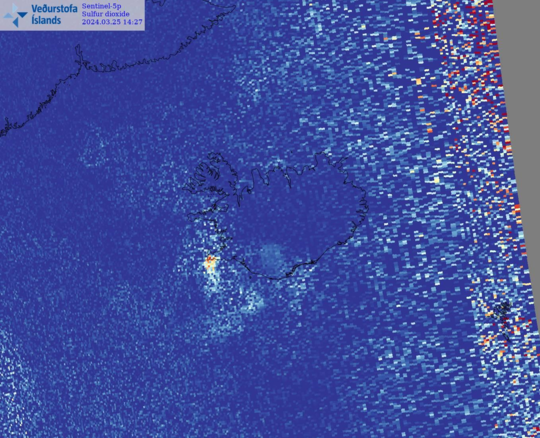
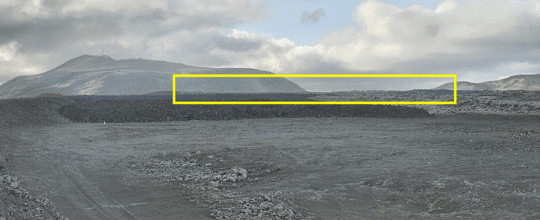
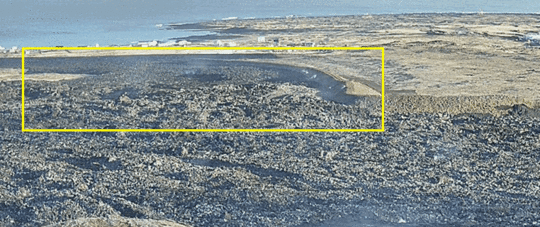
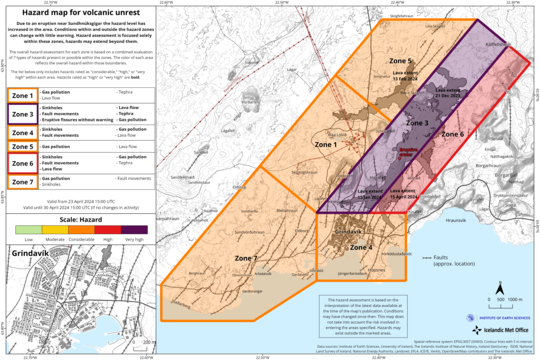

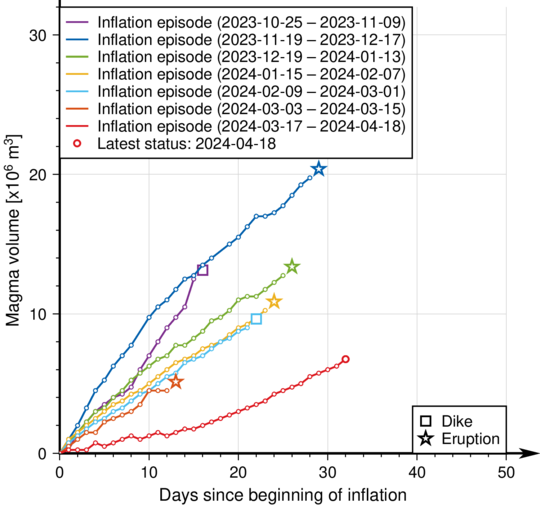
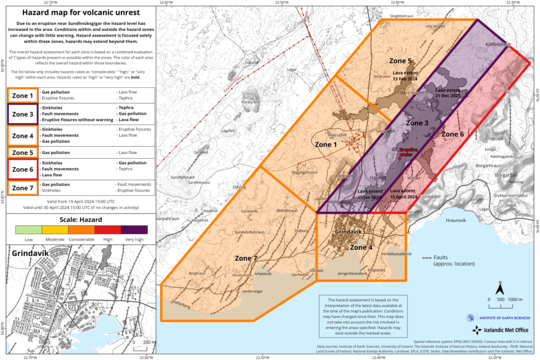

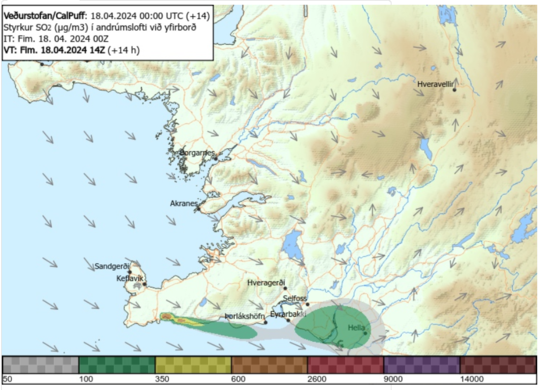
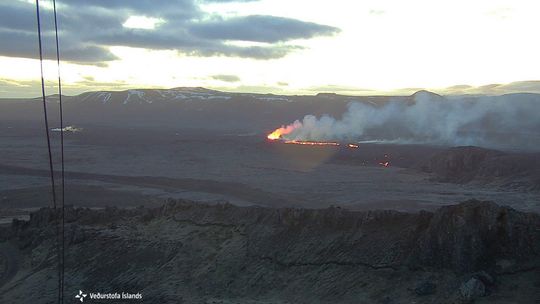
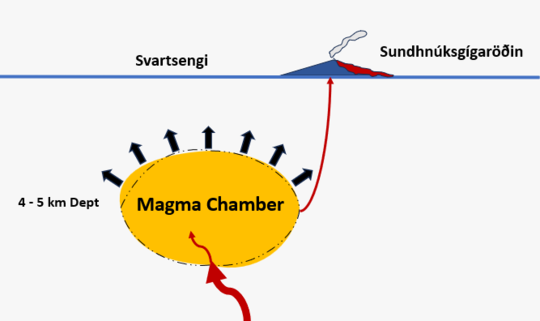
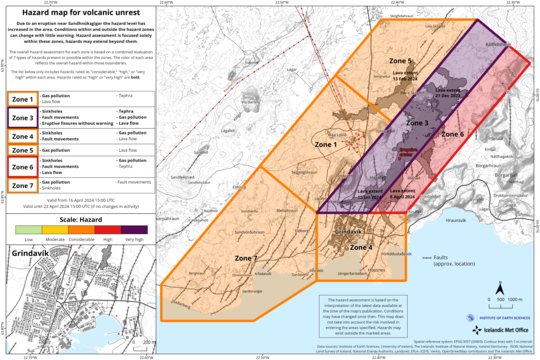
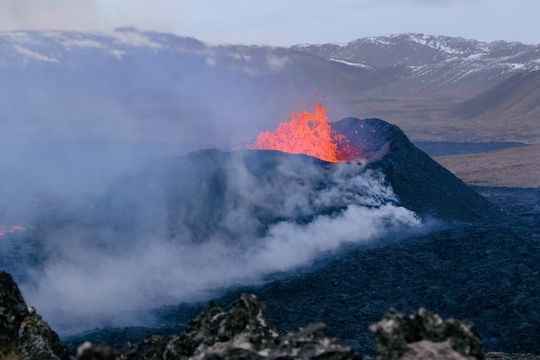
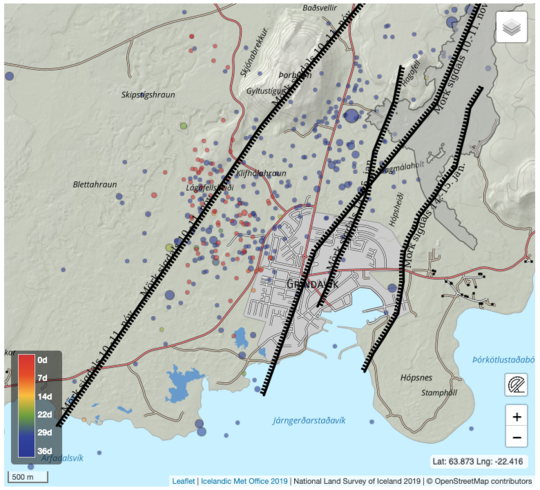
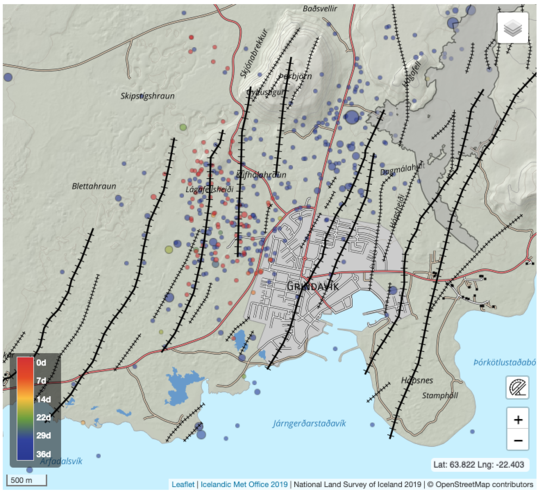

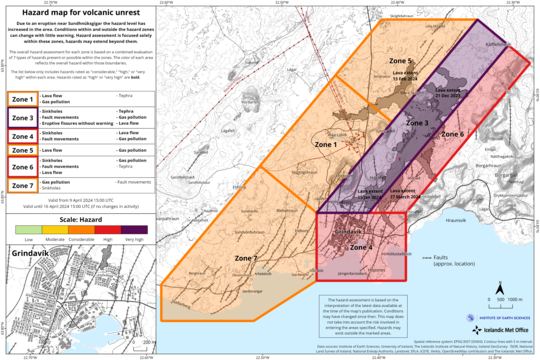
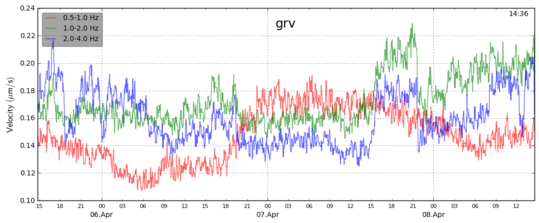
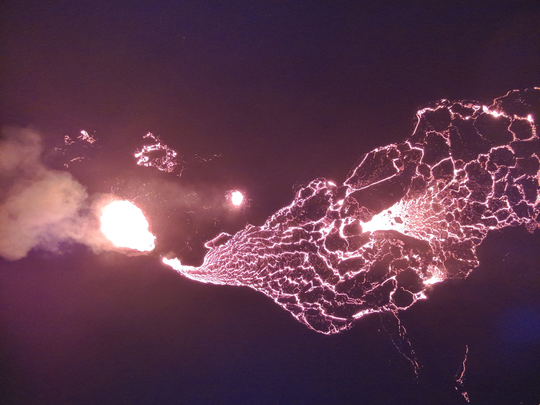
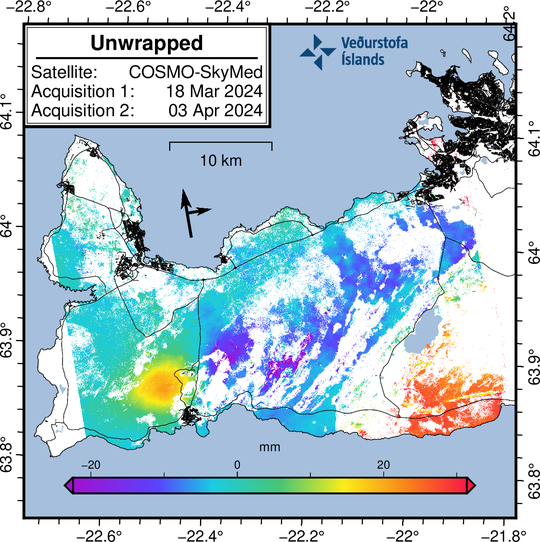
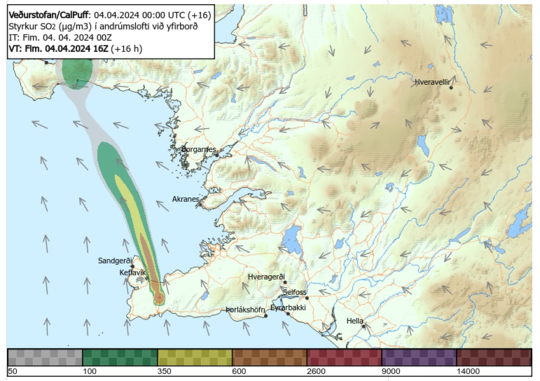
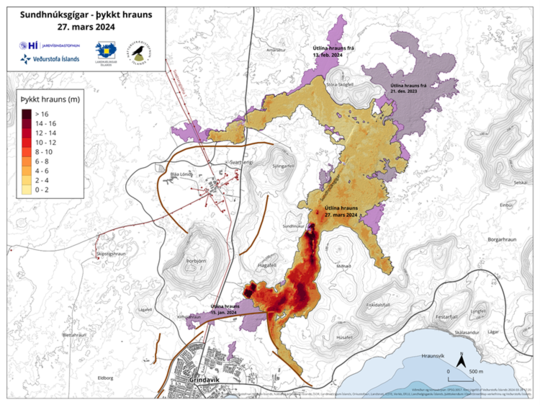
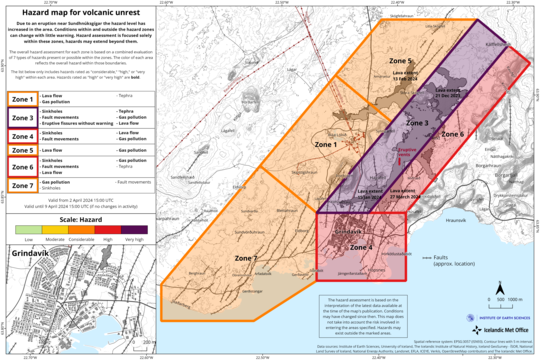
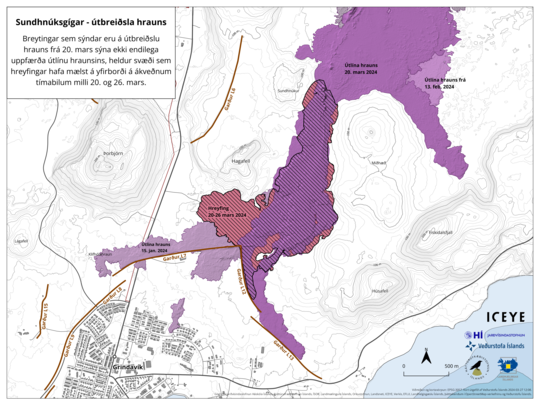
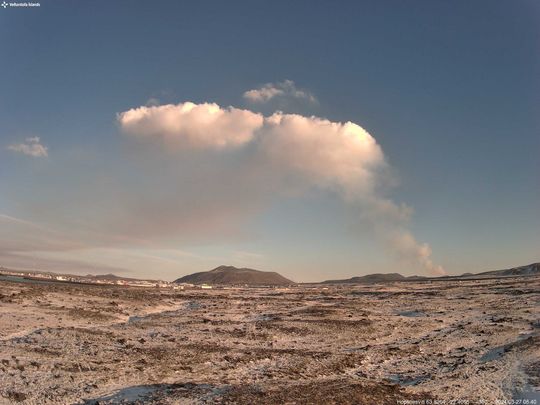
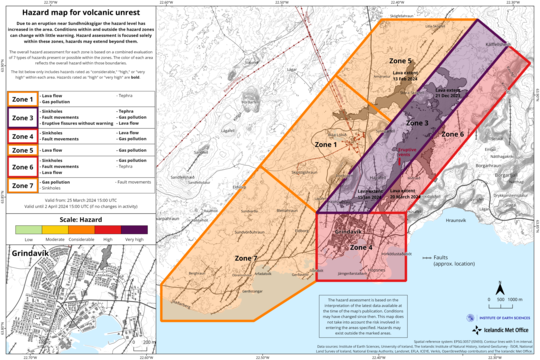
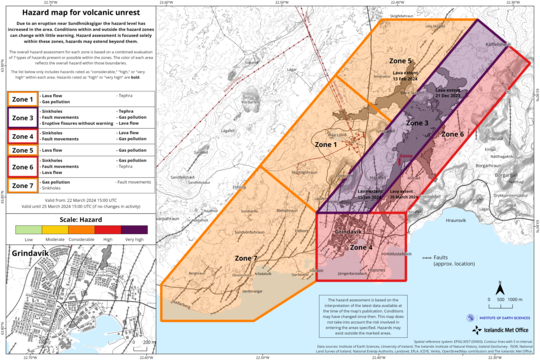
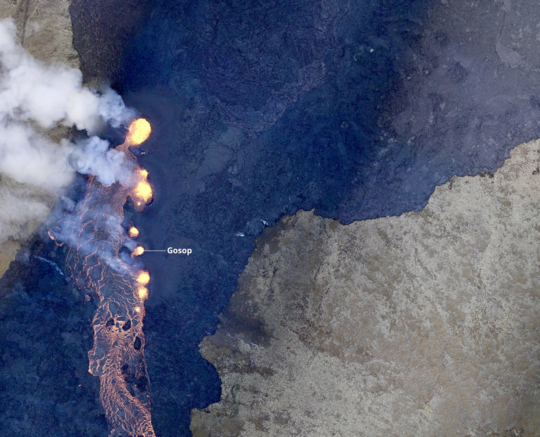
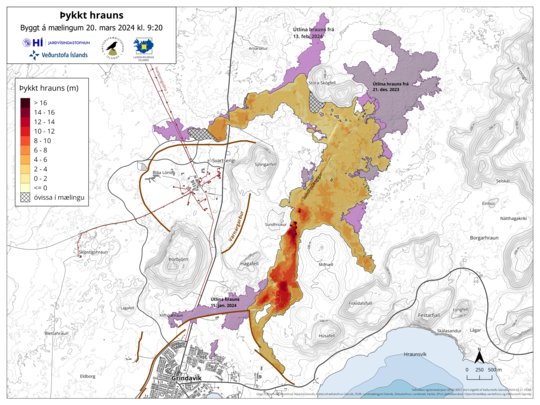
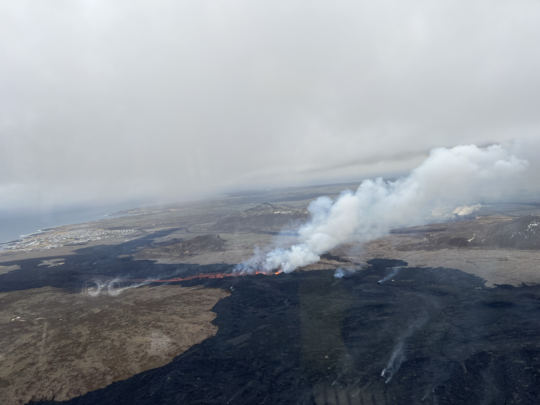
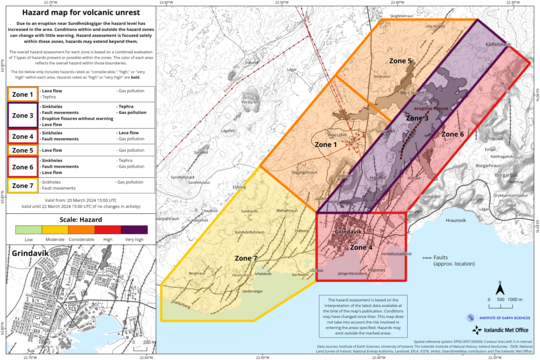
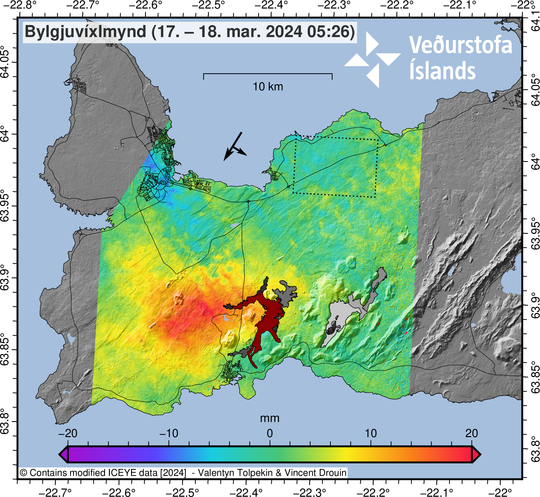
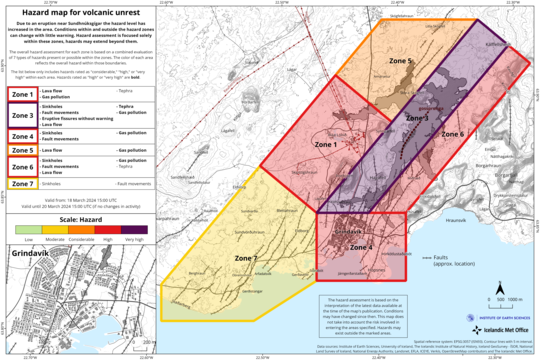
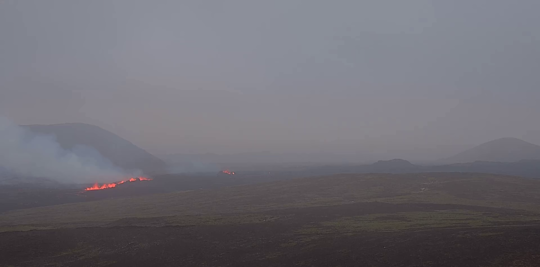
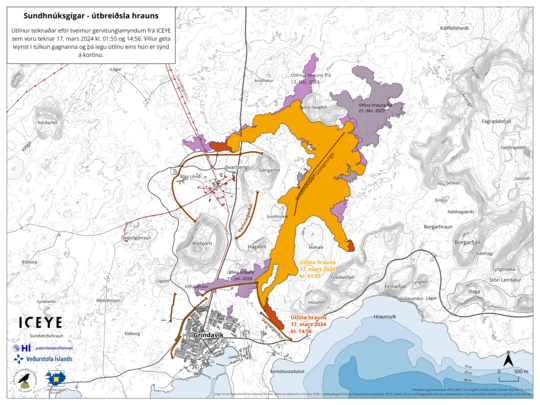
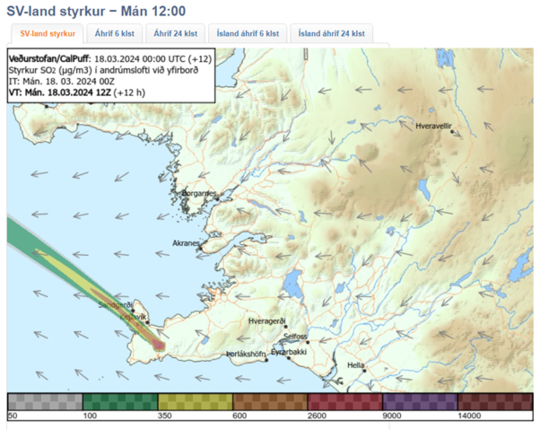
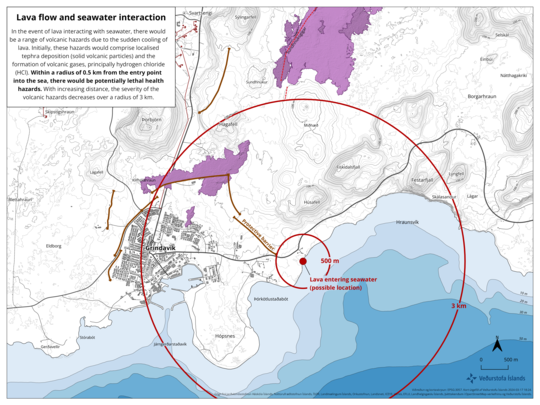
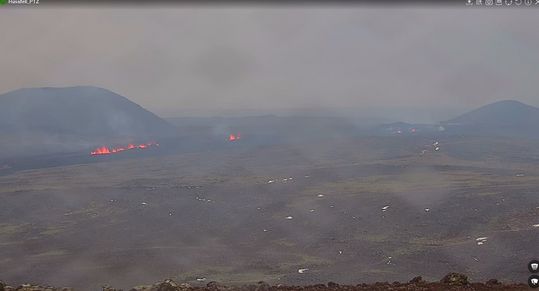
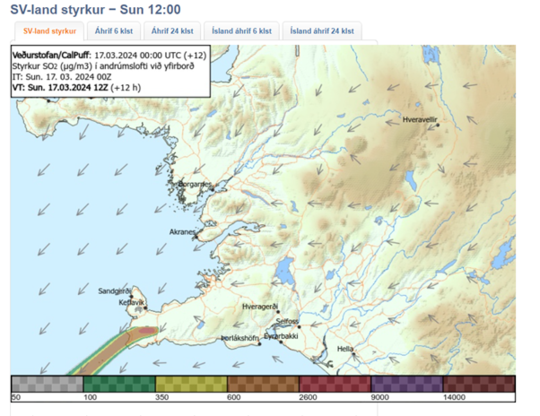
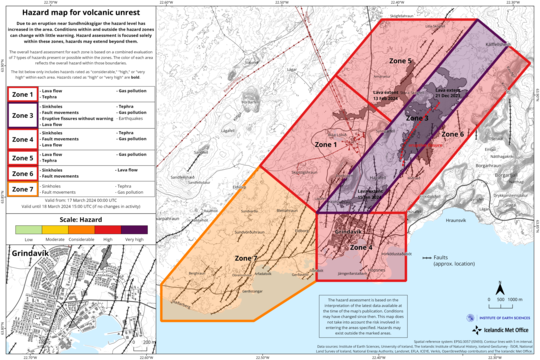
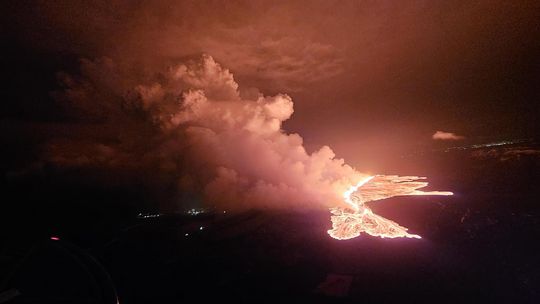
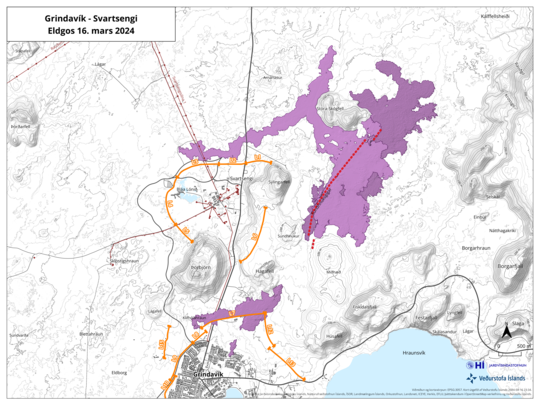

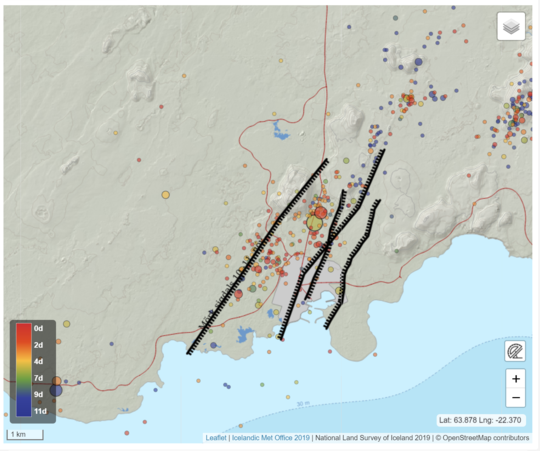
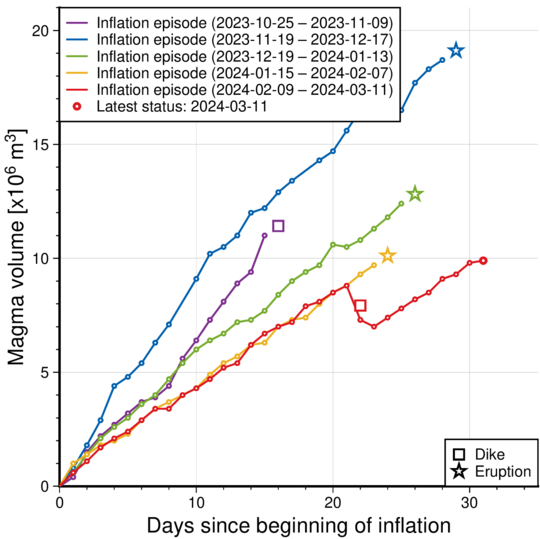
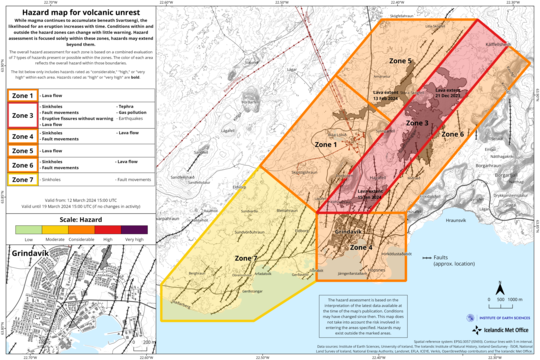 ‘
‘